Broadcom BRCM1017 Broadcom 802.11ag WLAN mini PCI card User Manual 2x468
Broadcom Corporation Broadcom 802.11ag WLAN mini PCI card 2x468
Broadcom >
Contents
- 1. Users Guide
- 2. user guide
- 3. Updated portable user guide
- 4. user guide PP07L
- 5. user guide PPT
- 6. PP02X user guide part 1
- 7. PP02X user guide part 2
- 8. PP05L user guide part 1
- 9. PP05L user guide part 2
- 10. Updated User guide partable platform
- 11. User guide PP02X part 1
- 12. User guide PP02X part 2
- 13. User guide PP05L part 1
- 14. User guide PP05L part 2
- 15. User guide PP07L
- 16. User guide PPT
- 17. users manual
- 18. Host Manual 1
- 19. Host Manual 2
user guide PPT

FILE LOCATION: S:\SYSTEMS\Pebble\UG\A00\English\tp.fm
DELL CONFIDENTIAL – PRELIMINARY 1/29/03 – FOR PROOF ONLY
www.dell.com | support.dell.com
Dell™ Latitude™ D400 User’s Guide

FILE LOCATION: S:\SYSTEMS\Pebble\UG\A00\English\tp.fm
DELL CONFIDENTIAL – PRELIMINARY 1/29/03 – FOR PROOF ONLY
Click the links to the left for information on the features and operation of
your computer. For information on other documentation included with
your computer, see "Finding Information."
CAUTION: Follow the safety instructions in the
System Information
Guide
to help protect your computer from damage and ensure your
own personal safety.
Notes, Notices, and Cautions
NOTE: A NOTE indicates important information that helps you make better
use of your computer.
NOTICE: A NOTICE indicates either potential damage to hardware or loss of
data and tells you how to avoid the problem.
CAUTION: A CAUTION indicates a potential for property damage,
personal injury, or death.
Abbreviations and Acronyms
For a complete list of abbreviations and acronyms, see the Glossary.
If you purchased a Dell™ n Series computer, any references in this
document to Microsoft® Windows® operating systems are not applicable.
____________________
Information in this document is subject to change without notice.
© 2003 Dell Computer Corporation. All rights reserved.
Reproduction in any manner whatsoever without the written permission of Dell Computer
Corporation is strictly forbidden.
Trademarks used in this text: Dell, the DELL logo, Latitude, Dell Precision, OptiPlex, Inspiron,
Dimension, Dell TravelLite, and DellNet are trademarks of Dell Computer Corporation; Intel,
Pentium, and Intel SpeedStep are registered trademarks and Centrino is a trademark of Intel
Corporation; Microsoft, Windows, Windows NT, and MS-DOS are registered trademarks of Microsoft
Corporation; Bluetooth is a trademark owned by Bluetooth SIG, Inc. and is used by Dell Computer
Corporation under license; ENERGY STAR is a registered trademark of the U.S. Environmental
Protection Agency. As an ENERGY STAR Partner, Dell Computer Corporation has determined that
this product meets the ENERGY STAR guidelines for energy efficiency.
Other trademarks and trade names may be used in this document to refer to either the entities claiming
the marks and names or their products. Dell Computer Corporation disclaims any proprietary interest
in trademarks and trade names other than its own.
Model PPT

FILE LOCATION: S:\SYSTEMS\Pebble\UG\A00\English\tp.fm
DELL CONFIDENTIAL – PRELIMINARY 1/29/03 – FOR PROOF ONLY
March 2003 P/N 2X468 Rev. A00

FILE LOCATION: S:\SYSTEMS\Pebble\UG\A00\English\tp.fm
DELL CONFIDENTIAL – PRELIMINARY 1/29/03 – FOR PROOF ONLY

Contents 3
Contents
1Finding Information
Safety Instructions . . . . . . . . . . . . . . . . . . . . . . . . . 14
Documentation Updates . . . . . . . . . . . . . . . . . . . . . . 14
Using Microsoft® Windows®. . . . . . . . . . . . . . . . . . . . 14
Windows Help . . . . . . . . . . . . . . . . . . . . . . . . . 14
Microsoft Windows Guide . . . . . . . . . . . . . . . . . . . . 14
Using Devices . . . . . . . . . . . . . . . . . . . . . . . . . . . . 14
Device User’s Guides . . . . . . . . . . . . . . . . . . . . . . 14
Using the Drivers and Utilities CD . . . . . . . . . . . . . . . . . 15
Fixing Problems . . . . . . . . . . . . . . . . . . . . . . . . . . . 15
Microsoft Windows Guide . . . . . . . . . . . . . . . . . . . . 15
Dell Support . . . . . . . . . . . . . . . . . . . . . . . . . . 15
Installing Parts . . . . . . . . . . . . . . . . . . . . . . . . . . . 15
2About Your Computer
Front View . . . . . . . . . . . . . . . . . . . . . . . . . . . . . 18
Left View . . . . . . . . . . . . . . . . . . . . . . . . . . . . . . 21
Right View . . . . . . . . . . . . . . . . . . . . . . . . . . . . . 23
Back View. . . . . . . . . . . . . . . . . . . . . . . . . . . . . . 25
Bottom View . . . . . . . . . . . . . . . . . . . . . . . . . . . . 28

4Contents
3UsingMicrosoft® Windows® XP
Help and Support Center . . . . . . . . . . . . . . . . . . . . . 32
Switching to Classic View . . . . . . . . . . . . . . . . . . . . . 32
Control Panel . . . . . . . . . . . . . . . . . . . . . . . . . 32
Start Menu . . . . . . . . . . . . . . . . . . . . . . . . . . 32
Window and Button Appearance . . . . . . . . . . . . . . . . 32
Desktop Cleanup Wizard . . . . . . . . . . . . . . . . . . . . . 33
Transferring Information to a New Computer . . . . . . . . . . 33
User Accounts and Fast User Switching . . . . . . . . . . . . . 35
Adding User Accounts . . . . . . . . . . . . . . . . . . . . . 35
Fast User Switching . . . . . . . . . . . . . . . . . . . . . . 35
Setting Up a Home and Office Network . . . . . . . . . . . . . 36
Connecting to a Network Adapter . . . . . . . . . . . . . . . 36
Network Setup Wizard . . . . . . . . . . . . . . . . . . . . . 36
Internet Connection Firewall . . . . . . . . . . . . . . . . . . . 37
4Dell™ QuickSet Features
Clicking the QuickSet Icon . . . . . . . . . . . . . . . . . . . . 40
Double-Clicking the QuickSet Icon . . . . . . . . . . . . . . . . 40
Right-Clicking the QuickSet Icon . . . . . . . . . . . . . . . . . 40
5Using the Keyboard and Touch Pad
Numeric Keypad . . . . . . . . . . . . . . . . . . . . . . . . . . 44
Keyboard Shortcuts . . . . . . . . . . . . . . . . . . . . . . . . 44
System Functions . . . . . . . . . . . . . . . . . . . . . . . 44
Battery . . . . . . . . . . . . . . . . . . . . . . . . . . . . 45
CD or DVD Tray . . . . . . . . . . . . . . . . . . . . . . . . 45

Contents 5
Display Functions . . . . . . . . . . . . . . . . . . . . . . . . 45
Radios (Including Wireless Networking and Bluetooth™) . . . . 45
Power Management . . . . . . . . . . . . . . . . . . . . . . . 45
Speaker Functions . . . . . . . . . . . . . . . . . . . . . . . 46
Microsoft® Windows® Logo Key Functions . . . . . . . . . . . 46
Touch Pad . . . . . . . . . . . . . . . . . . . . . . . . . . . . . . 47
Customizing the Touch Pad and Track Stick . . . . . . . . . . . 48
Changing the Track Stick Cap . . . . . . . . . . . . . . . . . . . 48
6Using the Display
Adjusting Brightness . . . . . . . . . . . . . . . . . . . . . . . . 52
Switching the Video Image . . . . . . . . . . . . . . . . . . . . . 53
Setting Display Resolution . . . . . . . . . . . . . . . . . . . . . 53
Microsoft® Windows® XP . . . . . . . . . . . . . . . . . . . 53
Windows 2000 . . . . . . . . . . . . . . . . . . . . . . . . . 53
7Using the Dell™ D/Bay
About the Dell D/Bay . . . . . . . . . . . . . . . . . . . . . . . . 56
Removing and Installing Devices When the Computer is Turned Off .
56
Removing and Installing Devices While the Computer Is Running 58
Using the CD or DVD Tray . . . . . . . . . . . . . . . . . . . . . 61
Adjusting the Volume . . . . . . . . . . . . . . . . . . . . . . 62
Adjusting the Picture . . . . . . . . . . . . . . . . . . . . . . 63
8Using a Battery
Battery Performance . . . . . . . . . . . . . . . . . . . . . . . . 66

6Contents
Checking the Battery Charge . . . . . . . . . . . . . . . . . . . 67
Dell QuickSet Battery Meter . . . . . . . . . . . . . . . . . . 67
Microsoft Windows Power Meter. . . . . . . . . . . . . . . . 67
Charge Gauge . . . . . . . . . . . . . . . . . . . . . . . . . 68
Health Gauge . . . . . . . . . . . . . . . . . . . . . . . . . 68
Low-Battery Warning . . . . . . . . . . . . . . . . . . . . . 69
Charging the Battery . . . . . . . . . . . . . . . . . . . . . . . 69
Removing a Battery . . . . . . . . . . . . . . . . . . . . . . . . 69
Installing a Battery . . . . . . . . . . . . . . . . . . . . . . . . 70
Storing a Battery . . . . . . . . . . . . . . . . . . . . . . . . . 70
9Power Management
Power Management Tips . . . . . . . . . . . . . . . . . . . . . 72
Power Management Wizard . . . . . . . . . . . . . . . . . . . . 72
Setting Sleep Modes . . . . . . . . . . . . . . . . . . . . . . 72
Selecting a Power Scheme . . . . . . . . . . . . . . . . . . . 73
Setting Battery Alarms and Actions . . . . . . . . . . . . . . 74
Completing the Power Management Wizard . . . . . . . . . . 74
Power Management Modes . . . . . . . . . . . . . . . . . . . . 75
Standby Mode . . . . . . . . . . . . . . . . . . . . . . . . . 75
Hibernate Mode . . . . . . . . . . . . . . . . . . . . . . . . 75
Power Options Properties . . . . . . . . . . . . . . . . . . . . . 76
Power Schemes Tab . . . . . . . . . . . . . . . . . . . . . . 77
Alarms Tab . . . . . . . . . . . . . . . . . . . . . . . . . . 77
Power Meter Tab . . . . . . . . . . . . . . . . . . . . . . . . 77
Advanced Tab . . . . . . . . . . . . . . . . . . . . . . . . . 77
Hibernate Tab . . . . . . . . . . . . . . . . . . . . . . . . . 78
Intel SpeedStep® Technology Tab . . . . . . . . . . . . . . . 78

Contents 7
10 Using PC Cards
PC Card Types . . . . . . . . . . . . . . . . . . . . . . . . . . . 82
PC Card Blanks . . . . . . . . . . . . . . . . . . . . . . . . . . . 82
Extended PC Cards . . . . . . . . . . . . . . . . . . . . . . . . . 82
Installing a PC Card . . . . . . . . . . . . . . . . . . . . . . . . 82
Removing a PC Card or Blank . . . . . . . . . . . . . . . . . . . 83
11 Using Smart Cards
About Smart Cards . . . . . . . . . . . . . . . . . . . . . . . . . 88
Installing a Smart Card . . . . . . . . . . . . . . . . . . . . . . . 88
12 Traveling With Your Computer
Identifying Your Computer . . . . . . . . . . . . . . . . . . . . . 92
Packing the Computer . . . . . . . . . . . . . . . . . . . . . . . 92
Travel Tips . . . . . . . . . . . . . . . . . . . . . . . . . . . . . 93
Traveling by Air . . . . . . . . . . . . . . . . . . . . . . . . . 93
If Your Computer Is Lost or Stolen . . . . . . . . . . . . . . . 94
13 Passwords
About Passwords . . . . . . . . . . . . . . . . . . . . . . . . . . 96
Using a Primary Password . . . . . . . . . . . . . . . . . . . . . 96
Using an Administrator Password . . . . . . . . . . . . . . . . . 97
Using a Hard Drive Password . . . . . . . . . . . . . . . . . . . . 98
Assigning an Asset Tag . . . . . . . . . . . . . . . . . . . . . . . 99
Viewing Existing Asset and Service Tags . . . . . . . . . . . 100

8Contents
Deleting an Asset Tag . . . . . . . . . . . . . . . . . . . . . 100
Assigning an Owner Tag . . . . . . . . . . . . . . . . . . . . 100
Deleting an Owner Tag . . . . . . . . . . . . . . . . . . . . . 101
Asset Tag Options . . . . . . . . . . . . . . . . . . . . . . . 101
14 Solving Problems
Power Problems . . . . . . . . . . . . . . . . . . . . . . . . . . 104
Error Messages . . . . . . . . . . . . . . . . . . . . . . . . . . 105
Video and Display Problems . . . . . . . . . . . . . . . . . . . . 111
If the display is blank . . . . . . . . . . . . . . . . . . . . . 111
If the display is difficult to read . . . . . . . . . . . . . . . . 112
If only part of the display is readable . . . . . . . . . . . . . . 113
Sound and Speaker Problems . . . . . . . . . . . . . . . . . . . 113
If you have a problem with the integrated speaker . . . . . . . 113
If you have a problem with external speakers . . . . . . . . . . 114
Printer Problems . . . . . . . . . . . . . . . . . . . . . . . . . 115
Modem and Internet Connection Problems . . . . . . . . . . . . 117
Touch Pad or Mouse Problems . . . . . . . . . . . . . . . . . . 119
External Keyboard Problems . . . . . . . . . . . . . . . . . . . 120
Unexpected Characters . . . . . . . . . . . . . . . . . . . . . . 122
Drive Problems . . . . . . . . . . . . . . . . . . . . . . . . . . 122
If you cannot save a file to a floppy drive . . . . . . . . . . . . 122
If you cannot play a CD, CD-RW, DVD, or DVD+RW . . . . . 123
If you cannot eject the CD, CD-RW, DVD, or DVD+RW drive tray .
124
If you hear an unfamiliar scraping or grinding sound . . . . . . 124
If the CD-RW or DVD+RW drive stops writing . . . . . . . . 124
If you have problems with a hard drive . . . . . . . . . . . . . 125
PC Card Problems . . . . . . . . . . . . . . . . . . . . . . . . . 125

Contents 9
Smart Card Problems . . . . . . . . . . . . . . . . . . . . . . . 126
Network Problems . . . . . . . . . . . . . . . . . . . . . . . . 126
General Program Problems . . . . . . . . . . . . . . . . . . . . 127
A program crashes . . . . . . . . . . . . . . . . . . . . . . 127
A program stops responding . . . . . . . . . . . . . . . . . . 127
A solid blue screen appears . . . . . . . . . . . . . . . . . . 127
Error messages appear . . . . . . . . . . . . . . . . . . . . 128
If Your Dell™ Computer Gets Wet . . . . . . . . . . . . . . . . 128
If You Drop or Damage Your Computer . . . . . . . . . . . . . 129
Resolving Other Technical Problems . . . . . . . . . . . . . . . 130
15 Using the Dell Diagnostics
When to Use the Dell Diagnostics . . . . . . . . . . . . . . . . 132
Features of the Dell Diagnostics . . . . . . . . . . . . . . . . . 132
Starting the Dell Diagnostics . . . . . . . . . . . . . . . . . . . 133
16 Cleaning Your Computer
Computer, Keyboard, and Display . . . . . . . . . . . . . . . 138
Touch Pad . . . . . . . . . . . . . . . . . . . . . . . . . . . 138
Floppy Drive . . . . . . . . . . . . . . . . . . . . . . . . . 138
Optical Media . . . . . . . . . . . . . . . . . . . . . . . . . 139
17 Reinstalling Software
Reinstalling Drivers and Utilities . . . . . . . . . . . . . . . . . 142
Manually Reinstalling Drivers for Windows XP . . . . . . . . 143
Using the Windows XP Device Driver Rollback . . . . . . . . 144
Manually Reinstalling Drivers for Windows 2000 . . . . . . . 144
Resolving Software and Hardware Incompatibilities . . . . . . 145

10 Contents
Windows XP . . . . . . . . . . . . . . . . . . . . . . . . . . 145
Windows 2000 . . . . . . . . . . . . . . . . . . . . . . . . . 146
Using Microsoft® Windows® System Restore . . . . . . . . . . 147
Creating a Restore Point . . . . . . . . . . . . . . . . . . . . 148
Restoring the Computer to an Earlier Operating State . . . . . 148
Undoing the Last System Restore . . . . . . . . . . . . . . . 149
Reinstalling Microsoft® Windows® XP . . . . . . . . . . . . . . 150
Before You Reinstall . . . . . . . . . . . . . . . . . . . . . . 150
Reinstalling Windows XP . . . . . . . . . . . . . . . . . . . 150
Reinstalling Drivers and Software . . . . . . . . . . . . . . . 152
Reinstalling Windows 2000 . . . . . . . . . . . . . . . . . . . . 152
Enabling Hibernate Mode . . . . . . . . . . . . . . . . . . . 154
18 Adding and Replacing Parts
Adding Memory . . . . . . . . . . . . . . . . . . . . . . . . . . 156
Installing a Memory Module Under the Memory Module/Modem Cover
156
Installing a Memory Module Under the Keyboard . . . . . . . 159
Adding a Modem . . . . . . . . . . . . . . . . . . . . . . . . . 161
Replacing the Keyboard . . . . . . . . . . . . . . . . . . . . . . 163
Adding a Mini PCI Card . . . . . . . . . . . . . . . . . . . . . . 165
Replacing the Hard Drive . . . . . . . . . . . . . . . . . . . . . 168
Adding a Bluetooth™ Module . . . . . . . . . . . . . . . . . . . 169
19 Using the System Setup Program
Overview . . . . . . . . . . . . . . . . . . . . . . . . . . . . . . 174
Viewing the System Setup Screens . . . . . . . . . . . . . . . . 174

Contents 11
System Setup Screens . . . . . . . . . . . . . . . . . . . . . . 175
Commonly Used Options . . . . . . . . . . . . . . . . . . . . . 175
Changing the Boot Sequence . . . . . . . . . . . . . . . . . 175
Changing COM Ports . . . . . . . . . . . . . . . . . . . . . 176
Enabling the Infrared Sensor . . . . . . . . . . . . . . . . . 177
20 Alert Standard Format (ASF)
21 Getting Help
Technical Assistance . . . . . . . . . . . . . . . . . . . . . . . 182
Online Services . . . . . . . . . . . . . . . . . . . . . . . . 182
AutoTech Service . . . . . . . . . . . . . . . . . . . . . . . 183
Automated Order-Status Service . . . . . . . . . . . . . . . 184
Technical Support Service . . . . . . . . . . . . . . . . . . . 184
Problems With Your Order . . . . . . . . . . . . . . . . . . . . 184
Product Information . . . . . . . . . . . . . . . . . . . . . . . 184
Returning Items for Warranty Repair or Credit . . . . . . . . . 184
Before You Call . . . . . . . . . . . . . . . . . . . . . . . . . . 185
Contacting Dell . . . . . . . . . . . . . . . . . . . . . . . . . . 187
22 Specifications
23 Appendix
Ergonomic Computing Habits . . . . . . . . . . . . . . . . . . 214
Regulatory Notices . . . . . . . . . . . . . . . . . . . . . . . . 215
FCC Notices (U.S. Only) . . . . . . . . . . . . . . . . . . . 217
IC Notice (Canada Only) . . . . . . . . . . . . . . . . . . . 220

12 Contents
CE Notice (European Union) . . . . . . . . . . . . . . . . . . 222
CE Mark Notice . . . . . . . . . . . . . . . . . . . . . . . . 222
New Zealand Telecom Warnings . . . . . . . . . . . . . . . . 223
ENERGY STAR® Compliance . . . . . . . . . . . . . . . . . 225
Simplified Chinese Class A Warning Notice (China Only) . . . . 225
EN 55022 Compliance (Czech Republic Only) . . . . . . . . . 226
VCCI Notice (Japan Only) . . . . . . . . . . . . . . . . . . . 226
MIC Notice (Republic of Korea Only) . . . . . . . . . . . . . . 228
Polish Center for Testing and Certification Notice . . . . . . . 230
BSMI Notice (Taiwan Only) . . . . . . . . . . . . . . . . . . 231
NOM Information (Mexico Only) . . . . . . . . . . . . . . . . 233
Warranty and Return Policy . . . . . . . . . . . . . . . . . . . . 234
24 Glossary

FILE LOCATION: S:\SYSTEMS\Pebble\UG\A00\English\findinfo.fm
DELL CONFIDENTIAL – PRELIMINARY 1/29/03 – FOR PROOF ONLY
1
SECTION 1
Finding Information

14 Finding Information
www.dell.com | support.dell.com
FILE LOCATION: S:\SYSTEMS\Pebble\UG\A00\English\findinfo.fm
DELL CONFIDENTIAL – PRELIMINARY 1/29/03 – FOR PROOF ONLY
Safety Instructions
CAUTION: For precautions on safely handling and using your
computer and preventing electrostatic discharge, see the safety
instructions in the
System Information Guide
.
Documentation Updates
Documentation updates are sometimes included with your computer to
describe changes to your computer or software. Always read these updates
before consulting any other documentation because the updates contain
the latest information.
Readme files, which may be installed on your hard drive or found on CDs
such as the Dell™ Drivers and Utilities CD, provide last-minute updates
about technical changes to your computer or advanced technical reference
material intended for experienced users or technicians.
Using Microsoft® Windows®
Windows Help
The Windows XP and Windows 2000 operating systems provide complete
online instructions for using them:
•In Windows XP, click the Start button and click Help and Support. For
more information, see "Help and Support Center."
•In Windows 2000, click the Start button and click Help.
Microsoft Windows Guide
For more information on using the Windows operating system, see the
Microsoft Windows documentation that came with your computer.
Using Devices
Device User’s Guides
For help on using your computer's devices (such as a modem) and options
you purchase separately from your computer, see the device user’s guide.

Finding Information 15
FILE LOCATION: S:\SYSTEMS\Pebble\UG\A00\English\findinfo.fm
DELL CONFIDENTIAL – PRELIMINARY 1/29/03 – FOR PROOF ONLY
•In Windows XP, click the Start button and click Help and Support.
From the Help and Support window, click User and system guides.
•In Windows 2000, click the Start button, point to Programs, and then
click User’s Guides.
Using the Drivers and Utilities CD
The Drivers and Utilities CD contains drivers and utilities, the Dell
Diagnostics, and user’s guides for your computer and optional devices. Dell
ships your computer to you with required drivers and utilities already
installed—no further installation or configuration is needed. If you ever
need to reinstall a driver or utility, run diagnostics tests on your computer, or
access the user’s guides, use the Drivers and Utilities CD. See "Reinstalling
Software" and "Using the Dell Diagnostics."
Fixing Problems
For help with fixing computer problems, see "Solving Problems" and "Using
the Dell Diagnostics."
Microsoft Windows Guide
For more information on troubleshooting problems, see the Microsoft
Windows documentation that came with your computer.
Dell Support
For personalized online support, driver updates, and instant answers to your
questions, access the Dell Support website at support.dell.com.
Installing Parts
For help with adding parts to your computer, see "Adding and Replacing
Parts."
For detailed information on the computer parts and assemblies and how to
remove and replace them, see the computer Service Manual on
support.dell.com.

16 Finding Information
www.dell.com | support.dell.com
FILE LOCATION: S:\SYSTEMS\Pebble\UG\A00\English\findinfo.fm
DELL CONFIDENTIAL – PRELIMINARY 1/29/03 – FOR PROOF ONLY

FILE LOCATION: S:\SYSTEMS\Pebble\UG\A00\English\about.fm
DELL CONFIDENTIAL – PRELIMINARY 1/29/03 – FOR PROOF ONLY
2
SECTION 2
About Your Computer
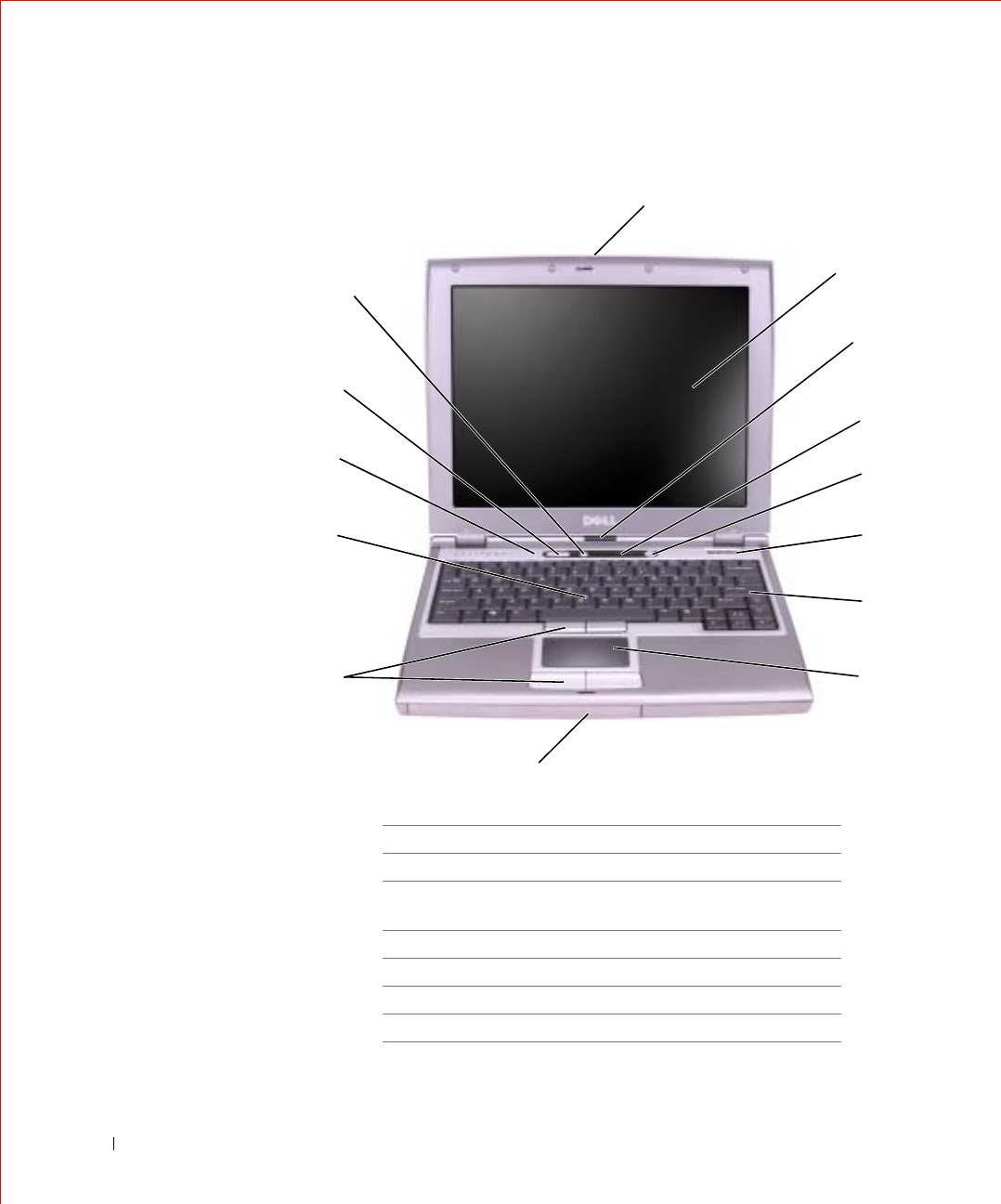
18 About Your Computer
www.dell.com | support.dell.com
FILE LOCATION: S:\SYSTEMS\Pebble\UG\A00\English\about.fm
DELL CONFIDENTIAL – PRELIMINARY 1/29/03 – FOR PROOF ONLY
Front View
1display latch 8touch pad
2display 9battery/battery bay
3device status lights 10 track stick/touch pad
buttons
4keyboard status lights 11 track stick
5power button 12 microphone
6speaker 13 volume control buttons
7keyboard 14 mute button
1
5
2
10
611
4
9
8
12
3
7
13
14
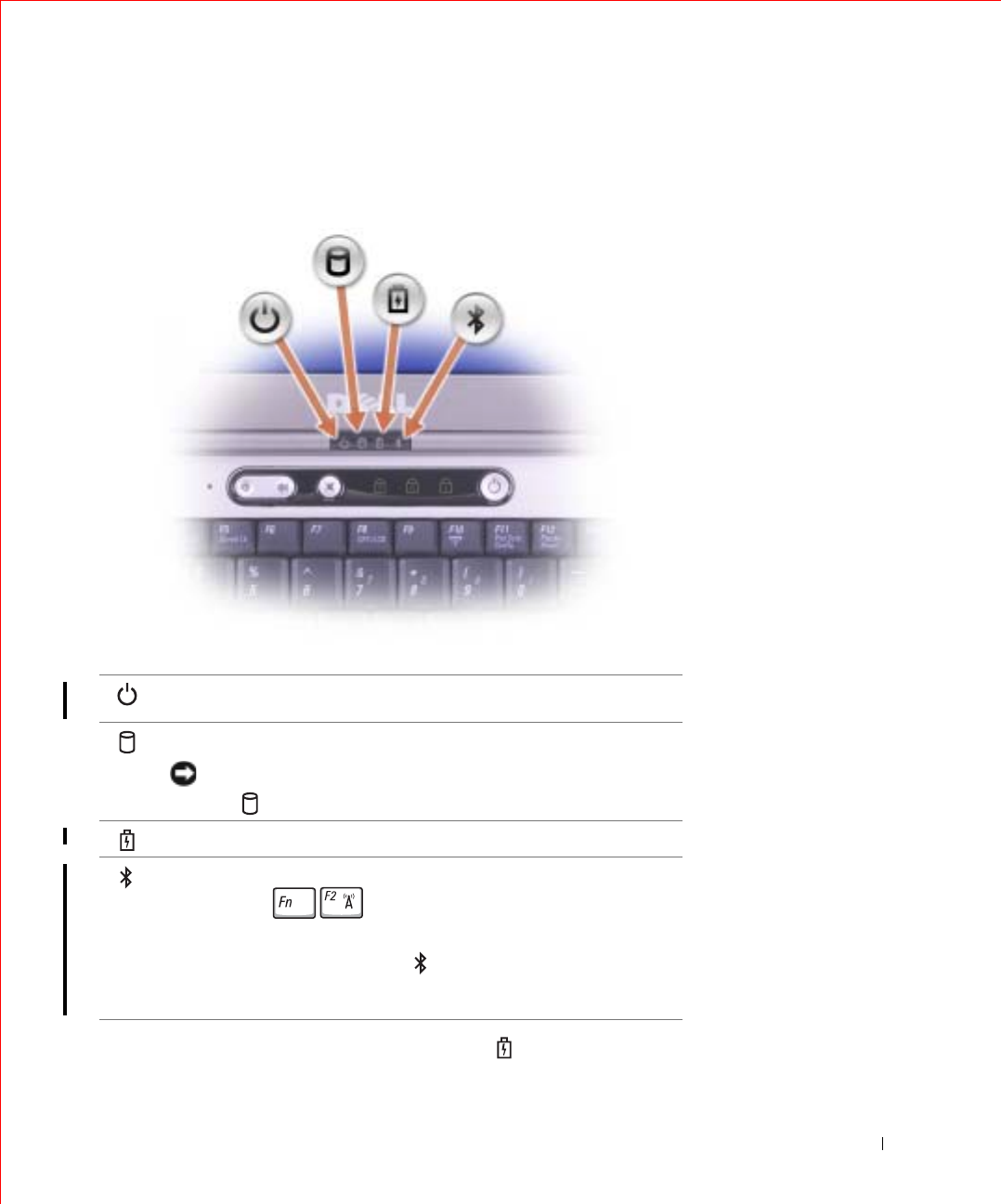
About Your Computer 19
FILE LOCATION: S:\SYSTEMS\Pebble\UG\A00\English\about.fm
DELL CONFIDENTIAL – PRELIMINARY 1/29/03 – FOR PROOF ONLY
DISPLAY LATCH —Slide the display latch to open the display.
DISPLAY —For more information about your display, see "Using the Display."
DEVICE STATUS LIGHTS
If the computer is connected to an electrical outlet, the light operates as
Turns on when you turn on the computerm or blinks steadily when the
computer is in standby mode.
Turns on when the computer reads or writes data.
NOTICE: To avoid loss of data, never turn off the computer while
the light is flashing.
Indicates battery charge status.
Turns on when the wireless antenna is enabled. To enable or disable the
antenna, press .
NOTE: The wireless features on your computer, including Bluetooth™ and
Mini PCI Wi-Fi, are optional. The icon turns on only if you ordered a
wireless option with your computer. For more information, see the
documentation that came with your wireless technology.
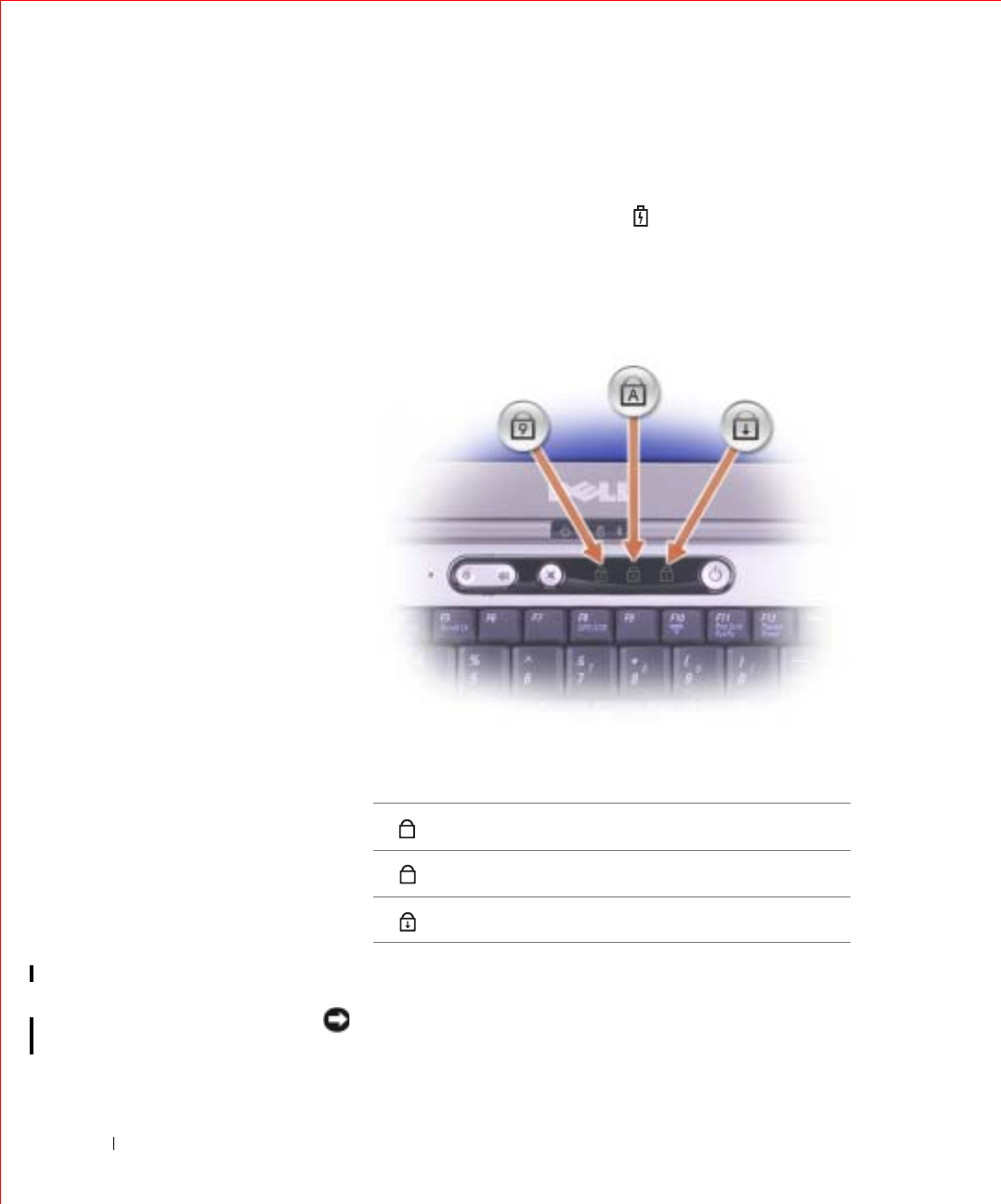
20 About Your Computer
www.dell.com | support.dell.com
FILE LOCATION: S:\SYSTEMS\Pebble\UG\A00\English\about.fm
DELL CONFIDENTIAL – PRELIMINARY 1/29/03 – FOR PROOF ONLY
follows:
– Solid green: The battery is charging.
– Flashing green: The battery is almost fully charged.
If the computer is running on a battery, the light operates as follows:
– Off: The battery is adequately charged (or the computer is turned off).
– Flashing orange: The battery charge is low.
– Solid orange: The battery charge is critically low.
KEYBOARD STATUS LIGHTS
The green lights located above the keyboard indicate the following:
POWER BUTTON —Press the power button to turn on the computer or to exit a
power management mode.
NOTICE: To avoid losing data, turn off your computer by performing an
operating system shutdown rather than by pressing the power button.
Turns on when the numeric keypad is enabled.
Turns on when the uppercase letter function is enabled.
Turns on when the scroll lock function is enabled.
9
A
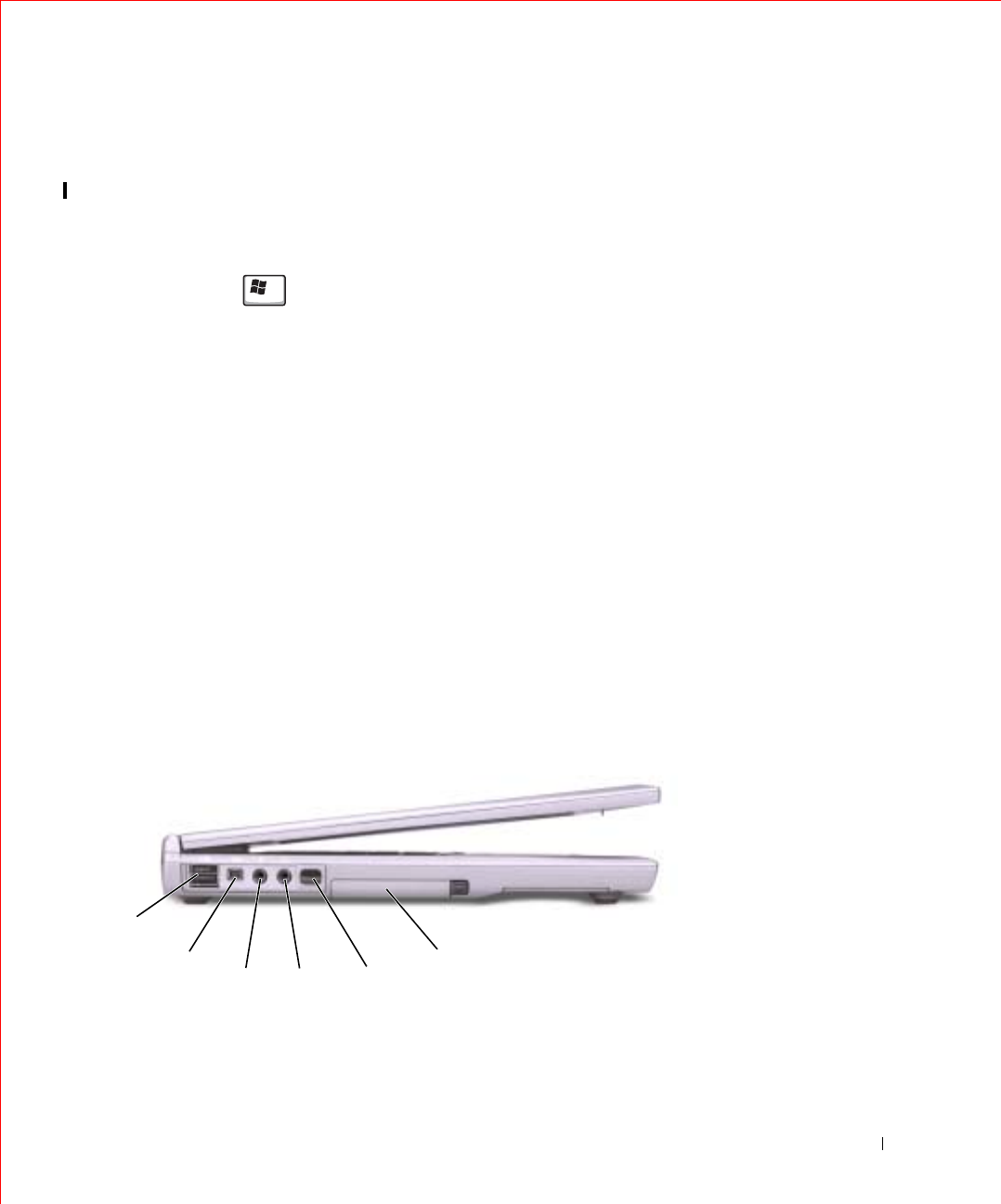
About Your Computer 21
FILE LOCATION: S:\SYSTEMS\Pebble\UG\A00\English\about.fm
DELL CONFIDENTIAL – PRELIMINARY 1/29/03 – FOR PROOF ONLY
If the computer stops responding, press and hold the power button until the
computer turns off completely (which may take several seconds).
SPEAKER —To adjust the volume of the integrated speaker, press the volume
control buttons or volume control keyboard shortcuts. For more information, see
"Using the Keyboard and Touch Pad."
KEYBOARD —The keyboard includes a numeric keypad as well as the Microsoft®
Windows® logo key . For information on supported keyboard shortcuts, see
"Using the Keyboard and Touch Pad."
TOUCH PAD —Touch pad and touch pad buttons provide the functionality of a
mouse. See "Using the Keyboard and Touch Pad" for more information.
BATTERY/BATTERY BAY —When a battery is installed, you can use the
computer without connecting the computer to an electrical outlet. See "Using a
Battery."
TRACK STICK/TOUCH PAD BUTTONS —Track stick and touch pad buttons
provide the functionality of a mouse. See "Using the Keyboard and Touch Pad" for
more information.
TRACK STICK —Track stick and track stick buttons provide the functionality of a
mouse. See "Using the Keyboard and Touch Pad" for more information.
MICROPHONE —Allows you to record audio.
VOLUME CONTROL BUTTONS —Press these buttons to adjust the volume.
MUTE BUTTON —Press this button to turn off the volume.
Left View
56
43
1
2
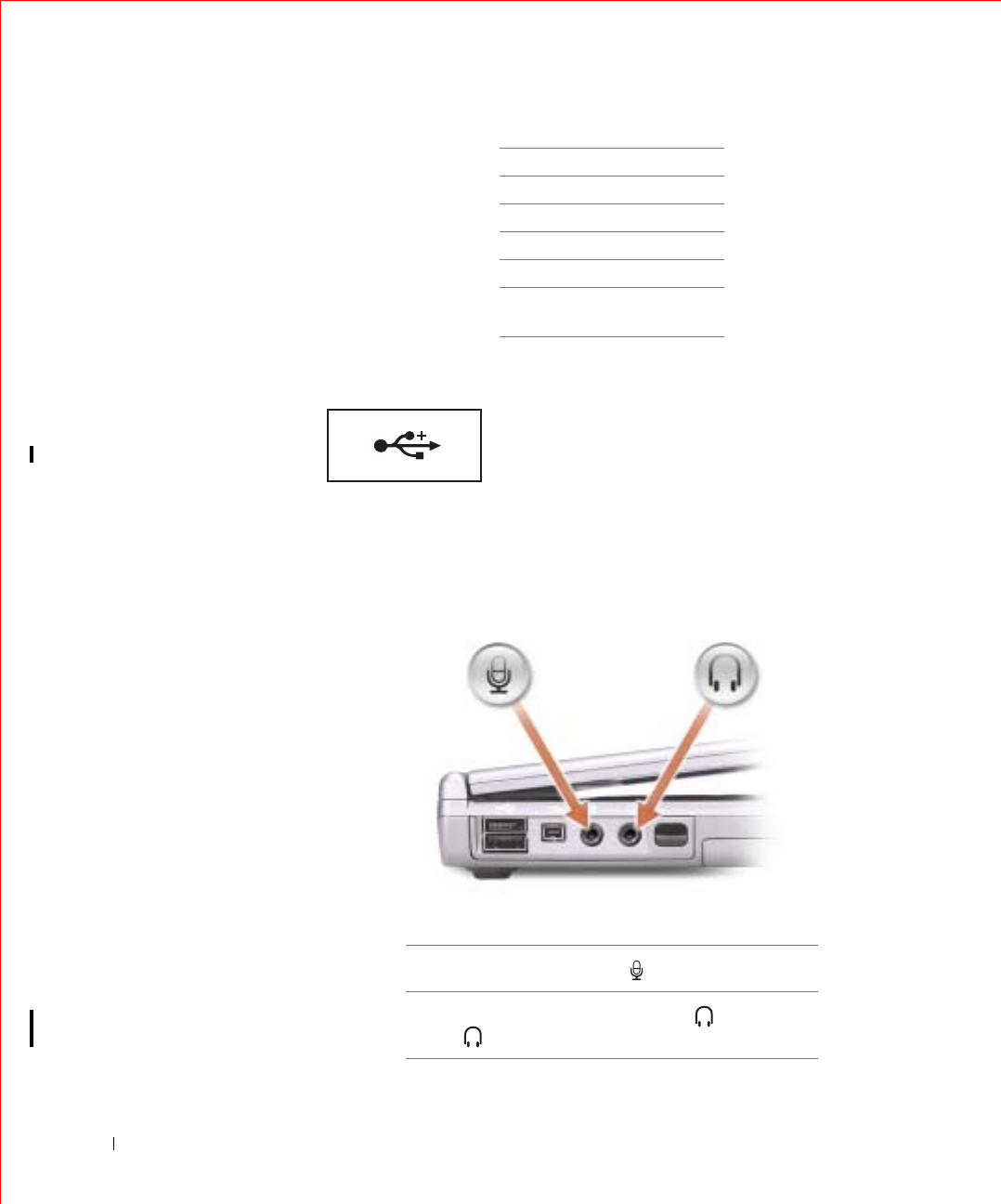
22 About Your Computer
www.dell.com | support.dell.com
FILE LOCATION: S:\SYSTEMS\Pebble\UG\A00\English\about.fm
DELL CONFIDENTIAL – PRELIMINARY 1/29/03 – FOR PROOF ONLY
DELL™ D/BAY CONNECTOR
IEEE 1394 CONNECTOR —Use to attach devices supporting IEEE 1394 high-
speed transfer rates, such as some digital video cameras.
AUDIO CONNECTORS
1Dell™ D/Bay connector
2IEEE 1394 connector
3audio connectors
4audio connectors
5infrared sensor
6PC Card slot (plastic
blank installed)
Connects the Dell™ D/Bay, which is an external media bay
that accommodates an optical drive, floppy drive, or second
hard drive; also connects standard USB devices
Attach a microphone to the connector.
Attach headphones or speakers to the connector.
The connector is a stereo output connector.
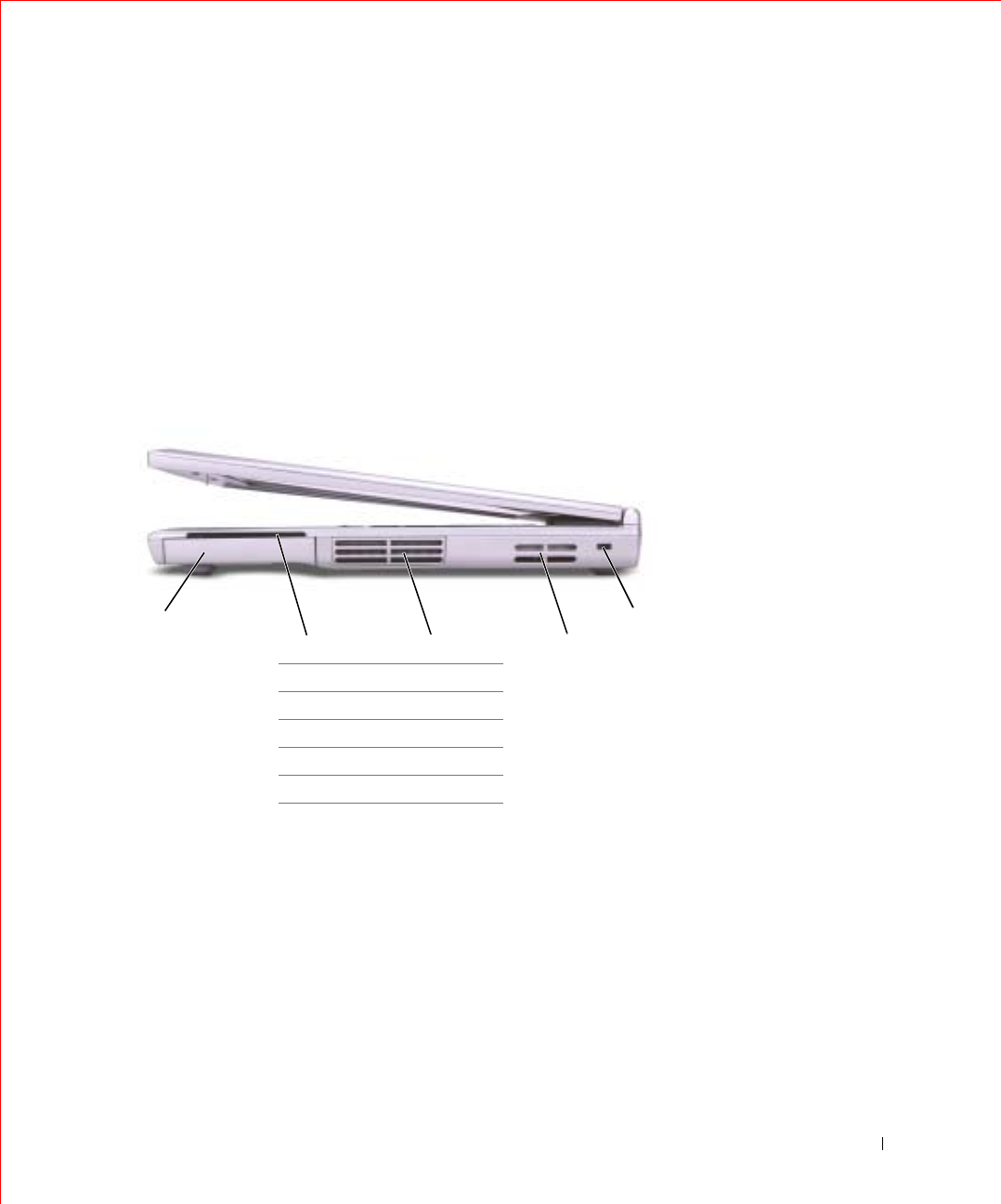
About Your Computer 23
FILE LOCATION: S:\SYSTEMS\Pebble\UG\A00\English\about.fm
DELL CONFIDENTIAL – PRELIMINARY 1/29/03 – FOR PROOF ONLY
INFRARED SENSOR —Lets you transfer files from your computer to another
IrDA-compatible device without using cable connections.
When you receive your computer, the sensor is disabled. You can use the system
setup program to enable the sensor. For information on transferring data, see
Windows Help, the Windows Help and Support Center, or the documentation that
came with your IrDA-compatible device.
PC CARD SLOT —Supports one PC Card, such as a modem or network adapter.
The computer ships with a plastic blank installed in the slot. For more information,
see "Using PC Cards."
Right View
HARD DRIVE —Stores software and data.
SMART CARD SLOT —Supports one smart card. For more information, see
"Using Smart Cards."
FAN EXHAUST —The computer uses an internal fan to create airflow through the
vents, which prevents the computer from overheating.
1hard drive
2smart card slot
3fan exhaust
4air intake
5security cable slot
5
3
124
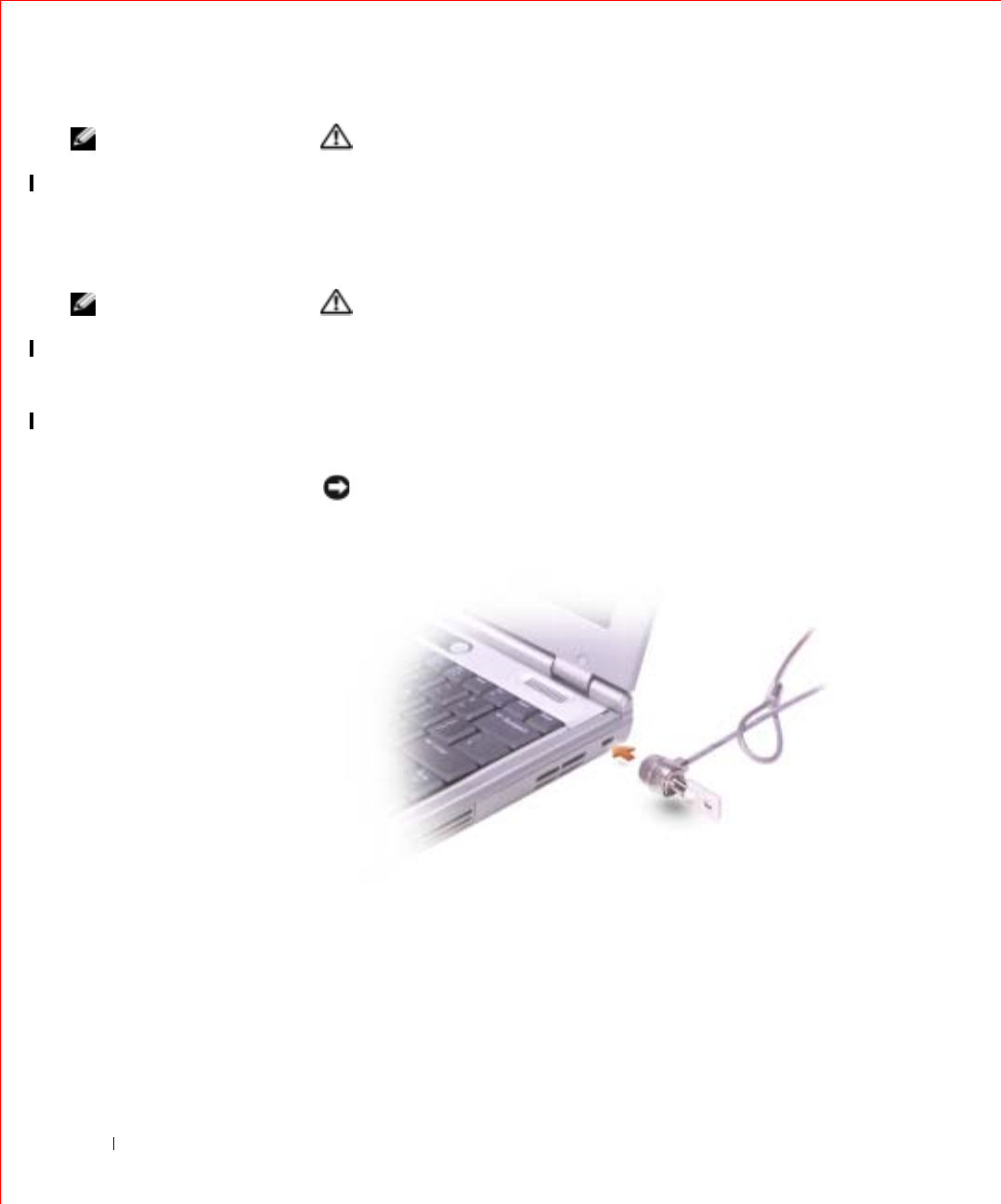
24 About Your Computer
www.dell.com | support.dell.com
FILE LOCATION: S:\SYSTEMS\Pebble\UG\A00\English\about.fm
DELL CONFIDENTIAL – PRELIMINARY 1/29/03 – FOR PROOF ONLY
NOTE: The computer
turns on the fan when the
computer gets warm. Fan
noise is normal and does
not indicate a problem
with the fan or the
computer.
CAUTION: Do not block, push objects into, or allow dust to
accumulate in the air vents. Do not store your computer in a low-
airflow environment, such as a closed briefcase, while it is
running. Restricting the airflow can damage the computer or
cause a fire.
AIR INTAKE —The computer uses an internal fan to create airflow through the
vents, which prevents the computer from overheating.
NOTE: The computer
turns on the fan when the
computer gets warm. Fan
noise is normal and does
not indicate a problem
with the fan or the
computer.
CAUTION: Do not block, push objects into, or allow dust to
accumulate in the air vents. Do not store your computer in a low-
airflow environment, such as a closed briefcase, while it is
running. Restricting the airflow can damage the computer or
cause a fire.
SECURITY CABLE SLOT —Allows you to attach a commercially available
antitheft device to the computer. For more information, see the instructions
included with the device.
NOTICE: Before you buy an antitheft device, ensure that it will work with the
security cable slot.
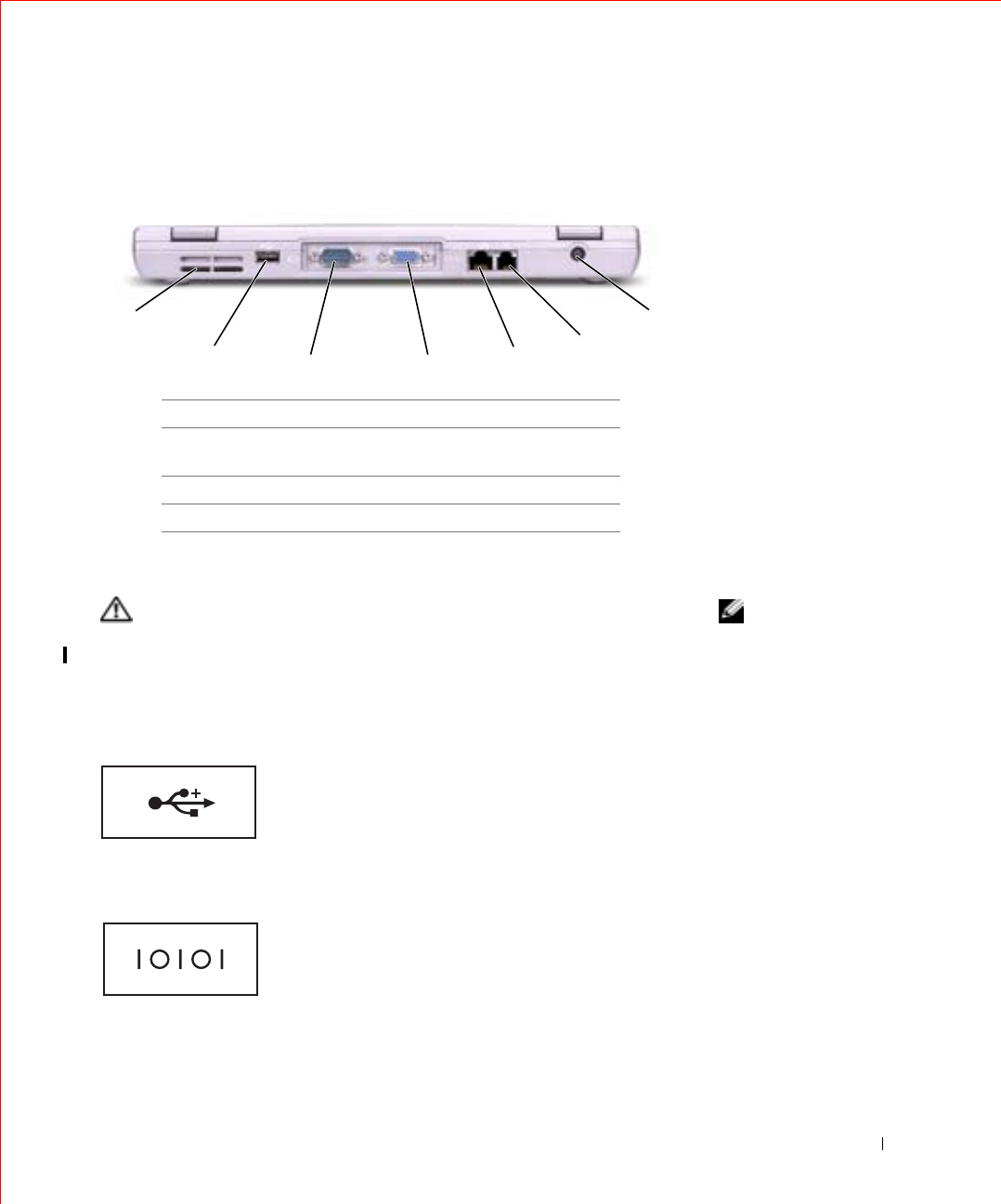
About Your Computer 25
FILE LOCATION: S:\SYSTEMS\Pebble\UG\A00\English\about.fm
DELL CONFIDENTIAL – PRELIMINARY 1/29/03 – FOR PROOF ONLY
Back View
AIR INTAKE —The computer uses an internal fan to create airflow through the
vents, which prevents the computer from overheating.
NOTE: The computer
turns on the fan when the
computer gets warm. Fan
noise is normal and does
not indicate a problem
with the fan or the
computer.
CAUTION: Do not block, push objects into, or allow dust to
accumulate in the air vents. Do not store your computer in a low-
airflow environment, such as a closed briefcase, while it is
running. Restricting the airflow can damage the computer or
cause a fire.
USB CONNECTOR
SERIAL CONNECTOR
1air intake 5network connector (RJ-45)
2USB connector 6modem connector (RJ-11)
(optional)
3serial connector 7AC Adapter connector
4video connector
56
4
3
1
2
7
Connects USB devices, such as a mouse, keyboard, or
printer. You can also connect the optional floppy drive
directly to the USB connector using the optional floppy-
drive cable.
Connects serial devices, such as a mouse or handheld device.
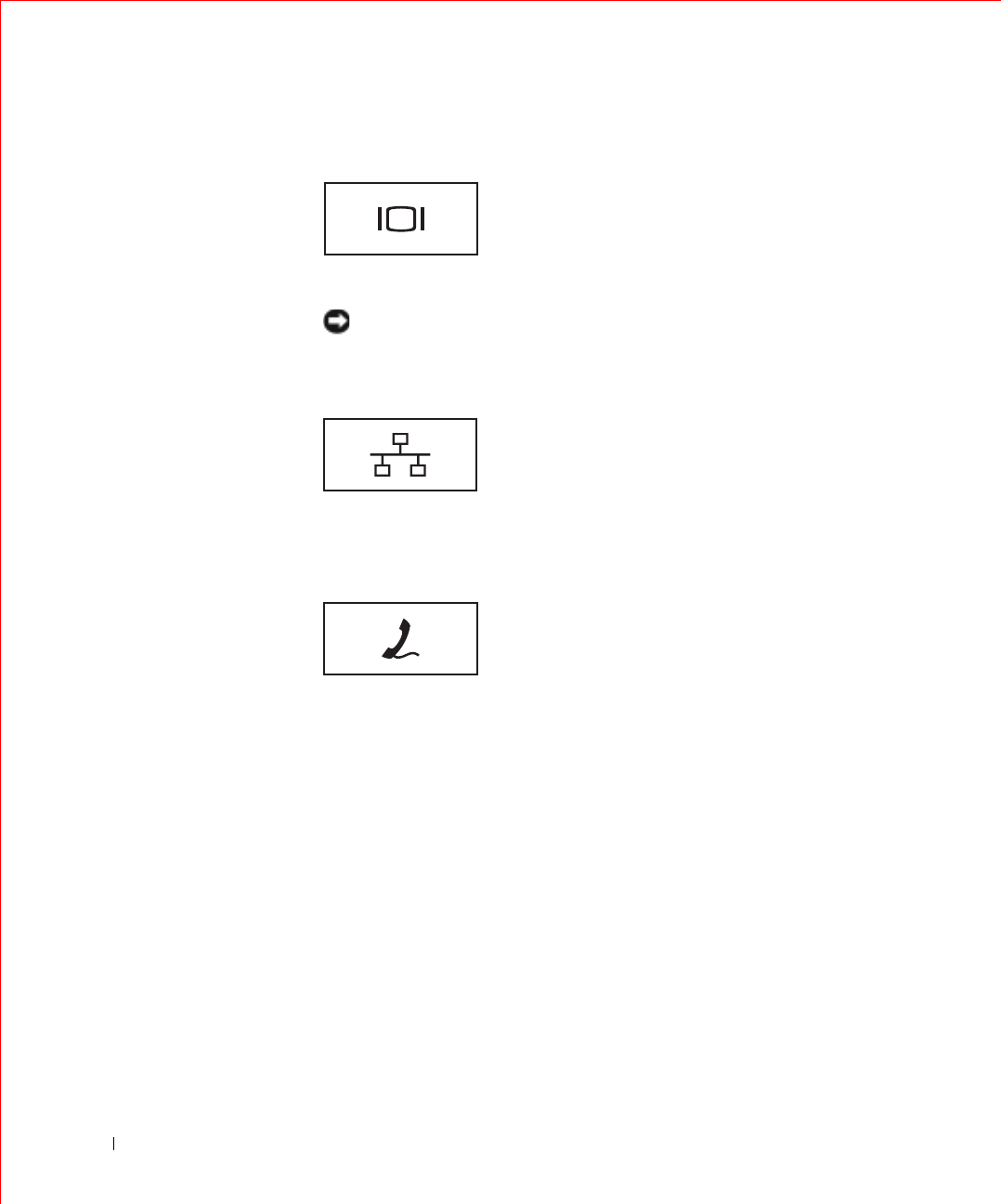
26 About Your Computer
www.dell.com | support.dell.com
FILE LOCATION: S:\SYSTEMS\Pebble\UG\A00\English\about.fm
DELL CONFIDENTIAL – PRELIMINARY 1/29/03 – FOR PROOF ONLY
VIDEO CONNECTOR
NETWORK CONNECTOR (RJ-45)
NOTICE: The network connector is slightly larger than the modem connector.
To avoid damaging the computer, do not plug a telephone line in to the network
connector.
MODEM CONNECTOR (RJ-11) (OPTIONAL)
AC ADAPTER CONNECTOR —Attach an AC adapter to the computer.
Connects an external monitor. For more information, see
"Using the Display."
Connects the computer to a network. The green and yellow
lights next to the connector indicate activity for both wired
and wireless network communications.
For information on using the network adapter, see the online
network-adapter documentation supplied with your
computer. See "Finding Information."
If you ordered the optional internal modem, connect the
telephone line to the modem connector.
For information on using the modem, see the online modem
documentation supplied with your computer. See "Finding
Information."
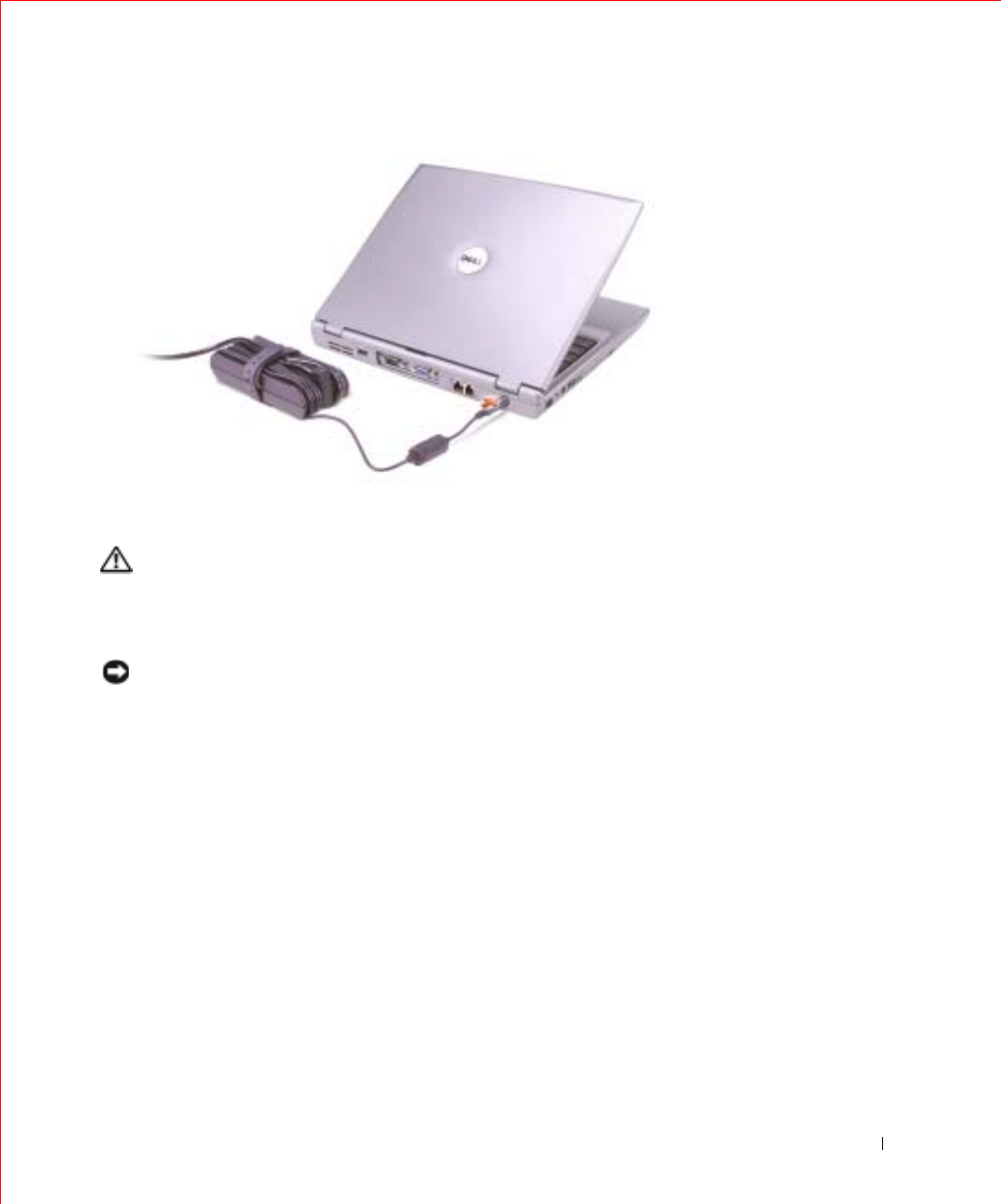
About Your Computer 27
FILE LOCATION: S:\SYSTEMS\Pebble\UG\A00\English\about.fm
DELL CONFIDENTIAL – PRELIMINARY 1/29/03 – FOR PROOF ONLY
The AC adapter converts AC power to the DC power required by the computer. You
can connect the AC adapter with your computer turned either on or off.
CAUTION: The AC adapter works with electrical outlets
worldwide. However, power connectors and power strips vary
among countries. Using an incompatible cable or improperly
connecting the cable to the power strip or electrical outlet may
cause fire or equipment damage.
NOTICE: When you disconnect the AC adapter cable from the computer,
grasp the connector, not the cable itself, and pull firmly but gently to avoid
damaging the cable.
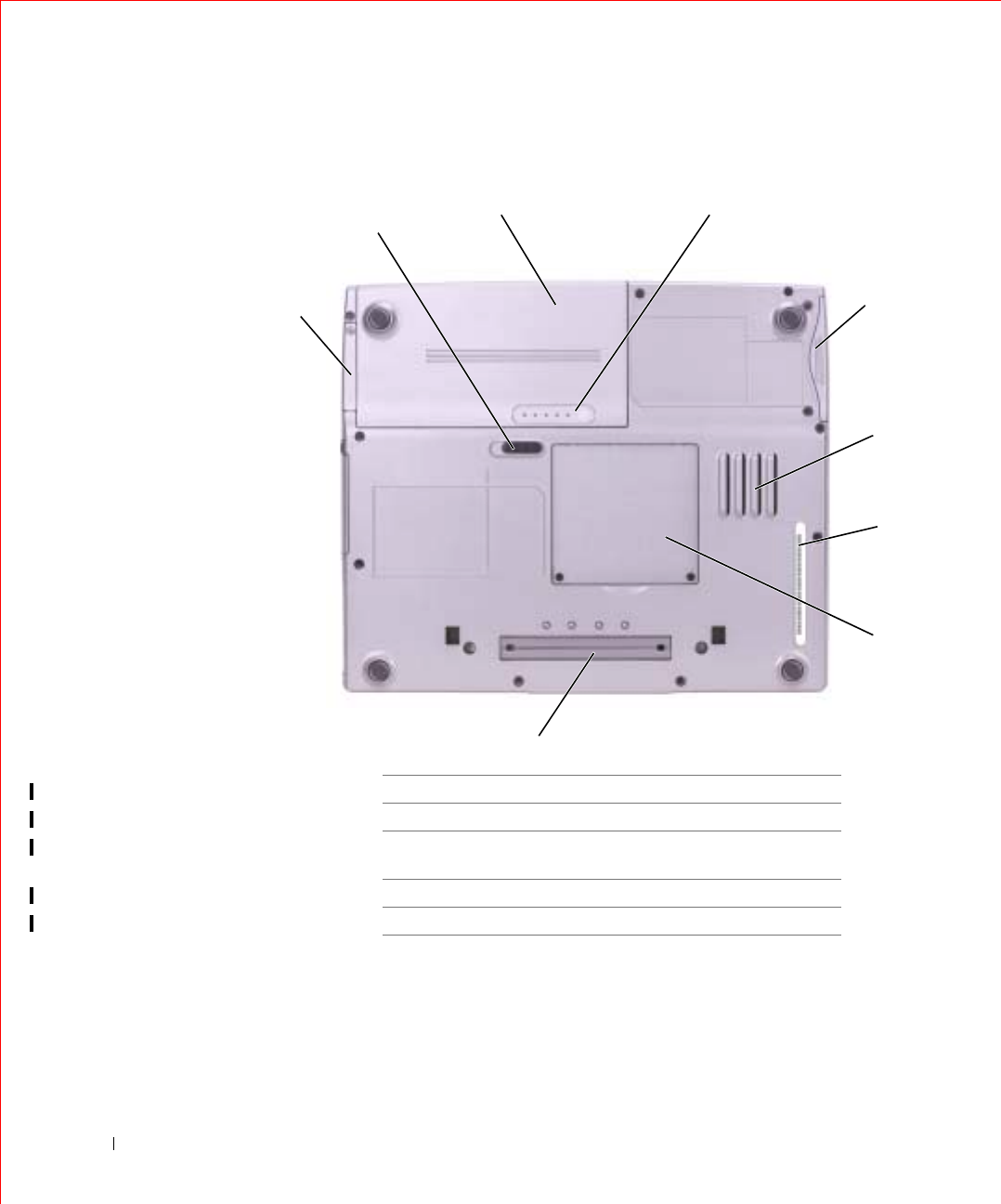
28 About Your Computer
www.dell.com | support.dell.com
FILE LOCATION: S:\SYSTEMS\Pebble\UG\A00\English\about.fm
DELL CONFIDENTIAL – PRELIMINARY 1/29/03 – FOR PROOF ONLY
Bottom View
BLUETOOTH MODULE COVER —Covers the compartment that contains the
optional Bluetooth module.
BATTERY-BAY LATCH RELEASE —Releases the battery. See "Removing a
Battery" for instructions.
6
2
8
15
9
3 4
7
1Bluetooth module cover 6air intake
2battery-bay latch release 7Service Tag
3battery 8memory module/modem
cover
4battery charge gauge 9docking device slot
5hard drive

About Your Computer 29
FILE LOCATION: S:\SYSTEMS\Pebble\UG\A00\English\about.fm
DELL CONFIDENTIAL – PRELIMINARY 1/29/03 – FOR PROOF ONLY
BATTERY —When a battery is installed, you can use the computer without
connecting the computer to an electrical outlet. See "Using a Battery."
BATTERY CHARGE GAUGE —Provides information on the battery charge. See
"Checking the Battery Charge."
HARD DRIVE —Stores software and data.
AIR INTAKE —The computer uses an internal fan to create airflow through the
vents, which prevents the computer from overheating.
NOTE: The computer
turns on the fan when the
computer gets warm. Fan
noise is normal and does
not indicate a problem
with the fans or the
computer.
CAUTION: Do not block, push objects into, or allow dust to
accumulate in the air vents. Do not store your computer in a low-
airflow environment, such as a closed briefcase, while it is
running. Restricting the airflow can damage the computer or
cause a fire.
SERVICE TAG —Identifies your computer when you access Dell Support at
support.dell.com or when you call Dell for customer service or technical support.
MEMORY MODULE/MODEM COVER —Covers the compartment that contains
the memory module and optional modem. See "Adding and Replacing Parts."
DOCKING DEVICE SLOT —Lets you attach your computer to a docking device.
See the documentation that came with your docking device for additional
information.

30 About Your Computer
www.dell.com | support.dell.com
FILE LOCATION: S:\SYSTEMS\Pebble\UG\A00\English\about.fm
DELL CONFIDENTIAL – PRELIMINARY 1/29/03 – FOR PROOF ONLY

FILE LOCATION: S:\SYSTEMS\Pebble\UG\A00\English\xpfeat.fm
DELL CONFIDENTIAL – PRELIMINARY 1/29/03 – FOR PROOF ONLY
3
SECTION 3
Using Microsoft®
Windows® XP

32 Using Microsoft® Windows® XP
www.dell.com | support.dell.com
FILE LOCATION: S:\SYSTEMS\Pebble\UG\A00\English\xpfeat.fm
DELL CONFIDENTIAL – PRELIMINARY 1/29/03 – FOR PROOF ONLY
NOTE: Windows XP
Home Edition and
Windows XP Professional
offer different features
and appearances. Also,
options available in
Windows XP Professional
vary depending on
whether your computer is
connected to a domain.
Help and Support Center
The Help and Support Center provides help with the Microsoft®
Windows® XP operating system and also offers other support and
educational tools. To access the Help and Support Center, click the Start
button and click Help and Support.
Switching to Classic View
You can change the appearance of the Control Panel, the Start menu, and
the Microsoft® Windows® desktop to the classic view of previous Windows
operating systems.
Control Panel
The Control Panel presents information as task-oriented categories. If you
are accustomed to performing a particular task with the icon-oriented
classic Control Panel, you can switch to the classic icon view.
1Click the Start button and click Control Panel.
2Click Switch to Classic View or Switch to Category View in the
upper-left area of the Control Panel window.
Start Menu
1Right-click the empty area on the taskbar.
2Click Properties and click the Start Menu tab.
3Click Classic Start Menu and click OK.
Window and Button Appearance
1Right-click anywhere on the main desktop screen and click Properties.
2Click the Appearance tab.
3From the Windows and buttons drop-down menu, click Windows
Classic style.
4To customize color, font, and other classic desktop options, click
Advanced.
5When you have completed your appearance selections, click OK.

Using Microsoft® Windows® XP 33
FILE LOCATION: S:\SYSTEMS\Pebble\UG\A00\English\xpfeat.fm
DELL CONFIDENTIAL – PRELIMINARY 1/29/03 – FOR PROOF ONLY
Desktop Cleanup Wizard
By default, the Desktop Cleanup Wizard moves desktop icons that are not
frequently used from your desktop to a designated folder 7 days after you
first start your computer and every 60 days after that. The appearance of the
Start menu changes as desktop icons are moved.
To turn off the Desktop Cleanup Wizard:
1Right-click an empty spot on the desktop and click Properties.
2Click the Desktop tab and click Customize Desktop.
3Click Run Desktop Cleanup Wizard every 60 days to remove the
check mark.
4Click OK.
To run the Desktop Cleanup Wizard at any time:
1Right-click an empty spot on the desktop and click Properties.
2Click the Desktop tab and click Customize Desktop.
3Click Clean Desktop Now.
4When the Desktop Cleanup Wizard screen appears, click Next.
5To leave an icon on the desktop, click the icon name to remove the
check mark, and then click Next.
6Click Finish to remove the shortcuts and close the wizard.
Transferring Information to a New
Computer
The Microsoft® Windows® XP operating system provides a Files and
Settings Transfer wizard to move data from the source computer to the new
computer. You can move data such as:
•E-mails
• Toolbar settings
• Window sizes
• Internet bookmarks

34 Using Microsoft® Windows® XP
www.dell.com | support.dell.com
FILE LOCATION: S:\SYSTEMS\Pebble\UG\A00\English\xpfeat.fm
DELL CONFIDENTIAL – PRELIMINARY 1/29/03 – FOR PROOF ONLY
You can transfer the data to the new computer over a network or serial
connection, or you can store it on a removable medium, such as a writable
CD or floppy disk.
To prepare the new computer for the file transfer:
1Click the Start button, point to All Programs→ Accessories→ System
Tools, and then click Files and Settings Transfer Wizard.
2When the Files and Settings Transfer Wizard welcome screen
appears, click Next.
3On the Which computer is this? screen, click New Computer and
click Next.
4On the Do you have a Windows XP CD? screen, click I will use the
wizard from the Windows XP CD and click Next.
5When the Now go to your old computer screen appears, go to your old
or source computer. Do not click Next at this time.
To copy data from the old computer:
1On the old computer, insert the Windows XP Operating System CD.
2On the Welcome to Microsoft Windows XP screen, click Perform
additional tasks.
3Under What do you want to do?, click Transfer files and settings.
4On the Files and Settings Transfer Wizard welcome screen, click Next.
5On the Which computer is this? screen, click Old Computer and click
Next.
6On the Select a transfer method screen, click the transfer method you
prefer.
7On the What do you want to transfer? screen, select the items you
want to transfer and click Next.
After the information has been copied, the Completing the
Collection Phase screen appears.
8Click Finish.
To transfer data to the new computer:
1On the Now go to your old computer screen on the new computer,
click Next.

Using Microsoft® Windows® XP 35
FILE LOCATION: S:\SYSTEMS\Pebble\UG\A00\English\xpfeat.fm
DELL CONFIDENTIAL – PRELIMINARY 1/29/03 – FOR PROOF ONLY
2On the Where are the files and settings? screen, select the method you
chose for transferring your settings and files and click Next.
The wizard reads the collected files and settings and applies them to
your new computer.
When all of the settings and files have been applied, the Finished
screen appears.
3Click Finished and restart the new computer.
User Accounts and Fast User Switching
Adding User Accounts
After the Microsoft® Windows® XP operating system is installed, the
administrator or a user with administrator rights can create additional user
accounts.
1Click the Start button and click Control Panel.
2In the Control Panel window, click User Accounts.
3Under Pick a task, click Create a new account.
4Under Name the new account, type the name of the new user and
click Next.
5Under Pick an account type, click one of the following options:
•Computer administrator — You can change all computer settings.
•Limited — You can change only your own personal settings, such
as your password. You cannot install programs or use the Internet.
6Click Create Account.
Fast User Switching
NOTE: Fast User
Switching is unavailable
if your computer is
running Windows XP
Professional and is a
member of a computer
domain, or if your
computer has less than
128 MB of memory.
Fast User Switching allows multiple users to access one computer without
requiring the previous user to log off.
1Click the Start button and click Log Off.
2In the Log Off Windows window, click Switch User.

36 Using Microsoft® Windows® XP
www.dell.com | support.dell.com
FILE LOCATION: S:\SYSTEMS\Pebble\UG\A00\English\xpfeat.fm
DELL CONFIDENTIAL – PRELIMINARY 1/29/03 – FOR PROOF ONLY
When you use Fast User Switching, programs that previous users were using
remain running in the background, so your computer might run slower.
Also, multimedia programs, such as games and DVD software, might not
work with Fast User Switching. For more information, see the Windows
Help and Support Center.
Setting Up a Home and Office Network
Connecting to a Network Adapter
Before you connect your computer to a network, the computer must have a
network adapter installed and a functional network cable connected to it.
To connect a network cable:
NOTE: Insert the cable
until it clicks into place,
and then gently pull it to
ensure that it is secure.
1Connect the network cable to the network adapter connector on the
back of your computer.
NOTE: Do not use a
network cable with a
telephone wall jack.
2Connect the other end of the functional network cable to a network
connection device, such as a network wall jack.
Network Setup Wizard
The Microsoft® Windows® XP operating system provides a Network Setup
Wizard to guide you through the process of sharing files, printers, or an
Internet connection between computers in a home or small office.
1Click the Start button, point to All Programs→ Accessories→
Communications, and then click Network Setup Wizard.
2On the welcome screen, click Next.
3Click Checklist for creating a network.
NOTE: Selecting the
connection method This
computer connects
directly to the Internet
enables the integrated
firewall provided with
Windows XP.
4Complete the checklist and required preparations.
5Return to the Network Setup Wizard and follow the instructions on
the screen.

Using Microsoft® Windows® XP 37
FILE LOCATION: S:\SYSTEMS\Pebble\UG\A00\English\xpfeat.fm
DELL CONFIDENTIAL – PRELIMINARY 1/29/03 – FOR PROOF ONLY
Internet Connection Firewall
The Internet Connection Firewall provides basic protection from
unauthorized access to the computer while the computer is connected to
the Internet. The firewall is automatically enabled when you run the
Network Setup Wizard. When the firewall is enabled for a network
connection, the firewall icon appears with a red background in the Network
Connections portion of the Control Panel.
Note that enabling the Internet Connection Firewall does not reduce the
need for virus-checking software.
For more information, see the Help and Support Center.

38 Using Microsoft® Windows® XP
www.dell.com | support.dell.com
FILE LOCATION: S:\SYSTEMS\Pebble\UG\A00\English\xpfeat.fm
DELL CONFIDENTIAL – PRELIMINARY 1/29/03 – FOR PROOF ONLY

FILE LOCATION: S:\SYSTEMS\Pebble\UG\A00\English\quickset.fm
DELL CONFIDENTIAL – PRELIMINARY 1/29/03 – FOR PROOF ONLY
4
SECTION 4
Dell™ QuickSet
Features
Horizontal Rule

40 Dell™ QuickSet Features
www.dell.com | support.dell.com
FILE LOCATION: S:\SYSTEMS\Pebble\UG\A00\English\quickset.fm
DELL CONFIDENTIAL – PRELIMINARY 1/29/03 – FOR PROOF ONLY
Dell QuickSet provides you with easy access to configuration settings for
power management schemes, battery resources, icon and font size, display
brightness, volume, and network activity. If QuickSet is installed on your
computer, it runs from the icon located in the taskbar. If QuickSet is
not installed, you can download the program from support.dell.com.
QuickSet functions differently when you click, double-click, or right-click
the icon.
Clicking the QuickSet Icon
Click the icon to perform the following tasks:
• Adjust power management settings using the Power Management
Wizard.
• Adjust the size of icons and toolbars.
• Select a power scheme that you set in the Power Management Wizard.
• Turn presentation mode on or off.
Double-Clicking the QuickSet Icon
Double-click the icon to adjust power management settings using the
Power Management Wizard.
Right-Clicking the QuickSet Icon
Right-click the icon to perform the following tasks:
• Enable or disable the Brightness Meter on the screen.
• Enable or disable the Volume Meter on the screen.
• Turn wireless activity on or off.
•View Dell QuickSet Help.
• View the version and copyright date of the QuickSet program installed
on your computer.

Dell™ QuickSet Features 41
FILE LOCATION: S:\SYSTEMS\Pebble\UG\A00\English\quickset.fm
DELL CONFIDENTIAL – PRELIMINARY 1/29/03 – FOR PROOF ONLY
For more information about QuickSet, right-click the icon in the
taskbar and click Help.

42 Dell™ QuickSet Features
www.dell.com | support.dell.com
FILE LOCATION: S:\SYSTEMS\Pebble\UG\A00\English\quickset.fm
DELL CONFIDENTIAL – PRELIMINARY 1/29/03 – FOR PROOF ONLY

FILE LOCATION: S:\SYSTEMS\Pebble\UG\A00\English\keyboard.fm
DELL CONFIDENTIAL – PRELIMINARY 1/29/03 – FOR PROOF ONLY
5
SECTION 5
Using the Keyboard
and Touch Pad
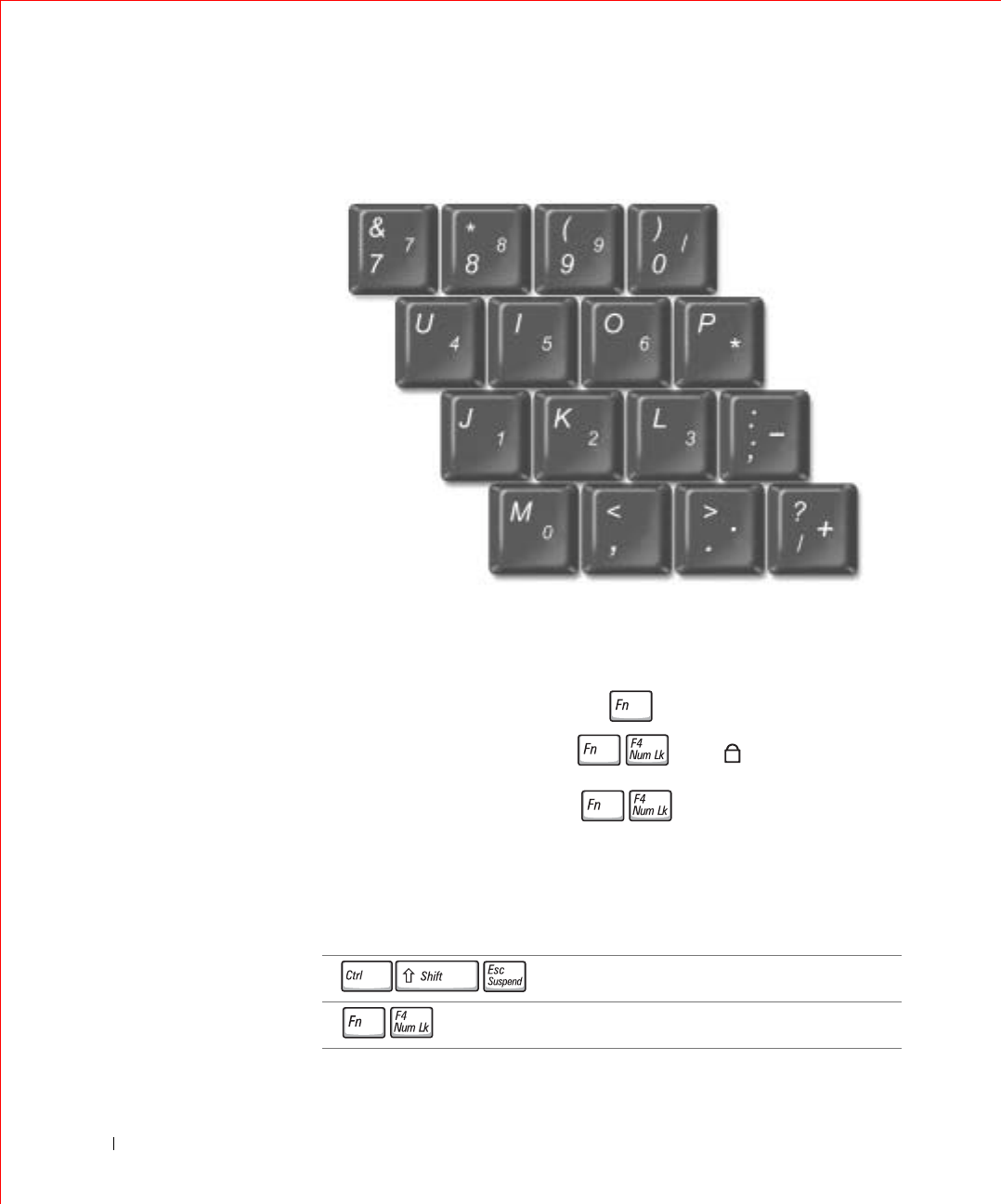
44 Using the Keyboard and Touch Pad
www.dell.com | support.dell.com
FILE LOCATION: S:\SYSTEMS\Pebble\UG\A00\English\keyboard.fm
DELL CONFIDENTIAL – PRELIMINARY 1/29/03 – FOR PROOF ONLY
Numeric Keypad
The numeric keypad functions like the numeric keypad on an external
keyboard. Each key on the keypad has multiple functions. The keypad
numbers and symbols are marked in blue on the right of the keypad keys. To
type a number or symbol, hold down and press the desired key.
• To enable the keypad, press . The light indicates that
the keypad is active.
• To disable the keypad, press again.
Keyboard Shortcuts
System Functions
Opens the Task Manager window
Enables and disables the numeric keypad
9
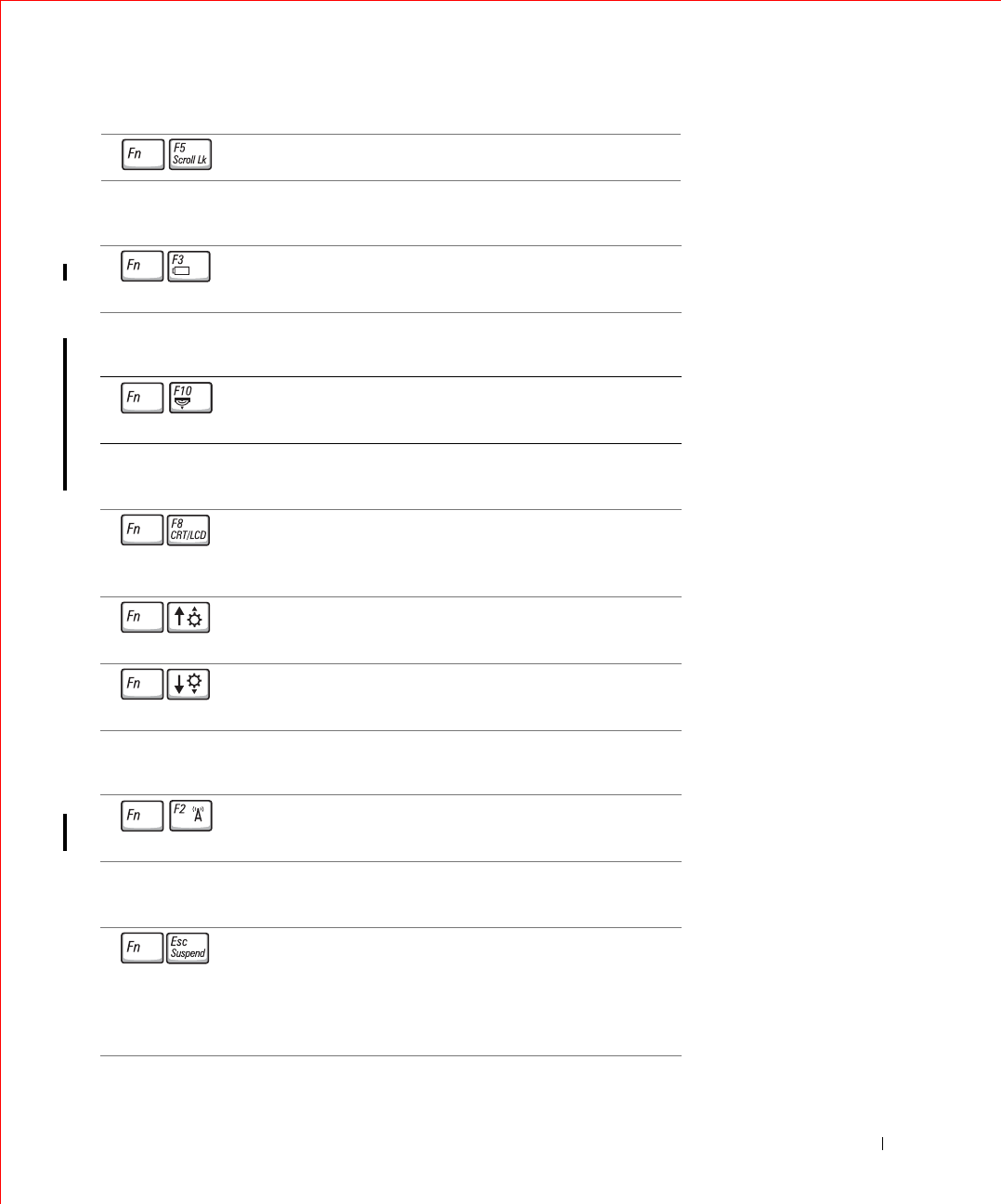
Using the Keyboard and Touch Pad 45
FILE LOCATION: S:\SYSTEMS\Pebble\UG\A00\English\keyboard.fm
DELL CONFIDENTIAL – PRELIMINARY 1/29/03 – FOR PROOF ONLY
Battery
CD or DVD Tray
Display Functions
Radios (Including Wireless Networking and Bluetooth™)
Power Management
Enables and disables the scroll lock
Displays the Dell™ QuickSet Battery Meter (if
QuickSet is installed)
Ejects the tray out of the drive (if Dell QuickSet is
installed)
Switches the video image to the next display option.
The options include the integrated display, an external
monitor, and both displays simultaneously.
Increases brightness on the integrated display only
(not on an external monitor).
Decreases brightness on the integrated display only
(not on an external monitor).
Enables and disables radios, including wireless
networking and Bluetooth (both optional)
Activates a power management mode. You can
reprogram this keyboard shortcut to activate a
different power management mode using the
Advanced tab in the Power Options Properties
window.
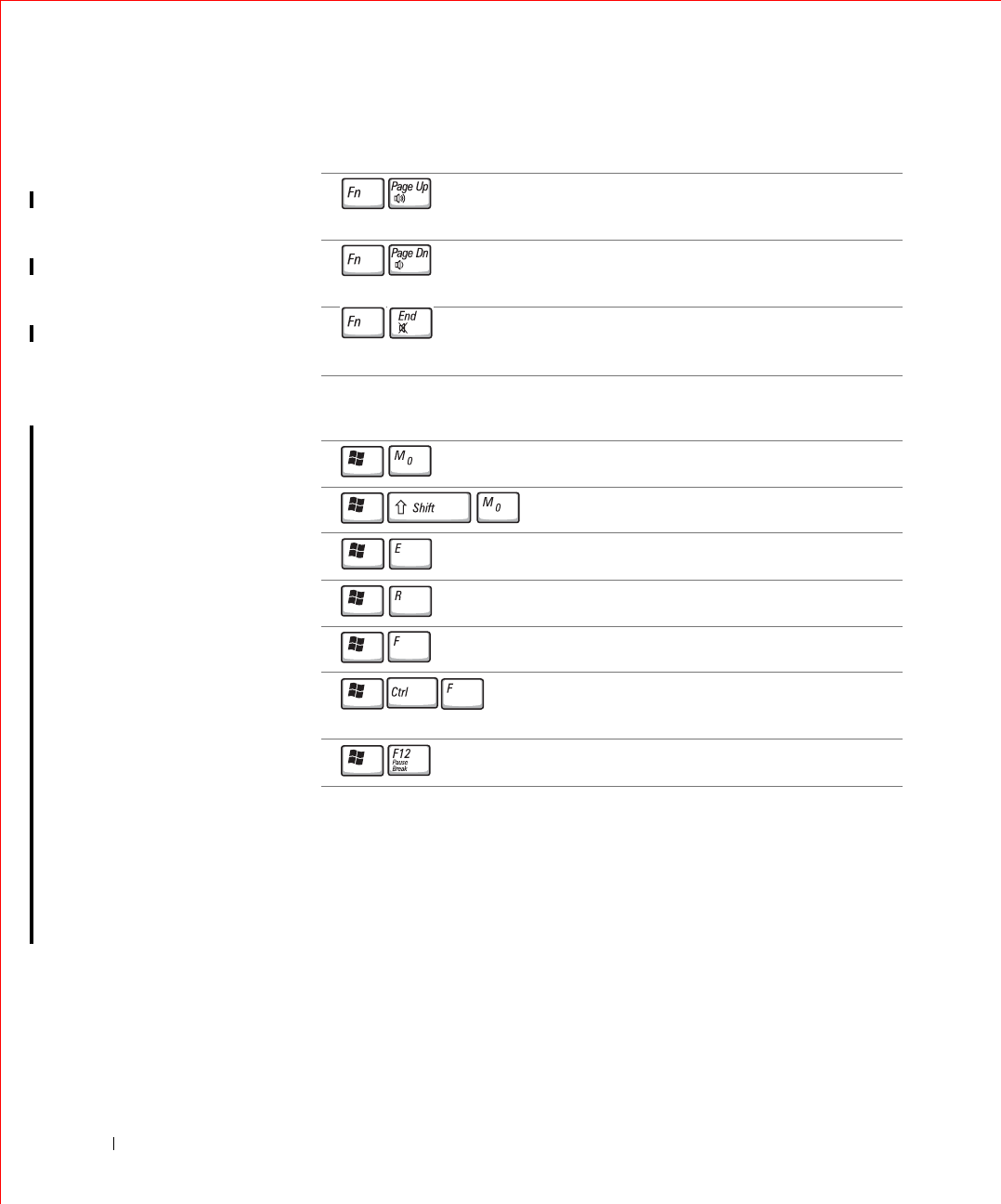
46 Using the Keyboard and Touch Pad
www.dell.com | support.dell.com
FILE LOCATION: S:\SYSTEMS\Pebble\UG\A00\English\keyboard.fm
DELL CONFIDENTIAL – PRELIMINARY 1/29/03 – FOR PROOF ONLY
Speaker Functions
Microsoft® Windows® Logo Key Functions
To adjust keyboard operation, such as the character repeat rate:
•In Windows XP, open the Control Panel, click Printers and Other
Hardware, and click Keyboard.
•In Windows 2000, open the Control Panel and double-click the
Keyboard icon.
Increases the volume of the integrated speaker and
external speakers, if attached
Decreases the volume of the integrated speaker and
external speakers, if attached
Enables and disables the integrated speaker and
external speakers, if attached
Minimizes all open windows
Maximizes all windows
Runs Windows Explorer
Opens the Run dialog box
Opens the Search Results dialog box
Opens the Search Results-Computer dialog box (if
the computer is connected to a network)
Opens the System Properties dialog box
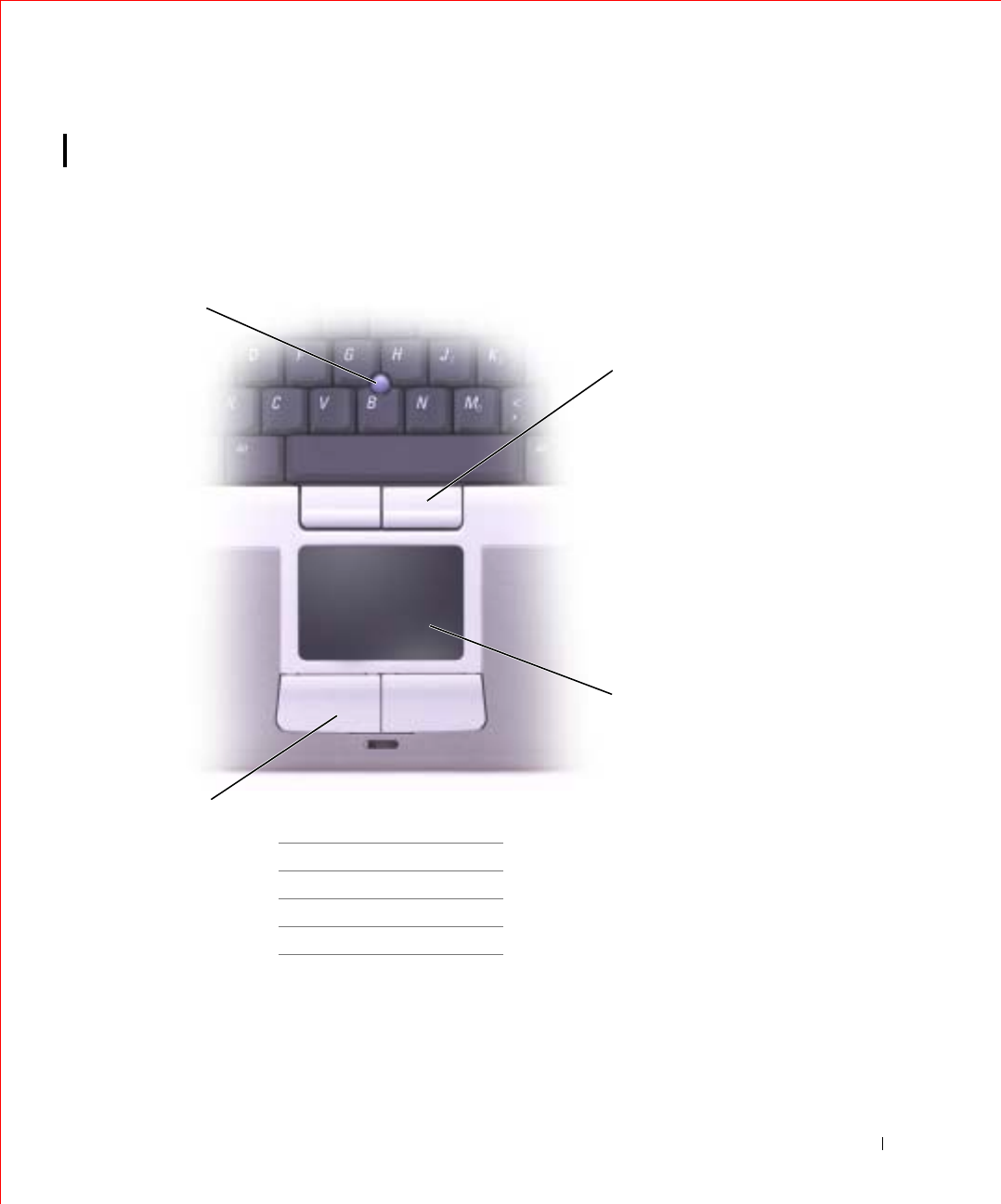
Using the Keyboard and Touch Pad 47
FILE LOCATION: S:\SYSTEMS\Pebble\UG\A00\English\keyboard.fm
DELL CONFIDENTIAL – PRELIMINARY 1/29/03 – FOR PROOF ONLY
Touch Pad
The touch pad detects the pressure and movement of your finger to allow
you to move the cursor on the display. Use the touch pad and touch pad
buttons as you would use a mouse.
• To move the cursor, lightly slide your finger over the touch pad.
• To select an object, lightly tap once on the surface of the touch pad or
use your thumb to press the left touch-pad button.
1track stick
2track stick buttons
3touch pad
4touch pad buttons
4
3
1
2

48 Using the Keyboard and Touch Pad
www.dell.com | support.dell.com
FILE LOCATION: S:\SYSTEMS\Pebble\UG\A00\English\keyboard.fm
DELL CONFIDENTIAL – PRELIMINARY 1/29/03 – FOR PROOF ONLY
• To select and move (or drag) an object, position the cursor on the
object and tap down-up-down on the touch pad. On the second down
motion, leave your finger on the touch pad and move the selected
object by sliding your finger over the surface.
• To double-click an object, position the cursor on the object and tap
twice on the touch pad or use your thumb to press the left touch-pad
button twice.
You can also use the track stick to move the cursor. Press the track stick left,
right, up, or down to change the direction of the cursor on the display. Use
the track stick and track stick buttons as you would use a mouse.
Customizing the Touch Pad and Track Stick
You can use the Mouse Properties window to disable the touch pad and
track stick or adjust their settings.
1In Windows XP, open the Control Panel, click Printers and Other
Hardware, and click Mouse.
In Windows 2000, open the Control Panel and double-click the Mouse
icon.
2In the Mouse Properties window:
•Click the Device Select tab to disable the touch pad and track
stick.
•Click the Pointer tab to adjust touch pad and track stick settings.
3Click OK to save the settings and close the window.
Changing the Track Stick Cap
You can replace your track stick cap if it wears down from prolonged use or if
you prefer a different color. You can purchase additional caps by visiting the
Dell website at www.dell.com.
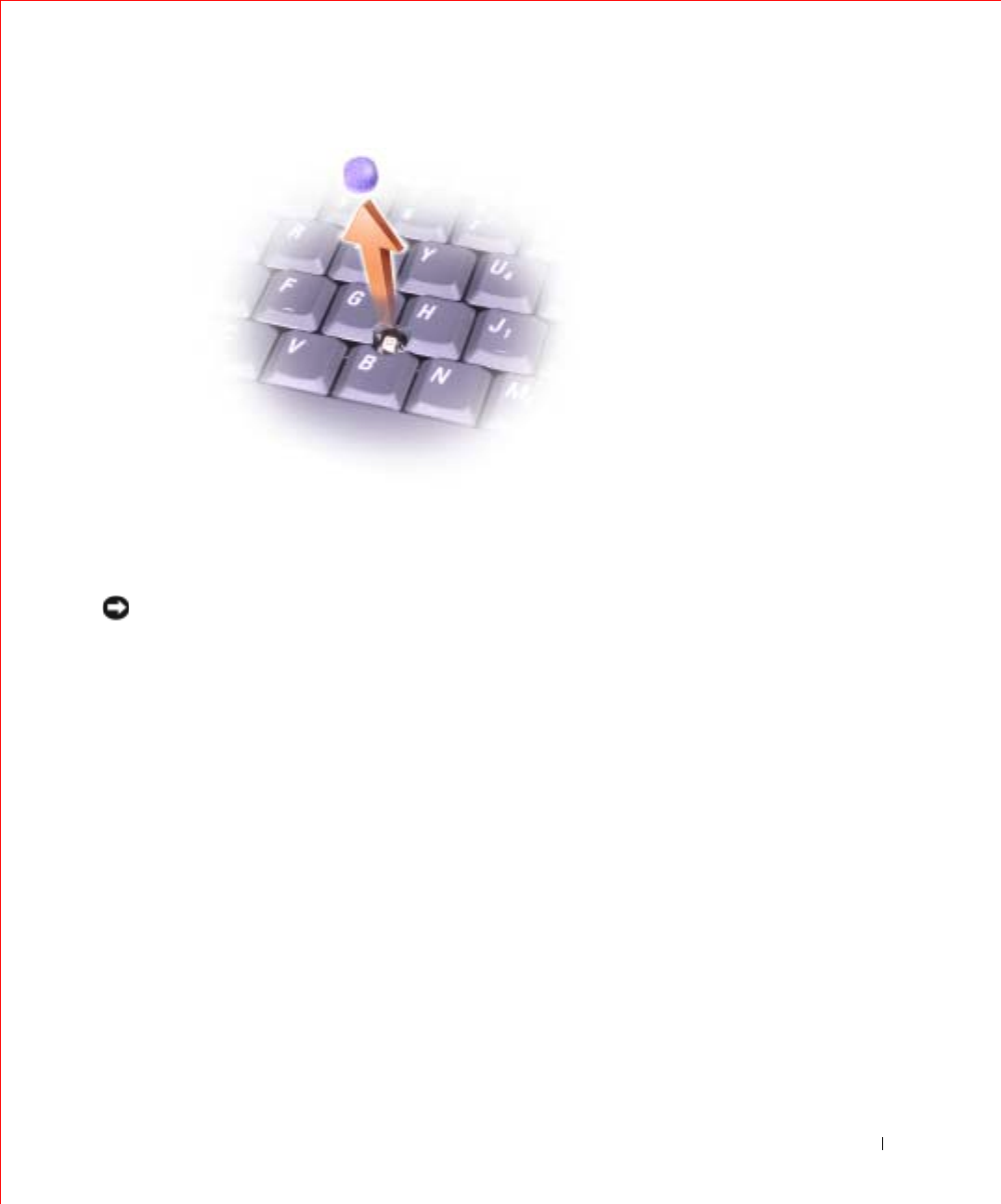
Using the Keyboard and Touch Pad 49
FILE LOCATION: S:\SYSTEMS\Pebble\UG\A00\English\keyboard.fm
DELL CONFIDENTIAL – PRELIMINARY 1/29/03 – FOR PROOF ONLY
1Pull the cap off the track stick.
2Align the new cap over the square track-stick post and gently press the
cap down onto the post.
NOTICE: The track stick can damage the display if it is not properly seated
on the post.
3Test the track stick to ensure that the cap is seated properly.

50 Using the Keyboard and Touch Pad
www.dell.com | support.dell.com
FILE LOCATION: S:\SYSTEMS\Pebble\UG\A00\English\keyboard.fm
DELL CONFIDENTIAL – PRELIMINARY 1/29/03 – FOR PROOF ONLY

FILE LOCATION: S:\SYSTEMS\Pebble\UG\A00\English\display.fm
DELL CONFIDENTIAL – PRELIMINARY 1/29/03 – FOR PROOF ONLY
6
SECTION 6
Using the Display
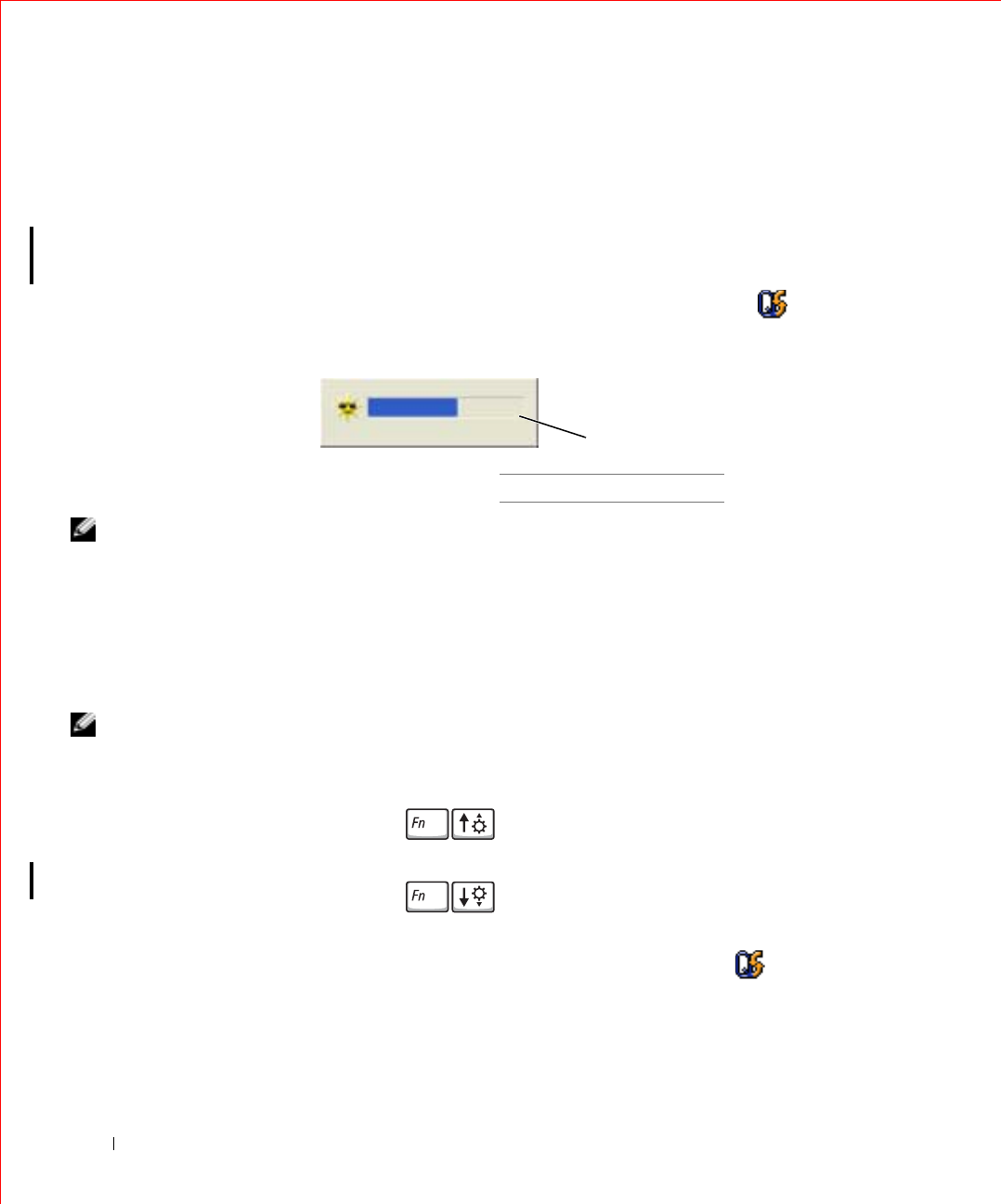
52 Using the Display
www.dell.com | support.dell.com
FILE LOCATION: S:\SYSTEMS\Pebble\UG\A00\English\display.fm
DELL CONFIDENTIAL – PRELIMINARY 1/29/03 – FOR PROOF ONLY
Adjusting Brightness
When the Dell™ computer is running on battery power, you can conserve
power by setting the brightness to the lowest comfortable setting using the
appropriate keyboard shortcuts for the display.
If Dell QuickSet is installed, the QuickSet Brightness Meter shows the
current brightness setting for the display. Right-click the icon in the
taskbar to enable or disable the Brightness Meter on the screen.
NOTE: By default, the
Brightness Meter appears
in the lower-right corner
of the display. You can
click and drag the meter
to a new location, and the
meter subsequently
always appears at the new
location.
NOTE: Brightness
keyboard shortcuts only
affect the display on your
portable computer, not
monitors that you attach
to your portable computer
or docking device. If your
computer is connected to
an external monitor and
you try to change the
brightness level, the
Brightness Meter
appears, but the
brightness level on the
monitor does not change.
You can enable or disable the Brightness Meter from the QuickSet taskbar
menu. When the meter is enabled, press the following keys to adjust
brightness:
•Press to increase brightness on the integrated display only (not
on an external monitor).
•Press to decrease brightness on the integrated display only (not
on an external monitor).
For more information about QuickSet, right-click the icon in the
taskbar and click Help.
1Brightness Meter
1

Using the Display 53
FILE LOCATION: S:\SYSTEMS\Pebble\UG\A00\English\display.fm
DELL CONFIDENTIAL – PRELIMINARY 1/29/03 – FOR PROOF ONLY
Switching the Video Image
When you start the computer with an external device (such as an external
monitor or projector) attached and turned on, the image may appear on
either the display or the external device.
Press to switch the video image to the display only, the external
device only, or the display and the external device simultaneously.
Setting Display Resolution
To display a program at a specific resolution, both the video controller and
the display must support the program, and the necessary video drivers must
be installed.
Before you change any of the default display settings, make a note of the
default settings for future reference.
NOTE: Use only the Dell-
installed video drivers,
which are designed to
offer the best
performance with your
Dell-installed operating
system.
If you choose a resolution or color palette that is higher than the display
supports, the settings adjust automatically to the closest possible setting.
Microsoft® Windows® XP
1Click the Start button and click Control Panel.
2Under Pick a category, click Appearance and Themes.
3Under Pick a task..., click the area you want to change, or under or
pick a Control Panel icon, click Display.
4Try different settings for Color quality and Screen resolution.
Windows 2000
1Click the Start button, point to Settings, and then click Control
Panel.
2Double-click the Display icon and click the Settings tab.
3Try different settings for Colors and Screen area.

54 Using the Display
www.dell.com | support.dell.com
FILE LOCATION: S:\SYSTEMS\Pebble\UG\A00\English\display.fm
DELL CONFIDENTIAL – PRELIMINARY 1/29/03 – FOR PROOF ONLY
NOTE: As the resolution
increases, icons and text
appear smaller on the
screen.
If the video resolution setting is higher than that supported by the display,
the computer enters pan mode. In pan mode, the screen cannot be
completely displayed. For example, the taskbar that usually appears at the
bottom of the desktop may no longer be visible. To view the rest of the
screen, use the touch pad or track stick to pan up, down, left, and right.
NOTICE: You can damage an external monitor by using an unsupported
refresh rate. Before adjusting the refresh rate on an external monitor, see the
monitor user's guide.

FILE LOCATION: S:\SYSTEMS\Pebble\UG\A00\English\bay.fm
DELL CONFIDENTIAL – PRELIMINARY 1/29/03 – FOR PROOF ONLY
7
SECTION 7
Using the Dell™ D/Bay
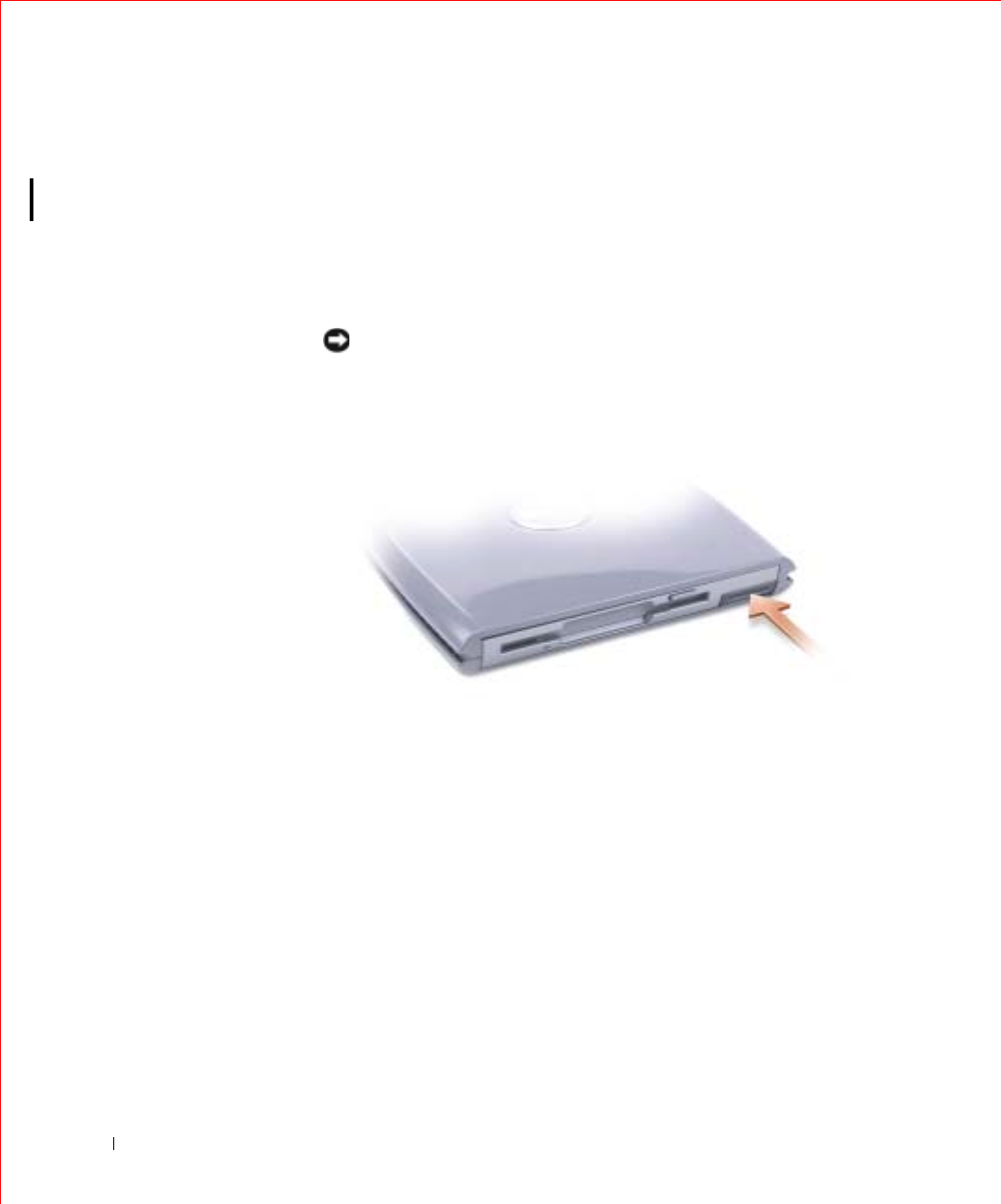
56 Using the Dell™ D/Bay
www.dell.com | support.dell.com
FILE LOCATION: S:\SYSTEMS\Pebble\UG\A00\English\bay.fm
DELL CONFIDENTIAL – PRELIMINARY 1/29/03 – FOR PROOF ONLY
About the Dell D/Bay
You can install Dell Latitude™ D-Family devices such as a floppy drive or an
optical drive.
Removing and Installing Devices When
the Computer is Turned Off
NOTICE: To prevent damage to devices, place them in a safe, dry place when
they are not installed in the computer. Avoid pressing down on them or placing
heavy objects on top of them.
1Press the device latch release so that the latch release pops out.
2Pull the device by the latch release to remove the device from the
D/Bay.
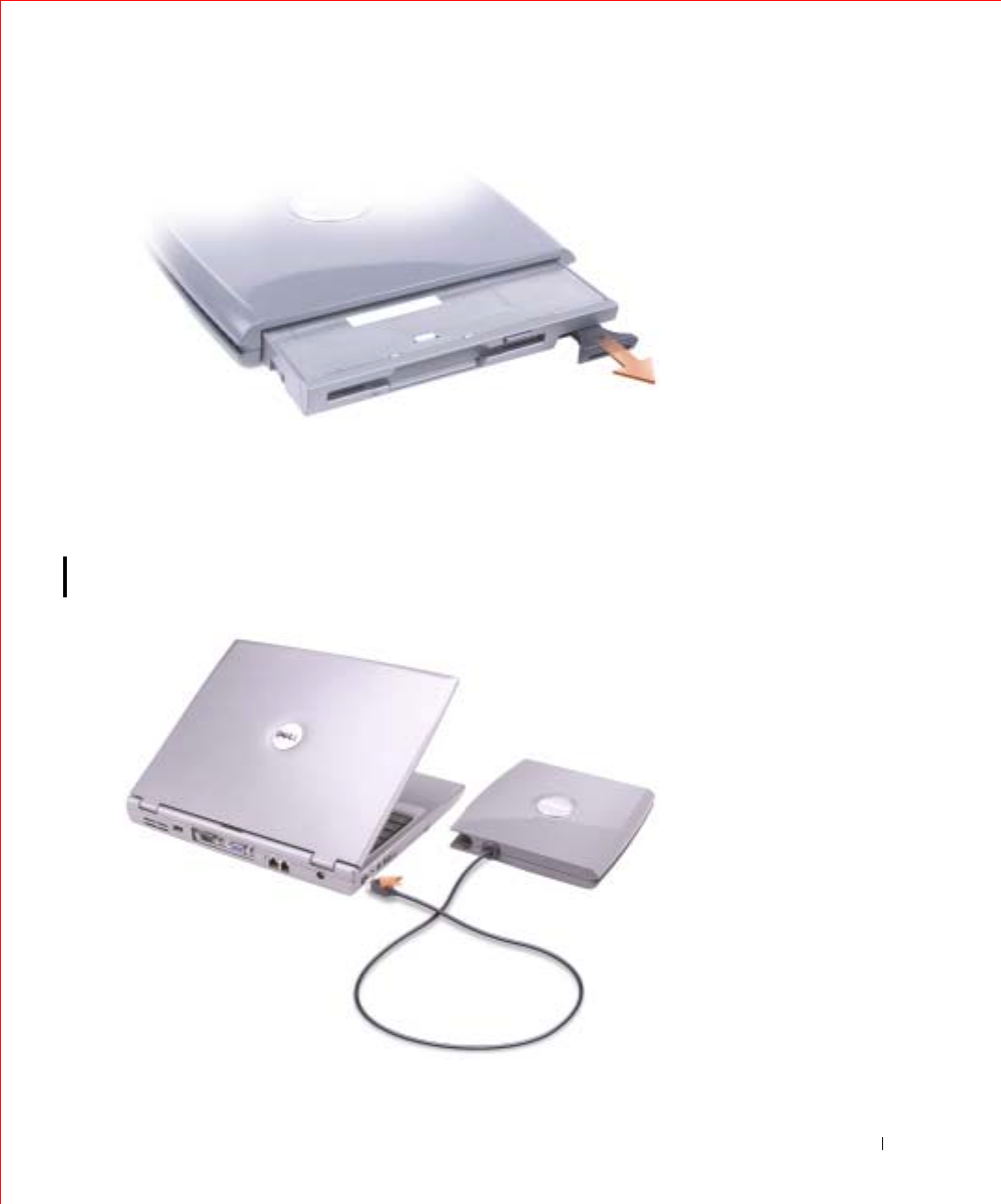
Using the Dell™ D/Bay 57
FILE LOCATION: S:\SYSTEMS\Pebble\UG\A00\English\bay.fm
DELL CONFIDENTIAL – PRELIMINARY 1/29/03 – FOR PROOF ONLY
3Insert the new device into the bay, push the device until you feel a
click, and push the device latch release in so that it is flush with the
computer.
4Connect the D/Bay cable to the Dell D/Bay connector on the
computer..
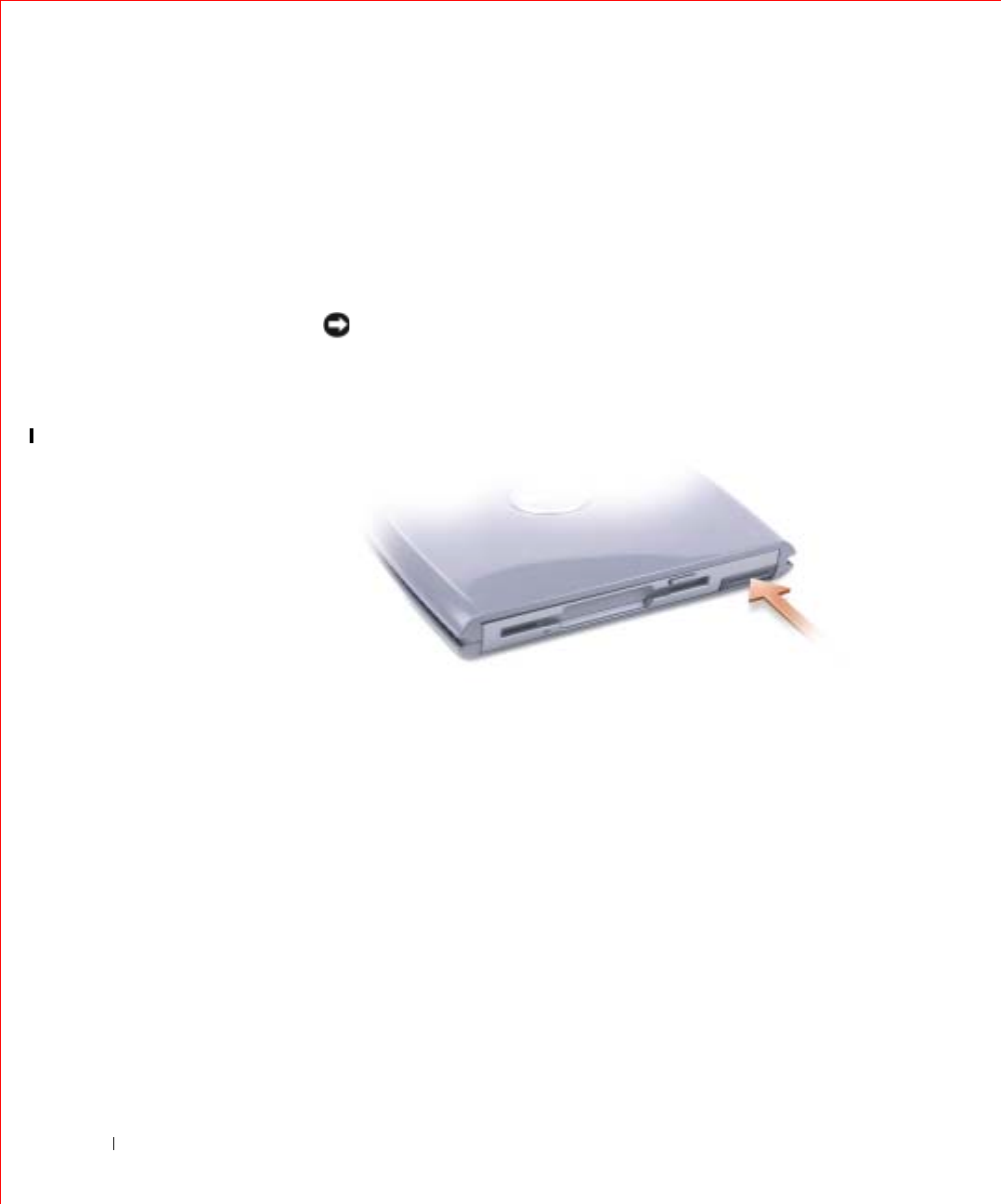
58 Using the Dell™ D/Bay
www.dell.com | support.dell.com
FILE LOCATION: S:\SYSTEMS\Pebble\UG\A00\English\bay.fm
DELL CONFIDENTIAL – PRELIMINARY 1/29/03 – FOR PROOF ONLY
Removing and Installing Devices While
the Computer Is Running
Microsoft® Windows® XP
1Double-click the Safely Remove Hardware icon on the taskbar.
2Click the device you want to eject.
NOTICE: To prevent damage to devices, place them in a safe, dry place when
they are not installed in the computer. Avoid pressing down on them or placing
heavy objects on top of them.
3Press the device latch release so that the latch release pops out.
4Pull the device by the latch release to remove the device from the
D/Bay.
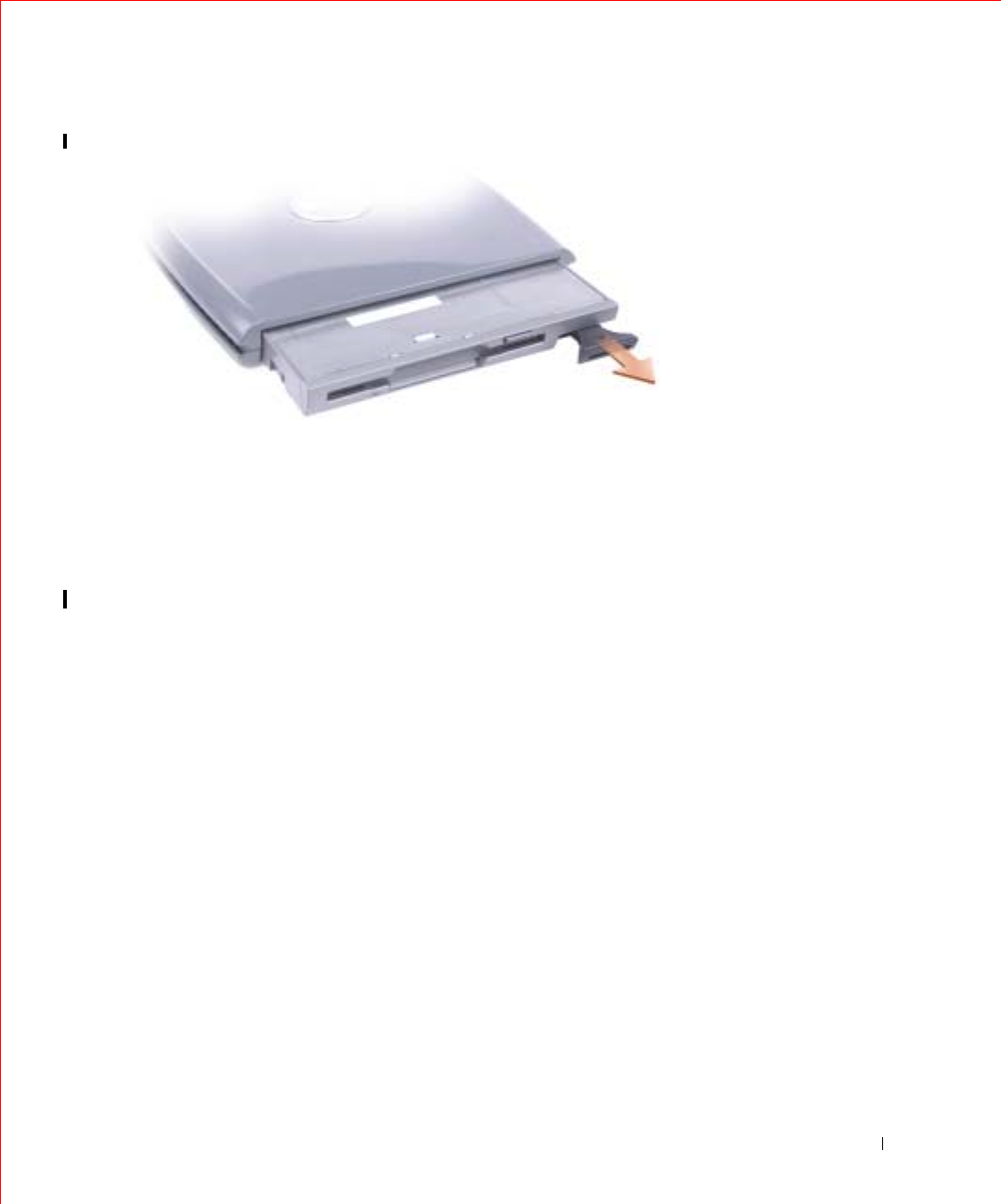
Using the Dell™ D/Bay 59
FILE LOCATION: S:\SYSTEMS\Pebble\UG\A00\English\bay.fm
DELL CONFIDENTIAL – PRELIMINARY 1/29/03 – FOR PROOF ONLY
5Insert the new device into the bay, push the device until you feel a
click, and push the device latch release in so that it is flush with the
computer.
Windows XP automatically recognizes the new device.
6If necessary, enter your password to unlock your drive.
Windows 2000
1Click the Unplug or Eject Hardware icon on the taskbar.
2Click the device you want to eject and click Stop.
3Press the device latch release so that the latch release pops out.
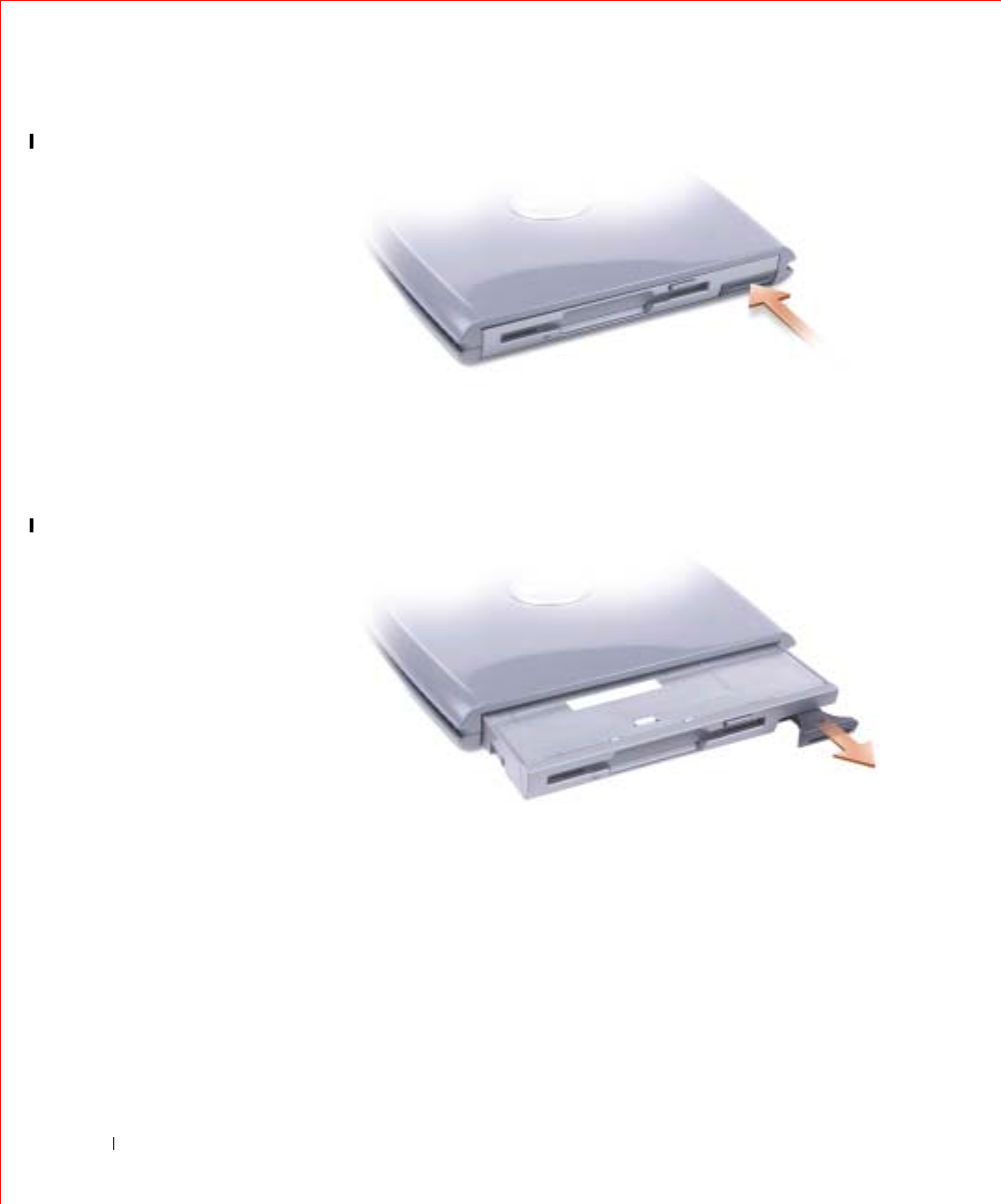
60 Using the Dell™ D/Bay
www.dell.com | support.dell.com
FILE LOCATION: S:\SYSTEMS\Pebble\UG\A00\English\bay.fm
DELL CONFIDENTIAL – PRELIMINARY 1/29/03 – FOR PROOF ONLY
4Pull the device by the latch release to remove the device from the
D/Bay.
5Insert the new device into the bay, push the device until you feel a
click, and push the device latch release in so that it is flush with the
computer.
6When the operating system recognizes the new device, click Close.
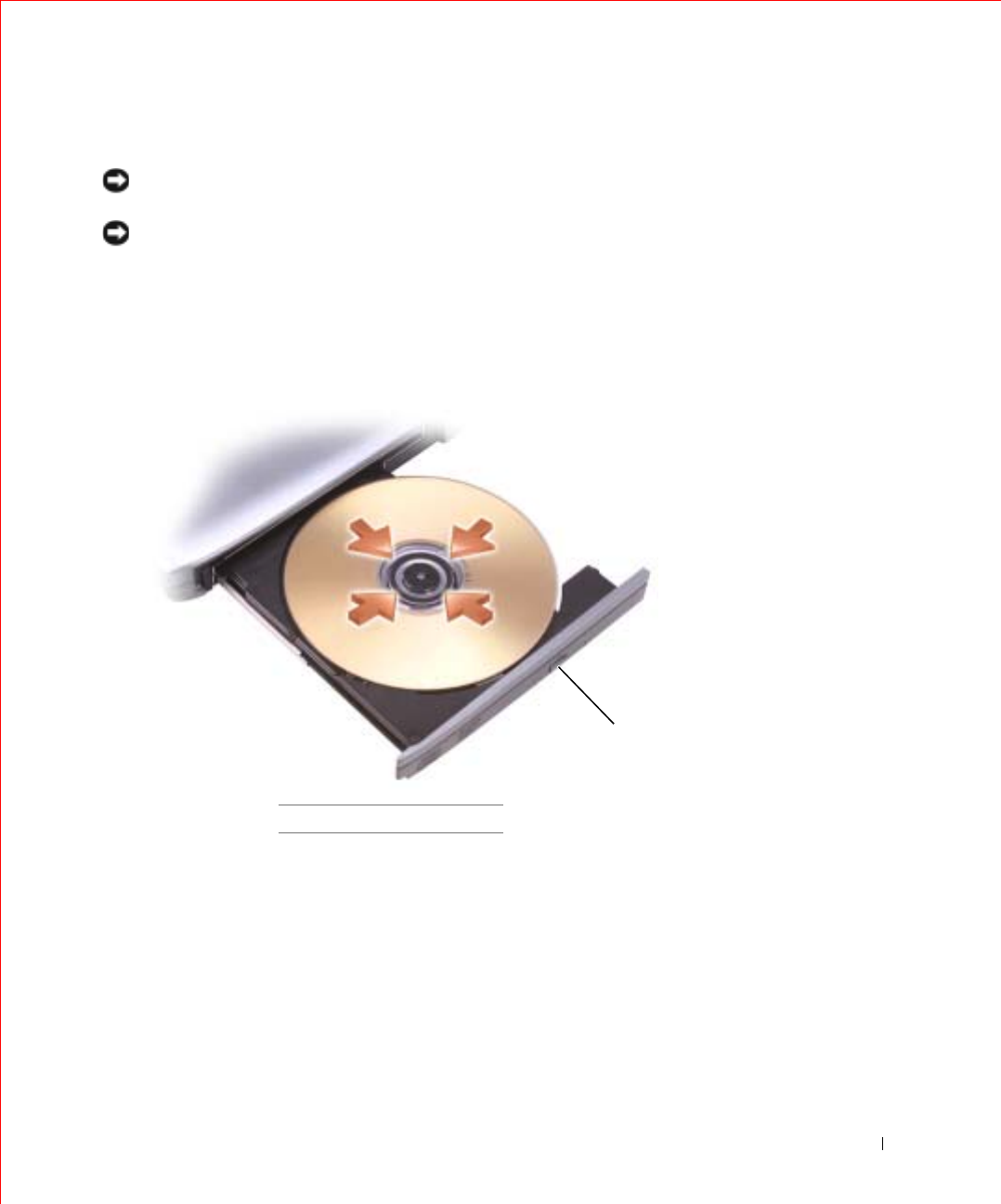
Using the Dell™ D/Bay 61
FILE LOCATION: S:\SYSTEMS\Pebble\UG\A00\English\bay.fm
DELL CONFIDENTIAL – PRELIMINARY 1/29/03 – FOR PROOF ONLY
Using the CD or DVD Tray
NOTICE: Do not press down on the drive tray when opening or closing it.
Keep the tray closed when you are not using the drive.
NOTICE: Do not move the computer while playing CDs or DVDs.
1Press the eject button on the front of the drive.
2Pull the tray out.
3Place the disc, label side up, in the center of the tray.
4Snap the disc onto the spindle.
5Push the tray back into the drive.
1eject button
1
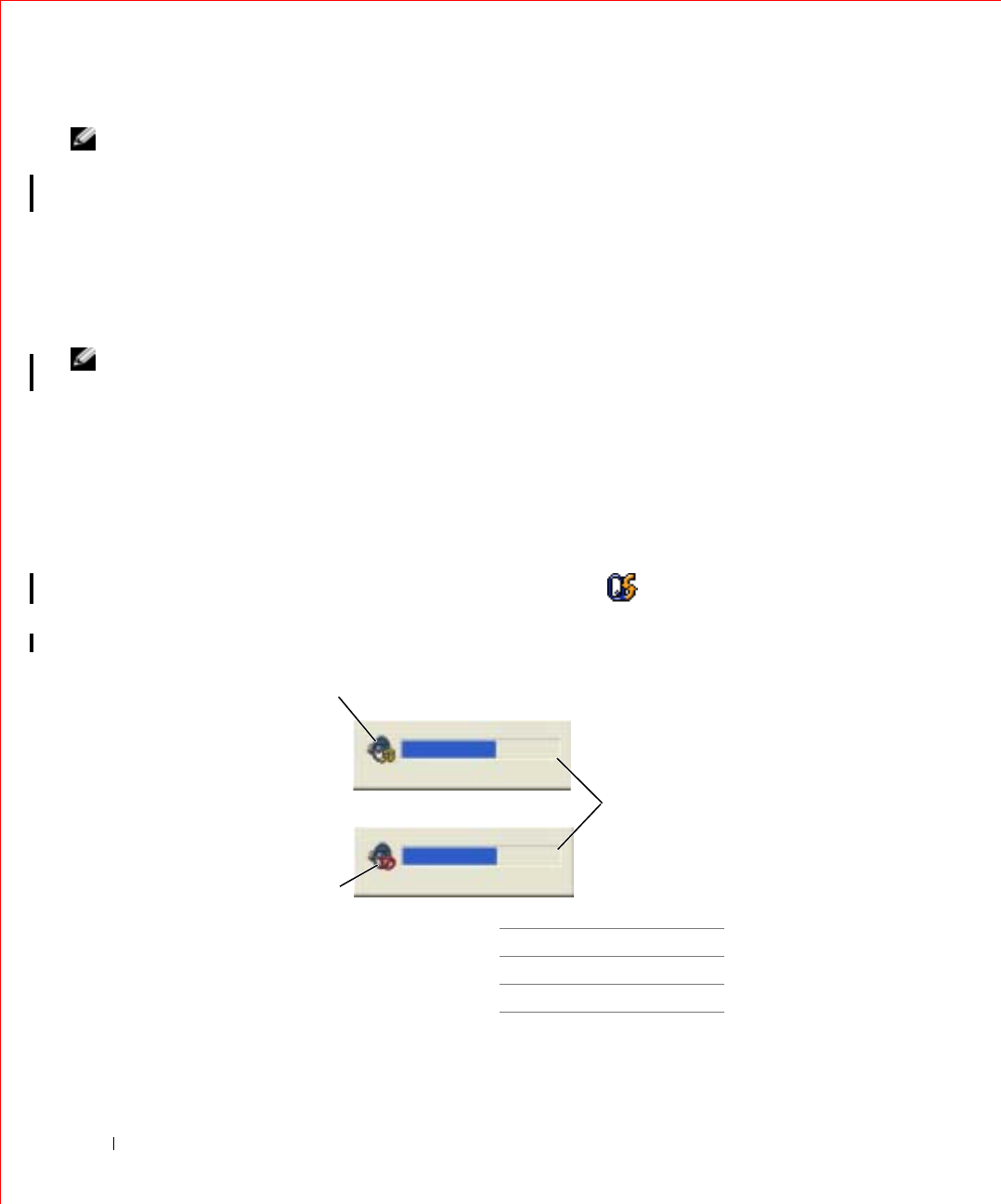
62 Using the Dell™ D/Bay
www.dell.com | support.dell.com
FILE LOCATION: S:\SYSTEMS\Pebble\UG\A00\English\bay.fm
DELL CONFIDENTIAL – PRELIMINARY 1/29/03 – FOR PROOF ONLY
NOTE: If you use a
module bay that shipped
with another Latitude D-
Family computer, you
need to install the drivers
and software necessary to
play DVDs or write data.
For more information, see
the
Drivers and Utilities
CD.
You can play a DVD on your computer if the computer shipped with a DVD
drive or a CD-RW/DVD combo drive. You can write data to a blank CD on
your computer if the computer shipped with a CD-RW or CD-RW/DVD
combo drive.
For more information on playing CDs or watching movies, click Help on the
CD player or DVD player (if available).
Adjusting the Volume
NOTE: If the speaker is
muted, you do not hear
the CD or DVD playing.
1Click the Start button, point to All Programs→ Accessories→
Entertainment (or Multimedia), and then click Volume Control.
2In the Volume Control window, click and drag the bar in the Volume
Control column and slide the bar up or down to increase or decrease
the volume.
For more information on volume control options, click Help in the Volume
Control window.
The Volume Meter displays the current volume level, including mute, on
your computer. Either right-click the icon in the taskbar or press the
volume control buttons to enable or disable the Volume Meter on the
screen (if Dell QuickSet is installed).
1volume icon
2Volume Meter
3mute icon
1
3
2
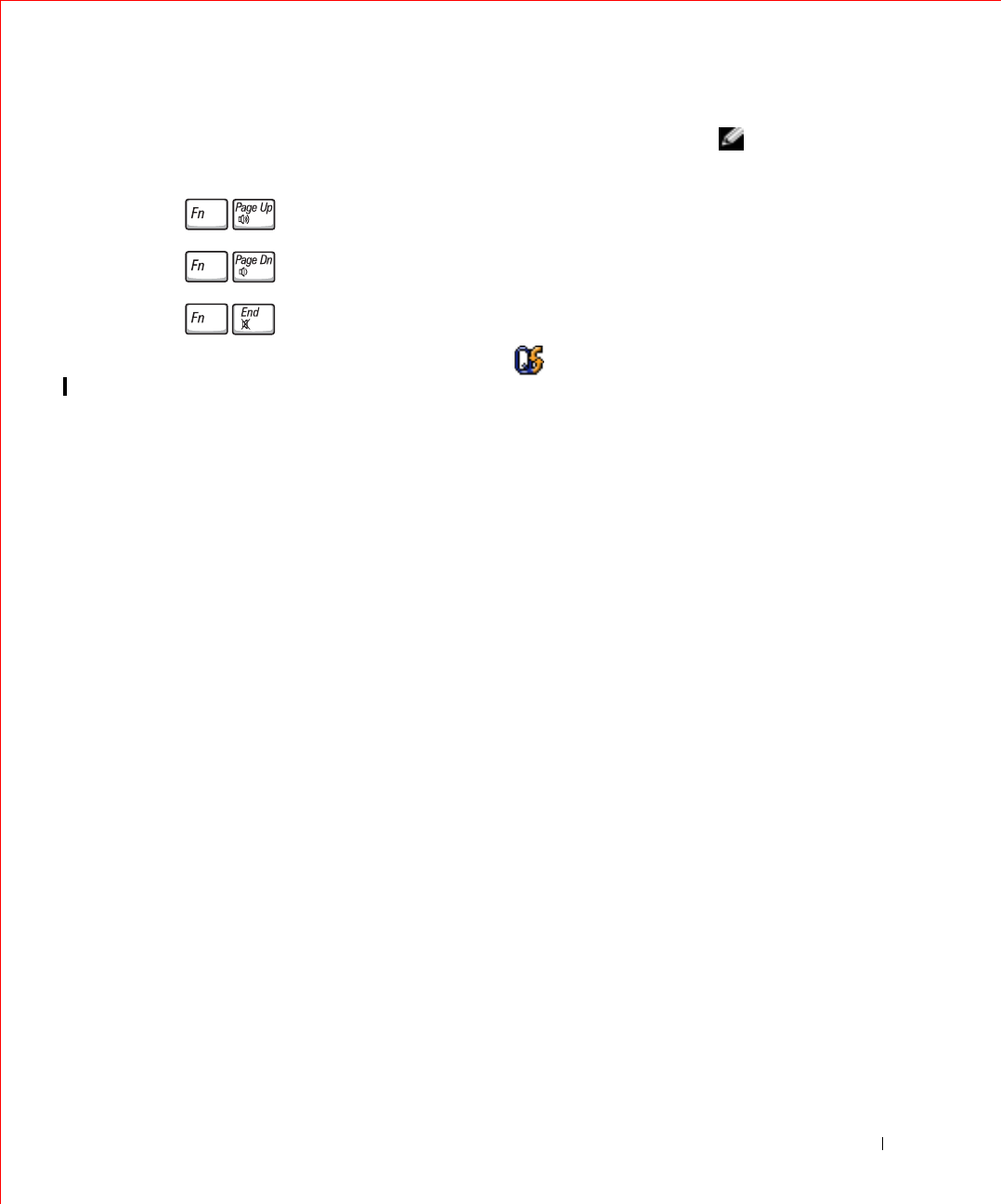
Using the Dell™ D/Bay 63
FILE LOCATION: S:\SYSTEMS\Pebble\UG\A00\English\bay.fm
DELL CONFIDENTIAL – PRELIMINARY 1/29/03 – FOR PROOF ONLY
NOTE: By default, the
Volume Meter appears in
the lower-right corner of
the display. You can click
and drag the meter to a
new location, and the
meter subsequently
always appears at the new
location.
When the meter is enabled, adjust the volume using the volume control
buttons or by pressing the following keys:
• Press to increase volume.
• Press to decrease volume.
• Press to mute volume.
For more information about QuickSet, right-click the icon in the
taskbar and click Help.
Adjusting the Picture
If an error message notifies you that the current resolution and color depth
are using too much memory and preventing DVD playback, adjust the
display properties.
Windows XP
1Click the Start button and click Control Panel.
2Under Pick a category, click Appearance and Themes.
3Under Pick a task..., click Change the screen resolution.
4In the Display Properties window, click and drag the bar in Screen
resolution to change the setting to 1024 by 768 pixels.
5Under Color quality, click the drop-down menu and click Medium (16
bit).
6Click OK.
Windows 2000
1Click the Start button, point to Settings, and then click Control
Panel.
2Double-click the Display icon and click the Settings tab.
3Click and drag the bar in Screen area to change the setting to 1024 by
768 pixels.
4Under Color quality, click the drop-down menu and click High Color
(16 bit).

64 Using the Dell™ D/Bay
www.dell.com | support.dell.com
FILE LOCATION: S:\SYSTEMS\Pebble\UG\A00\English\bay.fm
DELL CONFIDENTIAL – PRELIMINARY 1/29/03 – FOR PROOF ONLY
5Click Apply.
6Click OK to save the settings and close the window.

FILE LOCATION: S:\SYSTEMS\Pebble\UG\A00\English\battery.fm
DELL CONFIDENTIAL – PRELIMINARY 1/29/03 – FOR PROOF ONLY
8
SECTION 8
Using a Battery

66 Using a Battery
www.dell.com | support.dell.com
FILE LOCATION: S:\SYSTEMS\Pebble\UG\A00\English\battery.fm
DELL CONFIDENTIAL – PRELIMINARY 1/29/03 – FOR PROOF ONLY
Battery Performance
NOTE: Batteries for
portable computers are
covered only during the
initial one-year period of
the limited warranty for
your computer. For more
information about the
Dell warranty for your
computer, see the
System
Information Guide
.
Use a battery to power the computer when it is not connected to an
electrical outlet. One battery is supplied as standard equipment in the
battery bay.
Battery operating time varies depending on operating conditions. Operating
time is significantly reduced when you perform operations including, but
not limited to, the following:
NOTE: It is
recommended that you
connect your computer to
an electrical outlet when
writing to a CD.
• Using optical drives, especially DVD and CD-RW drives
• Using wireless communications devices, PC Cards, or USB devices
• Using high-brightness display settings, 3D screen savers, or other
power-intensive programs such as 3D games
• Running the computer in maximum performance mode
You can check the battery charge before you insert the battery into the
computer. You can also set power management options to alert you when
the battery charge is low.
CAUTION: Using an incompatible battery may increase the risk of
fire or explosion. Replace the battery only with a compatible
battery purchased from Dell. The lithium-ion battery is designed
to work with your Dell™ computer. Do not use batteries from
other computers with your computer.
CAUTION: Do not dispose of batteries with household waste.
When your battery no longer holds a charge, call your local waste
disposal or environmental agency for advice on disposing of a
lithium-ion battery. See the battery disposal instructions in your
System Information Guide
.
CAUTION: Misuse of the battery may increase the risk of fire or
chemical burn. Do not puncture, incinerate, disassemble, or
expose the battery to temperatures above 65°C (149°F). Keep the
battery away from children. Handle damaged or leaking batteries
with extreme care. Damaged batteries may leak and cause
personal injury or equipment damage.
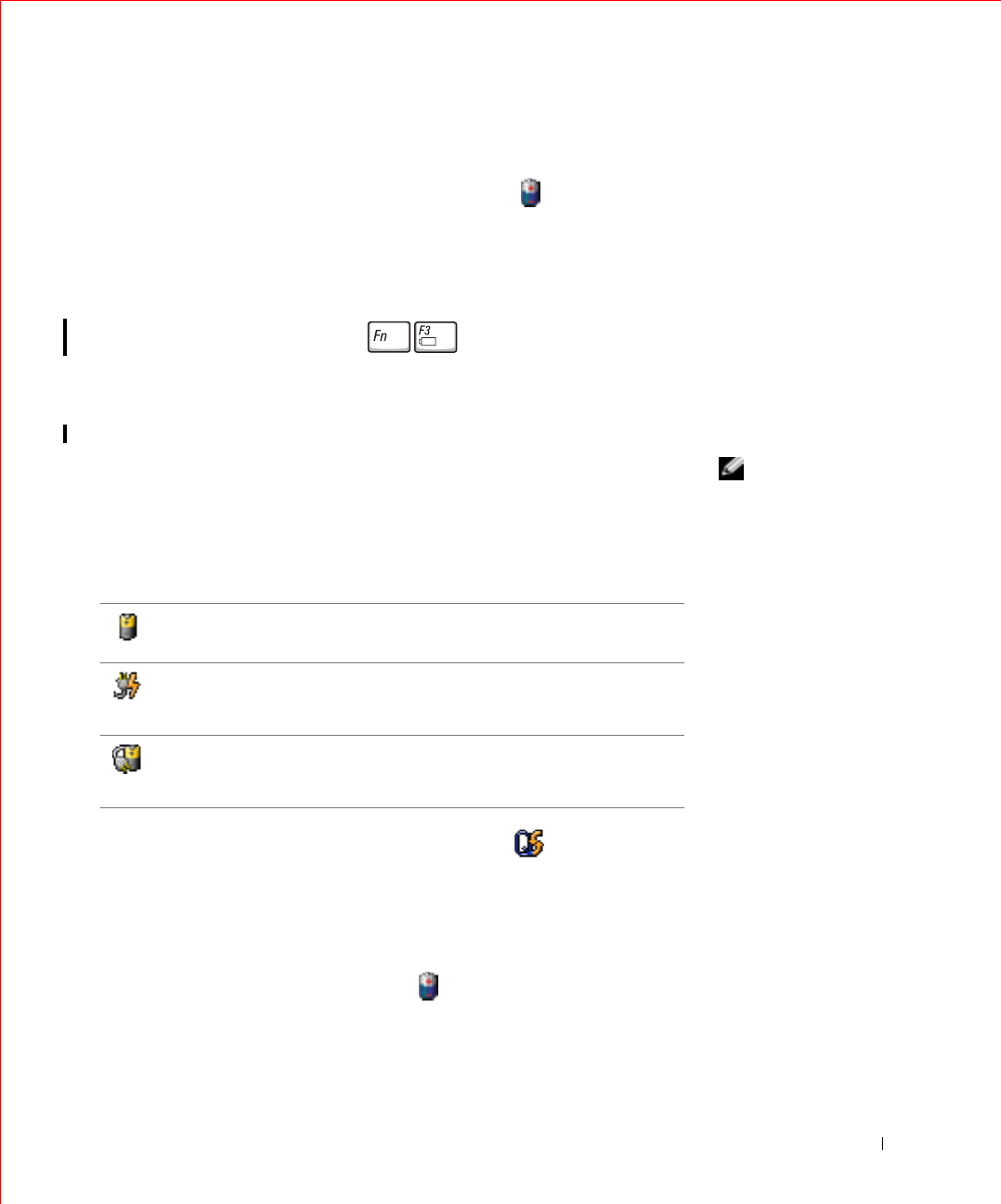
Using a Battery 67
FILE LOCATION: S:\SYSTEMS\Pebble\UG\A00\English\battery.fm
DELL CONFIDENTIAL – PRELIMINARY 1/29/03 – FOR PROOF ONLY
Checking the Battery Charge
The Microsoft® Windows® power meter window and icon, the battery
charge gauge and health gauge, and the low-battery warning provide
information on the battery charge.
Dell QuickSet Battery Meter
If Dell QuickSet is installed, press to display the QuickSet
Battery Meter.
The Battery Meter screen displays status, charge level, and charge
completion time for the battery in your computer.
NOTE: You can use your
docking device to charge
a computer battery.
However, a battery in a
docking device does not
power the docking device
or computer.
In addition, when your computer is connected to a docking device (docked),
the Battery Meter screen includes a Dock Battery tab, which displays the
charge level and current status of the docking device battery.
The following icons appear in the Battery Meter screen:
For more information about QuickSet, right-click the icon in the
taskbar, and click Help.
Microsoft Windows Power Meter
The Windows power meter indicates the remaining battery charge. To
check the power meter, double-click the icon on the taskbar. For more
information on the Power Meter tab, see "Power Management."
• The computer or docking device is running on battery power.
• The battery is discharging or idle.
• The computer or docking device is connected to an electrical outlet and
running on AC power.
• The battery is charging.
• The computer or docking device is connected to an electrical outlet and
running on AC power.
• The battery is discharging, idle, or charging.
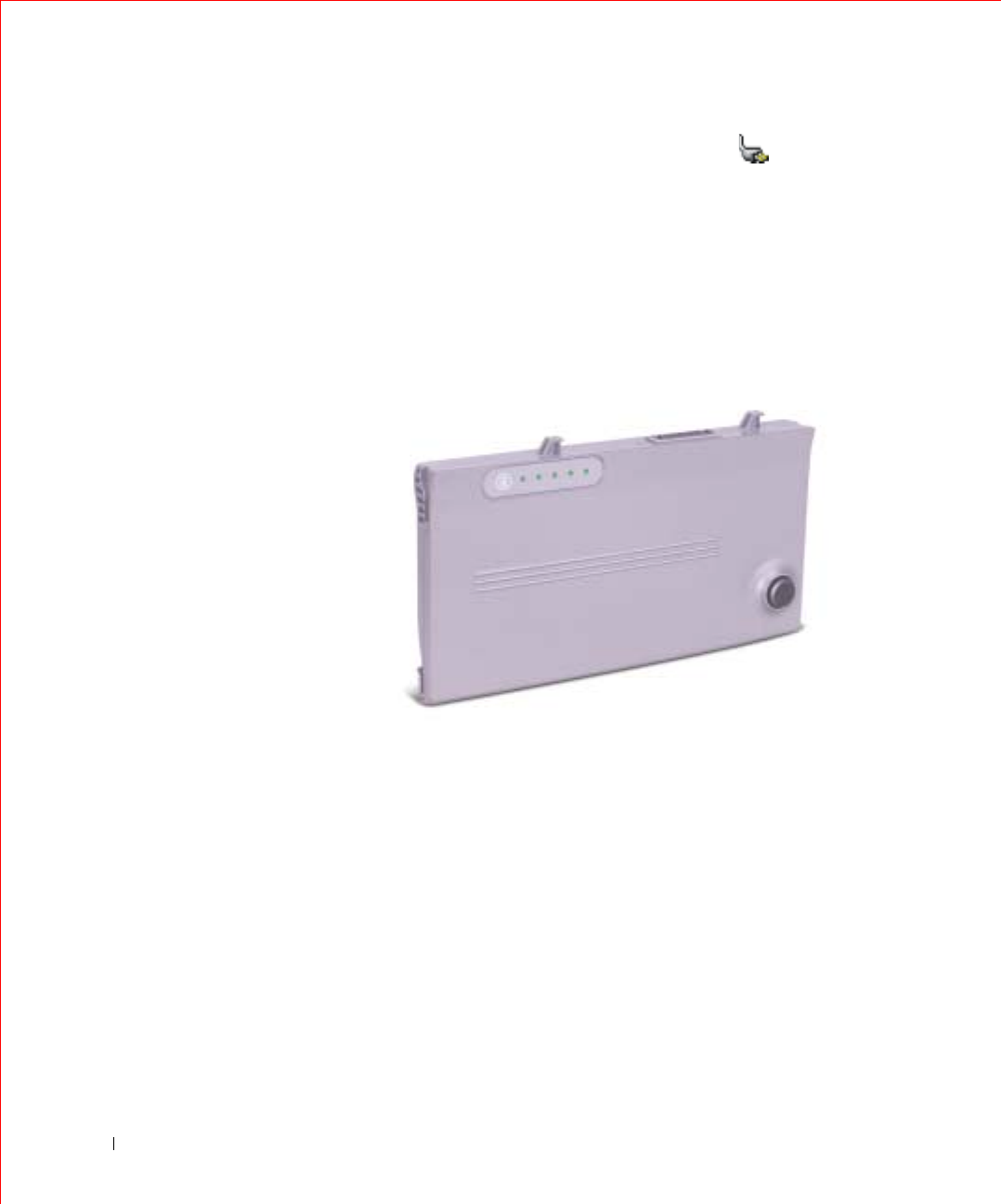
68 Using a Battery
www.dell.com | support.dell.com
FILE LOCATION: S:\SYSTEMS\Pebble\UG\A00\English\battery.fm
DELL CONFIDENTIAL – PRELIMINARY 1/29/03 – FOR PROOF ONLY
If the computer is connected to an electrical outlet, a icon appears.
Charge Gauge
Press the status button on the battery charge gauge to illuminate the
charge-level lights. Each light represents approximately 20 percent of the
total battery charge. For example, if the battery has 80 percent of its charge
remaining, four of the lights are on. If no lights appear, the battery has no
charge.
Health Gauge
The battery operating time is largely determined by the number of times it
is charged. After hundreds of charge and discharge cycles, batteries lose
some charge capacity, or battery health. To check the battery health, press
and hold the status button on the battery charge gauge for at least 3
seconds. If no lights appear, the battery is in good condition, and more than
80 percent of its original charge capacity remains. Each light represents
incremental degradation. If five lights appear, less than 60 percent of the
charge capacity remains, and you should consider replacing the battery. See
"Specifications" for more information about the battery operating time.

Using a Battery 69
FILE LOCATION: S:\SYSTEMS\Pebble\UG\A00\English\battery.fm
DELL CONFIDENTIAL – PRELIMINARY 1/29/03 – FOR PROOF ONLY
Low-Battery Warning
NOTICE: To avoid losing or corrupting data, save your work immediately
after a low-battery warning. Then connect the computer to an electrical outlet,
or install a second battery in the module bay. If the battery runs completely out
of power, standby mode begins automatically.
A pop-up window warns you when the battery charge is approximately 90
percent depleted. For more information on low-battery alarms, see "Power
Management."
Charging the Battery NOTE: Charge time is
longer with the computer
turned on. You can leave
the battery in the
computer as long as you
like. The battery internal
circuitry prevents the
battery from
overcharging.
When you connect the computer to an electrical outlet or install a battery
while the computer is connected to an electrical outlet, the computer
checks the battery charge and temperature. If necessary, the AC adapter
then charges the battery and maintains the battery charge.
If the battery is warm from being used in your computer or being in a warm
environment, the battery may not charge when you connect the computer
to an electrical outlet.
The battery is too warm to start charging if the light flashes alternately
green and orange. Disconnect the computer from the electrical outlet and
allow the computer and the battery to cool to room temperature. Then
connect the computer to an electrical outlet to continue charging the
battery.
For more information on resolving problems with a battery, see "Power
Problems."
Removing a Battery
CAUTION: Before performing these procedures, disconnect the
modem from the telephone wall jack.
NOTICE: If you choose to replace the battery with the computer in standby
mode, you have up to 90 seconds to complete the battery replacement before
the computer shuts down and loses any unsaved data.
1Ensure that the computer is turned off, suspended in a power
management mode, or connected to an electrical outlet.
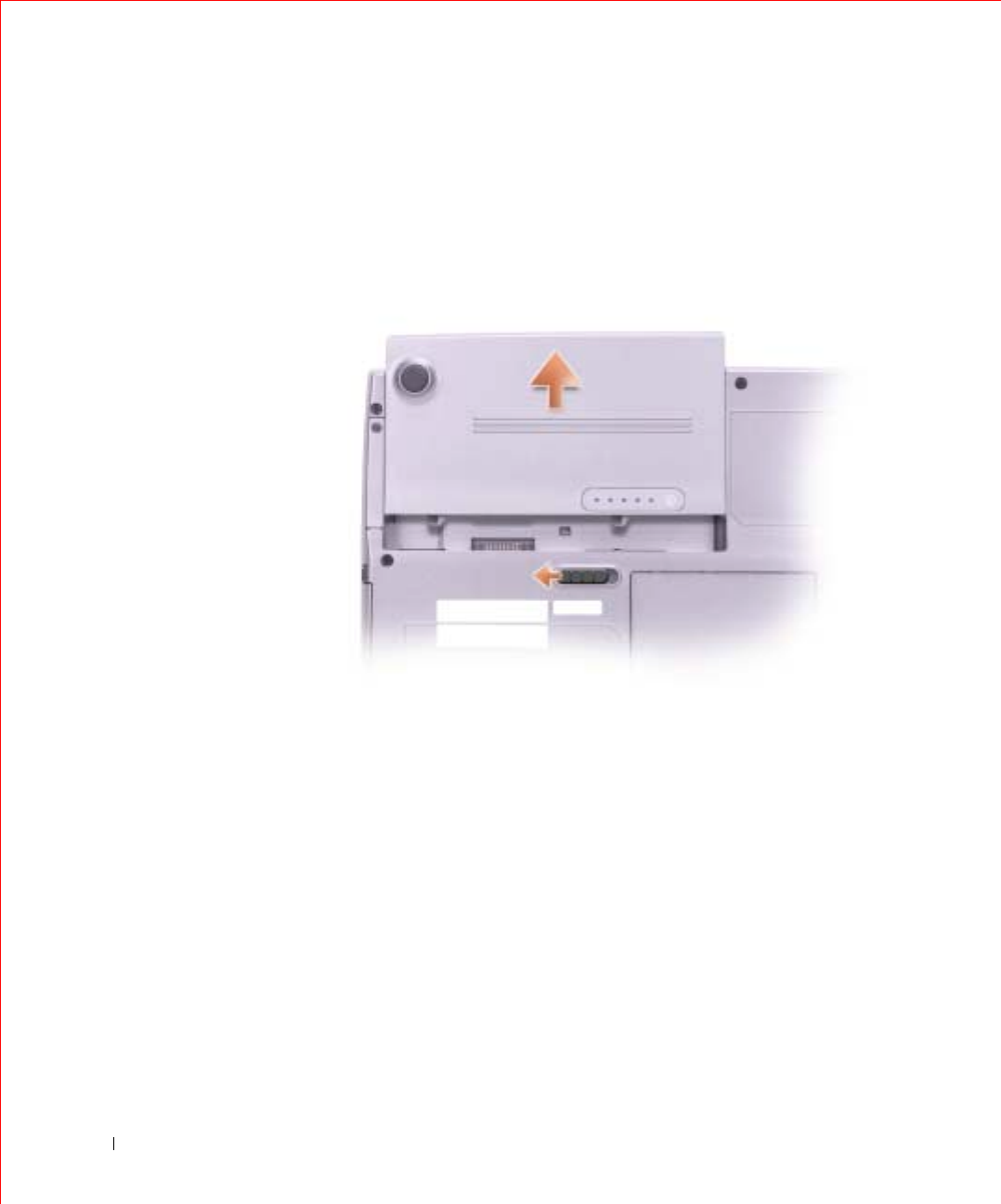
70 Using a Battery
www.dell.com | support.dell.com
FILE LOCATION: S:\SYSTEMS\Pebble\UG\A00\English\battery.fm
DELL CONFIDENTIAL – PRELIMINARY 1/29/03 – FOR PROOF ONLY
2If the computer is connected to a docking device (docked), undock it.
See the documentation that came with your docking device for
instructions.
3Slide and hold the battery-bay latch release on the bottom of the
computer, and then remove the battery from the bay.
Installing a Battery
Slide the battery into the bay until the latch release clicks.
Storing a Battery
Remove the battery when you store your computer for an extended period
of time. A battery discharges during prolonged storage. After a long storage
period, recharge the battery fully before you use it.

FILE LOCATION: S:\SYSTEMS\Pebble\UG\A00\English\power.fm
DELL CONFIDENTIAL – PRELIMINARY 1/29/03 – FOR PROOF ONLY
9
SECTION 9
Power Management

72 Power Management
www.dell.com | support.dell.com
FILE LOCATION: S:\SYSTEMS\Pebble\UG\A00\English\power.fm
DELL CONFIDENTIAL – PRELIMINARY 1/29/03 – FOR PROOF ONLY
Power Management Tips
NOTE: See "Using a
Battery" for more
information on conserving
battery power.
• Connect the computer to an electrical outlet when possible because
battery life is largely determined by the number of times the battery is
charged.
• Place the computer in standby mode or hibernate mode when you
leave the computer unattended for long periods of time.
• To exit a power management mode, press the power button.
NOTE: The power
management options
described in this section
are for Microsoft®
Windows® operating
systems. Power
management options may
vary, depending on which
operating system is
installed.
Power Management Wizard
NOTE: The Power
Management Wizard is
not available if you have
restricted access rights.
If Dell™ QuickSet is installed, click or double-click the icon to open the
Power Management Wizard.
The first two screens of the wizard—Welcome and What is Power
Management?—describe and define various power management options.
NOTE: On the What is
Power Management?
screen, you can select Do
not show this page again.
When you select this
option, the Welcome
screen also does not
appear again.
Use the following screens of the Power Management Wizard to set various
power management options, including sleep modes, power schemes, and
low battery-charge alarms.
Setting Sleep Modes
The screen defines standby and hibernate modes. From the screen you can:
• Set standby-mode password options.
• Enable or disable hibernate mode.
• Select how the computer will respond when you close the display:
– Choose no action.
–Enter standby mode.
– Enter hibernate mode.
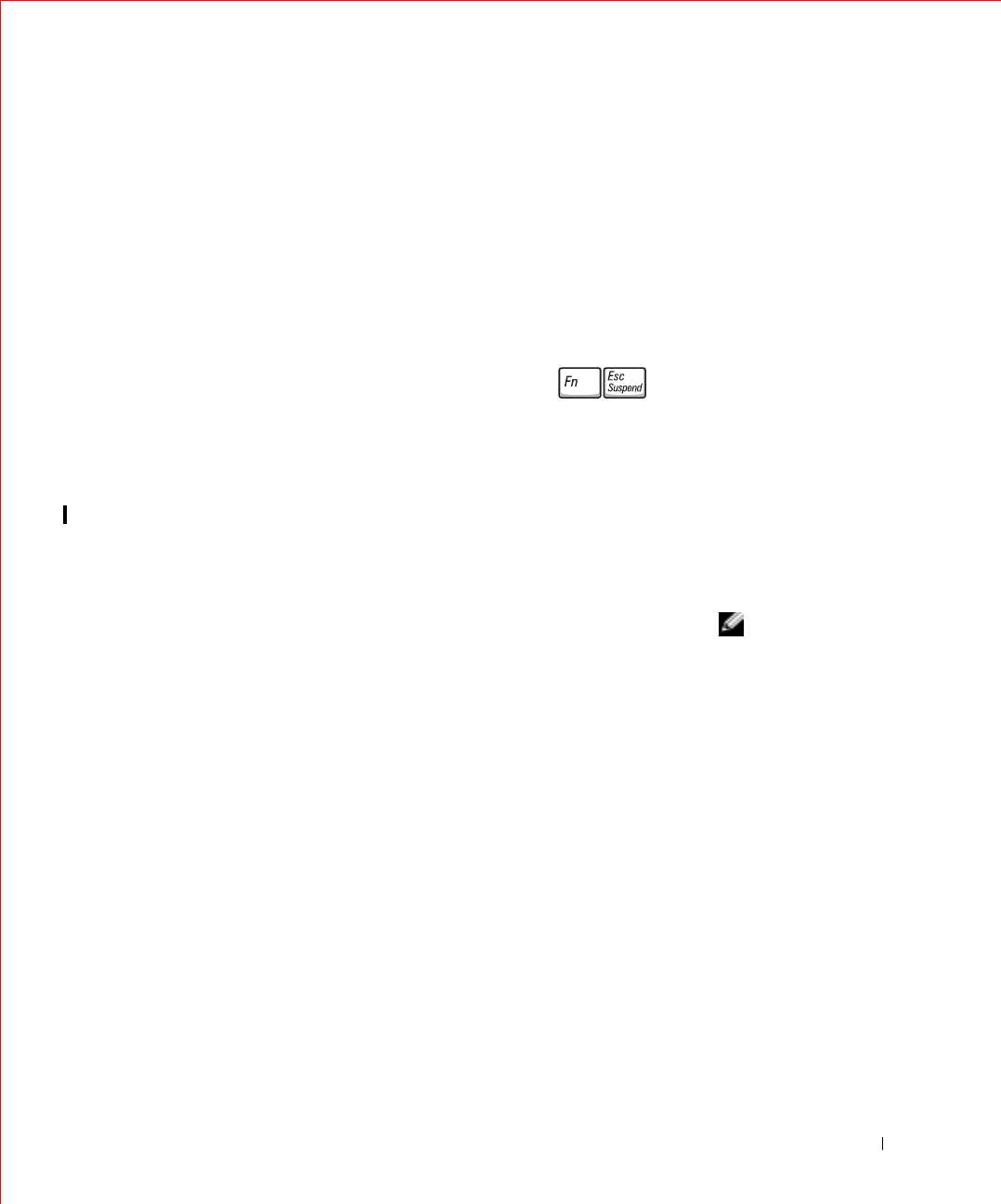
Power Management 73
FILE LOCATION: S:\SYSTEMS\Pebble\UG\A00\English\power.fm
DELL CONFIDENTIAL – PRELIMINARY 1/29/03 – FOR PROOF ONLY
• Select how the computer will respond when you press the power
button:
– Choose no action.
– Enter standby mode.
– Enter hibernate mode.
–Shut down the Microsoft
® Windows® operating system and turn
off the computer.
– Prompt a user for an action (Ask me what to do).
• Select how the computer will respond when you press :
– Choose no action.
– Enter standby mode.
– Enter hibernate mode.
– Shut down the operating system and turn off the computer.
– Prompt a user for an action (Ask me what to do).
Selecting a Power Scheme
NOTE: When your
computer is running on
battery power, the
Network Disabled power
scheme disables your
internal network and
wireless activity. When
your computer is
connected to an electrical
outlet or docking device,
the Network Disabled
power scheme disables
only your wireless activity.
You must set the power
scheme through QuickSet
(not Microsoft®
Windows®) for Network
Disabled to work.
The screen allows you to select, create, and edit power scheme settings. In
addition, you can delete power schemes that you create, but you cannot
delete Dell™ QuickSet predefined power schemes (Maximum Battery,
Maximum Performance, Presentation, and Network Disabled).

74 Power Management
www.dell.com | support.dell.com
FILE LOCATION: S:\SYSTEMS\Pebble\UG\A00\English\power.fm
DELL CONFIDENTIAL – PRELIMINARY 1/29/03 – FOR PROOF ONLY
NOTE: QuickSet
automatically adds the
word (QuickSet) after the
names of power schemes
created using QuickSet.
All QuickSet power schemes are displayed in a drop-down menu near the
center of the screen. The power settings for each scheme in the menu are
listed below the menu. The power settings are listed separately for when the
computer is running on battery or connected to an electrical outlet.
The Power Management Wizard also allows you to associate the display
brightness level with a power scheme. You must enable brightness-level
power schemes through QuickSet in order to set the brightness level.
The display brightness, internal network-card activity, and wireless activity
features are not available through the Microsoft® Windows® Control Panel
power schemes. In order to make use of these value-added features, you
must set them through QuickSet power schemes.
NOTE: Brightness
shortcut keys only affect
the display on your
portable computer, not
monitors that you attach
to your portable computer
or docking device. If your
computer is in CRT only
mode and you try to
change the brightness
level, the Brightness
Meter appears, but the
brightness level on the
monitor does not change.
Setting Battery Alarms and Actions
The screen allows you to enable the low-battery and critical-battery alarms
and to change settings for the alarms. For example, you can set the low-
battery alarm to 20% to remind you to save work and switch to AC power,
and you can set the critical-battery alarm to 10% to enter hibernate mode.
From the screen, you can:
• Select whether the alarm will notify you by sound or text.
• Adjust the power level at which you want the alarm to notify you.
• Select how the computer will respond when the alarm notifies you:
– Choose no action.
–Enter standby mode.
– Enter hibernate mode.
– Shut down Windows and turn off the computer.
Completing the Power Management Wizard
The screen summarizes the QuickSet power scheme, sleep mode, and
battery alarm settings for your computer. Review the settings you have
selected and click Finish.
For more information about QuickSet, right-click the icon in the
taskbar and click Help.

Power Management 75
FILE LOCATION: S:\SYSTEMS\Pebble\UG\A00\English\power.fm
DELL CONFIDENTIAL – PRELIMINARY 1/29/03 – FOR PROOF ONLY
Power Management Modes
Standby Mode
Standby mode conserves power by turning off the display and the hard drive
after a predetermined period of inactivity (a time-out). When the computer
exits standby mode, it returns to the same operating state it was in before
entering standby mode.
NOTICE: If your computer loses AC and battery power while in standby
mode, it may lose data.
To enter standby mode:
•In the Microsoft Windows XP operating system, click the Start button,
click Turn off computer, and then click Stand by.
In Windows 2000, click the Start button, click Shutdown, click
Standby, and then click OK.
or
• Depending on how you set the power management options on the
Advanced tab in the Power Options Properties window, use one of the
following methods:
– Press the power button.
– Close the display.
– Press .
To exit standby mode, press the power button or open the display
depending on how you set the options on the Advanced tab. You cannot
make the computer exit standby mode by pressing a key or touching the
touch pad or track stick.
Hibernate Mode
Hibernate mode conserves power by copying system data to a reserved area
on the hard drive and then completely turning off the computer. When the
computer exits hibernate mode, it returns to the same operating state it was
in before entering hibernate mode.
NOTICE: You cannot remove devices or undock your computer while your
computer is in hibernate mode.

76 Power Management
www.dell.com | support.dell.com
FILE LOCATION: S:\SYSTEMS\Pebble\UG\A00\English\power.fm
DELL CONFIDENTIAL – PRELIMINARY 1/29/03 – FOR PROOF ONLY
Your computer enters hibernate mode if the battery charge level becomes
critically low.
To manually enter hibernate mode:
• In Windows XP, click the Start button, click Turn off computer, press
and hold , and then click Hibernate.
In Windows 2000, if hibernate support is enabled, click the Start
button, click Shutdown, click Hibernate, and then click OK.
or
• Depending on how you set the power management options on the
Advanced tab in the Power Options Properties window, use one of the
following methods to enter hibernate mode:
– Press the power button.
– Close the display.
–Press .
NOTE: Some PC Cards
may not operate correctly
after the computer exits
hibernate mode. Remove
and reinsert the card, or
simply restart (reboot)
your computer.
To exit hibernate mode, press the power button. The computer may take a
short time to exit hibernate mode. You cannot make the computer exit
hibernate mode by pressing a key or touching the touch pad or track stick.
For more information on hibernate mode, see the documentation that came
with your operating system.
Power Options Properties
The Power Options Properties window helps you to manage power
consumption and monitor battery charge status. To access the Microsoft®
Windows® Power Options Properties window:
•In Windows XP, click the Start button→ Control Panel→ Performance
and Maintenance→ Power Options.
•In Windows 2000, open the Control Panel, and then double-click the
Power Options icon.

Power Management 77
FILE LOCATION: S:\SYSTEMS\Pebble\UG\A00\English\power.fm
DELL CONFIDENTIAL – PRELIMINARY 1/29/03 – FOR PROOF ONLY
Power Schemes Tab
The Power schemes drop-down menu displays the selected preset power
scheme. Keep the default Portable/Laptop power scheme to maximize
battery power.
Windows XP controls the performance level of the processor depending on
the power scheme you select. You do not need to make any further
adjustments to set the performance level. For information on setting
processor performance for other operating systems, see "Intel SpeedStep®
Technology Tab."
Each preset power scheme has different time-out settings for entering
standby mode, turning off the display, and turning off the hard drive. For
more information on power management options, see the Help and Support
Center (Windows Help in Windows 2000).
Alarms Tab
NOTE: To enable audible
alarms, click each Alarm
Action button and select
Sound alarm.
The Low battery alarm and Critical battery alarm settings alert you with a
message when the battery charge falls below a certain percentage. When
you receive your computer, the Low battery alarm and Critical battery
alarm check boxes are selected. It is recommended that you continue to use
these settings. See "Using a Battery" for more information on low-battery
warnings.
Power Meter Tab
The Power Meter tab displays the current power source and amount of
battery charge remaining.
Advanced Tab
The Advanced tab allows you to:
• Set power icon and standby mode password options.
• Program the following functions (depending on your operating
system):
– Prompt a user for an action (Ask me what to do).
– Enter standby mode.
– Enter hibernate mode.

78 Power Management
www.dell.com | support.dell.com
FILE LOCATION: S:\SYSTEMS\Pebble\UG\A00\English\power.fm
DELL CONFIDENTIAL – PRELIMINARY 1/29/03 – FOR PROOF ONLY
– Shut down Windows and turn off the computer.
– Choose no action (None or Do nothing).
To program these functions, click an option from the corresponding drop-
down menu and then click OK.
Hibernate Tab
The Hibernate tab lets you enable hibernate mode by clicking the Enable
hibernate support check box.
Intel SpeedStep® Technology Tab
NOTE: Windows XP
controls the performance
level of the processor
depending on the power
scheme that you select.
See "Power Schemes Tab."
NOTE: To use Intel
SpeedStep technology, a
Windows operating
system must be running.
Depending on your operating system and microprocessor, the Power
Options Properties window includes the Intel SpeedStep® technology tab.
The Intel SpeedStep technology allows you to set the performance level of
the processor according to whether the computer is running on battery or
AC power. Depending on your operating system, typical options are:
•Automatic — The processor runs at its highest possible speed
(Maximum Performance mode) when the computer is running on AC
power. When the computer is running on battery power, the processor
runs in Battery Optimized mode.
•Maximum Performance — The processor is capable of running at its
highest possible speed even if the computer is running on battery
power.
•Battery Optimized Performance — Processor speed is optimized for
battery power even if the computer is connected to an electrical outlet.
To change additional Intel SpeedStep options:
1Click Advanced and then click one of the following options:
• Disable Intel SpeedStep technology control
• Remove flag icon (from the notification area)
• Disable audio notification when performance changes

Power Management 79
FILE LOCATION: S:\SYSTEMS\Pebble\UG\A00\English\power.fm
DELL CONFIDENTIAL – PRELIMINARY 1/29/03 – FOR PROOF ONLY
2Click OK to accept any changes, and then click OK to close the Intel
SpeedStep® technology window.
You can also change the Intel SpeedStep settings by right-clicking the flag
icon in the notification area.

80 Power Management
www.dell.com | support.dell.com
FILE LOCATION: S:\SYSTEMS\Pebble\UG\A00\English\power.fm
DELL CONFIDENTIAL – PRELIMINARY 1/29/03 – FOR PROOF ONLY

FILE LOCATION: S:\SYSTEMS\Pebble\UG\A00\English\pccards.fm
DELL CONFIDENTIAL – PRELIMINARY 1/29/03 – FOR PROOF ONLY
10
SECTION 10
Using PC Cards

82 Using PC Cards
www.dell.com | support.dell.com
FILE LOCATION: S:\SYSTEMS\Pebble\UG\A00\English\pccards.fm
DELL CONFIDENTIAL – PRELIMINARY 1/29/03 – FOR PROOF ONLY
PC Card Types
See "Specifications" for information on supported PC Cards.
NOTE: A PC Card is not
a bootable device. The PC Card slot has one connector that supports a single Type I or Type II
card. The PC Card slot supports CardBus technology and extended PC
Cards. "Type" of card refers to its thickness, not its functionality.
PC Card Blanks
Your computer shipped with a plastic blank installed in the PC Card slot.
Blanks protect unused slots from dust and other particles. Save the blank for
use when no PC Card is installed in the slot; blanks from other computers
may not fit your computer.
To remove the blank, see "Removing a PC Card or Blank."
Extended PC Cards
An extended PC Card (for example, a wireless network adapter) is longer
than a standard PC Card and extends outside the computer. Follow these
precautions when using extended PC Cards:
• Protect the exposed end of an installed card. Striking the end of the
card can damage the system board.
• Always remove an extended PC Card before you pack the computer in
its carrying case.
Installing a PC Card
You can install a PC Card in the computer while the computer is running.
The computer automatically detects the card.
PC Cards are generally marked with a symbol (such as a triangle or an
arrow) to indicate which end to insert into the slot. The cards are keyed to
prevent incorrect insertion. If card orientation is not clear, see the
documentation that came with the card.
To install a PC Card:
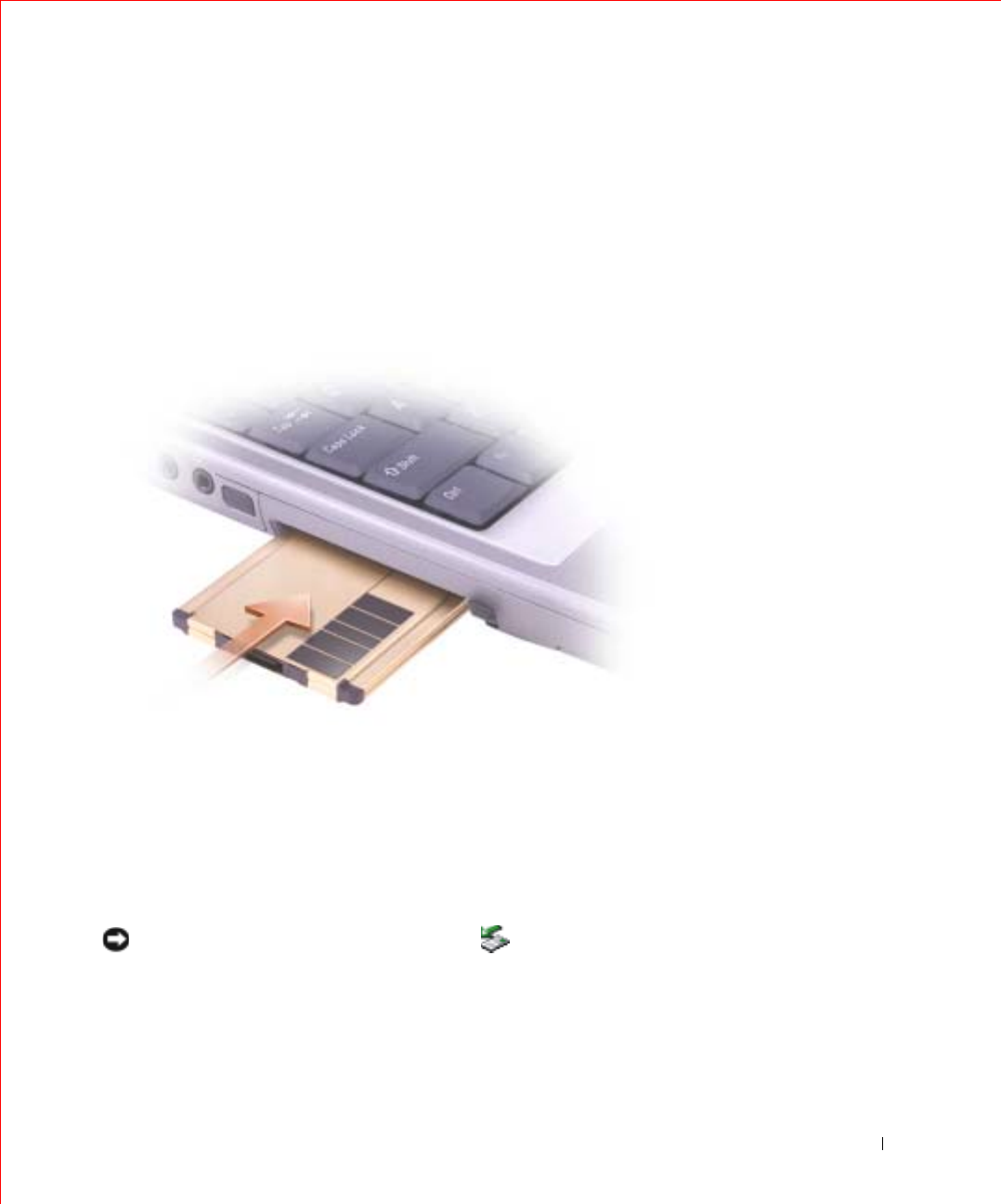
Using PC Cards 83
FILE LOCATION: S:\SYSTEMS\Pebble\UG\A00\English\pccards.fm
DELL CONFIDENTIAL – PRELIMINARY 1/29/03 – FOR PROOF ONLY
1Hold the card with its orientation symbol pointing into the slot and
the top side of the card facing up. The latch may need to be in the "in"
position before you insert the card.
2Slide the card into the slot until the card is completely seated in its
connector.
If you encounter too much resistance, do not force the card. Check the
card orientation and try again.
The computer recognizes most PC Cards and automatically loads the
appropriate device driver. If the configuration program tells you to load the
manufacturer's drivers, use the floppy disk or CD that came with the PC
Card.
Removing a PC Card or Blank
NOTICE: Use the PC Card configuration utility on the taskbar to select
a card and stop it from functioning before you remove it from the computer. If
you do not stop the card in the configuration utility, you could lose data. Do not
attempt to eject a card by pulling its cable, if one is attached.
1Press the eject button.
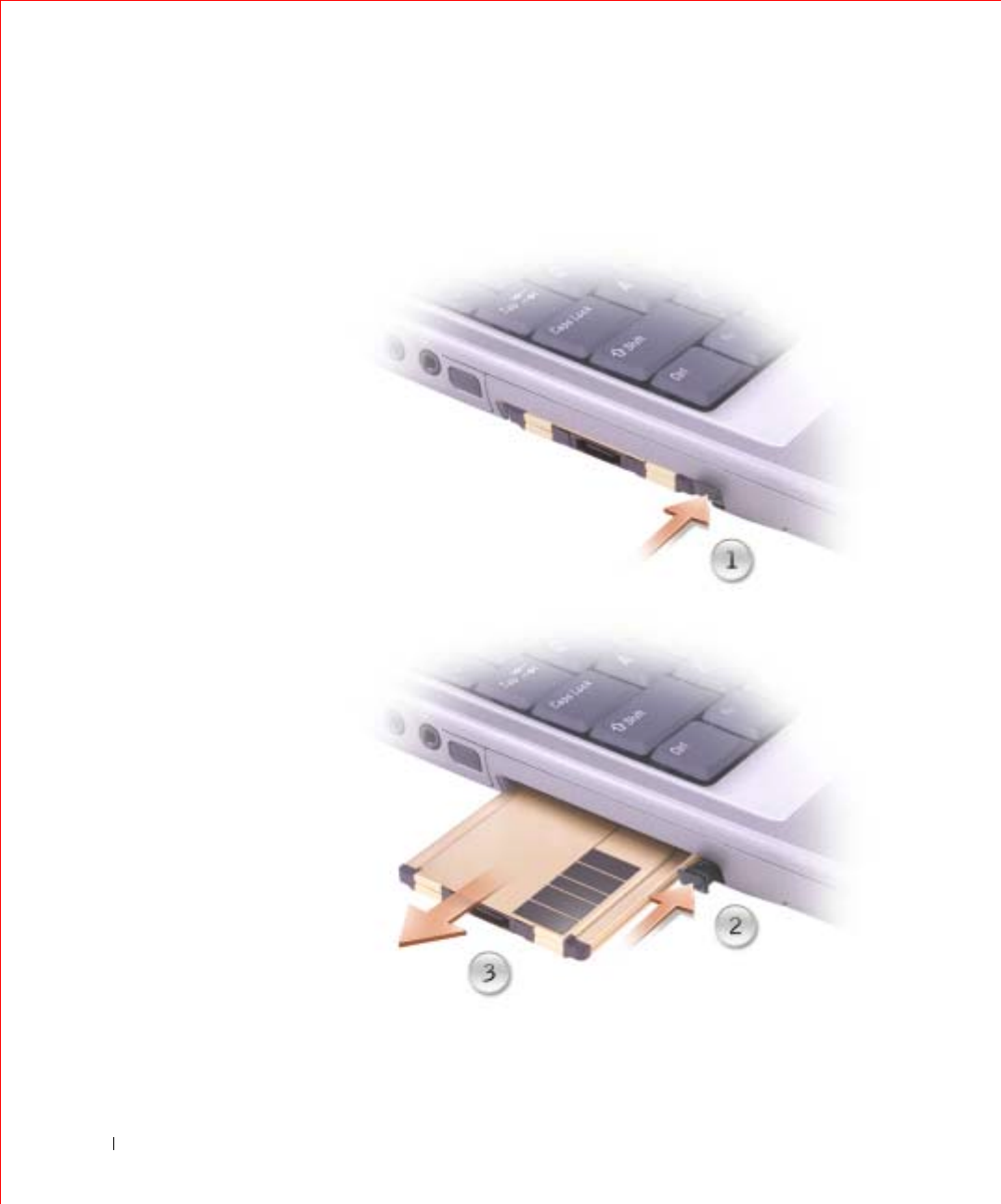
84 Using PC Cards
www.dell.com | support.dell.com
FILE LOCATION: S:\SYSTEMS\Pebble\UG\A00\English\pccards.fm
DELL CONFIDENTIAL – PRELIMINARY 1/29/03 – FOR PROOF ONLY
2Press the eject button a second time.
3Gently remove the card.

Using PC Cards 85
FILE LOCATION: S:\SYSTEMS\Pebble\UG\A00\English\pccards.fm
DELL CONFIDENTIAL – PRELIMINARY 1/29/03 – FOR PROOF ONLY
Save a blank to use when no PC Card is installed in a slot. Blanks protect
unused slots from dust and other particles.

86 Using PC Cards
www.dell.com | support.dell.com
FILE LOCATION: S:\SYSTEMS\Pebble\UG\A00\English\pccards.fm
DELL CONFIDENTIAL – PRELIMINARY 1/29/03 – FOR PROOF ONLY

FILE LOCATION: S:\SYSTEMS\Pebble\UG\A00\English\smart.fm
DELL CONFIDENTIAL – PRELIMINARY 1/29/03 – FOR PROOF ONLY
11
SECTION 11
Using Smart Cards

88 Using Smart Cards
www.dell.com | support.dell.com
FILE LOCATION: S:\SYSTEMS\Pebble\UG\A00\English\smart.fm
DELL CONFIDENTIAL – PRELIMINARY 1/29/03 – FOR PROOF ONLY
About Smart Cards
Smart cards are small portable credit-card shaped devices with internal
integrated circuits. Smart cards come in two varieties: memory and
microprocessor. Memory smart cards store data but cannot process
information. Microprocessor smart cards can add, delete, and manipulate
information in the card memory. The top surface of the microprocessor
smart card contains an embedded microprocessor located under the gold
contact pad. Microprocessor smart cards can be used for programs such as:
• Secure log-on and authentication of users to PCs and networks
• Secure business-to-business (B2B) and business-to-consumer (B2C) e-
commerce
• Storage of digital certificates, credentials, and passwords
• Encryption of sensitive data
NOTE: To use a smart
card for secure PC log-on
and authentication, B2B
and B2C e-commerce,
local file encryption, and
storage of digital
certificates, additional
software is required. To
use a smart card for
secure network log-on and
authentication, file and e-
mail encryption, and
Virtual Private Network
(VPN) log-on, you need to
enable Microsoft®
Windows® PKI support.
The combination of the small size and integrated circuits make smart cards
valuable tools for security, data storage, and special programs. Using smart
cards can improve system security by combining something a user has (the
smart card) with something only the user should know (a PIN) to provide
more secure user-authentication than passwords alone.
Installing a Smart Card
You can install a smart card in the computer while the computer is running.
The computer automatically detects the card.
To install a smart card:
1Remove the smart card blank from the smart card slot.
2Hold the card face up with the gold contact pad on the top surface and
pointing toward the smart card slot.
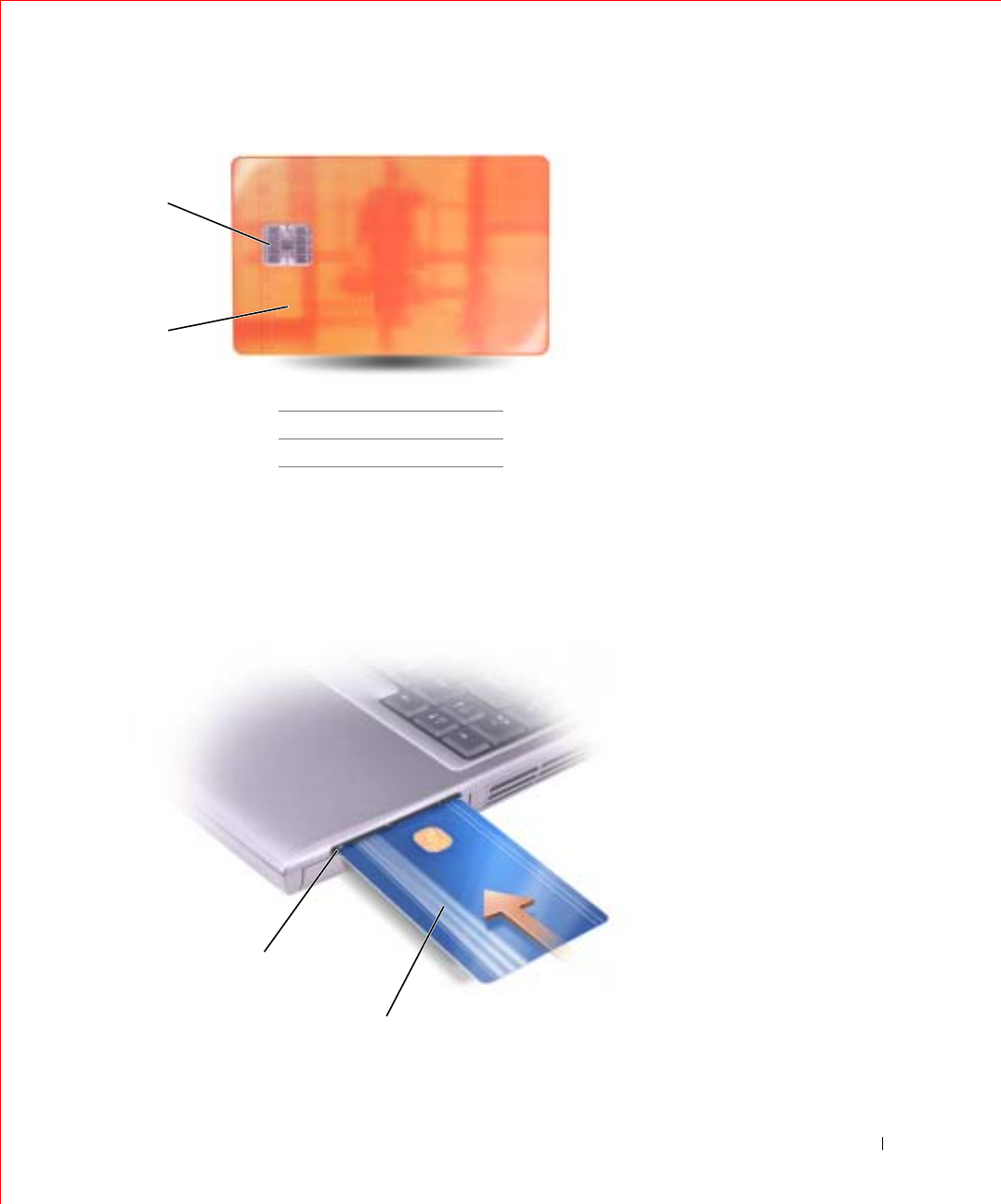
Using Smart Cards 89
FILE LOCATION: S:\SYSTEMS\Pebble\UG\A00\English\smart.fm
DELL CONFIDENTIAL – PRELIMINARY 1/29/03 – FOR PROOF ONLY
3Slide the smart card into the smart card slot until the card is
completely seated in its connector. The smart card will protrude from
the slot. The smart card slot is located below the PC Card slot.
If you encounter too much resistance, do not force the card. Check the
card orientation and try again.
1gold contact pad
2smart card (top)
1
2
1
2

90 Using Smart Cards
www.dell.com | support.dell.com
FILE LOCATION: S:\SYSTEMS\Pebble\UG\A00\English\smart.fm
DELL CONFIDENTIAL – PRELIMINARY 1/29/03 – FOR PROOF ONLY
1smart card slot
2smart card

FILE LOCATION: S:\SYSTEMS\Pebble\UG\A00\English\travel.fm
DELL CONFIDENTIAL – PRELIMINARY 1/29/03 – FOR PROOF ONLY
12
SECTION 12
Traveling With Your
Computer

92 Traveling With Your Computer
www.dell.com | support.dell.com
FILE LOCATION: S:\SYSTEMS\Pebble\UG\A00\English\travel.fm
DELL CONFIDENTIAL – PRELIMINARY 1/29/03 – FOR PROOF ONLY
Identifying Your Computer
• Attach a name tag or business card to the computer, or use a
permanent marker or stencil to write a unique identifying mark (such
as your driver's license number) on the computer.
• Write down your Service Tag and store it in a safe place away from the
computer or carrying case. Use the Service Tag if you need to report a
loss or theft to law enforcement officials and to Dell.
•Assign an owner tag, which appears in the system log-on screen and
cannot be changed or deleted if the primary or administrator
passwords are set.
• Contact your credit card company and ask if it offers coded
identification tags.
Packing the Computer
• Remove any external devices attached to the computer and store them
in a safe place. Remove any cables attached to installed PC Cards, and
remove any extended PC Cards.
• To make the computer as light as possible, replace any devices installed
in the module bay with the Dell TravelLite™ module.
• Fully charge the main battery and any spare batteries you plan to carry
with you.
• Shut down the computer.
• Disconnect the AC adapter.
NOTICE: When the display is closed, extraneous items on the keyboard or
palm rest could damage the display.
• Remove any extraneous items, such as paper clips, pens, and paper,
from the keyboard and palm rest and close the display.
• Use the optional Dell™ carrying case to pack the computer and its
accessories together safely.
• Avoid packing the computer with items such as shaving cream,
colognes, perfumes, or food.

Traveling With Your Computer 93
FILE LOCATION: S:\SYSTEMS\Pebble\UG\A00\English\travel.fm
DELL CONFIDENTIAL – PRELIMINARY 1/29/03 – FOR PROOF ONLY
• Protect the computer, the batteries, and the hard drive from hazards
such as extreme temperatures and overexposure to sunlight, dirt, dust,
or liquids.
NOTICE: If the computer has been exposed to extreme temperatures, allow it
to acclimate to room temperature for 1 hour before turning it on.
• Pack the computer so that it does not slide around in the trunk of your
car or in an overhead storage compartment.
NOTICE: Do not check the computer as baggage.
Travel Tips
NOTICE: Do not move the computer while using the optical drive. Doing so
can result in loss of data.
• Consider disabling wireless activity on your computer to maximize
battery operating time. To disable wireless activity, press .
• Consider changing your power management options to maximize
battery operating time.
• If you are traveling internationally, carry proof of ownership—or of
your right to use the computer if it is company-owned—to speed your
passage through customs. Investigate the customs regulations of the
countries you plan to visit, and consider acquiring an international
carnet (also known as a merchandise passport) from your government.
• Ensure that you know which electrical outlets are used in the countries
you will visit, and have appropriate power adapters.
• Check with your credit card company for information about the kinds
of emergency travel assistance it offers to users of portable computers.
Traveling by Air
• Ensure that you have a charged battery available in case you are asked
to turn on the computer.
NOTICE: Do not walk the computer through a metal detector. Send the
computer through an X-ray machine or have it hand inspected.
• Before you use the computer on an airplane, verify that such usage is
permitted. Some airlines forbid the use of electronic devices during
the flight. All airlines forbid the use of electronic devices during
takeoff and landing.

94 Traveling With Your Computer
www.dell.com | support.dell.com
FILE LOCATION: S:\SYSTEMS\Pebble\UG\A00\English\travel.fm
DELL CONFIDENTIAL – PRELIMINARY 1/29/03 – FOR PROOF ONLY
If Your Computer Is Lost or Stolen
• Call a law enforcement agency to report the lost or stolen computer.
Include the Service Tag in your description of the computer. Ask that a
case number be assigned and write down the number, along with the
name, address, and telephone number of the law enforcement agency.
If possible, obtain the name of the investigating officer.
NOTE: If you know
where the computer was
lost or stolen, call a law
enforcement agency in
that area. If you do not
know, call a law
enforcement agency
where you live.
• If the computer belongs to a company, notify the security office of the
company.
• Contact Dell customer service to report the missing computer. Provide
the computer Service Tag, the case number, and the name, address,
and telephone number of the law enforcement agency to which you
reported the missing computer. If possible, give the name of the
investigating officer.
The Dell customer service representative will log your report under the
computer Service Tag and flag the computer as missing or stolen. If
someone calls Dell for technical assistance and gives your Service Tag, the
computer is identified automatically as missing or stolen. The
representative will attempt to get the phone number and address of the
caller. Dell will then contact the law enforcement agency to which you made
the report of the missing computer.

FILE LOCATION: S:\SYSTEMS\Pebble\UG\A00\English\password.fm
DELL CONFIDENTIAL – PRELIMINARY 1/29/03 – FOR PROOF ONLY
13
SECTION 13
Passwords

96 Passwords
www.dell.com | support.dell.com
FILE LOCATION: S:\SYSTEMS\Pebble\UG\A00\English\password.fm
DELL CONFIDENTIAL – PRELIMINARY 1/29/03 – FOR PROOF ONLY
About Passwords
NOTE: Passwords are
disabled when you receive
your computer.
A primary password prevents unauthorized access to the computer at start-
up. You can use an administrator password instead of the primary password.
A hard drive password helps prevent unauthorized access to data on the
drive, even when the drive is installed in another computer.
NOTE: Only hard drives
purchased from Dell for
use with the Dell™
Latitude™ D-Family
computers support hard
drive passwords.
NOTICE: Passwords provide a high level of security for data in your computer
or hard drive. However, they are not foolproof. If you require more security,
obtain and use additional forms of protection, such as data encryption
programs or PC Cards with encryption features.
If you forget any of your passwords, contact your system administrator or
call Dell. For your protection, Dell technical support staff will ask you for
proof of your identity to ensure that only an authorized person can use the
computer.
The following table identifies types and features of passwords available on
your computer.
Using a Primary Password
The primary password allows you to protect the computer from
unauthorized access.
After assigning a primary password, you must enter it each time you turn on
your computer. The following message appears each time you turn on the
computer:
Type of Password Features
Primary • Protects the computer from unauthorized access
Administrator • Gives system administrators or service technicians
access to computers for repair or reconfiguration
• Allows you to restrict access to the system setup
program in the same way a system password restricts
access to the computer
• Can be used instead of the primary password
Hard drive • Helps protect the data on your hard drive or external
hard drive (if one is being used) from unauthorized
access.

Passwords 97
FILE LOCATION: S:\SYSTEMS\Pebble\UG\A00\English\password.fm
DELL CONFIDENTIAL – PRELIMINARY 1/29/03 – FOR PROOF ONLY
Please type in the primary or administrator password and
press .
To continue, enter your password (maximum eight characters).
If you do not enter a password within 2 minutes, the computer returns to its
previous state.
If you have assigned an administrator password, you can use it instead of the
primary password. The computer does not specifically prompt you for the
administrator password.
NOTICE: If you disable the administrator password, the primary password is
also disabled.
Using an Administrator Password
The administrator password is designed to give system administrators or
service technicians access to computers for repair or reconfiguration. The
administrators or technicians can assign identical administrator passwords
to groups of computers, allowing you to assign the primary password.
When you set an administrator password, the Configure Setup option
becomes available in the system setup program. The Configure Setup
option allows you to restrict access to the system setup program in the same
way a primary password restricts access to the computer.
The administrator password can be used instead of the primary password.
Whenever you are prompted to enter the primary password, you can enter
the administrator password.
NOTE: The
administrator password
provides access to the
computer, but it does not
provide access to the hard
drive when a hard drive
password is assigned.
If you forget the primary password and do not have an administrator
password assigned, or if you have both a primary and an administrator
password assigned but forget them both, contact your system administrator
or contact Dell.
NOTICE: If you disable the administrator password, the primary password is
also disabled.

98 Passwords
www.dell.com | support.dell.com
FILE LOCATION: S:\SYSTEMS\Pebble\UG\A00\English\password.fm
DELL CONFIDENTIAL – PRELIMINARY 1/29/03 – FOR PROOF ONLY
Using a Hard Drive Password
The hard drive password helps protect the data on your hard drive from
unauthorized access. You can also assign a password for an external hard
drive (if one is being used) that can be the same as or different from the
password for the primary hard drive.
After assigning a hard drive password, you must enter it each time you turn
on the computer and each time you resume normal operation from standby
mode.
If the hard drive password is enabled, the following message appears each
time you turn on the computer:
Please type in the hard-disk drive password and press
.
To continue, enter your password (maximum eight characters). Press
to return the computer to its previous state.
If you do not enter a password within 2 minutes, the computer returns to its
previous state.
If you enter the wrong password, the following message appears:
Invalid password
[Press Enter to retry]
If the correct password is not entered in three attempts, the computer tries
to boot from the next device in the Boot Order list in the system setup
program. If there are no other enabled devices in the Boot Order list, the
computer returns to the state it was in when you turned it on.
If the hard drive password, the external hard drive password, and the
primary password are the same, you are prompted only for the primary
password. If the hard drive password is different from the primary password,
you are prompted for both. Two different passwords provide greater security.

Passwords 99
FILE LOCATION: S:\SYSTEMS\Pebble\UG\A00\English\password.fm
DELL CONFIDENTIAL – PRELIMINARY 1/29/03 – FOR PROOF ONLY
NOTE: The
administrator password
provides access to the
computer, but it does not
provide access to a hard
drive that is protected by
a hard drive password.
Assigning an Asset Tag
The Asset Tag utility allows you to enter an asset tag that you or your
company assigns to the computer. After you enter an asset tag, the tag
appears in the system setup screens.
You can also use the Asset Tag utility to enter an owner tag that appears in
the system log-on screen and with the primary password prompt.
Use your Drivers and Utilities CD to create a bootable floppy disk, and then
use the bootable floppy disk to assign an asset tag:
1Save and close any open files and exit any open programs.
2Connect the Dell™ D/Bay with a floppy drive to the powered USB
connector on the computer, or connect a USB floppy drive to the USB
connector on the back of the computer.
3Insert the Drivers and Utilities CD.
4When the Welcome Dell System Owner window appears, click Next.
5Select MS-DOS from the Operating System drop-down menu.
6Click Dell Portables Asset Tag, click Extract, and then click Setup.
7Insert a blank floppy disk and press .
Follow the instructions on the screen to create a bootable floppy disk.
8Boot the computer using the bootable floppy disk:
aRestart the computer.
bPress immediately after the DELL™ logo appears.
If the operating system logo appears, wait until you see the
Windows desktop, and then shut down the computer and try
again.
cPress the arrow keys to select Diskette Drive and press .
9Ty p e asset and a space followed by the new asset tag, and press
.
For example, type the following command line and press :
asset 1234$ABCD&

100 Passwords
www.dell.com | support.dell.com
FILE LOCATION: S:\SYSTEMS\Pebble\UG\A00\English\password.fm
DELL CONFIDENTIAL – PRELIMINARY 1/29/03 – FOR PROOF ONLY
NOTE: An asset tag can
have up to 10 characters;
any combination of
characters excluding
spaces is valid.
10 When the computer prompts you to verify the asset tag, type y.
The computer displays the new or modified asset tag and the Service
Tag.
11 Restart your computer to exit the Asset Tag utility.
Viewing Existing Asset and Service Tags
1Boot the computer using the bootable floppy disk you created in
"Assigning an Asset Tag."
2Ty p e asset and press .
Deleting an Asset Tag
1Boot the computer using the bootable floppy disk you created in
"Assigning an Asset Tag."
2Ty p e asset /d and press .
3When the computer prompts you to delete the asset tag, type y.
Assigning an Owner Tag
An owner tag can have up to 48 characters; any combination of letters,
numbers, and spaces is valid.
1Boot the computer using the bootable floppy disk you created in
"Assigning an Asset Tag."
2Ty p e asset /o and a space followed by the new owner tag, and press
.
For example, type the following command line and press :
asset /o ABC Company
3When the computer prompts you to verify the owner tag, type y.
The computer displays the new owner tag.

Passwords 101
FILE LOCATION: S:\SYSTEMS\Pebble\UG\A00\English\password.fm
DELL CONFIDENTIAL – PRELIMINARY 1/29/03 – FOR PROOF ONLY
Deleting an Owner Tag
NOTE: For security, you
cannot set, change, or
delete the owner tag if the
primary or administrator
passwords are set.
1Boot the computer using the bootable floppy disk you created in
"Assigning an Asset Tag."
2Ty p e asset /o /d and press .
3When the computer prompts you to delete the owner tag, type y.
Asset Tag Options
To use one of the asset tag options (see the following table):
1Boot the computer using the bootable floppy disk you created in
"Assigning an Asset Tag."
2Ty p e asset and a space followed by the option, and then press
.
Asset Tag Option Description
/d Deletes the asset tag
/o owner tag Specifies a new owner tag
/o /d Deletes the owner tag
/? Displays the Asset Tag utility help
screen

102 Passwords
www.dell.com | support.dell.com
FILE LOCATION: S:\SYSTEMS\Pebble\UG\A00\English\password.fm
DELL CONFIDENTIAL – PRELIMINARY 1/29/03 – FOR PROOF ONLY

FILE LOCATION: S:\SYSTEMS\Pebble\UG\A00\English\problems.fm
DELL CONFIDENTIAL – PRELIMINARY 1/29/03 – FOR PROOF ONLY
14
SECTION 14
Solving Problems

104 Solving Problems
www.dell.com | support.dell.com
FILE LOCATION: S:\SYSTEMS\Pebble\UG\A00\English\problems.fm
DELL CONFIDENTIAL – PRELIMINARY 1/29/03 – FOR PROOF ONLY
Power Problems
Fill out the Diagnostics Checklist as you complete these checks.
CHECK THE POWER LIGHT —When the power light is lit or blinking, the
computer has power. If the power light is blinking, the computer is in standby
mode—press the power button to exit standby mode. If the light is off, press the
power button to turn on the computer or to exit hibernate mode.
CHARGE THE BATTERY —The battery charge may be depleted.
1Reinstall the battery.
2Use the AC adapter to connect the computer to an electrical outlet.
3Turn on the computer.
CHECK THE BATTERY STATUS LIGHT —If the battery status light flashes
orange or is a steady orange the battery charge is low or depleted. Connect the
computer to an electrical outlet.
If the battery status light flashes green and orange, the battery is too warm to
charge. Shut down the computer, disconnect the computer from the electrical
outlet, and then let the battery and computer cool to room temperature.
If the battery status light rapidly flashes orange, the battery may be defective.
Contact Dell.
TEST THE ELECTRICAL OUTLET —Ensure that the electrical outlet is
working by testing it with another device, such as a lamp.
CHECK THE AC ADAPTER —Check the AC adapter cable connections. If
the AC adapter has a light, ensure that the light is on.
CONNECT THE COMPUTER DIRECTLY TO AN ELECTRICAL OUTLET —
Bypass power protection devices, power strips, and the extension cable to verify
that the computer turns on.
ELIMINATE POSSIBLE INTERFERENCE —Turn off nearby fans, fluorescent
lights, halogen lamps, or other appliances.
ADJUST THE POWER PROPERTIES —See "Power Management."

Solving Problems 105
FILE LOCATION: S:\SYSTEMS\Pebble\UG\A00\English\problems.fm
DELL CONFIDENTIAL – PRELIMINARY 1/29/03 – FOR PROOF ONLY
Error Messages
If the message is not listed, see the documentation for the operating system
or the program that was running at the time the message appeared.
RESEAT THE MEMORY MODULES —If the computer power light turns on
but the display remains blank, reseat the memory modules.
AUXILIARY DEVICE FAILURE —The touch pad, track stick, or external
mouse may be faulty. For an external mouse, check the cable connection. Enable
the Pointing Device option in the system setup program. If the problem persists,
contact Dell.
BAD COMMAND OR FILE NAME —Ensure that you have spelled the
command correctly, put spaces in the proper place, and used the correct
pathname.
CACHE DISABLED DUE TO FAILURE —The primary cache internal to the
microprocessor has failed. Contact Dell.
CD DRIVE CONTROLLER FAILURE —The CD drive does not respond to
commands from the computer. See "Drive Problems."
DATA ERROR —The floppy or hard drive cannot read the data. See "Drive
Problems."
DECREASING AVAILABLE MEMORY —One or more memory modules may
be faulty or improperly seated. Reseat the memory modules and, if necessary,
replace them.
DISK C: FAILED INITIALIZATION —The hard drive failed initialization.
Run the Hard-Disk Drive tests as described in "Using the Dell Diagnostics."
FLOPPY DRIVE 0 SEEK FAILURE —The system configuration information
may not match the hardware configuration. Run the Diskette tests as described
in "Using the Dell Diagnostics."

106 Solving Problems
www.dell.com | support.dell.com
FILE LOCATION: S:\SYSTEMS\Pebble\UG\A00\English\problems.fm
DELL CONFIDENTIAL – PRELIMINARY 1/29/03 – FOR PROOF ONLY
DISKETTE READ FAILURE —The floppy disk may be defective. If the drive
access light turns on, try a different disk. See "Drive Problems."
DISKETTE SUBSYSTEM RESET FAILED —The floppy drive controller may
be faulty. Run the Diskette tests as described in "Using the Dell Diagnostics."
DISKETTE WRITE-PROTECTED —Because the floppy disk is write-protected,
the operation cannot be completed. Slide the write-protect notch.
DRIVE NOT READY —The operation requires a floppy disk in the drive or a
hard drive in the bay before it can continue. Insert a floppy disk, or push the
floppy disk all the way into the drive until the eject button pops out. Or, install a
hard drive in the hard drive bay.
ERROR READING PCMCIA CARD —The computer cannot identify the PC
Card. Reinsert the card or try another PC Card.
EXTENDED MEMORY SIZE HAS CHANGED —The amount of memory
recorded in NVRAM does not match the memory installed in the computer.
Restart the computer. If the error appears again, contact Dell.
GATE A20 FAILURE —A memory module may be loose. Reinstall the
memory modules and, if necessary, replace them.
GENERAL FAILURE —The operating system is unable to carry out the
command. The message is usually followed by specific information—for
example, Printer out of paper. Take the appropriate action.
HARD-DISK DRIVE CONFIGURATION ERROR —The computer cannot
identify the drive type. Turn off the computer, remove the hard drive, and boot
the computer from a bootable floppy disk or CD. Then turn off the computer,
reinstall the hard drive, and restart the computer. Run the Hard-Disk Drive tests
as described in "Using the Dell Diagnostics."

Solving Problems 107
FILE LOCATION: S:\SYSTEMS\Pebble\UG\A00\English\problems.fm
DELL CONFIDENTIAL – PRELIMINARY 1/29/03 – FOR PROOF ONLY
HARD-DISK DRIVE CONTROLLER FAILURE 0—The hard drive does not
respond to commands from the computer. Turn off the computer, remove the
hard drive, and boot the computer from a bootable floppy disk or CD. Then turn
off the computer, reinstall the hard drive, and restart the computer. If the
problem persists, try another drive. Run the Hard-Disk Drive tests as described in
"Using the Dell Diagnostics."
HARD-DISK DRIVE FAILURE —The hard drive does not respond to
commands from the computer. Turn off the computer, remove the hard drive,
and boot the computer from a bootable floppy disk or CD. Then turn off the
computer, reinstall the hard drive, and restart the computer. If the problem
persists, try another drive. Run the Hard-Disk Drive tests as described in "Using
the Dell Diagnostics."
HARD-DISK DRIVE READ FAILURE —The hard drive may be defective.
Turn off the computer, remove the hard drive, and boot the computer from a
bootable floppy disk or CD. Then turn off the computer, reinstall the hard drive,
and restart the computer. If the problem persists, try another drive. Run the
Hard-Disk Drive tests as described in "Using the Dell Diagnostics."
INSERT BOOTABLE MEDIA —The operating system is trying to boot to a
nonbootable floppy disk or CD. Insert a bootable floppy disk or CD.
INVALID CONFIGURATION INFORMATION-PLEASE RUN SYSTEM SETUP
PROGRAM —The system configuration information does not match the
hardware configuration. The message is most likely to occur after a memory
module is installed. Correct the appropriate options in the system setup program.
See "Using the System Setup Program."
KEYBOARD CLOCK LINE FAILURE —For external keyboards, check the
cable connection. Run the Keyboard Controller test as described in "Using the
Dell Diagnostics."
KEYBOARD CONTROLLER FAILURE —For external keyboards, check the
cable connection. Restart the computer, and avoid touching the keyboard or the
mouse during the boot routine. Run the Keyboard Controller test as described in
"Using the Dell Diagnostics."

108 Solving Problems
www.dell.com | support.dell.com
FILE LOCATION: S:\SYSTEMS\Pebble\UG\A00\English\problems.fm
DELL CONFIDENTIAL – PRELIMINARY 1/29/03 – FOR PROOF ONLY
KEYBOARD DATA LINE FAILURE —For external keyboards, check the cable
connection. Run the Keyboard Controller test as described in "Using the Dell
Diagnostics."
KEYBOARD STUCK KEY FAILURE —For external keyboards or keypads,
check the cable connection. Restart the computer, and avoid touching the
keyboard or keys during the boot routine. Run the Stuck Key test as described in
"Using the Dell Diagnostics."
MEMORY ADDRESS LINE FAILURE AT ADDRESS, READ VALUE
EXPECTING VALUE —A memory module may be faulty or improperly seated.
Reinstall the memory modules and, if necessary, replace them.
MEMORY ALLOCATION ERROR —The software you are attempting to run is
conflicting with the operating system, another program, or a utility. Turn off the
computer, wait 30 seconds, and then restart it. Try to run the program again. If
the error message still appears, see the software documentation.
MEMORY DATA LINE FAILURE AT ADDRESS, READ VALUE EXPECTING
VALUE —A memory module may be faulty or improperly seated. Reinstall the
memory modules and, if necessary, replace them.
MEMORY DOUBLE WORD LOGIC FAILURE AT ADDRESS, READ VALUE
EXPECTING VALUE —A memory module may be faulty or improperly seated.
Reinstall the memory modules and, if necessary, replace them.
MEMORY ODD/EVEN LOGIC FAILURE AT ADDRESS, READ VALUE
EXPECTING VALUE —A memory module may be faulty or improperly seated.
Reinstall the memory modules and, if necessary, replace them.
MEMORY WRITE/READ FAILURE AT ADDRESS, READ VALUE
EXPECTING VALUE —A memory module may be faulty or improperly seated.
Reinstall the memory modules and, if necessary, replace them.
NO BOOT DEVICE AVAILABLE —The computer cannot find the floppy disk
or hard drive. If the floppy drive is your boot device, ensure that a bootable floppy
disk is in the drive. If the hard drive is your boot device, ensure that the drive is
installed, properly seated, and partitioned as a boot device.

Solving Problems 109
FILE LOCATION: S:\SYSTEMS\Pebble\UG\A00\English\problems.fm
DELL CONFIDENTIAL – PRELIMINARY 1/29/03 – FOR PROOF ONLY
NO BOOT SECTOR ON HARD DRIVE —The operating system may be
corrupted. Contact Dell.
NO TIMER TICK INTERRUPT —A chip on the system board may be
malfunctioning. Run the System Set tests as described in "Using the Dell
Diagnostics."
NON-SYSTEM DISK OR DISK ERROR —A floppy disk is in the floppy drive.
Remove the floppy disk and restart the computer.
NOT A BOOT DISKETTE —The operating system is trying to boot to a
nonbootable floppy disk. Insert a bootable floppy disk.
OPERATING SYSTEM NOT FOUND —Contact Dell.
OPTIONAL ROM BAD CHECKSUM —The optional ROM apparently failed.
Contact Dell.
A REQUIRED .DLL FILE WAS NOT FOUND —The program that you are
trying to open is missing an essential file. Remove and then reinstall the program.
Microsoft® Windows® XP
1Click the Start button and click Control Panel.
2Click Add or Remove Programs.
3Select the program you want to remove.
4Click Remove or Change/Remove and follow the prompts on the screen.
5See the program documentation for installation instructions.
Windows 2000
1Click the Start button, point to Settings, and then click Control Panel.
2Double-click the Add/Remove Programs icon.
3Select the program that you want to remove.
4Click Change or Remove Programs.
5See the program documentation for installation instructions.

110 Solving Problems
www.dell.com | support.dell.com
FILE LOCATION: S:\SYSTEMS\Pebble\UG\A00\English\problems.fm
DELL CONFIDENTIAL – PRELIMINARY 1/29/03 – FOR PROOF ONLY
SECTOR NOT FOUND —The operating system cannot locate a sector on the
floppy or hard drive. You may have a defective sector or corrupted FAT on the
floppy disk or hard drive. Run the Windows error-checking utility to check the
file structure on the floppy disk or hard drive. See the Windows Help and
Support Center (Help in Windows 2000) for instructions. If a large number of
sectors are defective, back up the data (if possible), and then reformat the floppy
disk or hard drive.
SEEK ERROR —The operating system cannot find a specific track on the
floppy disk or hard drive. If the error is on the floppy disk, try another floppy disk.
SHUTDOWN FAILURE —A chip on the system board may be malfunctioning.
Run the System Set tests as described in "Using the Dell Diagnostics."
TIME-OF-DAY CLOCK LOST POWER —System configuration settings are
corrupted. Connect your computer to an electrical outlet to charge the battery. If
the problem persists, try to restore the data by entering the system setup
program. Then immediately exit the program. See "Using the System Setup
Program." If the message reappears, contact Dell.
TIME-OF-DAY CLOCK STOPPED —The reserve battery that supports the
system configuration settings may require recharging. Connect your computer to
an electrical outlet to charge the battery. If the problem persists, contact Dell.
TIME-OF-DAY NOT SET-PLEASE RUN THE SYSTEM SETUP
PROGRAM —The time or date stored in the system setup program does not
match the system clock. Correct the settings for the Date and Time options. See
"Using the System Setup Program."
TIMER CHIP COUNTER 2 FAILED —A chip on the system board may be
malfunctioning. Run the System Set tests as described in "Using the Dell
Diagnostics."
UNEXPECTED INTERRUPT IN PROTECTED MODE —The keyboard
controller may be malfunctioning, or a memory module may be loose. Run the
System Memory tests and the Keyboard Controller test as described in "Using the
Dell Diagnostics."

Solving Problems 111
FILE LOCATION: S:\SYSTEMS\Pebble\UG\A00\English\problems.fm
DELL CONFIDENTIAL – PRELIMINARY 1/29/03 – FOR PROOF ONLY
Video and Display Problems
Fill out the Diagnostics Checklist as you complete these checks.
If the display is blank
NOTE: If you are using a
program that requires a
higher resolution than
your computer supports,
it is recommended that
you attach an external
monitor to your computer.
X:\ IS NOT ACCESSIBLE. THE DEVICE IS NOT READY —Insert a disk
into the drive and try again.
WARNING: BATTERY IS CRITICALLY LOW —The battery is running out of
charge. Replace the battery, or connect the computer to an electrical outlet.
Otherwise, activate hibernate mode or turn off the computer.
CHECK THE BATTERY —If you are using a battery to power your computer,
the battery charge may be depleted. Connect the computer to an electrical outlet
using the AC adapter, and turn on the computer.
TEST THE ELECTRICAL OUTLET —Ensure that the electrical outlet is
working by testing it with another device, such as a lamp.
CHECK THE AC ADAPTER —Check the AC adapter cable connections. If
the AC adapter has a light, ensure that the light is on.
CONNECT THE COMPUTER DIRECTLY TO AN ELECTRICAL OUTLET —
Bypass power protection devices, power strips, and the extension cable to verify
that the computer turns on.
ADJUST THE POWER PROPERTIES —Search for the keyword standby in
Windows Help or the Windows Help and Support Center.
SWITCH THE VIDEO IMAGE —If your computer is attached to an external
monitor, press to switch the video image to the display.

112 Solving Problems
www.dell.com | support.dell.com
FILE LOCATION: S:\SYSTEMS\Pebble\UG\A00\English\problems.fm
DELL CONFIDENTIAL – PRELIMINARY 1/29/03 – FOR PROOF ONLY
If the display is difficult to read
ADJUST THE BRIGHTNESS —See "Adjusting Brightness" for instructions on
adjusting the brightness.
MOVE THE SUBWOOFER AWAY FROM THE COMPUTER OR MONITOR —
If your external speaker system includes a subwoofer, ensure that the subwoofer is
at least 60 cm (2 ft) away from the computer or external monitor.
ELIMINATE POSSIBLE INTERFERENCE —Turn off nearby fans, fluorescent
lights, halogen lamps, or other appliances.
ROTATE THE COMPUTER TO FACE A DIFFERENT DIRECTION —
Eliminate sunlight glare, which can cause poor picture quality.
ADJUST THE WINDOWS DISPLAY SETTINGS —
Windows XP
1Click the Start button and then click Control Panel.
2Click Appearance and Themes.
3Click the area you want to change or click the Display icon.
4Try different settings for Color quality and Screen resolution.
Windows 2000
1Click the Start button, point to Settings, and then click Control Panel.
2Double-click the Display icon and click the Settings tab.
3Try different settings for Colors, Screen area, and Advanced Settings.
RUN THE VIDEO DIAGNOSTICS TESTS —If no error message appears and
you still have a display problem, but the display is not completely blank, run the
Video device group in the Dell Diagnostics. Then contact Dell.
SEE "ERROR MESSAGES"—If an error message appears, see "Error
Messages."

Solving Problems 113
FILE LOCATION: S:\SYSTEMS\Pebble\UG\A00\English\problems.fm
DELL CONFIDENTIAL – PRELIMINARY 1/29/03 – FOR PROOF ONLY
If only part of the display is readable
Sound and Speaker Problems
Fill out the Diagnostics Checklist as you complete these checks.
If you have a problem with the integrated speaker
CONNECT AN EXTERNAL MONITOR —
1Shut down your computer and connect an external monitor to the computer.
2Turn on the computer and the monitor and adjust the monitor brightness and
contrast controls.
If the external monitor works, the computer display or video controller may be
defective. Contact Dell.
ADJUST THE WINDOWS VOLUME CONTROL —Double-click the speaker
icon in the lower-right corner of your screen. Ensure that the volume is turned up
and that the sound is not muted. Adjust the volume, bass, or treble controls to
eliminate distortion.
ADJUST THE VOLUME USING KEYBOARD SHORTCUTS —See "Using the
Keyboard and Touch Pad." Press to disable (mute) or reenable the
integrated speaker.
REINSTALL THE SOUND (AUDIO) DRIVER —See "Reinstalling Drivers and
Utilities."

114 Solving Problems
www.dell.com | support.dell.com
FILE LOCATION: S:\SYSTEMS\Pebble\UG\A00\English\problems.fm
DELL CONFIDENTIAL – PRELIMINARY 1/29/03 – FOR PROOF ONLY
If you have a problem with external speakers
NOTE: The volume
control in some MP3
players overrides the
Windows volume setting.
If you have been listening
to MP3 songs, make sure
that you did not turn the
player volume down or
off.
FOR WINDOWS 2000 ONLY, ENSURE THAT DIGITAL AUDIO FOR THE
CD DRIVE IS ENABLED —
1Click the Start button, point to Settings, and then click Control Panel.
2Double-click the System icon.
3Click the Hardware tab.
4Click Device Manager.
5Double-click DVD/CD-ROM drives.
6Double-click the name of the drive.
7On the drive Properties screen, click the Properties tab.
8Click the box near the bottom of the screen to enable digital audio for your
CD or DVD drive.
CHECK THE SPEAKER CABLE CONNECTIONS —See the setup diagram
supplied with the speakers.
TEST THE ELECTRICAL OUTLET —Ensure that the electrical outlet is
working by testing it with another device, such as a lamp.
ENSURE THAT THE SPEAKERS ARE TURNED ON —See the setup
diagram supplied with the speakers.
ADJUST THE WINDOWS VOLUME CONTROL —Double-click the speaker
icon in the lower-right corner of your screen. Ensure that the volume is turned up
and that the sound is not muted. Adjust the volume, bass, or treble controls to
eliminate distortion.
TEST THE SPEAKERS —Plug the speaker audio cable into the
connector on the computer. Ensure that the headphone volume control is turned
up. Play a music CD.
RUN THE SPEAKER SELF-TEST —Some speaker systems have a self-test
button on the subwoofer. See the speaker documentation for self-test
instructions.

Solving Problems 115
FILE LOCATION: S:\SYSTEMS\Pebble\UG\A00\English\problems.fm
DELL CONFIDENTIAL – PRELIMINARY 1/29/03 – FOR PROOF ONLY
Printer Problems
Fill out the Diagnostics Checklist as you perform the various checks.
ELIMINATE POSSIBLE INTERFERENCE —Turn off nearby fans, fluorescent
lights, or halogen lamps to check for interference.
REINSTALL THE SOUND (AUDIO) DRIVER —See "Reinstalling Drivers and
Utilities."
RUN THE MISC. PCI DEVICES DIAGNOSTIC TEST —See "Using the
Dell Diagnostics." If the tests complete successfully, the controller is functioning
properly.
If the problem persists, or if the tests do not complete successfully, contact Dell.
FOR WINDOWS 2000 ONLY, ENSURE THAT DIGITAL AUDIO FOR THE
CD DRIVE IS ENABLED —
1Click the Start button, point to Settings, and then click Control Panel.
2Double-click the System icon.
3Click the Hardware tab.
4Click Device Manager.
5Double-click DVD/CD-ROM drives.
6Double-click the name of the drive.
7On the drive Properties screen, click the Properties tab.
8Click the box near the bottom of the screen to enable digital audio for your
CD or DVD drive.
CHECK THE PRINTER CABLE CONNECTIONS —Ensure that the printer
cable is properly connected to the computer.

116 Solving Problems
www.dell.com | support.dell.com
FILE LOCATION: S:\SYSTEMS\Pebble\UG\A00\English\problems.fm
DELL CONFIDENTIAL – PRELIMINARY 1/29/03 – FOR PROOF ONLY
CHECK THE PRINTER CABLE —
1Shut down the computer and turn off the printer.
2Swap the printer cable with a cable that you know is working.
3Turn on the printer and computer, and try again to print.
4If you print successfully, contact Dell for assistance in obtaining a new printer
cable.
TEST THE ELECTRICAL OUTLET —Ensure that the electrical outlet is
working by testing it with another device, such as a lamp.
ENSURE THAT THE PRINTER IS TURNED ON —See the documentation
supplied with the printer.
VERIFY THAT WINDOWS RECOGNIZES THE PRINTER —
Windows XP
1Click the Start button and click Control Panel.
2Click Printers and Other Hardware.
3Click View installed printers or fax printers. If the printer model is listed,
right-click the printer icon.
4Click Properties and click the Ports tab. Ensure that the Print to the following
port(s): setting is LPT1 (Printer Port).
Windows 2000
1Click the Start button, point to Settings, and then click Printers.
If the printer model is listed, right-click the printer icon.
2Click Properties and click the Ports tab.
3Ensure that the Print to the following port: option is set to USB.
REINSTALL THE PRINTER DRIVER —See "Reinstalling Drivers and
Utilities."
CHECK THE PRINTER —Run the printer self-test. If the test does not
complete successfully, the printer is probably defective. Contact the printer
manufacturer.

Solving Problems 117
FILE LOCATION: S:\SYSTEMS\Pebble\UG\A00\English\problems.fm
DELL CONFIDENTIAL – PRELIMINARY 1/29/03 – FOR PROOF ONLY
Modem and Internet Connection
Problems
NOTICE: Connect the modem to an analog telephone wall jack only.
Connecting the modem to a digital telephone network may damage the modem.
NOTICE: Modem and network connectors look similar. Do not plug a
telephone line into the network connector.
Fill out the Diagnostics Checklist as you complete these checks.
NOTE: If you can
connect to your Internet
service provider (ISP),
your modem is
functioning properly. If
you are sure that your
modem is working
properly and you still
experience problems,
contact your ISP.
CHECK THE TELEPHONE WALL JACK —Disconnect the telephone line
from the modem and connect it to a telephone. Listen for a dial tone. Ensure
that you have touchtone telephone service. Try connecting the modem to a
different telephone wall jack.
Slow connection speeds can be caused by telephone noise as well as by telephone
line or network conditions. Contact your telephone company or network
administrator for more information.
CONNECT THE MODEM DIRECTLY TO THE TELEPHONE WALL JACK —
If you have other telephone devices sharing the line, such as an answering
machine, fax machine, surge protector, or line splitter, then bypass them and use
the telephone line to connect the modem directly to the telephone wall jack.
CHECK THE CONNECTION —Verify that the telephone line is connected to
the modem.
CHECK THE TELEPHONE LINE —Try using a different telephone line. If you
are using a line that is 3 m (10 ft) or more in length, try a shorter one.
IRREGULAR DIAL TONE —If you have voice mail service, you might hear an
irregular dial tone when you have messages. Contact your telephone company for
instructions on restoring a dial tone.

118 Solving Problems
www.dell.com | support.dell.com
FILE LOCATION: S:\SYSTEMS\Pebble\UG\A00\English\problems.fm
DELL CONFIDENTIAL – PRELIMINARY 1/29/03 – FOR PROOF ONLY
TURN OFF CALL WAITING (CATCH-PHONE)—See your telephone
directory for instructions on deactivating this feature. Then adjust the dial-up
networking connection properties.
Windows XP
1Click the Start button and click Control Panel.
2Click Printers and Other Hardware, click Phone and Modem Options, click
the Dialing Rules tab, and then click Edit....
3In the Edit Location window, ensure that To disable call waiting, dial: is
checked, and then select the proper code as listed in your telephone directory.
4Click Apply and click OK.
5Close the Phone and Modems Options window.
6Close the Control Panel window.
Windows 2000
1Click the Start button, point to Settings, and then click Control Panel.
2Click Phone and Modem Options.
3Click the Dialing Rules tab and click Edit.
4Ensure that To disable call waiting, dial: is checked, and then select the
proper code as listed in your telephone directory.
5Click Apply and click OK.
6Close the Phone and Modem Options window.

Solving Problems 119
FILE LOCATION: S:\SYSTEMS\Pebble\UG\A00\English\problems.fm
DELL CONFIDENTIAL – PRELIMINARY 1/29/03 – FOR PROOF ONLY
Touch Pad or Mouse Problems
Fill out the Diagnostics Checklist as you perform the various checks.
VERIFY THAT THE MODEM IS COMMUNICATING WITH WINDOWS —
Windows XP
1Click the Start button and click Control Panel.
2Click Printers and Other Hardware and click Phone and Modem Options.
3Click the Modems tab.
4Click the COM port for your modem.
5Click Properties, click the Diagnostics tab, and then click Query Modem to
verify that the modem is communicating with Windows.
If all commands receive responses, the modem is operating properly.
Windows 2000
1Click the Start button, point to Settings, and then click Control Panel.
2Double-click Phone and Modem Options.
If multiple entries for the same modem or modems are listed but not installed,
delete the entries, restart the computer, and repeat steps 1 and 2.
3Click the Diagnostics tab.
4Click the COM port for your modem.
5Click Query Modem to verify that the modem is communicating with
Windows.
If all commands receive responses, the modem is operating properly.
CHECK THE TOUCH PAD SETTINGS —
Windows XP
1Click the Start button, click Control Panel, and then click Printers and Other
Hardware.
2Click Mouse.
3Try adjusting the settings.
Windows 2000
1Click the Start button, point to Settings, and then click Control Panel.
2Double-click the Mouse icon.
3Try adjusting the settings.

120 Solving Problems
www.dell.com | support.dell.com
FILE LOCATION: S:\SYSTEMS\Pebble\UG\A00\English\problems.fm
DELL CONFIDENTIAL – PRELIMINARY 1/29/03 – FOR PROOF ONLY
External Keyboard Problems
Fill out the Diagnostics Checklist as you perform the various checks.
CHECK THE MOUSE CABLE —Shut down the computer. Disconnect the
mouse cable, check it for damage, and firmly reconnect the cable.
If you are using a mouse extension cable, disconnect it and connect the mouse
directly to the computer.
TO VERIFY THAT THE PROBLEM IS WITH THE MOUSE, CHECK THE
TOUCH PAD —
1Shut down the computer.
2Disconnect the mouse.
3Turn on the computer.
4At the Windows desktop, use the touch pad to move the cursor around, select
an icon, and open it.
If the touch pad operates correctly, the mouse may be defective.
CHECK THE SYSTEM SETUP PROGRAM SETTINGS —Verify that the
system setup program lists the correct device for the pointing device option. (The
computer automatically recognizes a USB mouse without making any setting
adjustments.)
TEST THE MOUSE CONTROLLER —To test the mouse controller (which
affects pointer movement) and the operation of the touch pad or mouse buttons,
run the Mouse test in the Pointing Devices test group in the Dell Diagnostics.
REINSTALL THE TOUCH PAD DRIVER —See "Reinstalling Drivers and
Utilities."

Solving Problems 121
FILE LOCATION: S:\SYSTEMS\Pebble\UG\A00\English\problems.fm
DELL CONFIDENTIAL – PRELIMINARY 1/29/03 – FOR PROOF ONLY
NOTE: Use the
integrated keyboard when
working in MS-DOS®
mode or when running the
Dell Diagnostics or the
system setup program.
When you attach an
external keyboard, the
integrated keyboard
remains fully functional.
CHECK THE KEYBOARD CABLE —Shut down the computer. Disconnect
the keyboard cable and check it for damage, and firmly reconnect the cable.
If you are using a keyboard extension cable, disconnect it and connect the
keyboard directly to the computer.
CHECK THE EXTERNAL KEYBOARD —
1Shut down the computer, wait 1 minute, and turn it on again.
2Verify that the numbers, capitals, and scroll lock lights on the keyboard blink
during the boot routine.
3From the Windows desktop, click the Start button, point to Programs, point
to Accessories, and click Notepad.
4Type some characters on the external keyboard and verify that they appear on
the display.
If you cannot verify these steps, you may have a defective external keyboard.
TO VERIFY THAT THE PROBLEM IS WITH THE EXTERNAL KEYBOARD,
CHECK THE INTEGRATED KEYBOARD —
1Shut down the computer.
2Disconnect the external keyboard.
3Turn on the computer.
4From the Windows desktop, click the Start button, point to Programs, point
to Accessories, and click Notepad.
5Type some characters on the external keyboard and verify that they appear on
the display.
If the characters appear now but did not with the external keyboard, you may
have a defective external keyboard.
RUN THE KEYBOARD DIAGNOSTICS TESTS —Run the PC-AT Compatible
Keyboards tests in the Dell Diagnostics. If the tests indicate a defective external
keyboard, contact Dell.

122 Solving Problems
www.dell.com | support.dell.com
FILE LOCATION: S:\SYSTEMS\Pebble\UG\A00\English\problems.fm
DELL CONFIDENTIAL – PRELIMINARY 1/29/03 – FOR PROOF ONLY
Unexpected Characters
Drive Problems
Fill out the Diagnostics Checklist as you complete these checks.
If you cannot save a file to a floppy drive
DISABLE THE NUMERIC KEYPAD —Press to disable the
numeric keypad if numbers are displayed instead of letters. Verify that
the numbers lock light is not lit.
ENSURE THAT AN EXTERNAL FLOPPY DRIVE IS CONNECTED TO THE
COMPUTER —Install the floppy drive in the Dell D/Bay or use the optional
USB cable to connect the floppy drive to the computer.
ENSURE THAT WINDOWS RECOGNIZES THE DRIVE —In Windows XP,
click the Start button and click My Computer. In other operating systems,
double-click My Computer. If the drive is not listed, perform a full scan with
your antivirus software to check for and remove viruses. Viruses can sometimes
prevent Windows from recognizing the drive. Insert a bootable disk and restart
the computer.
ENSURE THAT THE DISK IS NOT WRITE-PROTECTED —You cannot save
data to a write-protected disk.
TRY ANOTHER FLOPPY DISK —Insert another disk to eliminate the
possibility that the original disk is defective.
REINSTALL THE DRIVE —
1Save and close any open files, exit any open programs, and shut down the
computer.
2Remove the drive from the Dell D/Bay.
3Reinstall the drive.
4Turn on the computer.

Solving Problems 123
FILE LOCATION: S:\SYSTEMS\Pebble\UG\A00\English\problems.fm
DELL CONFIDENTIAL – PRELIMINARY 1/29/03 – FOR PROOF ONLY
If you cannot play a CD, CD-RW, DVD, or DVD+RW
NOTE: Because of
different worldwide file
types, not all DVD titles
work in all DVD drives.
High-speed CD drive vibration is normal and may cause noise. The noise
does not indicate a defect with the drive or the CD.
CHECK THE D/BAY CABLE —Shut down the computer. Disconnect the
D/Bay cable from the computer, and firmly reconnect the cable.
CLEAN THE DRIVE —See "Cleaning Your Computer" for instructions.
CHECK THE DRIVE FOR ERRORS —
• If a drive error message appears, see "Error Messages" for an explanation.
• Run the Diskette tests as described in "Using the Dell Diagnostics."
ENSURE THAT WINDOWS RECOGNIZES THE DRIVE —In Windows XP,
click the Start button and click My Computer. In other operating systems,
double-click My Computer. If the drive is not listed, perform a full scan with
your antivirus software to check for and remove viruses. Viruses can sometimes
prevent Windows from recognizing the drive. Insert a bootable disk and restart
the computer.
TRY ANOTHER DISC —Insert another disc to eliminate the possibility that
the original disc is defective.
ADJUST THE WINDOWS VOLUME CONTROL —Double-click the speaker
icon in the lower-right corner of your screen. Ensure that the volume is turned up
and that the sound is not muted.
REINSTALL THE DRIVE
1Save and close any open files, exit any open programs, and shut down the
computer.
2Remove the drive. See "Using the Dell™ D/Bay" for instructions.
3Reinstall the drive.
4Turn on the computer.

124 Solving Problems
www.dell.com | support.dell.com
FILE LOCATION: S:\SYSTEMS\Pebble\UG\A00\English\problems.fm
DELL CONFIDENTIAL – PRELIMINARY 1/29/03 – FOR PROOF ONLY
If you cannot eject the CD, CD-RW, DVD, or DVD+RW drive
tray
If you hear an unfamiliar scraping or grinding sound
If the CD-RW or DVD+RW drive stops writing
CLEAN THE DRIVE OR DISC —See "Cleaning Your Computer" for
instructions.
CHECK THE DRIVE FOR ERRORS
If a drive error message appears, see "Error Messages" for an explanation.
Run the IDE Drives tests as described in the Dell Diagnostics.
1Ensure that the computer is shut down.
2Straighten a paper clip and insert one end into the eject hole at the front of
the drive; push firmly until the tray is partially ejected.
3Gently pull out the tray until it stops.
• Ensure that the sound is not caused by the program that is running.
• Ensure that the disk or disc is inserted properly.
DISABLE STANDBY OR HIBERNATE MODE IN WINDOWS BEFORE
WRITING TO A CD-RW — Search for the keyword standby or hibernate in
Windows Help or the Windows Help and Support Center.
CHANGE THE WRITE SPEED TO A SLOWER RATE —See the help files for
your CD or DVD creation software.
EXIT ALL OTHER OPEN PROGRAMS —Exiting all other open programs
before writing to the CD-RW or DVD+RW may alleviate the problem.

Solving Problems 125
FILE LOCATION: S:\SYSTEMS\Pebble\UG\A00\English\problems.fm
DELL CONFIDENTIAL – PRELIMINARY 1/29/03 – FOR PROOF ONLY
If you have problems with a hard drive
PC Card Problems
ALLOW THE COMPUTER TO COOL BEFORE TURNING IT ON —A warm
hard drive may prevent the operating system from starting. Try allowing the
computer to return to room temperature before turning it on.
CHECK THE DRIVE FOR ERRORS —
• Run the Windows error-checking tool:
1In Windows XP, click the Start button and click My Computer. In Windows
2000, double-click My Computer.
2Right-click the drive letter (local disk) that you want to scan for errors, and
then click Properties.
3Click the Tools tab.
4Under Error-checking, click Check Now.
5Click Start.
• Run the IDE Drives tests as described in the Dell Diagnostics.
CHECK THE PC CARD —Ensure that the PC Card is properly inserted into
the connector.
ENSURE THAT THE CARD IS RECOGNIZED BY WINDOWS —Double-
click the Unplug or Eject Hardware icon in the Windows taskbar. Ensure that
the card is listed.
RUN THE PC CARD DIAGNOSTICS TEST —See the documentation that
came with the PC Card for instructions if a diagnostics test was provided with
the card.
IF YOU HAVE PROBLEMS WITH A DELL-PROVIDED PC CARD —
Contact Dell.
IF YOU HAVE PROBLEMS WITH A PC CARD NOT PROVIDED BY
DELL —Contact the PC Card manufacturer.

126 Solving Problems
www.dell.com | support.dell.com
FILE LOCATION: S:\SYSTEMS\Pebble\UG\A00\English\problems.fm
DELL CONFIDENTIAL – PRELIMINARY 1/29/03 – FOR PROOF ONLY
Smart Card Problems
Network Problems
Fill out the Diagnostics Checklist as you complete these checks.
CHECK THE SMART CARD —Ensure that the smart card is properly inserted
into the smart card slot.
ENSURE THAT THE SMART CARD IS RECOGNIZED BY WINDOWS —
Double-click the Unplug or Eject Hardware icon in the Windows taskbar. Ensure
that the smart card is listed.
IF YOU HAVE PROBLEMS WITH A DELL-PROVIDED SMART CARD —
Contact Dell.
IF YOU HAVE PROBLEMS WITH A SMART CARD NOT PROVIDED BY
DELL —Contact the smart card manufacturer.
CHECK THE NETWORK CABLE CONNECTOR —Ensure that the network
cable connector is firmly connected to the connector on the computer and the
network wall jack.
CHECK THE NETWORK LIGHTS ON THE NETWORK CONNECTOR —
Green indicates that the network connection is active. If the status light is not
green, try replacing the network cable. Amber indicates that the network adapter
driver is loaded and the adapter is detecting activity.
RESTART THE COMPUTER —Try to log on to the network again.
CONTACT YOUR NETWORK ADMINISTRATOR —Verify that your network
settings are correct and that the network is functioning.
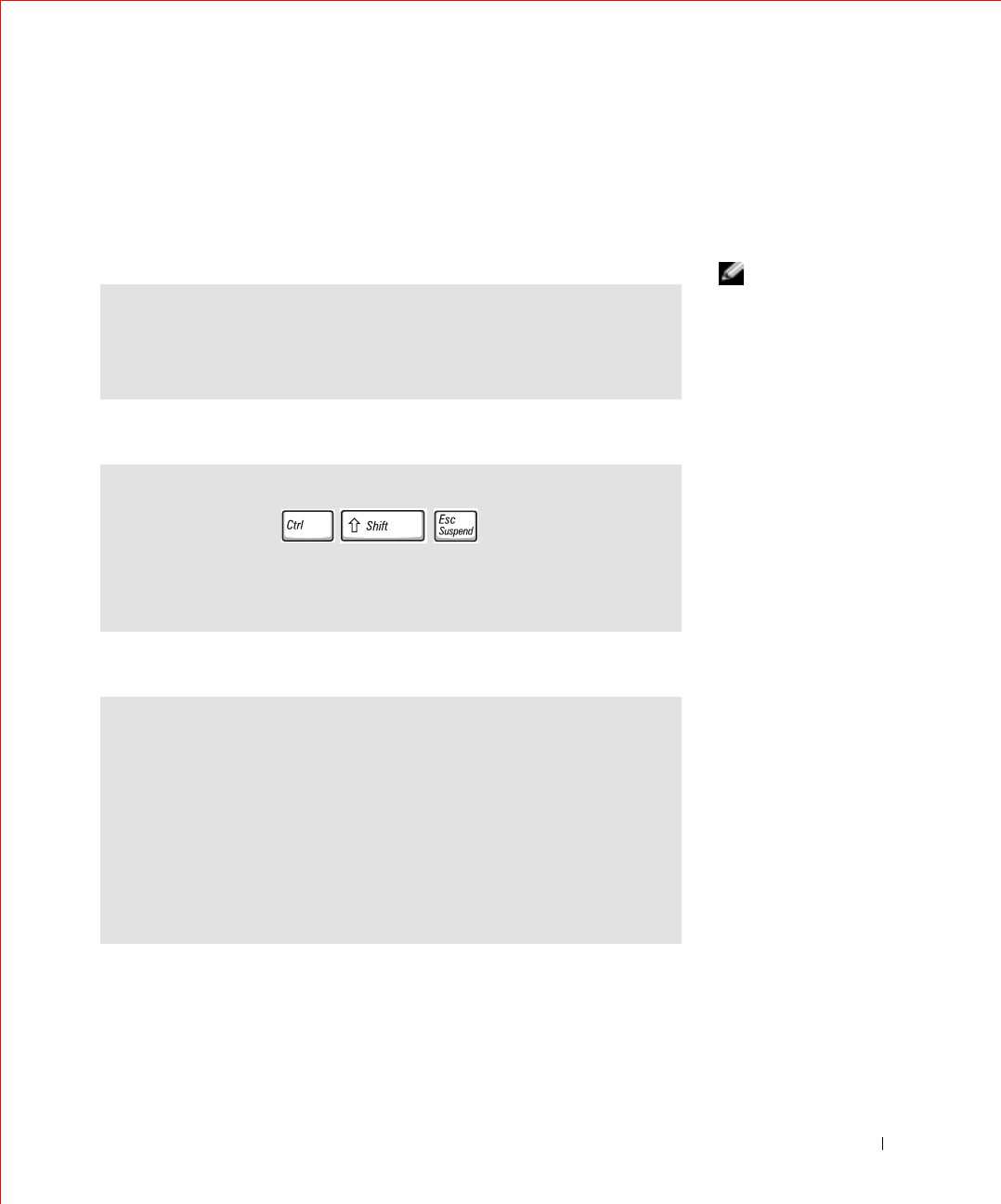
Solving Problems 127
FILE LOCATION: S:\SYSTEMS\Pebble\UG\A00\English\problems.fm
DELL CONFIDENTIAL – PRELIMINARY 1/29/03 – FOR PROOF ONLY
General Program Problems
Fill out the Diagnostics Checklist as you complete these checks.
A program crashes
NOTE: Software usually
includes installation
instructions in its
documentation or on a
floppy disk or CD.
A program stops responding
A solid blue screen appears
SEE THE SOFTWARE DOCUMENTATION —Many software manufacturers
maintain websites with information that may help you solve the problem. Ensure
that you properly installed and configured the program. Reinstall the program if
necessary.
END THE PROGRAM
1Simultaneously press .
2Click the Applications tab, and then select the program that is no longer
responding.
3 Click End Task.
TURN THE COMPUTER OFF —If the computer does not respond to a
keystroke or a proper shutdown, press the power button until the computer turns
off. Press the power button again to restart the computer.
Windows XP
The computer restarts.
Windows 2000
The solid blue screen appears because you were not able to perform a proper
Windows shutdown. ScanDisk automatically runs during the start-up process.
Follow the instructions on the screen.

128 Solving Problems
www.dell.com | support.dell.com
FILE LOCATION: S:\SYSTEMS\Pebble\UG\A00\English\problems.fm
DELL CONFIDENTIAL – PRELIMINARY 1/29/03 – FOR PROOF ONLY
Error messages appear
If Your Dell™ Computer Gets Wet
CAUTION: Perform this procedure only after you are certain that
it is safe to do so. If the computer is connected to an electrical
outlet, Dell recommends that you turn off AC power at the circuit
breaker before attempting to remove the power cables from the
electrical outlet. Use the utmost caution when removing wet
cables from a live power source.
1Shut down the computer, disconnect the AC adapter from the
computer, and then disconnect the AC adapter from the electrical
outlet.
2Turn off any attached external devices, and disconnect them from
their power sources and then from the computer.
3Ground yourself by touching one of the metal connectors on the back
of the computer.
4Remove any installed PC Cards and put them in a safe place to dry.
5Remove the battery.
6Wipe off the battery and put it in a safe place to dry.
7Remove the hard drive.
8Remove the memory modules.
9Open the display and place the computer right-side up across two
books or similar props to let air circulate all around it. Let the
computer dry for at least 24 hours in a dry area at room temperature.
NOTICE: Do not use artificial means, such as a hair dryer or a fan, to speed
the drying process.
REVIEW "Error Messages"—Look up the message and take the appropriate
action. See the software documentation.
CONFIRM THAT THE PROBLEM IS SOFTWARE-RELATED —Run the
System Board Devices tests in the Dell Diagnostics. If all tests in the device
group run successfully, the problem may be software-related. See the software
documentation.

Solving Problems 129
FILE LOCATION: S:\SYSTEMS\Pebble\UG\A00\English\problems.fm
DELL CONFIDENTIAL – PRELIMINARY 1/29/03 – FOR PROOF ONLY
CAUTION: To help prevent electrical shock, verify that the
computer is thoroughly dry before continuing with the rest of this
procedure.
10 Ground yourself by touching one of the metal connectors on the back
of the computer.
11 Replace the memory modules, the memory module cover, and the
screws.
12 Replace the hard drive.
13 Connect the external module bay, and replace any PC Cards you
removed.
14 Replace the battery.
15 Turn on the computer and verify that it is working properly.
NOTE: See your
System
Information Guide
for
information on your
warranty coverage.
If the computer does not start, or if you cannot identify the damaged
components, contact Dell.
If You Drop or Damage Your Computer
1Save and close any open files, exit any open programs, and shut down
the computer.
2Disconnect the AC adapter from the computer and from the electrical
outlet.
3Turn off any attached external devices, and disconnect them from
their power sources and then from the computer.
4Remove and reinstall the battery.
5Turn on the computer.
NOTE: See your
System
Information Guide
for
information on your
warranty coverage.
If the computer does not start, or if you cannot identify the damaged
components, contact Dell.

130 Solving Problems
www.dell.com | support.dell.com
FILE LOCATION: S:\SYSTEMS\Pebble\UG\A00\English\problems.fm
DELL CONFIDENTIAL – PRELIMINARY 1/29/03 – FOR PROOF ONLY
Resolving Other Technical Problems
GO TO THE DELL SUPPORT WEBSITE —Go to support.dell.com for help
with general usage, installation, and troubleshooting questions. See "Getting
Help" for a description of the hardware and software support provided by Dell.
E-MAIL DELL —Go to support.dell.com and then click E-Mail Dell in the
Communicate list. Send an e-mail message to Dell about your problem; you can
expect to receive an e-mail message from Dell within hours. See "Getting Help"
for a description of the hardware and software support provided by Dell.
CONTACT DELL —If you cannot solve your problem using the Dell Support
website (support.dell.com) or e-mail service, call Dell for technical assistance.
See "Getting Help" for a description of the hardware and software support
provided by Dell.

FILE LOCATION: S:\SYSTEMS\Pebble\UG\A00\English\diag.fm
DELL CONFIDENTIAL – PRELIMINARY 1/29/03 – FOR PROOF ONLY
15
SECTION 15
Using the Dell
Diagnostics

132 Using the Dell Diagnostics
www.dell.com | support.dell.com
FILE LOCATION: S:\SYSTEMS\Pebble\UG\A00\English\diag.fm
DELL CONFIDENTIAL – PRELIMINARY 1/29/03 – FOR PROOF ONLY
When to Use the Dell Diagnostics
Whenever a major component or device in your computer does not
function properly, you may have a component failure. If you are
experiencing a problem with your Dell™ computer, perform the checks in
"Solving Problems" and run the Dell Diagnostics before you call Dell for
technical assistance. Running the Dell Diagnostics may help you to resolve
the problem yourself quickly without having to contact Dell for assistance.
If you are experienced with computers and know what component(s) you
need to test, select the appropriate diagnostic test group(s) or subtest(s). If
you are unsure about how to begin diagnosing a problem, see "Starting the
Dell Diagnostics."
Features of the Dell Diagnostics
The Dell Diagnostics helps you to check your computer hardware without
any additional equipment and without destroying any data. By using the
diagnostics, you can have confidence in the operation of your computer. If
you find a problem that you cannot solve by yourself, the diagnostic tests
can provide you with important information you need when talking to Dell's
service and support personnel.
NOTICE: Use the Dell Diagnostics to test only your Dell computer. Using this
program with other computers may cause incorrect computer responses or
result in error messages.
The diagnostic test groups or subtests also have the following features:
• Options that let you perform express, extended, or custom tests on one
or all devices
• An option that allows you to select tests based on a symptom of the
problem you are having
• An option that allows you to choose the number of times a test group
or subtest is repeated
• The ability to display test results
• Options to temporarily suspend testing if an error is detected, or to
terminate testing
• Extensive online Help that describes the tests and devices
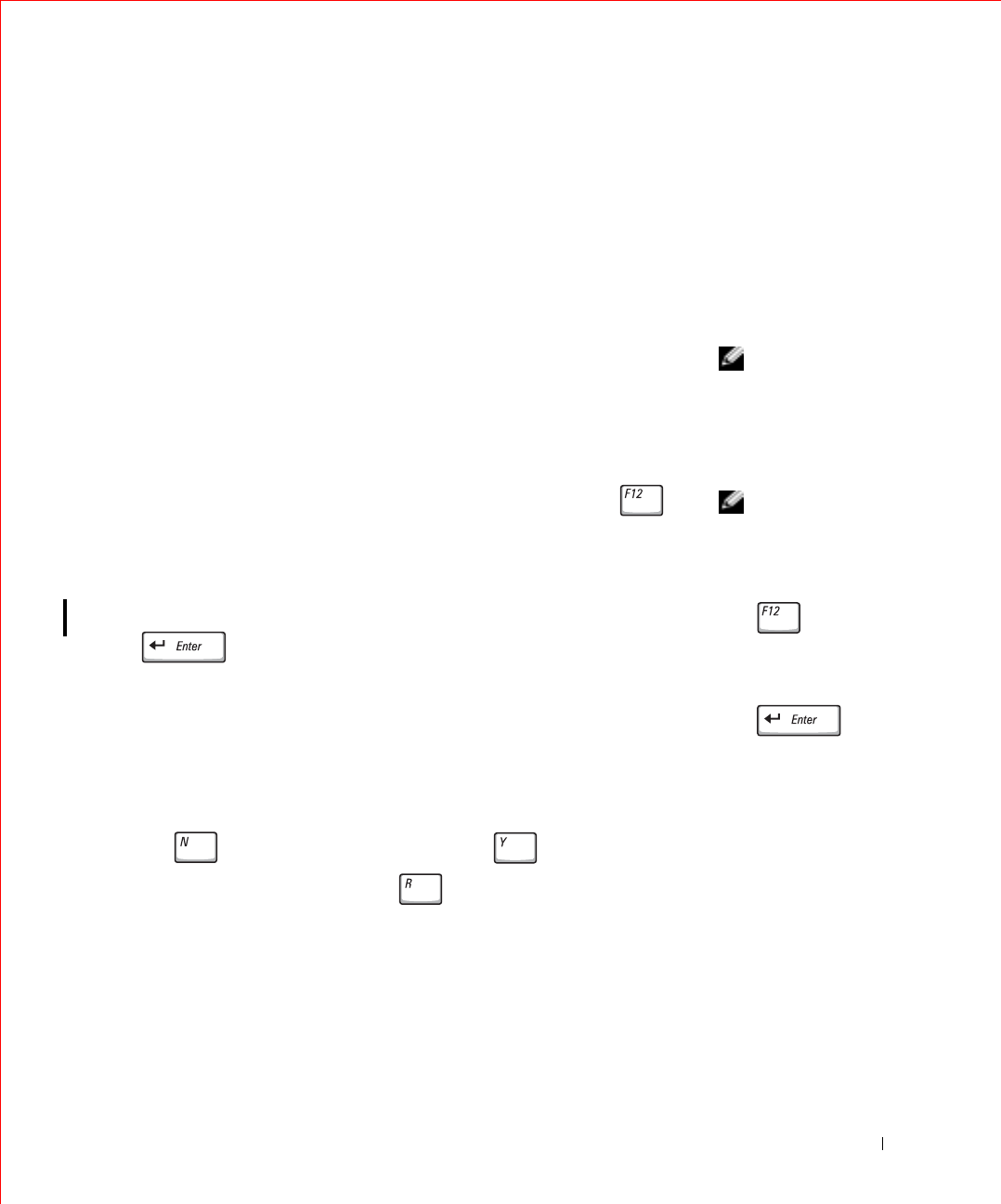
Using the Dell Diagnostics 133
FILE LOCATION: S:\SYSTEMS\Pebble\UG\A00\English\diag.fm
DELL CONFIDENTIAL – PRELIMINARY 1/29/03 – FOR PROOF ONLY
• Status messages that inform you whether test groups or subtests were
completed successfully
• Error messages that appear if any problems are detected
Starting the Dell Diagnostics
The Dell Diagnostics is located on a hidden Diagnostic utility partition on
your hard drive.
NOTE: If your computer
cannot display a screen
image, contact Dell.
1Shut down the computer.
2If the computer is connected to a docking device (docked), undock it.
See the documentation that came with your docking device for
instructions.
3Connect the computer to an electrical outlet.
NOTE: If you cannot see
anything on your display,
you can hold down the
mute button and press the
power button (instead of
) to begin the Dell
Diagnostics. You do not
need to highlight
Diagnostics and press
. The
computer automatically
runs the Pre-boot System
Assessment.
4Turn on the computer. When the DELL™ logo appears, press
immediately. If you wait too long and the Microsoft® Windows® logo
appears, continue to wait until you see the Windows desktop. Then
shut down your computer and try again.
5When the boot device list appears, highlight Diagnostics and press
.
The computer begins to run the Pre-boot System Assessment, a series
of embedded diagnostics that perform initial testing on your system
board, keyboard, hard drive, and display.
• During the assessment, answer any questions that appear.
• If a component failure is detected, the computer stops and beeps.
To stop the assessment and reboot to the operating system, press
; to continue to the next test, press ; to retest the
component that failed, press .
• If failures are detected during the Pre-boot System Assessment,
write down the error code(s) and contact Dell before continuing
on to the Dell Diagnostics.
• If you receive a message stating that no Diagnostics utility
partition has been found, follow the instructions on the screen to
run the Dell Diagnostics from your Drivers and Utilities CD.

134 Using the Dell Diagnostics
www.dell.com | support.dell.com
FILE LOCATION: S:\SYSTEMS\Pebble\UG\A00\English\diag.fm
DELL CONFIDENTIAL – PRELIMINARY 1/29/03 – FOR PROOF ONLY
If the Pre-boot System Assessment completes successfully, you receive
the message Booting Dell Diagnostic Utility Partition.
Press any key to continue.
6Press any key to start the Dell Diagnostics from the Diagnostics utility
partition on your hard drive.
7After the Dell Diagnostics loads and the Main Menu screen appears,
click the button for the option you want.
NOTE: The Service Tag
for your computer is
located in the title bar of
each screen.
8If a problem is encountered during a test, a message appears,
displaying the error code and a description of the problem. Write
down the error code and problem description and follow the
instructions on the screen. If you cannot resolve the error condition,
contact Dell.
9If you run a test from the Custom Test or Symptom Tree option, click
the applicable tab described in the following table for more
information.
Option Function
Express Test Performs a quick test of devices. The test typically takes 10 to
20 minutes and requires no interaction on your part. Run
Express Test first to increase the possibility of tracing the
problem quickly.
Extended Test Performs a thorough check of devices. The test typically takes
1 hour or more and requires you to answer questions
periodically.
Custom Test Tests a specific device. You can customize the tests to be run.
Symptom Tree Allows you to select tests based on a symptom of the problem
you are experiencing. The option lists the most common
symptoms.
Tab Function
Results Displays the results of the test and any error conditions
encountered.

Using the Dell Diagnostics 135
FILE LOCATION: S:\SYSTEMS\Pebble\UG\A00\English\diag.fm
DELL CONFIDENTIAL – PRELIMINARY 1/29/03 – FOR PROOF ONLY
10 When you have finished running a test, close the screen to return to
the Main Menu screen. To exit the Dell Diagnostics and reboot the
computer, close the Main Menu screen.
Errors Displays error conditions encountered, error codes, and
problem description.
Help Describes the test and may indicate requirements for
running the test.
Configuration Displays your hardware configuration for the selected
device.
The Dell Diagnostics obtains your configuration
information for all devices from the system setup
program, memory, and various internal tests and displays
the information in the device list in the left pane of the
screen. The device list may not display the names of all
the components installed on your computer or all
devices attached to your computer.
Parameters Allows you to customize the test by changing the test
settings.

136 Using the Dell Diagnostics
www.dell.com | support.dell.com
FILE LOCATION: S:\SYSTEMS\Pebble\UG\A00\English\diag.fm
DELL CONFIDENTIAL – PRELIMINARY 1/29/03 – FOR PROOF ONLY

FILE LOCATION: S:\SYSTEMS\Pebble\UG\A00\English\cleaning.fm
DELL CONFIDENTIAL – PRELIMINARY 1/29/03 – FOR PROOF ONLY
16
SECTION 16
Cleaning Your
Computer

138 Cleaning Your Computer
www.dell.com | support.dell.com
FILE LOCATION: S:\SYSTEMS\Pebble\UG\A00\English\cleaning.fm
DELL CONFIDENTIAL – PRELIMINARY 1/29/03 – FOR PROOF ONLY
1Shut down the computer through the Start menu.
2Ensure that your computer and attached devices are turned off. If your
computer and attached devices did not automatically turn off when
you shut down your computer, turn them off now.
3Remove the battery.
Computer, Keyboard, and Display
• Gently use a vacuum cleaner with a brush attachment to remove dust
from the slots and holes on your computer and between the keys on
the keyboard.
NOTICE: To avoid damaging the computer or display, do not spray cleaning
solution directly onto the display. Only use products specifically designed for
cleaning LCDs, and follow the instructions that are included with the product.
• Moisten a soft, lint-free cloth with water or an LCD cleaner, and wipe
the display until it is clean.
• Moisten a soft, lint-free cloth with water or an LCD cleaner, and wipe
the computer and keyboard. Do not allow water from the cloth to seep
between the touch pad and the surrounding palm rest.
Touch Pad
1Shut down and turn off your computer, disconnect any attached
devices, and disconnect them from their electrical outlets.
2Remove the battery.
3Moisten a soft, lint-free cloth with water, and stroke it gently across the
surface of the touch pad. Do not allow water from the cloth to seep
between the touch pad and the surrounding palm rest.
Floppy Drive
NOTICE: Do not attempt to clean drive heads with a swab. You might
accidentally misalign the heads, which prevents the drive from operating.
Clean your floppy drive using a commercially available cleaning kit. These
kits contain pretreated floppy disks to remove contaminants that
accumulate during normal operation.
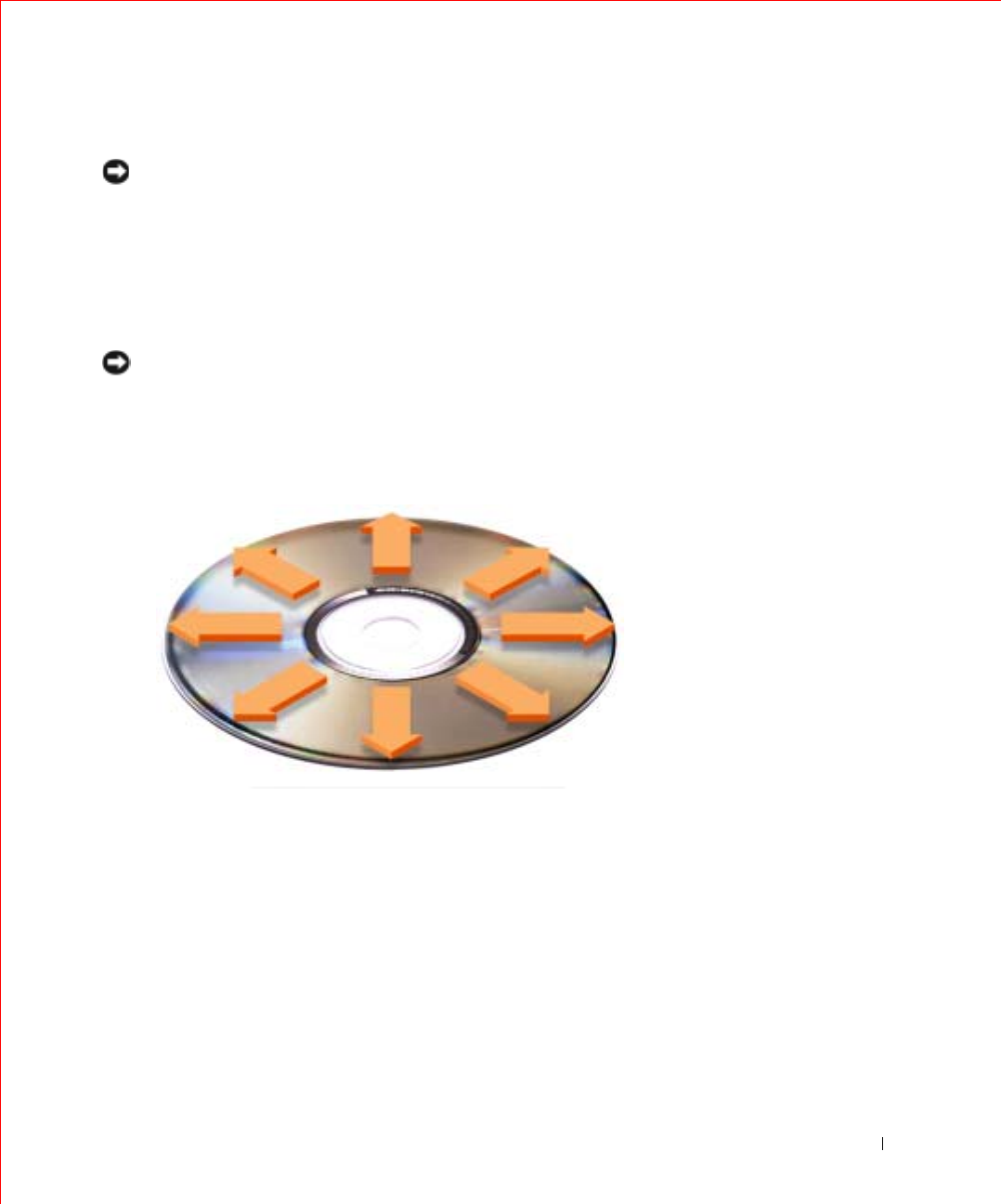
Cleaning Your Computer 139
FILE LOCATION: S:\SYSTEMS\Pebble\UG\A00\English\cleaning.fm
DELL CONFIDENTIAL – PRELIMINARY 1/29/03 – FOR PROOF ONLY
Optical Media
NOTICE: Always use compressed air to clean the lens in the drive, and follow
the instructions that are included with the compressed air. Never touch the lens
in the drive.
If you notice problems, such as skipping, with the playback quality of your
CDs or DVDs, try cleaning the discs.
1Hold the disc by its outer edge. You can also touch the inside edge of
the center hole.
NOTICE: To prevent damaging the surface, do not wipe in a circular motion
around the disc.
2With a soft, lint-free cloth, gently wipe the bottom of the disc (the
unlabeled side) in a straight line from the center to the outer edge of
the disc.
You can also purchase commercial products that clean discs and
provide some protection from dust, fingerprints, and scratches.
Cleaning products for CDs are safe to use on DVDs.
3Connect your computer and devices to electrical outlets, and turn
them on.

140 Cleaning Your Computer
www.dell.com | support.dell.com
FILE LOCATION: S:\SYSTEMS\Pebble\UG\A00\English\cleaning.fm
DELL CONFIDENTIAL – PRELIMINARY 1/29/03 – FOR PROOF ONLY

FILE LOCATION: S:\SYSTEMS\Pebble\UG\A00\English\drivers.fm
DELL CONFIDENTIAL – PRELIMINARY 1/29/03 – FOR PROOF ONLY
17
SECTION 17
Reinstalling Software

142 Reinstalling Software
www.dell.com | support.dell.com
FILE LOCATION: S:\SYSTEMS\Pebble\UG\A00\English\drivers.fm
DELL CONFIDENTIAL – PRELIMINARY 1/29/03 – FOR PROOF ONLY
Reinstalling Drivers and Utilities
Dell ships your computer to you with required drivers and utilities already
installed—no further installation or configuration is needed.
NOTICE: The
Drivers and Utilities
CD may contain drivers for operating
systems that are not on your computer. Ensure that you are installing software
appropriate for your operating system.
To reinstall drivers for optional devices such as wireless communications
and DVD drives, you may need the CD and documentation that came with
those devices.
NOTICE: The Dell Support website, support.dell.com, and the
Drivers and
Utilities
CD provide approved drivers for Dell™ computers. If you install
drivers from other sources, your computer might not work correctly.
To reinstall a driver or utility from your Drivers and Utilities CD:
1Save and close any open files, and exit any open programs.
2Insert the Drivers and Utilities CD.
In most cases, the CD starts running automatically. If it does not, start
Microsoft® Windows® Explorer, click your CD drive directory to
display the CD contents, and then double-click the autorcd.exe file.
The first time that you run the CD, it might prompt you to install
setup files. Click OK, and follow the instructions on the screen to
continue.
3From the Language drop-down menu in the toolbar, select your
preferred language for the driver or utility (if available).
A welcome screen appears.
4Click Next. The CD automatically scans your hardware to detect
drivers and utilities used by your computer.
After the CD completes the hardware scan, you can also detect other
drivers and utilities. Under Search Criteria, select the appropriate
categories from the System Model, Operating System, and Topic
drop-down menus.
A link or links appear(s) for the specific drivers and utilities used by
your computer.
5Click the link of a specific driver or utility to display information about
the driver or utility that you want to install.

Reinstalling Software 143
FILE LOCATION: S:\SYSTEMS\Pebble\UG\A00\English\drivers.fm
DELL CONFIDENTIAL – PRELIMINARY 1/29/03 – FOR PROOF ONLY
6Click the Install button (if present) to begin installing the driver or
utility. At the welcome screen, follow the screen prompts to complete
the installation.
If no Install button is present, automatic installation is not an option.
For installation instructions, either see the appropriate instructions in
the following subsections, or click Extract, follow the extracting
instructions, and read the readme file.
If instructed to navigate to the driver files, click the CD directory on
the driver information window to display the files associated with that
driver.
Manually Reinstalling Drivers for Windows XP
NOTE: If you are
reinstalling an infrared-
sensor driver, you must
first enable the infrared
sensor in the system setup
program before
continuing with the driver
installation.
1After extracting the driver files to your hard drive as described
previously, click the Start button, point to Settings, and then click
Control Panel.
2Click the Start button and right-click My Computer.
3Click Properties.
4Click the Hardware tab and click Device Manager.
5Double-click the type of device for which you are installing the driver
(for example, Modems or Infrared devices).
6Double-click the name of the device for which you are installing the
driver.
7Click the Driver tab and click Update Driver.
8Select Install from a list or specific location (Advanced) and click
Next.
9Click Browse, and browse to the location to which you previously
extracted the driver files.
10 When the name of the appropriate driver appears, click Next.
11 Click Finish and restart your computer.

144 Reinstalling Software
www.dell.com | support.dell.com
FILE LOCATION: S:\SYSTEMS\Pebble\UG\A00\English\drivers.fm
DELL CONFIDENTIAL – PRELIMINARY 1/29/03 – FOR PROOF ONLY
Using the Windows XP Device Driver Rollback
If you install a new device driver that causes system instability, you can use
the Windows XP Device Driver Rollback to replace the new device driver
with the previously installed version of the device driver. If you cannot
reinstall your previous driver by using the Device Driver Rollback process,
then use System Restore to return your operating system to its previous
operating state before you installed the new device driver. To use Device
Driver Rollback:
1Click the Start button and right-click My Computer.
2Click Properties.
3Click the Hardware tab and click Device Manager.
4In the Device Manager window, right-click the device for which the
new driver was installed and then click Properties.
5Click the Drivers tab.
6Click Roll Back Driver.
Manually Reinstalling Drivers for Windows 2000
NOTE: If you are
reinstalling an infrared
driver, you must first
enable the infrared sensor
in the system setup
program before
continuing with the driver
installation.
1After extracting the driver files to your hard drive as described
previously, click the Start button, point to Settings, and then click
Control Panel.
2Double-click the System icon.
3Click the Hardware tab.
4Click Device Manager.
5Double-click the type of device for which you are installing the driver
(for example, Modems or Infrared devices).
6Double-click the name of the device.
7Click the Driver tab and click Update Driver.
8Click Next.
9Ensure that Search for a suitable driver for my device (recommended)
is selected, and then click Next.
10 Ensure that the Specify a location check box is checked and that all
other check boxes are unchecked, and click Next.

Reinstalling Software 145
FILE LOCATION: S:\SYSTEMS\Pebble\UG\A00\English\drivers.fm
DELL CONFIDENTIAL – PRELIMINARY 1/29/03 – FOR PROOF ONLY
11 Click Browse to browse to the location to which you previously
extracted the driver files.
12 When the name of the appropriate driver appears, click Next.
13 Click Finish and restart your computer.
Resolving Software and Hardware
Incompatibilities
In the Microsoft® Windows® XP and Windows 2000 operating systems,
IRQ conflicts occur if a device either is not detected during the operating
system setup or is detected but incorrectly configured. See the following
subsection that corresponds to your operating system to check for IRQ
conflicts on your computer.
Windows XP
1Click the Start button and click Control Panel.
2Click Performance and Maintenance and click System.
3Click the Hardware tab and click Device Manager.
4In the Device Manager list, check for conflicts with the other devices.
Conflicts are indicated by a yellow exclamation point (!) beside the
conflicting device or a red X if the device has been disabled.
5Double-click any conflicting device listed to bring up the Properties
window so that you can determine what needs to be reconfigured or
removed from the Device Manager.
6Resolve these conflicts before checking specific devices.
7Double-click the malfunctioning device type in the Device Manager
list.
8Double-click the icon for the specific device in the expanded list.
The Properties window appears.
If an IRQ conflict exists, the Device status area in the Properties
window reports what other devices are sharing the device's IRQ.
9Resolve any IRQ conflicts.

146 Reinstalling Software
www.dell.com | support.dell.com
FILE LOCATION: S:\SYSTEMS\Pebble\UG\A00\English\drivers.fm
DELL CONFIDENTIAL – PRELIMINARY 1/29/03 – FOR PROOF ONLY
You can also use the Windows XP Hardware Troubleshooter. To use the
troubleshooter, click the Start button and click Help and Support. Type
hardware troubleshooter in the Search field, and then click the arrow
to start the search. Click Hardware Troubleshooter in the Search Results
list. In the Hardware Troubleshooter list, click I need to resolve a hardware
conflict on my computer and click Next.
Windows 2000
1Click the Start button, point to Settings, and then click Control
Panel.
2Double-click the System icon.
3Click the Hardware tab.
4Click Device Manager.
5Click View and click Resources by connection.
6Double-click Interrupt request (IRQ) to view the IRQ assignments.
Conflicts are indicated by a yellow exclamation point (!) beside the
conflicting device or a red X if the device has been disabled.
7Double-click any conflicting device listed to bring up the Properties
window so that you can determine what needs to be reconfigured or
removed from the Device Manager. Resolve these conflicts before
checking specific devices.
8Double-click the malfunctioning device type in the Device Manager
list.
9Double-click the icon for the specific device in the expanded list.
The Properties window appears.
If an IRQ conflict exists, the Device status area in the Properties
window reports what other devices are sharing the device's IRQ.
10 Resolve any IRQ conflicts.
You can also use the Windows 2000 Hardware Troubleshooter. To use the
troubleshooter, click the Start button and click Help. Click
Troubleshooting and Maintenance on the Contents tab, click Windows
2000 troubleshooters, and then click Hardware. In the Hardware
Troubleshooter list, click I need to resolve a hardware conflict on my
computer, and then click Next.

Reinstalling Software 147
FILE LOCATION: S:\SYSTEMS\Pebble\UG\A00\English\drivers.fm
DELL CONFIDENTIAL – PRELIMINARY 1/29/03 – FOR PROOF ONLY
Using Microsoft® Windows® System
Restore
The Microsoft Windows XP operating system provides a System Restore
feature that allows you to return your computer to an earlier operating state
if changes to the computer’s hardware, software (including new hardware or
program installations), or system settings have left the computer in an
undesirable operating state. You can also undo the last system restore.
System Restore automatically creates system checkpoints. You can also
manually create your own checkpoints by creating restore points. To limit
the amount of hard disk space used, older restore points will be
automatically purged.
To resolve an operating system problem, you can use System Restore from
Safe Mode or Normal Mode to return your computer to an earlier operating
state.
System Restore does not cause you to lose personal files stored in the My
Documents folder, data files, or e-mail messages after restoring the
computer to an earlier time. If you restore the computer to an operating
state that existed before you installed a program, the program’s data files are
not lost, but you must reinstall the actual program again.
NOTICE: It is important to make regular backups of your data files. System
Restore does not monitor changes to or recover your data files. If the original
data on the hard disk is accidentally erased or overwritten, or if it becomes
inaccessible because of a hard disk malfunction, use your backup files to
recover the lost or damaged data.
System Restore is enabled on your new computer. However, if you reinstall
Windows XP with less than 200 MB of free hard-disk space available,
System Restore is automatically disabled. Before you use System Restore,
confirm that it is enabled:
1Click the Start button and click Control Panel.
2Click the Performance and Maintenance.
3Click System.
4Click the System Restore tab.
5Ensure that Turn off System Restore is not checked.

148 Reinstalling Software
www.dell.com | support.dell.com
FILE LOCATION: S:\SYSTEMS\Pebble\UG\A00\English\drivers.fm
DELL CONFIDENTIAL – PRELIMINARY 1/29/03 – FOR PROOF ONLY
Creating a Restore Point
You can either use the System Restore Wizard or manually create a restore
point.
Using the System Restore Wizard
To use the System Restore Wizard, click the Start button, click Help and
Support, click System Restore, and then follow the instructions in the
System Restore Wizard window. You can also create and name a restore
point if you are logged on as the computer administrator or a user with
administrator rights.
Manually Creating a Restore Point
1Click the Start button, point to All Programs→ Accessories→ System
Tools, and then click System Restore.
2Click Create a restore point.
3Click Next.
4Type a name for the new restore point in the Restore point description
field.
The present date and time are automatically added to the description
of the new restore point.
5Click Create.
6Click OK.
Restoring the Computer to an Earlier Operating State
If problems occur after installing a device driver, first try using Device
Driver Rollback. If Device Driver Rollback does not resolve the problem,
then use System Restore.
NOTICE: Before restoring the computer to an earlier operating state, save
and close all open files and exit all open programs. Do not alter, open, or delete
any files or programs until the system restoration is complete.
1Click the Start button, point to All Programs→
Accessories→ System Tools, and then click System Restore.
2Ensure that Restore my computer to an earlier time is selected and
click Next.

Reinstalling Software 149
FILE LOCATION: S:\SYSTEMS\Pebble\UG\A00\English\drivers.fm
DELL CONFIDENTIAL – PRELIMINARY 1/29/03 – FOR PROOF ONLY
3Click a calendar date to which you want to restore your computer.
The Select a Restore Point screen provides a calendar that allows you
to see and select restore points. All calendar dates with available
restore points appear in bold.
4Select a restore point and click Next.
If a calendar date has only one restore point, then that restore point is
automatically selected. If two or more restore points are available, click
the restore point that you want to use.
NOTICE: Save and close all open files and exit all open programs. Do not
alter, open, or delete any files or programs until the system restoration is
complete.
5Click Next.
The Restoration Complete screen appears after System Restore
finishes collecting data, and then the computer automatically restarts.
6After the computer restarts, click OK.
To change the restore point, you can either repeat the steps using a
different restore point, or you can undo the restoration.
Undoing the Last System Restore
NOTICE: Save and close all open files and exit all open programs. Do not
alter, open, or delete any files or programs until the system restoration is
complete.
1Click the Start button, point to All Programs→
Accessories→ System Tools, and then click System Restore.
2Select Undo my last restoration and click Next.
NOTICE: Save and close all open files and exit all open programs. Do not
alter, open, or delete any files or programs until the system restoration is
complete.
3Click Next.
The System Restore screen appears, and then the computer
automatically restarts.
4After the computer restarts, click OK.

150 Reinstalling Software
www.dell.com | support.dell.com
FILE LOCATION: S:\SYSTEMS\Pebble\UG\A00\English\drivers.fm
DELL CONFIDENTIAL – PRELIMINARY 1/29/03 – FOR PROOF ONLY
Reinstalling Microsoft® Windows® XP
Before You Reinstall
If you are considering reinstalling the Windows XP operating system to
correct a problem with a newly installed driver, first try using Windows XP
Device Driver Rollback. If Device Driver Rollback does not resolve the
problem, then use System Restore to return your operating system to the
operating state it was in before you installed the new device driver.
Reinstalling Windows XP
To reinstall Windows XP, perform all the steps in the following sections in
the order in which they are listed.
The reinstallation process can take 1 to 2 hours to complete. After you
reinstall the operating system, you must also reinstall the device drivers,
virus protection program, and other software.
NOTICE: The
Operating System
CD provides options for reinstalling Windows
XP. The options can overwrite files and possibly affect programs installed on
your hard drive. Therefore, do not reinstall Windows XP unless instructed to
do so by a Dell technical support representative.
NOTICE: To prevent conflicts with Windows XP, disable any virus protection
software installed on your computer before you reinstall Windows XP. See the
documentation that came with the software for instructions.
Booting From the Operating System CD
1Save and close any open files and exit any open programs.
2Insert the Operating System CD. If any program starts automatically,
exit the program before proceeding.
3Shut down the computer through the Start menu and restart the
computer.
4Press immediately after the DELL™ logo appears.
If the operating system logo appears, wait until you see the Windows
desktop, and then shut down the computer and try again.
5Press the arrow keys to select CD-ROM, and then press .
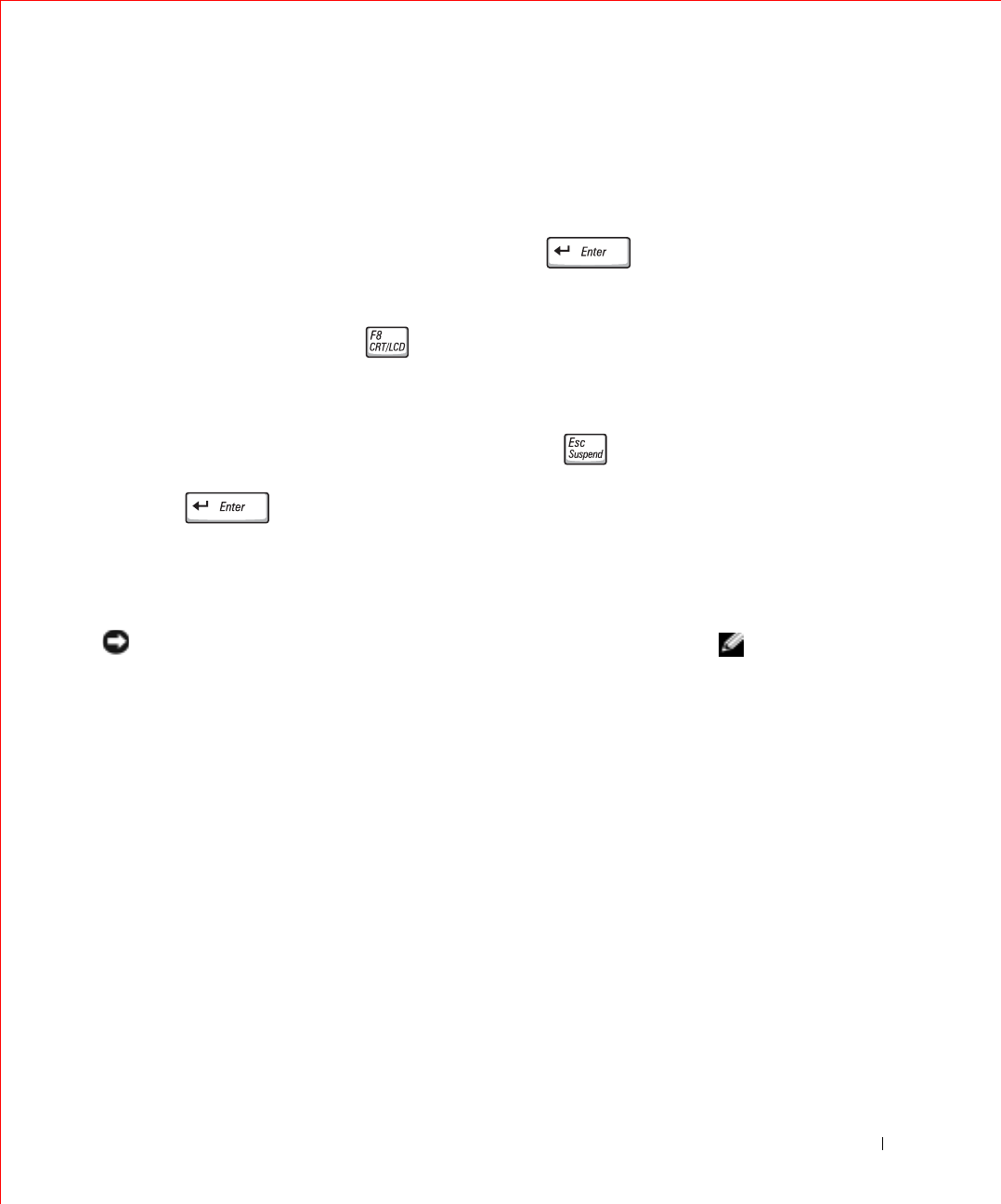
Reinstalling Software 151
FILE LOCATION: S:\SYSTEMS\Pebble\UG\A00\English\drivers.fm
DELL CONFIDENTIAL – PRELIMINARY 1/29/03 – FOR PROOF ONLY
6When the Press any key to boot from CD message appears,
press any key.
Windows XP Setup
1When the Windows XP Setup screen appears, press to
select To set up Windows now.
2Read the information on the Microsoft Windows Licensing
Agreement screen, and press to accept the license agreement.
3If your computer already has Windows XP installed and you want to
recover your current Windows XP data, type r to select the repair
option, and then remove the CD from the drive.
4If you want to install a new copy of Windows XP, press to select
that option.
5Press to select the highlighted partition
(recommended), and then follow the instructions on the screen.
The Windows XP Setup screen appears, and the operating system
begins to copy files and install the devices. The computer
automatically restarts multiple times.
NOTE: The time required
to complete the setup
depends on the size of the
hard drive and the speed
of your computer.
NOTICE: Do not press any key when the following message appears: Press
any key to boot from the CD.
6When the Regional and Language Options screen appears, select the
settings for your location, and then click Next.
7Enter your name and organization (optional) in the Personalize Your
Software screen and click Next.
8If you are reinstalling Windows XP Home Edition, at the What's your
computer's name window, enter a name for your computer (or accept
the name provided) and click Next.
If you are reinstalling Windows XP Professional, at the Computer
Name and Administrator Password window, enter a name for your
computer (or accept the one provided) and a password, and then click
Next.
9If the Modem Dialing Information screen appears, enter the
requested information and click Next.

152 Reinstalling Software
www.dell.com | support.dell.com
FILE LOCATION: S:\SYSTEMS\Pebble\UG\A00\English\drivers.fm
DELL CONFIDENTIAL – PRELIMINARY 1/29/03 – FOR PROOF ONLY
10 Enter the date, time, and time zone in the Date and Time Settings
window and click Next.
11 If the Networking Settings screen appears, click Ty pi c a l and click
Next.
12 If you are reinstalling Windows XP Professional and you are prompted
to provide further information regarding your network configuration,
enter your selections. If you are unsure of your settings, accept the
default selections.
Windows XP installs the operating system components and configures
the computer. The computer automatically restarts.
NOTICE: Do not press any key when the following message appears: Press
any key to boot from the CD.
13 When the Welcome to Microsoft screen appears, click Next.
14 When the How will this computer connect to the
Internet? message appears, click Skip.
15 When the Ready to register with Microsoft? screen appears, select No,
not at this time and click Next.
16 When the Who will use this computer? screen appears, you can enter
up to five users. Click Next.
17 Click Finish to complete the setup, and remove the CD from the
drive.
Reinstalling Drivers and Software
1Reinstall the appropriate drivers.
2Reinstall your virus protection software. See the documentation that
came with the software for instructions.
3Reinstall your other software programs. See the documentation that
came with the software for instructions.
Reinstalling Windows 2000
NOTICE: The
Operating System
CD provides options for reinstalling the
Windows 2000 operating system. The options can potentially overwrite files
installed by Dell and possibly affect programs installed on your hard drive.
Therefore, do not reinstall your operating system unless instructed to do so by
a Dell technical support representative.

Reinstalling Software 153
FILE LOCATION: S:\SYSTEMS\Pebble\UG\A00\English\drivers.fm
DELL CONFIDENTIAL – PRELIMINARY 1/29/03 – FOR PROOF ONLY
Booting From the Operating System CD
1Save and close any open files and exit any open programs.
2Insert the Operating System CD. If any program starts automatically,
exit the program before proceeding.
3Shut down the computer through the Start menu and restart the
computer.
4Press immediately after the DELL™ logo appears.
If the operating system logo appears, wait until you see the Windows
desktop, and then shut down the computer and try again.
5Press the arrow keys to select CD-ROM, and then press .
6When the Press any key to boot from CD message appears,
press any key.
Windows 2000 Setup
1When the Windows 2000 Setup window appears, ensure that To setup
Win2000 now, press ENTER is highlighted. Then press .
2Read the information in the License Agreement window and press
to continue.
3When the Windows 2000 Professional Setup window appears, press
the arrow keys to select the Windows 2000 partition option that you
want. Then press the key for the partition option you chose.
4When the Windows 2000 Professional Setup window reappears, press
the arrow keys to select the type of file system that you want Windows
2000 to use, and then press .
5Press again to restart your computer.
6Click Next when the Welcome to the Windows 2000 Setup Wizard
window appears.
7When the Regional Settings window appears, select your region, and
then click Next.
8Enter your name and organization in the Personalize Your Software
window and click Next.
9Enter the Windows product key, which is printed on the Microsoft
label on your computer. Then click Next.

154 Reinstalling Software
www.dell.com | support.dell.com
FILE LOCATION: S:\SYSTEMS\Pebble\UG\A00\English\drivers.fm
DELL CONFIDENTIAL – PRELIMINARY 1/29/03 – FOR PROOF ONLY
10 When the Computer Name and Administrator Password window
appears, enter a name for your computer and a password, if desired.
Then click Next.
11 Enter the date and time in the Date and Time Settings window and
click Next.
Windows 2000 installs components and configures the computer.
12 When the Completing the Windows 2000 Setup Wizard window
appears, remove the CD from the drive and click Finish.
The computer automatically restarts.
Enabling Hibernate Mode
1Click the Start button, point to Settings and click Control Panel.
2Double-click the Power Management icon.
3Click the Hibernate tab.
4Ensure that Enable hibernate support is selected and click Apply.
5Click OK to close the Control Panel.

FILE LOCATION: S:\SYSTEMS\Pebble\UG\A00\English\r_r.fm
DELL CONFIDENTIAL – PRELIMINARY 1/29/03 – FOR PROOF ONLY
18
SECTION 18
Adding and Replacing
Parts

156 Adding and Replacing Parts
www.dell.com | support.dell.com
FILE LOCATION: S:\SYSTEMS\Pebble\UG\A00\English\r_r.fm
DELL CONFIDENTIAL – PRELIMINARY 1/29/03 – FOR PROOF ONLY
Adding Memory
You can increase your computer memory by installing memory modules on
the system board. See "Specifications" for information on the memory
supported by your computer. Install only memory modules that are
intended for your computer.
NOTE: Memory modules
purchased from Dell are
covered under your
computer warranty.
CAUTION: Before working inside your computer, read the safety
instructions in your
System Information Guide
.
1Ensure that the work surface is flat and clean to prevent scratching the
computer cover.
2Save and close any open files, exit any open programs, and then shut
down the computer.
3If the computer is connected to a docking device (docked), undock it.
See the documentation that came with your docking device for
instructions.
4Disconnect the computer from the electrical outlet.
5Wait 10 to 20 seconds, and then disconnect any attached devices.
6Remove any installed PC Cards and the battery.
NOTICE: Handle components and cards by their edges, and avoid touching
pins and contacts. Ground yourself by touching a metal connector on the back
of the computer. Continue to ground yourself periodically during this
procedure.
7Continue to the appropriate section:
•"Installing a Memory Module Under the Memory Module/Modem
Cover"
•"Installing a Memory Module Under the Keyboard"
Installing a Memory Module Under the Memory Module/Modem
Cover
1Turn the computer over, loosen the captive screws on the memory
module/modem cover, and then remove the cover.
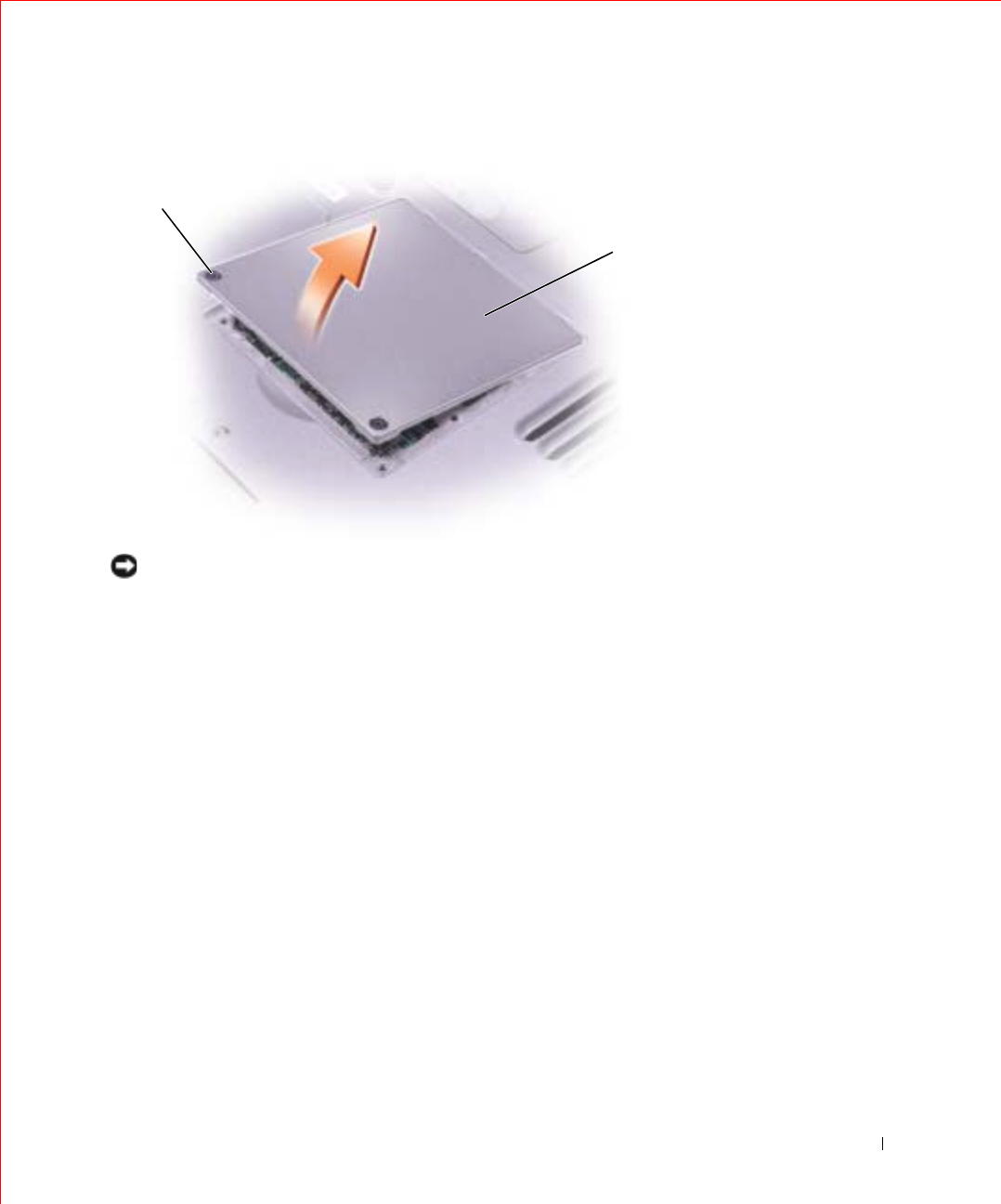
Adding and Replacing Parts 157
FILE LOCATION: S:\SYSTEMS\Pebble\UG\A00\English\r_r.fm
DELL CONFIDENTIAL – PRELIMINARY 1/29/03 – FOR PROOF ONLY
NOTICE: To prevent damage to the memory module connector, do not use
tools to spread the memory-module securing clips.
2If you are replacing a memory module, remove the existing module:
aUse your fingertips to carefully spread apart the securing clips on
each end of the memory module connector until the module pops
up.
bRemove the module from the connector.
1
2
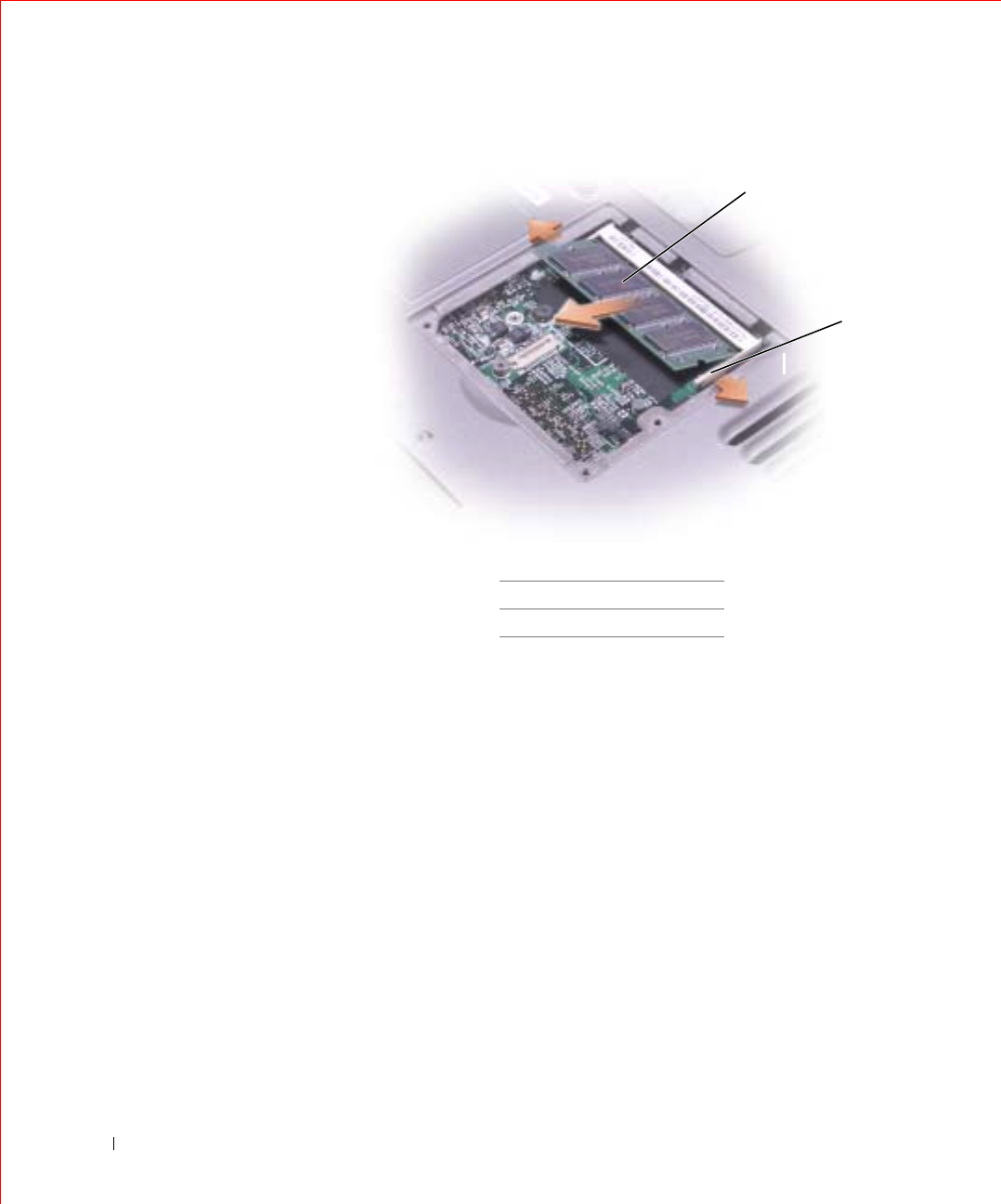
158 Adding and Replacing Parts
www.dell.com | support.dell.com
FILE LOCATION: S:\SYSTEMS\Pebble\UG\A00\English\r_r.fm
DELL CONFIDENTIAL – PRELIMINARY 1/29/03 – FOR PROOF ONLY
3Ground yourself and install the new memory module:
aAlign the notch in the module edge connector with the tab in the
connector slot.
bSlide the module firmly into the slot at a 45-degree angle, and
rotate the module down until it clicks into place. If you do not feel
the click, remove the module and reinstall it.
1memory module
2securing clips (2)
1
2
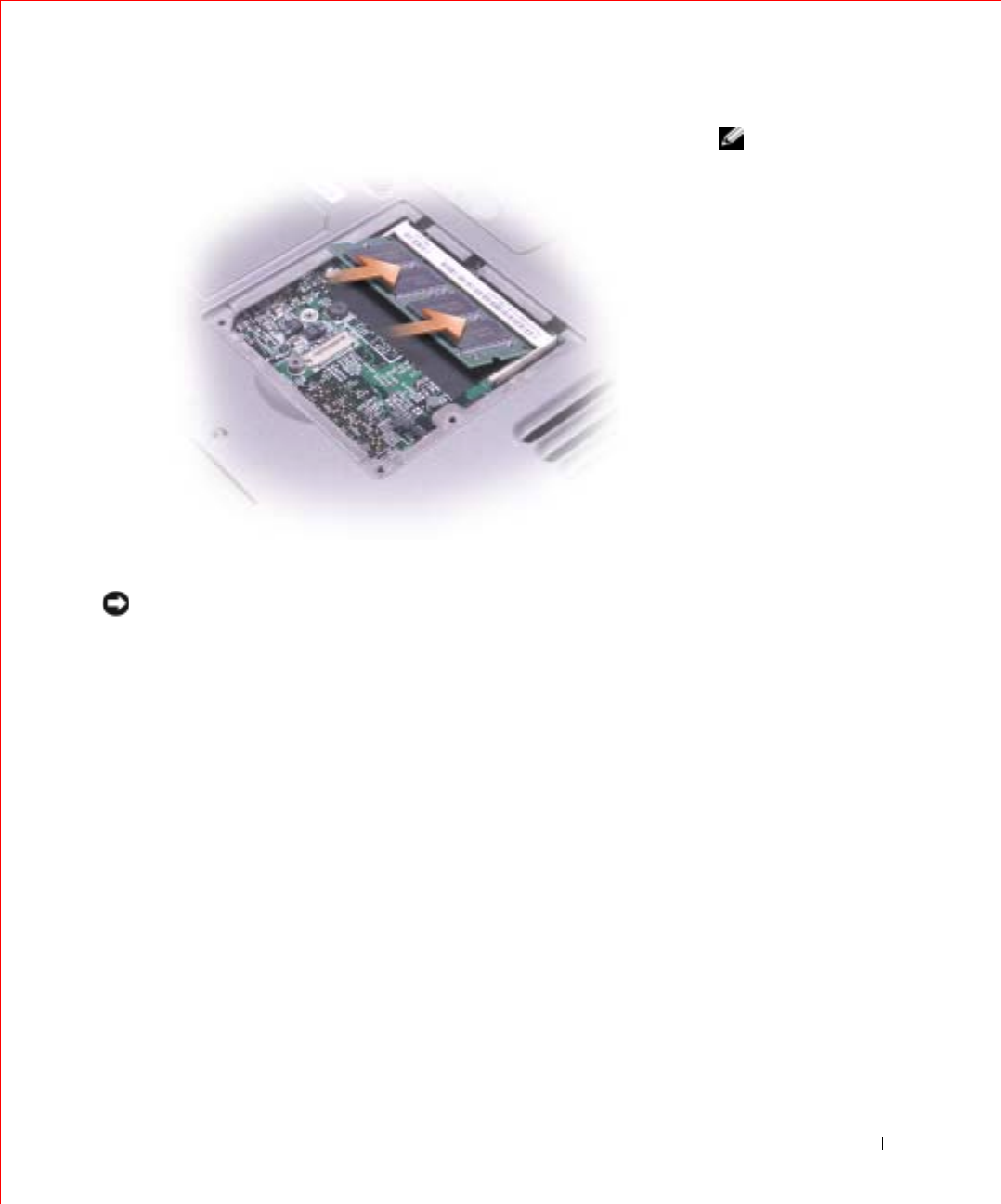
Adding and Replacing Parts 159
FILE LOCATION: S:\SYSTEMS\Pebble\UG\A00\English\r_r.fm
DELL CONFIDENTIAL – PRELIMINARY 1/29/03 – FOR PROOF ONLY
NOTE: If the memory
module is not installed
properly, the computer
may not boot properly. No
error message indicates
this failure.
4Replace the cover.
NOTICE: If the cover is difficult to close, remove the module and reinstall it.
Forcing the cover to close may damage your computer.
5Insert the battery into the battery bay, or connect the AC adapter to
your computer and an electrical outlet.
6Turn on the computer.
As the computer boots, it detects the additional memory and automatically
updates the system configuration information.
To confirm the amount of memory installed in the computer:
•In Windows XP, click the Start button, click Help and Support, and
then click Computer Information.
•In Windows 2000, right-click the My Computer icon on your desktop,
and then click the General tab.
Installing a Memory Module Under the Keyboard
1Remove the keyboard.
2Loosen the two captive screws in the cover labeled "DIMM1."
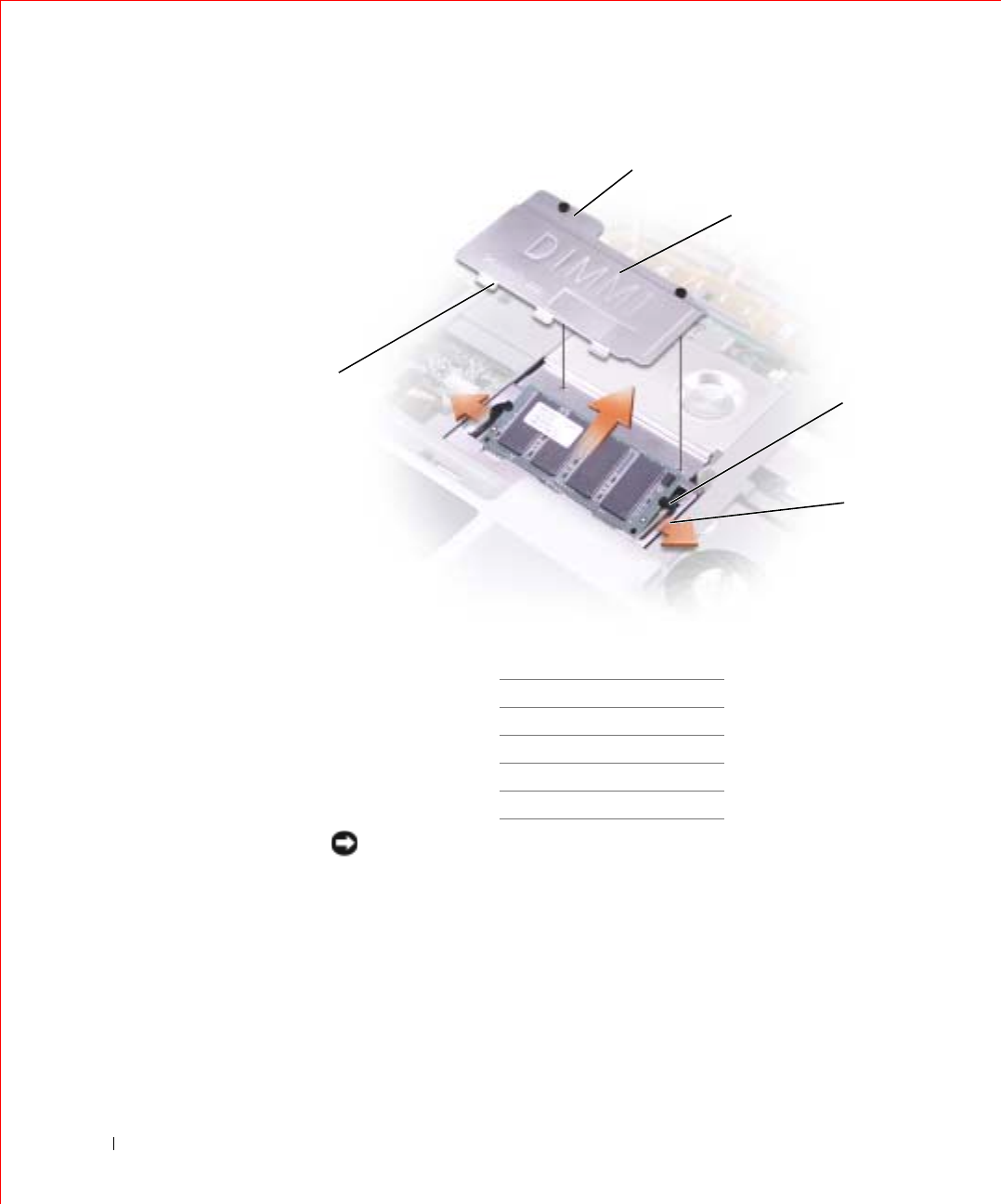
160 Adding and Replacing Parts
www.dell.com | support.dell.com
FILE LOCATION: S:\SYSTEMS\Pebble\UG\A00\English\r_r.fm
DELL CONFIDENTIAL – PRELIMINARY 1/29/03 – FOR PROOF ONLY
NOTICE: To prevent damage to the memory module connector, do not use
tools to spread the memory-module securing clips.
3If you are replacing a memory module, remove the existing module:
aUse your fingertips to carefully spread apart the securing clips on
each end of the memory module connector until the module pops
up.
bRemove the module from the connector.
4Ground yourself and install the new memory module:
1captive screws (2)
2DIMM1 cover
3memory module
4securing clips (2)
5securing tabs (3)
1
2
3
4
5

Adding and Replacing Parts 161
FILE LOCATION: S:\SYSTEMS\Pebble\UG\A00\English\r_r.fm
DELL CONFIDENTIAL – PRELIMINARY 1/29/03 – FOR PROOF ONLY
aAlign the notch in the module edge connector with the tab in the
connector slot.
bSlide the module firmly into the slot at a 45-degree angle, and
rotate the module down until it clicks into place. If you do not feel
the click, remove the module and reinstall it.
NOTE: If the memory
module is not installed
properly, the computer
may not boot properly. No
error message indicates
this failure.
5Insert the 3 securing tabs on the DIMM1 cover into the notches above
the memory module connector and tighten the captive screws.
NOTICE: If the DIMM1 cover is difficult to replace, remove the module and
reinstall it. Forcing the cover to close may damage your computer.
6Replace the keyboard.
7Insert the battery into the battery bay, or connect the AC adapter to
your computer and an electrical outlet.
8Turn on the computer.
As the computer boots, it detects the additional memory and automatically
updates the system configuration information.
To confirm the amount of memory installed in the computer:
•In Windows XP, click the Start button, click Help and Support, and
then click Computer Information.
•In Windows 2000, right-click the My Computer icon on your desktop,
and then click the General tab.
Adding a Modem
If you ordered the optional modem at the same time that you ordered your
computer, Dell installed the modem for you.
CAUTION: Before working inside your computer, read the safety
information in your
System Information Guide
.
NOTICE: Handle components and cards by their edges, and avoid touching
pins and contacts.
1Ensure that the work surface is flat and clean to prevent scratching the
computer cover.
2Save and close any open files, exit any open programs, and then shut
down the computer.
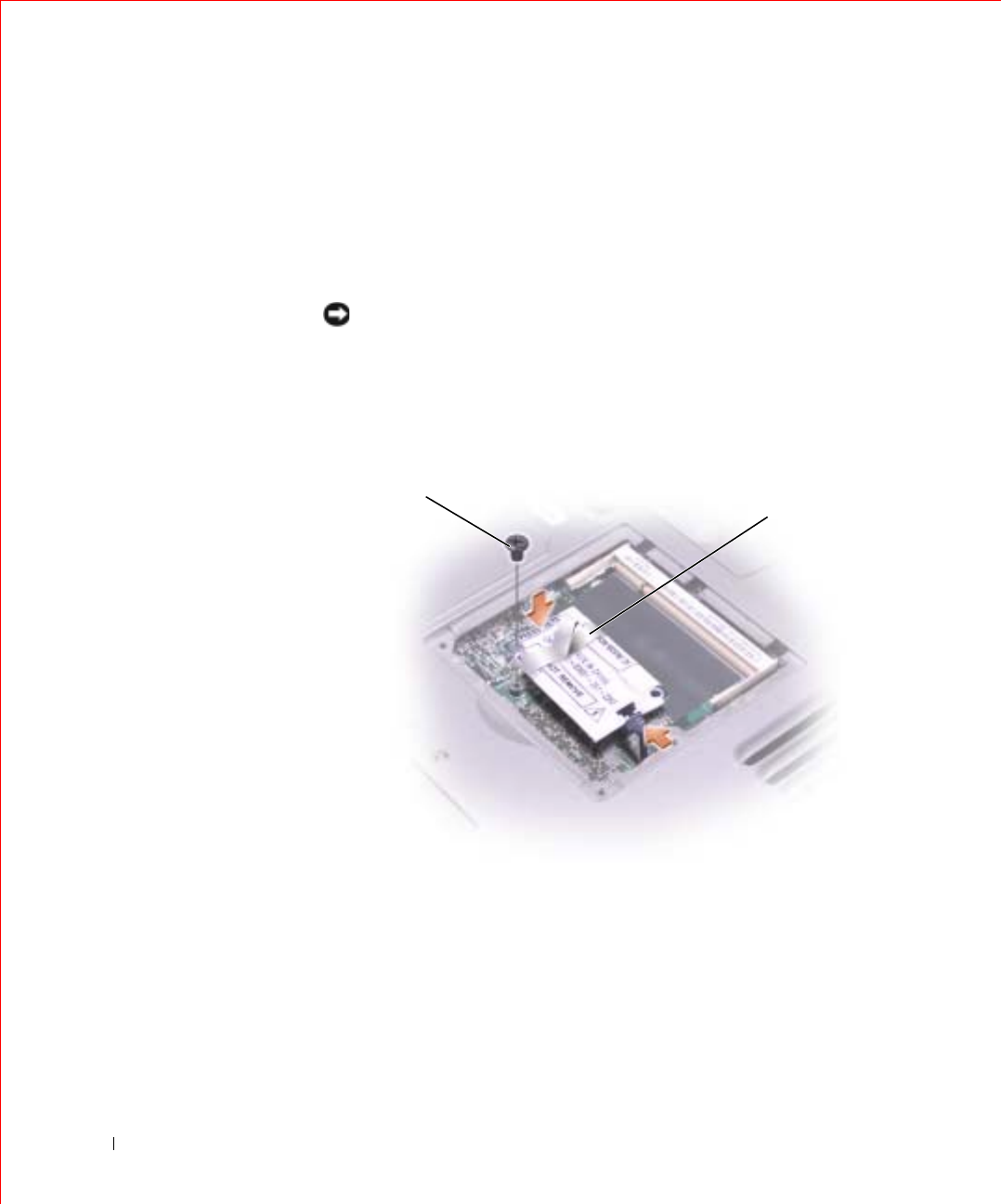
162 Adding and Replacing Parts
www.dell.com | support.dell.com
FILE LOCATION: S:\SYSTEMS\Pebble\UG\A00\English\r_r.fm
DELL CONFIDENTIAL – PRELIMINARY 1/29/03 – FOR PROOF ONLY
3If the computer is connected to a docking device (docked), undock it.
See the documentation that came with your docking device for
instructions.
4Disconnect the computer from the electrical outlet.
5Wait 10 to 20 seconds, and then disconnect any attached devices.
6Remove any installed PC Cards and the battery.
NOTICE: Handle components and cards by their edges, and avoid touching
pins and contacts. Ground yourself by touching a metal connector on the back
of the computer. Continue to ground yourself periodically during this
procedure.
7Turn the computer over, loosen the captive screws on the memory
module/modem cover, and then remove the cover.
8If a modem is not already installed, go to step 9. If you are replacing a
modem, remove the existing modem:
aRemove the screw securing the modem to the system board, and
set it aside.
bPull straight up on the attached pull-tab to lift the modem out of
its connector on the system board, and disconnect the modem
cable.
12

Adding and Replacing Parts 163
FILE LOCATION: S:\SYSTEMS\Pebble\UG\A00\English\r_r.fm
DELL CONFIDENTIAL – PRELIMINARY 1/29/03 – FOR PROOF ONLY
9Connect the modem cable to the modem.
NOTICE: The cable connectors are keyed for correct insertion; do not force
the connections.
10 Align the modem with the screw hole, and press the modem into the
connector on the system board.
11 Install the screw to secure the modem to the system board.
12 Replace the modem cover.
Replacing the Keyboard
CAUTION: Before working inside your computer, read the safety
instructions in your
System Information Guide
.
1Ensure that the work surface is flat and clean to prevent scratching the
computer cover.
2Save and close any open files, exit any open programs, and then shut
down the computer.
3If the computer is connected to a docking device (docked), undock it.
See the documentation that came with your docking device for
instructions.
4Disconnect the computer from the electrical outlet.
5Wait 10 to 20 seconds, and then disconnect any attached devices.
6Remove any installed PC Cards and the battery.
NOTICE: Handle components and cards by their edges, and avoid touching
pins and contacts. Ground yourself by touching a metal connector on the back
of the computer. Continue to ground yourself periodically during this
procedure.
7Open the display approximately 180 degrees.
8Use a small flat-blade screwdriver or plastic scribe to lift the notched
right edge of the center control cover, and pry the cover loose from the
bottom case.
9Remove the two screws from the top of the keyboard.
10 Use the pull tab to pull the keyboard up and out (towards the display)
of the bottom case.
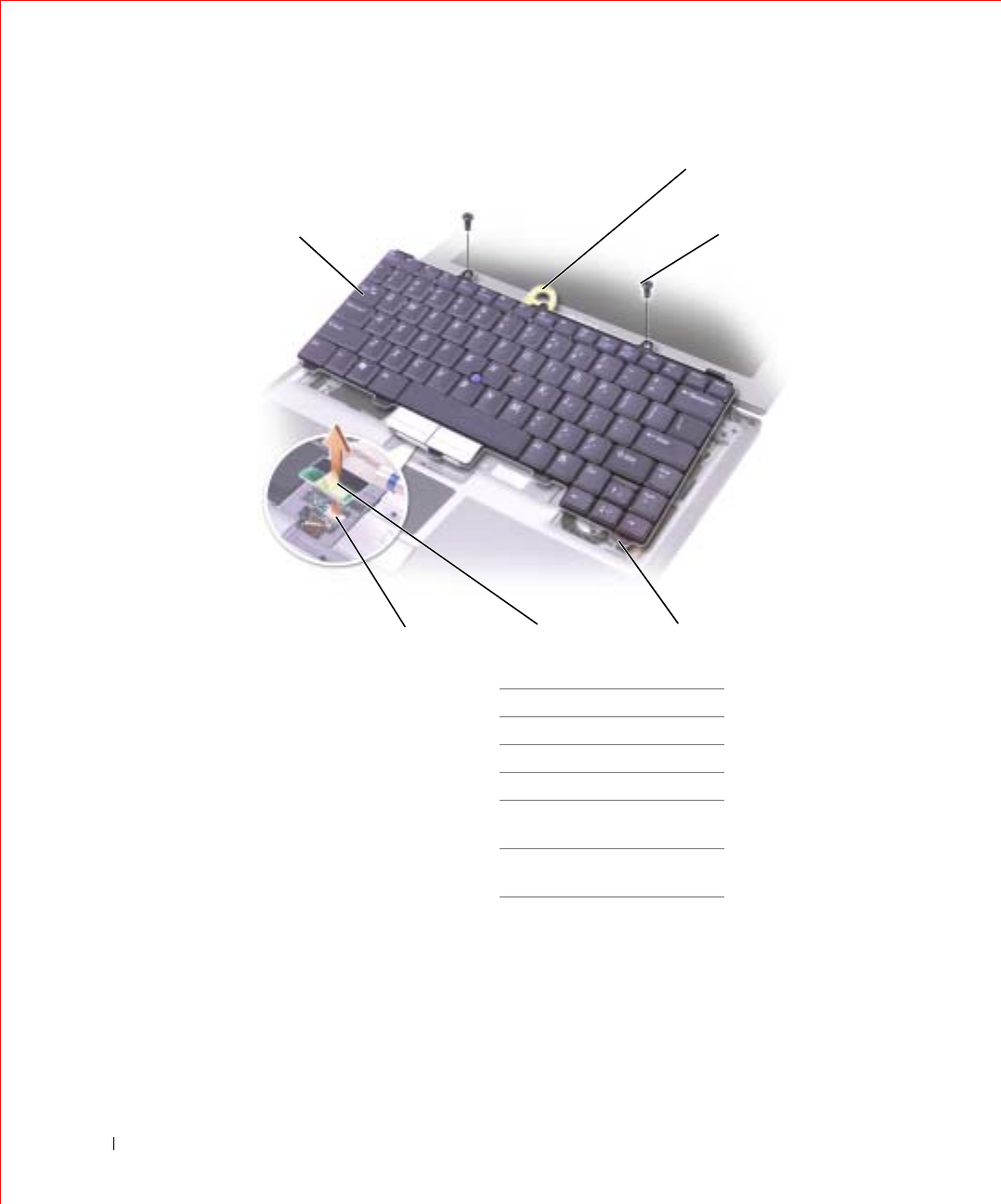
164 Adding and Replacing Parts
www.dell.com | support.dell.com
FILE LOCATION: S:\SYSTEMS\Pebble\UG\A00\English\r_r.fm
DELL CONFIDENTIAL – PRELIMINARY 1/29/03 – FOR PROOF ONLY
11 Rest the keyboard face down on the palm rest.
12 Pull straight up on the pull tab that is attached to the keyboard
connector to disconnect the connector from the interface connector
on the system board.
To replace the keyboard:
13
6
2
4
5
1keyboard
2keyboard pull tab
3screws (2)
4securing tabs (5)
5keyboard-connector pull
tab
6interface connector
(system board)

from the interface connector on the system board.
To replace the keyboard:
1. Connect the keyboard connector to the interface connector on the system board.
2. Insert the five securing tabs on the keyboard into their respective slots in the palm rest.
3. Replace the two screws at the top of the keyboard.
4. Replace the center control cover and snap it down so that it is flush with the palm rest.
Adding a Mini PCI Card
If you ordered a Mini PCI card with your computer, the card is already installed.
1. Ensure that the work surface is flat and clean to prevent scratching the computer cover.
2. Save and close any open files, exit any open programs, and then shut down the computer.
3. If the computer is connected to a docking device (docked), undock it. See the documentation that came
with your docking device for instructions.
4. Disconnect the computer from the electrical outlet.
5. Wait 10 to 20 seconds, and then disconnect any attached devices.
6. Remove any installed PC Cards and the battery.
7. Remove the keyboard.
8. If a Mini PCI card is not already installed, go to step 9. If you are replacing a Mini PCI card, remove the
existing card:
a. Disconnect the Mini PCI card from the attached cables.
CAUTION: FCC rules strictly prohibit users from installing new 5 GHz Wireless LAN Mini PCI
cards. Under no circumstances should the user install such a device. Only trained Dell service
personnel are authorized to dispatch an individual 5 GHz Mini PCI cards to a user for
replacement
If you are removing and/or installing a 2.4 GHz device, please follow the instructions noted
below. Only products approved for use in your portable computer may be installed. Approved
devices may be purchased only from Dell.
NOTE: 2.4 GHz and 5 GHz Wireless LAN PC Cards may be removed and installed by the user.
CAUTION: Before working inside your computer, read the safety instructions in your System
Information Guide.
NOTICE: Handle components and cards by their edges, and avoid touching pins and contacts. Ground
yourself by touching a metal connector on the back of the computer. Continue to ground yourself
periodically during this procedure.
Addin
g
and Re
p
lacin
g
Parts
6/2/2003
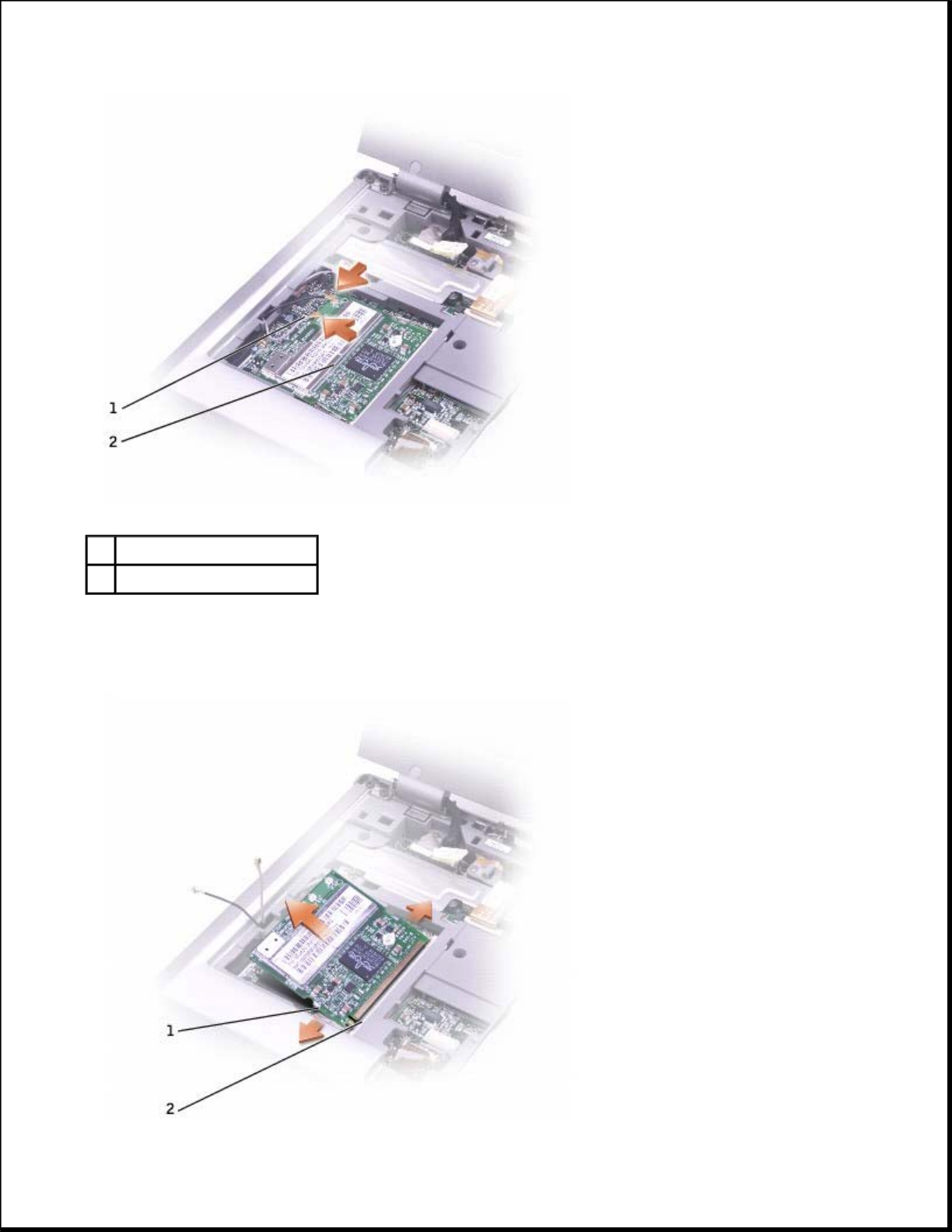
b. Release the Mini PCI card by spreading the metal securing tabs until the card pops up slightly.
c. Lift the Mini PCI card out of its connector.
1 antenna cables (2)
2 Mini PCI card
Addin
g
and Re
p
lacin
g
Parts
6/2/2003
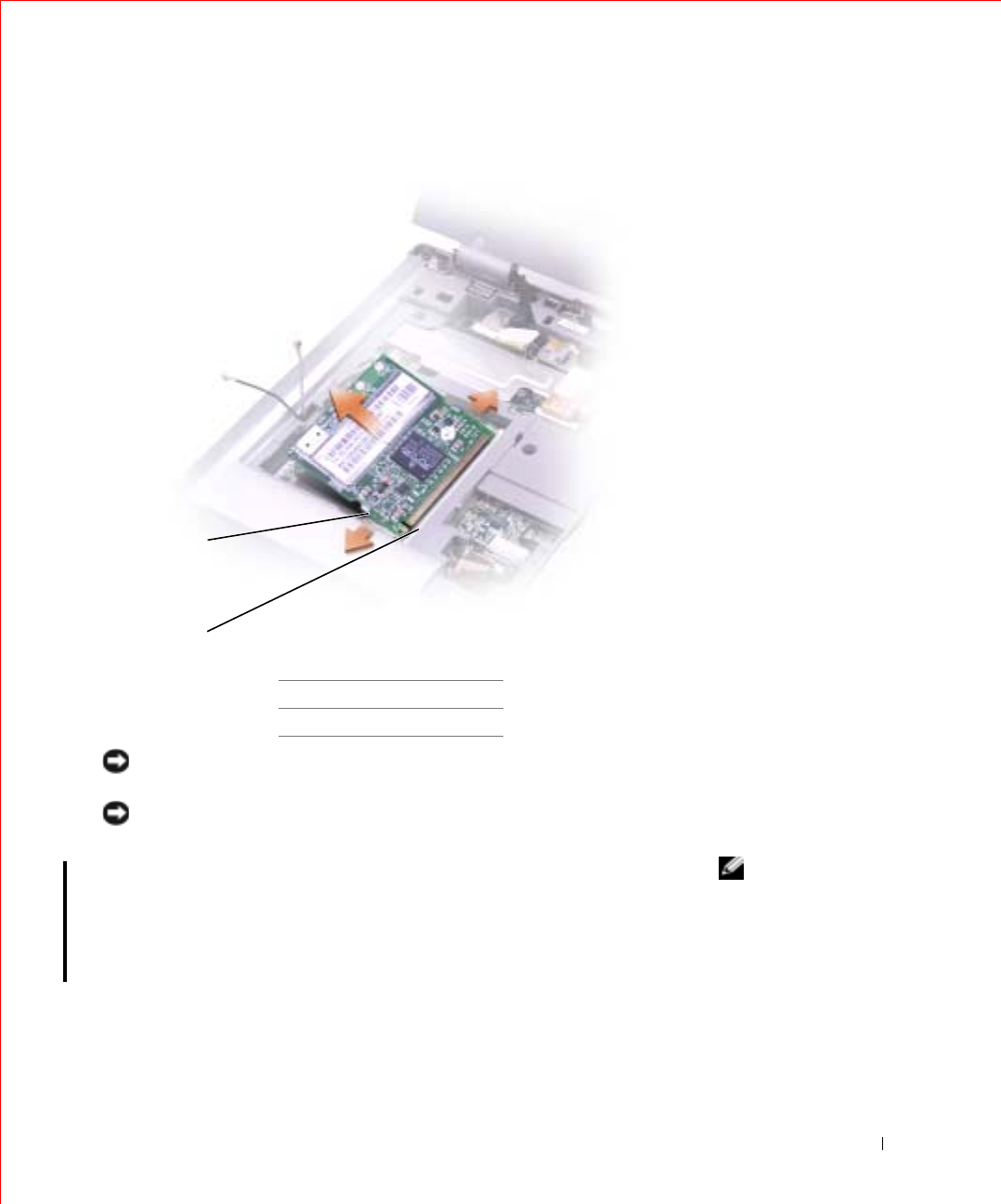
Adding and Replacing Parts 167
FILE LOCATION: S:\SYSTEMS\Pebble\UG\A00\English\r_r.fm
DELL CONFIDENTIAL – PRELIMINARY 1/29/03 – FOR PROOF ONLY
NOTICE: To avoid damaging the Mini PCI card, never place cables on top of
or under the card.
NOTICE: The connectors are keyed to ensure correct insertion. If you feel
resistance, check the connectors and realign the card.
NOTE: If a Mini PCI
card was not already
installed, remove the
foam that secures the
antenna cables before you
install the card.
9Align the Mini PCI card with the connector at a 45-degree angle, and
press the Mini PCI card into the connector until you feel a click.
10 Connect the antenna cables to the Mini PCI card.
11 Replace the keyboard.
1securing tabs(2)
2Mini PCI card connector
1
2

168 Adding and Replacing Parts
www.dell.com | support.dell.com
FILE LOCATION: S:\SYSTEMS\Pebble\UG\A00\English\r_r.fm
DELL CONFIDENTIAL – PRELIMINARY 1/29/03 – FOR PROOF ONLY
Replacing the Hard Drive
CAUTION: If you remove the hard drive from the computer when
the drive is warm,
do not touch
the metal housing of the hard
drive.
CAUTION: Before working inside your computer, read the safety
instructions in your
System Information Guide
.
NOTICE: To prevent data loss, turn off your computer before removing the
hard drive. Do not remove the hard drive while the computer is on, in standby
mode, or in hibernate mode.
NOTICE: Hard drives are extremely fragile; even a slight bump can damage
the drive.
NOTE: Dell does not
guarantee compatibility
or provide support for
hard drives from sources
other than Dell.
To replace the hard drive in the hard drive bay:
1Ensure that the work surface is flat and clean to prevent scratching the
computer cover.
2Save and close any open files, exit any open programs, and then shut
down the computer.
3If the computer is connected to a docking device (docked), undock it.
See the documentation that came with your docking device for
instructions.
4Disconnect the computer from the electrical outlet.
5Wait 10 to 20 seconds, and then disconnect any attached devices.
6Remove any installed PC Cards and the battery.
NOTICE: Handle components and cards by their edges, and avoid touching
pins and contacts. Ground yourself by touching a metal connector on the back
of the computer. Continue to ground yourself periodically during this
procedure.
7Turn the computer over, and remove the hard drive screws.
NOTICE: When the hard drive is not in the computer, store it in protective
antistatic packaging. See "Protecting Against Electrostatic Discharge" in your
System Information Guide
.
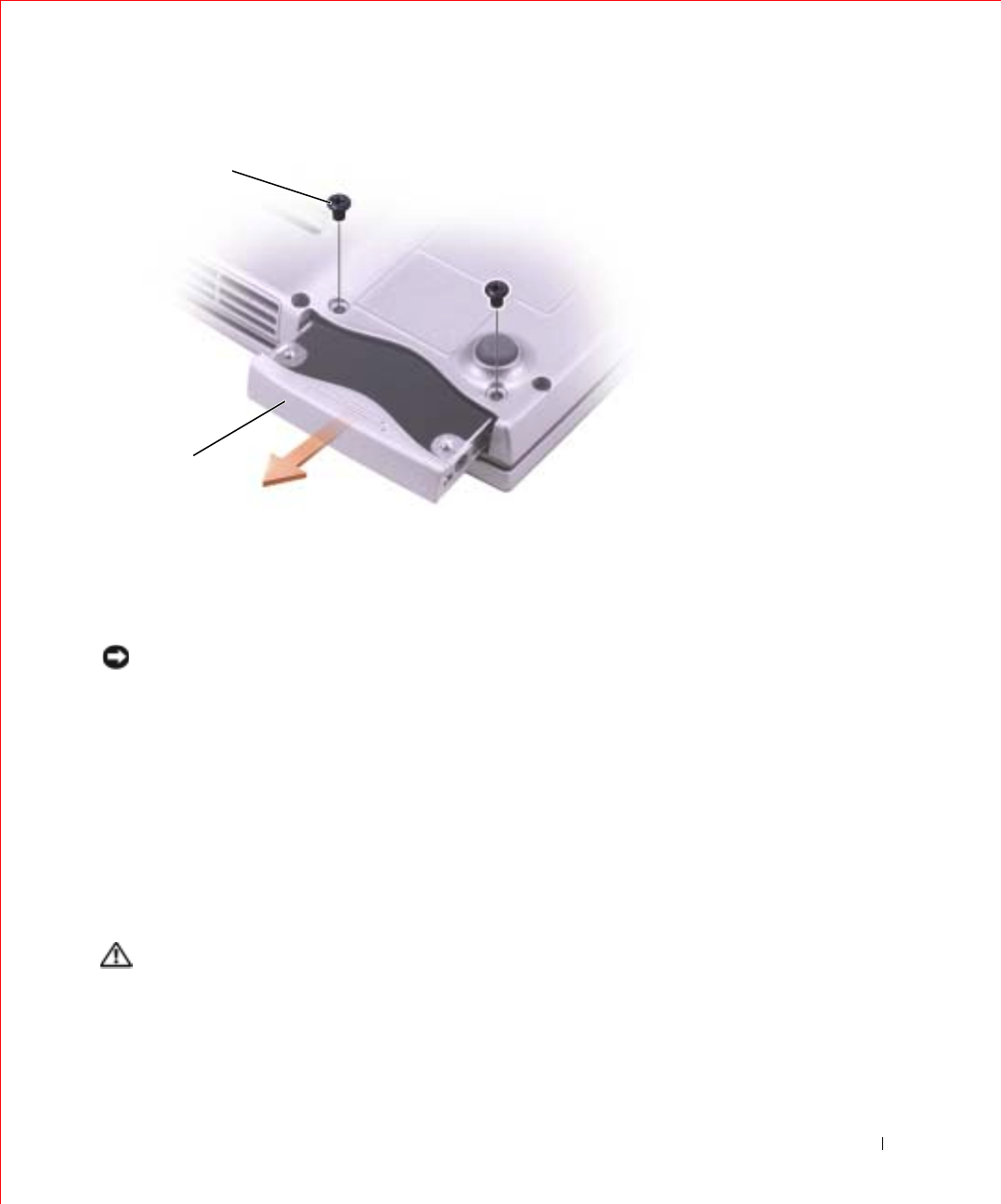
Adding and Replacing Parts 169
FILE LOCATION: S:\SYSTEMS\Pebble\UG\A00\English\r_r.fm
DELL CONFIDENTIAL – PRELIMINARY 1/29/03 – FOR PROOF ONLY
8Slide the hard drive out of the computer.
9Remove the new drive from its packaging.
Save the original packaging for storing or shipping the hard drive.
NOTICE: Use firm and even pressure to slide the drive into place. If you use
excessive force, you may damage the connector.
10 Slide the hard drive into the bay until it is fully seated.
11 Replace and tighten the screws.
12 Use the Operating System CD to install the operating system for your
computer.
13 Use the Drivers and Utilities CD to install the drivers and utilities for
your computer.
Adding a Bluetooth™ Module
CAUTION: Before working inside your computer, read the safety
instructions in your
System Information Guide
.
1Ensure that the work surface is flat and clean to prevent scratching the
computer cover.
1
2
Changed to "Replacing a
Bluetooth Module"
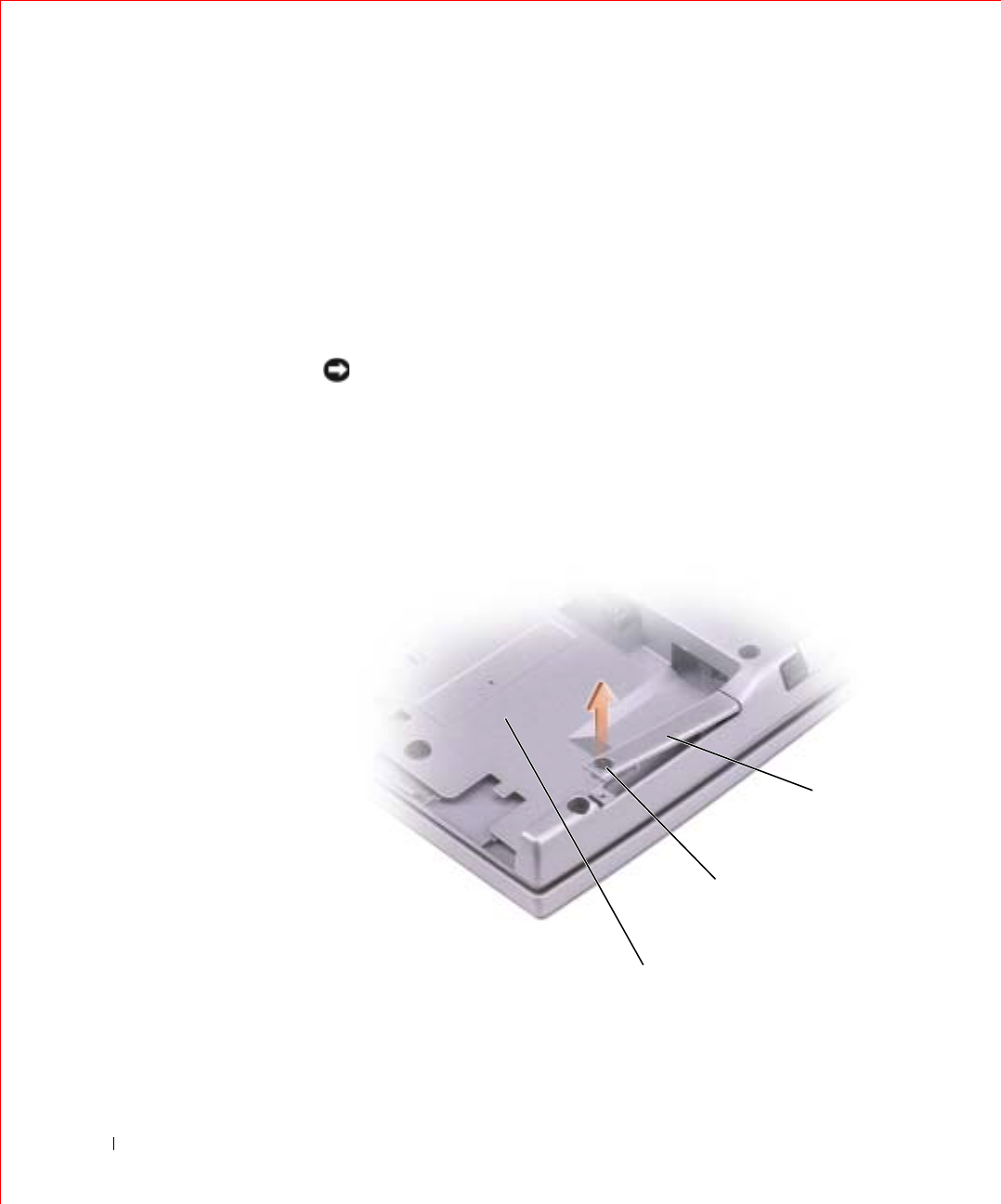
170 Adding and Replacing Parts
www.dell.com | support.dell.com
FILE LOCATION: S:\SYSTEMS\Pebble\UG\A00\English\r_r.fm
DELL CONFIDENTIAL – PRELIMINARY 1/29/03 – FOR PROOF ONLY
2Save and close any open files, exit any open programs, and then shut
down the computer.
3If the computer is connected to a docking device (docked), undock it.
See the documentation that came with your docking device for
instructions.
4Disconnect the computer from the electrical outlet.
5Wait 10 to 20 seconds, and then disconnect any attached devices.
6Remove any installed PC Cards and the battery.
NOTICE: Handle components and cards by their edges, and avoid touching
pins and contacts. Ground yourself by touching a metal connector on the back
of the computer. Continue to ground yourself periodically during this
procedure.
7Turn the computer overm, loosen the captive screw in the Bluetooth
module cover, and remove the cover.
1
2
3
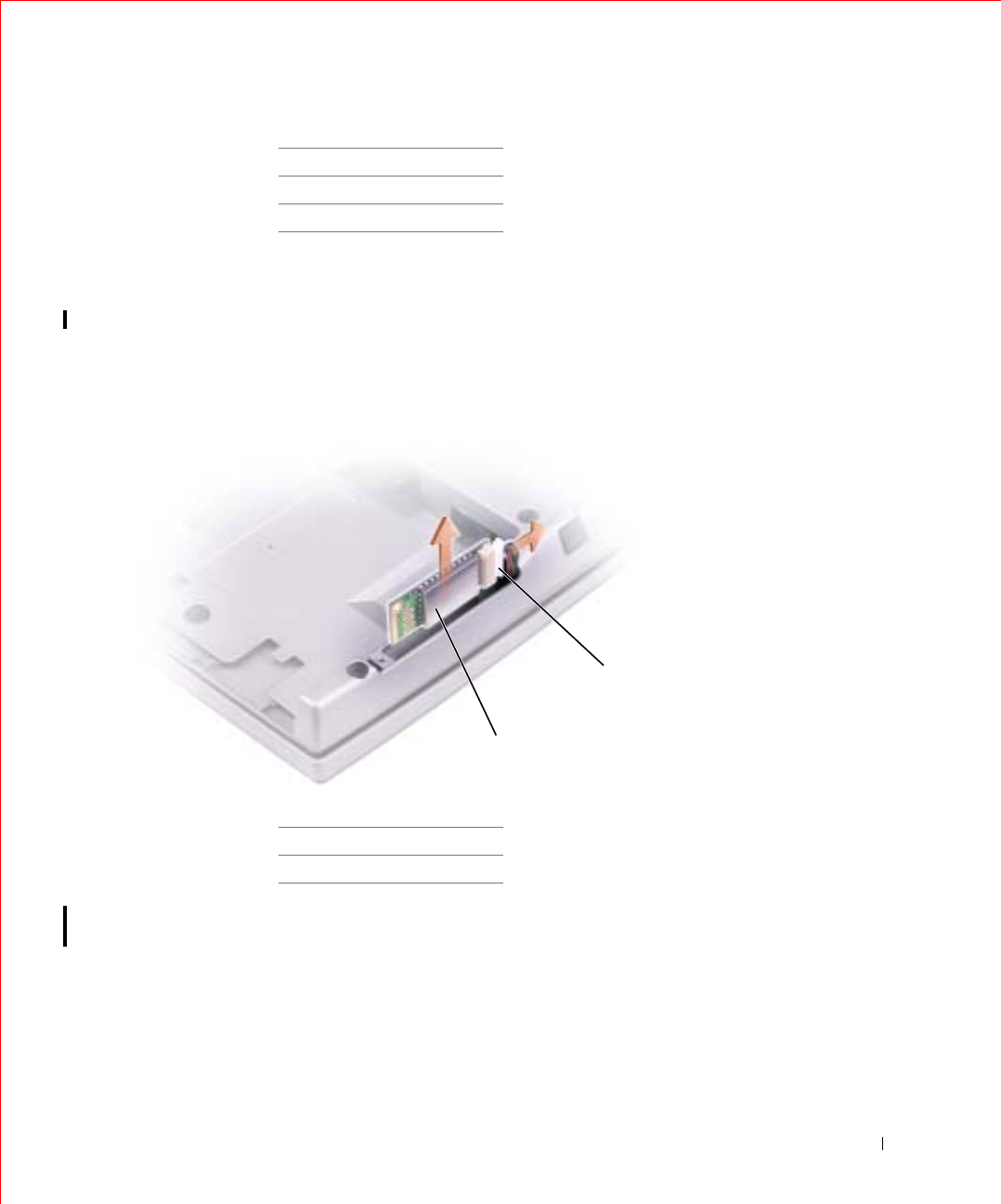
Adding and Replacing Parts 171
FILE LOCATION: S:\SYSTEMS\Pebble\UG\A00\English\r_r.fm
DELL CONFIDENTIAL – PRELIMINARY 1/29/03 – FOR PROOF ONLY
8If a Bluetooth module is not already installed, go to step 9. If you are
replacing the Bluetooth module, remove the existing module:
aPull the Bluetooth module out of the slot.
bDisconnect the cable from the module.
9Ensure that the front of the Bluetooth module (silver) is facing
outward, and connect the cable to the module.
10 Insert the module into the slot.
11 Replace the cover and tighten the captive screw.
1Bluetooth module cover
2captive screw
3battery bay
1Bluetooth cable
2Bluetooth module (front)
1
2

172 Adding and Replacing Parts
www.dell.com | support.dell.com
FILE LOCATION: S:\SYSTEMS\Pebble\UG\A00\English\r_r.fm
DELL CONFIDENTIAL – PRELIMINARY 1/29/03 – FOR PROOF ONLY

FILE LOCATION: S:\SYSTEMS\Pebble\UG\A00\English\setup.fm
DELL CONFIDENTIAL – PRELIMINARY 1/29/03 – FOR PROOF ONLY
19
SECTION 19
Using the System
Setup Program

174 Using the System Setup Program
www.dell.com | support.dell.com
FILE LOCATION: S:\SYSTEMS\Pebble\UG\A00\English\setup.fm
DELL CONFIDENTIAL – PRELIMINARY 1/29/03 – FOR PROOF ONLY
Overview
NOTE: Your operating
system may automatically
configure most of the
options available in the
system setup program,
thus overriding options
that you set through the
system setup program.
(An exception is the
External Hot Key option,
which you can disable or
enable only through the
system setup program.)
For more information on
configuring features for
your operating system,
see your Microsoft®
Windows®
Help
(Windows 2000) or the
Windows Help and
Support Center (Windows
XP).
You can use the system setup program as follows:
• To set or change user-selectable features—for example, your computer
password
• To verify information about the computer's current configuration,
such as the amount of system memory
After you set up the computer, run the system setup program to familiarize
yourself with your system configuration information and optional settings.
You may want to write down the information for future reference.
The system setup screens display the current setup information and settings
for your computer, such as:
• System configuration
•Boot order
• Boot (start-up) configuration and docking-device configuration
settings
• Basic device configuration settings
• System security and hard-drive password settings
NOTICE: Unless you are an expert computer user or are directed to do so by
Dell technical support, do not change the settings for the system setup
program. Certain changes might make your computer work incorrectly.
Viewing the System Setup Screens
1Turn on (or restart) your computer.
2When the DELL™ logo appears, press immediately. If you wait
too long and the Windows logo appears, continue to wait until you see
the Windows desktop. Then shut down your computer and try again.

Using the System Setup Program 175
FILE LOCATION: S:\SYSTEMS\Pebble\UG\A00\English\setup.fm
DELL CONFIDENTIAL – PRELIMINARY 1/29/03 – FOR PROOF ONLY
System Setup Screens
On each screen, the system setup options are listed at the left. To the right
of each option is the setting or value for that option. You can change
settings that appear as white type on the screen. Options or values that you
cannot change (because they are determined by the computer) appear as
blue text.
The upper-right corner of the screen displays help information for the
currently highlighted option; the lower-right corner displays information
about the computer. System setup key functions are listed across the
bottom of the screen.
Commonly Used Options
Certain options require that you reboot the computer for new settings to
take effect.
Changing the Boot Sequence
The boot sequence, or boot order, tells the computer where to look to find the
software needed to start the operating system. You can control the boot
sequence and enable/disable devices using the Boot Order page of the
system setup program.
NOTE: To change the
boot sequence on a one-
time-only basis, see
"Performing a One-Time
Boot."
The Boot Order page displays a general list of the bootable devices that may
be installed in your computer, including but not limited to the following:
•Diskette Drive
•Internal HDD
•CD/DVD/CD-RW drive
During the boot routine, the computer starts at the top of the list and scans
each enabled device for the operating system start-up files. When the
computer finds the files, it stops searching and starts the operating system.
To control the boot devices, select (highlight) a device by pressing the
or key, and then enable or disable the device or change its
order in the list.

176 Using the System Setup Program
www.dell.com | support.dell.com
FILE LOCATION: S:\SYSTEMS\Pebble\UG\A00\English\setup.fm
DELL CONFIDENTIAL – PRELIMINARY 1/29/03 – FOR PROOF ONLY
• To enable or disable a device, highlight the item and press
. Enabled items appear as white and display a small
triangle to the left; disabled items appear blue or dimmed without a
triangle.
• To reorder a device in the list, highlight the device and then press
or (not case-sensitive) to move the highlighted device up
or down.
Boot sequence changes take effect as soon as you save the changes and exit
the system setup program.
Performing a One-Time Boot
You can set a one-time-only boot sequence without entering the system
setup program. (You can also use this procedure to boot the Dell
Diagnostics on the diagnostics utility partition on your hard drive.)
1Turn off the computer.
2If the computer is connected to a docking device (docked), undock it.
See the documentation that came with your docking device for
instructions.
3Connect the computer to an electrical outlet.
4Turn on the computer. When the DELL logo appears, press
immediately. If you wait too long and the Windows logo appears,
continue to wait until you see the Windows desktop. Then shut down
your computer and try again.
5When the boot device list appears, highlight the device from which
you want to boot and press .
The computer boots to the selected device.
The next time you reboot the computer, the previous boot order is restored.
Changing COM Ports
Serial Port allows you to map the serial port COM address or disable the
serial port and its address, freeing computer resources for another device to
use.
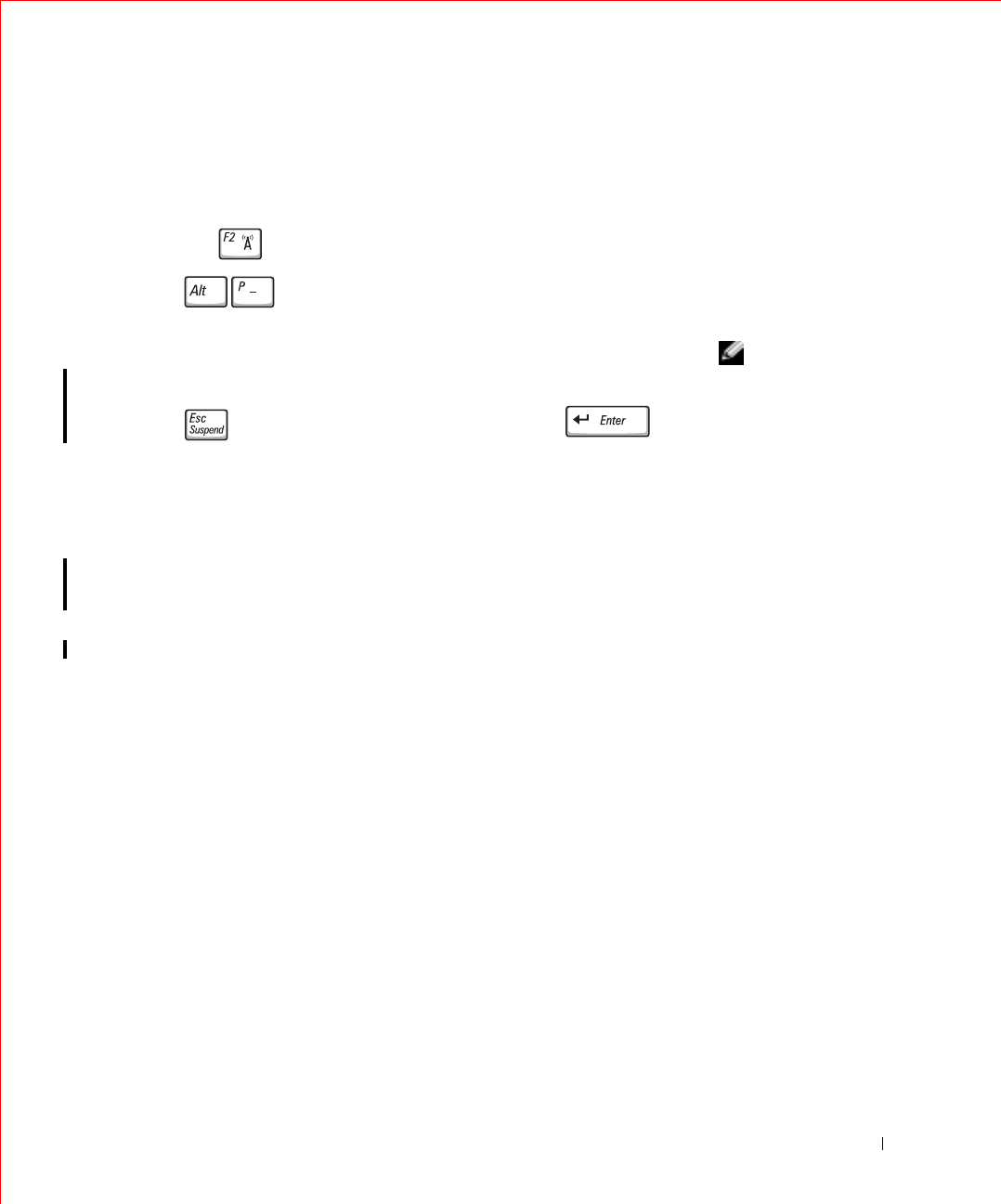
Using the System Setup Program 177
FILE LOCATION: S:\SYSTEMS\Pebble\UG\A00\English\setup.fm
DELL CONFIDENTIAL – PRELIMINARY 1/29/03 – FOR PROOF ONLY
Enabling the Infrared Sensor
1Enter the system setup program:
aTurn on your computer.
bPress when the DELL™ logo appears.
2Press until you locate Infrared Data Port under Basic
Device Configuration.
NOTE: Ensure that the
COM port that you select
is different from the COM
port assigned to the serial
connector.
3Press the down-arrow key to select the Infrared Data Port setting, and
press the right-arrow key to change the setting to a COM port.
4Press , select Save changes and reboot, and press to
save the changes and exit the system setup program. If you are
prompted to restart your computer, click Yes.
5Follow the instructions on the screen.
6After the infrared sensor has been enabled, click Yes to restart the
computer.
After you enable the infrared sensor, you can use it to establish a link to an
infrared device. To set up and use an infrared device, see the infrared device
documentation and the Windows Help and Support Center (Windows
Help in Windows 2000).

178 Using the System Setup Program
www.dell.com | support.dell.com
FILE LOCATION: S:\SYSTEMS\Pebble\UG\A00\English\setup.fm
DELL CONFIDENTIAL – PRELIMINARY 1/29/03 – FOR PROOF ONLY

FILE LOCATION: S:\SYSTEMS\Pebble\UG\A00\English\asf.fm
DELL CONFIDENTIAL – PRELIMINARY 1/29/03 – FOR PROOF ONLY
20
SECTION 20
Alert Standard Format
(ASF)

180 Alert Standard Format (ASF)
www.dell.com | support.dell.com
FILE LOCATION: S:\SYSTEMS\Pebble\UG\A00\English\asf.fm
DELL CONFIDENTIAL – PRELIMINARY 1/29/03 – FOR PROOF ONLY
Alert Standrard Format (ASF) is a Distributed Management Task Force
(DMTF) management standard that specifies "pre-operating system" or
"operating system absent" alerting techniques. The standard is designed to
generate an alert on potential security and fault conditions when the
operating system is in a sleep state or the system is turned off. ASF is
designed to supersede previous operating system-absent alerting
technologies.
Your computer supports the following ASF alerts and remote capabilities:
For more information about Dell's ASF implementation, see ASF for Dell
Portable Computers and the ASF Administrator's Guide for Dell Portable
Computers, which are available on the Dell Support website at
support.dell.com.
Alert Description
Chassis
Intrusion –
Physical
Security
Violation/Chass
is Intrusion –
Physical
Security
Violation Event
Cleared
The docking device has been opened and the PCI slot
has been compromised.
Failure to Boot
to BIOS The BIOS did not complete loading upon initiation.
System Password
Violation The system password is invalid (alert occurs after three
failed attempts).
Entity Presence Periodic heartbeats have been transmitted to verify
system presence.

FILE LOCATION: S:\SYSTEMS\Pebble\UG\A00\English\gethelp.fm
DELL CONFIDENTIAL – PRELIMINARY 1/29/03 – FOR PROOF ONLY
21
SECTION 21
Getting Help

182 Getting Help
www.dell.com | support.dell.com
FILE LOCATION: S:\SYSTEMS\Pebble\UG\A00\English\gethelp.fm
DELL CONFIDENTIAL – PRELIMINARY 1/29/03 – FOR PROOF ONLY
Technical Assistance
If you need help with a technical problem, Dell is ready to assist you.
CAUTION: If you need to remove the computer covers, first
disconnect the computer power and modem cables from all
electrical outlets.
1Complete the procedures in "Solving Problems."
2Run the Dell Diagnostics.
3Make a copy of the Diagnostics Checklist and fill it out.
4Use Dell's extensive suite of online services available at Dell Support
(support.dell.com) for help with installation and troubleshooting
procedures.
5If the preceding steps have not resolved the problem, contact Dell.
NOTE: Call technical support from a telephone near or at the computer so that
technical support can assist you with any necessary procedures.
NOTE: Dell's Express Service Code system may not be available in all countries.
When prompted by Dell's automated telephone system, enter your
Express Service Code to route the call directly to the proper support
personnel. If you do not have an Express Service Code, open the Dell
Accessories folder, double-click the Express Service Code icon, and
follow the directions.
For instructions on using the technical support service, see "Technical
Support Service."
NOTE: Some of the following services are not always available in all locations
outside the continental U.S. Call your local Dell representative for information on
availability.
Online Services
You can access Dell Support at support.dell.com. Select your region on the
WELCOME TO DELL SUPPORT page, and fill in the requested details
to access help tools and information.

Getting Help 183
FILE LOCATION: S:\SYSTEMS\Pebble\UG\A00\English\gethelp.fm
DELL CONFIDENTIAL – PRELIMINARY 1/29/03 – FOR PROOF ONLY
You can contact Dell electronically using the following addresses:
•World Wide Web
www.dell.com/
www.dell.com/ap/ (for Asian/Pacific countries only)
www.euro.dell.com (for Europe only)
www.dell.com/la/ (for Latin American countries)
• Anonymous file transfer protocol (FTP)
ftp.dell.com/
Log in as user: anonymous, and use your e-mail address as your
password.
• Electronic Support Service
mobile_support@us.dell.com
support@us.dell.com
apsupport@dell.com (for Asian/Pacific countries only)
support.euro.dell.com (for Europe only)
• Electronic Quote Service
sales@dell.com
apmarketing@dell.com (for Asian/Pacific countries only)
• Electronic Information Service
info@dell.com
AutoTech Service
Dell's automated technical support service—AutoTech—provides recorded
answers to the questions most frequently asked by Dell customers about
their portable and desktop computers.
When you call AutoTech, use your touch-tone telephone to select the
subjects that correspond to your questions.
The AutoTech service is available 24 hours a day, 7 days a week. You can also
access this service through the technical support service. For the telephone
number to call, see the contact numbers for your region.

184 Getting Help
www.dell.com | support.dell.com
FILE LOCATION: S:\SYSTEMS\Pebble\UG\A00\English\gethelp.fm
DELL CONFIDENTIAL – PRELIMINARY 1/29/03 – FOR PROOF ONLY
Automated Order-Status Service
To check on the status of any Dell products that you have ordered, you can
go to support.dell.com, or you can call the automated order-status service.
A recording prompts you for the information needed to locate and report on
your order. For the telephone number to call, see the contact numbers for
your region.
Technical Support Service
Dell's technical support service is available 24 hours a day, 7 days a week, to
answer your questions about Dell hardware. Our technical support staff uses
computer-based diagnostics to provide fast, accurate answers.
To contact Dell’s technical support service, see "Technical Assistance" and
then call the number for your country as listed in "Contacting Dell."
Problems With Your Order
If you have a problem with your order, such as missing parts, wrong parts, or
incorrect billing, contact Dell for customer assistance. Have your invoice or
packing slip handy when you call. For the telephone number to call, see the
contact numbers for your region.
Product Information
If you need information about additional products available from Dell, or if
you would like to place an order, visit the Dell website at www.dell.com. For
the telephone number to call to speak to a sales specialist, see the contact
numbers for your region.
Returning Items for Warranty Repair
or Credit
Prepare all items being returned, whether for repair or credit, as follows:
1Call Dell to obtain a Return Material Authorization Number, and
write it clearly and prominently on the outside of the box.

Getting Help 185
FILE LOCATION: S:\SYSTEMS\Pebble\UG\A00\English\gethelp.fm
DELL CONFIDENTIAL – PRELIMINARY 1/29/03 – FOR PROOF ONLY
For the telephone number to call, see the contact numbers for your
region.
2Include a copy of the invoice and a letter describing the reason for the
return.
3Include a copy of the Diagnostics Checklist indicating the tests you
have run and any error messages reported by the Dell Diagnostics.
4Include any accessories that belong with the item(s) being returned
(power cables, software floppy disks, guides, and so on) if the return is
for credit.
5Pack the equipment to be returned in the original (or equivalent)
packing materials.
You are responsible for paying shipping expenses. You are also responsible
for insuring any product returned, and you assume the risk of loss during
shipment to Dell. Collect On Delivery (C.O.D.) packages are not accepted.
Returns that are missing any of the preceding requirements will be refused
at Dell’s receiving dock and returned to you.
Before You Call
NOTE: Have your Express Service Code ready when you call. The code helps Dell’s
automated-support telephone system direct your call more efficiently.
Remember to fill out the Diagnostics Checklist. If possible, turn on your
computer before you call Dell for technical assistance and call from a
telephone at or near the computer. You may be asked to type some
commands at the keyboard, relay detailed information during operations, or
try other troubleshooting steps possible only at the computer itself. Ensure
that the computer documentation is available.
CAUTION: Before working inside your computer, read the safety
instructions in your
System Information
Guide
.

186 Getting Help
www.dell.com | support.dell.com
FILE LOCATION: S:\SYSTEMS\Pebble\UG\A00\English\gethelp.fm
DELL CONFIDENTIAL – PRELIMINARY 1/29/03 – FOR PROOF ONLY
Diagnostics Checklist
Name:
Date:
Address:
Phone number:
Service Tag (bar code on the back of the computer):
Express Service Code:
Return Material Authorization Number (if provided by Dell support technician):
Operating system and version:
Devices:
Expansion cards:
Are you connected to a network? Yes No
Network, version, and network adapter:
Programs and versions:
See your operating system documentation to determine the contents of the system’s start-up
files. If the computer is connected to a printer, print each file. Otherwise, record the contents
of each file before calling Dell.
Error message, beep code, or diagnostic code:
Description of problem and troubleshooting procedures you performed:

Getting Help 187
FILE LOCATION: S:\SYSTEMS\Pebble\UG\A00\English\gethelp.fm
DELL CONFIDENTIAL – PRELIMINARY 1/29/03 – FOR PROOF ONLY
Contacting Dell
To contact Dell electronically, you can access the following websites:
•www.dell.com
•support.dell.com (technical support)
•premiersupport.dell.com (technical support for educational,
government, healthcare, and medium/large business customers,
including Premier, Platinum, and Gold customers)
For specific web addresses for your country, find the appropriate country
section in the table below.
NOTE: Toll-free numbers are for use within the country for which they are listed.
When you need to contact Dell, use the electronic addresses, telephone
numbers, and codes provided in the following table. If you need assistance
in determining which codes to use, contact a local or an international
operator.
Country (City)
International Access Code
Country Code
City Code
Department Name or Service Area,
Website and E-Mail Address Area Codes,
Local Numbers, and
Toll-Free Numbers
Anguilla General Support toll-free: 800-335-0031
Antigua and Barbuda General Support 1-800-805-5924
Argentina (Buenos Aires)
International Access Code: 00
Country Code: 54
City Code: 11
Website: www.dell.com.ar
Tech Support and Customer Care toll-free: 0-800-444-0733
Sales 0-810-444-3355
Tech Support Fax 11 4515 7139
Customer Care Fax 11 4515 7138
Aruba General Support toll-free: 800-1578

188 Getting Help
www.dell.com | support.dell.com
FILE LOCATION: S:\SYSTEMS\Pebble\UG\A00\English\gethelp.fm
DELL CONFIDENTIAL – PRELIMINARY 1/29/03 – FOR PROOF ONLY
Australia (Sydney)
International Access Code: 0011
Country Code: 61
City Code: 2
E-mail (Australia): au_tech_support@dell.com
E-mail (New Zealand): nz_tech_support@dell.com
Home and Small Business 1-300-65-55-33
Government and Business toll-free: 1-800-633-559
Preferred Accounts Division (PAD) toll-free: 1-800-060-889
Customer Care toll-free: 1-800-819-339
Corporate Sales toll-free: 1-800-808-385
Transaction Sales toll-free: 1-800-808-312
Fax toll-free: 1-800-818-341
Austria (Vienna)
International Access Code: 900
Country Code: 43
City Code: 1
Website: support.euro.dell.com
E-mail: tech_support_central_europe@dell.com
Home/Small Business Sales 01 795 67602
Home/Small Business Fax 01 795 67605
Home/Small Business Customer Care 01 795 67603
Preferred Accounts/Corporate Customer Care 0660 8056
Home/Small Business Technical Support 01 795 67604
Preferred Accounts/Corporate Technical Support 0660 8779
Switchboard 01 491 04 0
Bahamas General Support toll-free: 1-866-278-6818
Barbados General Support 1-800-534-3066
Belgium (Brussels)
International Access Code: 00
Country Code: 32
City Code: 2
Website: support.euro.dell.com
E-mail: tech_be@dell.com
E-mail for French Speaking Customers:
support.euro.dell.com/be/fr/emaildell/
Technical Support 02 481 92 88
Customer Care 02 481 91 19
Home/Small Business Sales toll-free: 0800 16884
Corporate Sales 02 481 91 00
Fax 02 481 92 99
Switchboard 02 481 91 00
Country (City)
International Access Code
Country Code
City Code
Department Name or Service Area,
Website and E-Mail Address Area Codes,
Local Numbers, and
Toll-Free Numbers

Getting Help 189
FILE LOCATION: S:\SYSTEMS\Pebble\UG\A00\English\gethelp.fm
DELL CONFIDENTIAL – PRELIMINARY 1/29/03 – FOR PROOF ONLY
Bermuda General Support 1-800-342-0671
Bolivia General Support toll-free: 800-10-0238
Brazil
International Access Code: 00
Country Code: 55
City Code: 51
Website: www.dell.com/br
Customer Support, Technical Support 0800 90 3355
Tech Support Fax 51 481 5470
Customer Care Fax 51 481 5480
Sales 0800 90 3390
British Virgin Islands General Support toll-free: 1-866-278-6820
Brunei
Country Code: 673 Customer Technical Support (Penang, Malaysia) 604 633 4966
Customer Service (Penang, Malaysia) 604 633 4949
Transaction Sales (Penang, Malaysia) 604 633 4955
Canada (North York, Ontario)
International Access Code: 011 Automated Order-Status System toll-free: 1-800-433-9014
AutoTech (automated technical support) toll-free: 1-800-247-9362
TechFax toll-free: 1-800-950-1329
Customer Care (home/small business) toll-free: 1-800-847-4096
Customer Care (med./large business, government) toll-free: 1-800-326-9463
Technical Support (home/small business) toll-free: 1-800-847-4096
Technical Support (med./large bus., government) toll-free: 1-800-847-4096
Sales (direct sales—from outside Toronto) toll-free: 1-800-387-5752
Sales (direct sales—from within Toronto) 416 758-2200
Sales (federal government, education, and medical) toll-free: 1-800-567-7542
Cayman Islands General Support 1-800-805-7541
Chile (Santiago)
Country Code: 56
City Code: 2
Sales, Customer Support, and Technical Support toll-free: 1230-020-4823
Country (City)
International Access Code
Country Code
City Code
Department Name or Service Area,
Website and E-Mail Address Area Codes,
Local Numbers, and
Toll-Free Numbers

190 Getting Help
www.dell.com | support.dell.com
FILE LOCATION: S:\SYSTEMS\Pebble\UG\A00\English\gethelp.fm
DELL CONFIDENTIAL – PRELIMINARY 1/29/03 – FOR PROOF ONLY
China (Xiamen)
Country Code: 86
City Code: 592
Tech Support website: support.ap.dell.com/china
Tech Support E-mail: cn_support@dell.com
Tech Support Fax 818 1350
Home and Small Business Technical Support toll-free: 800 858 2437
Corporate Accounts Technical Support toll-free: 800 858 2333
Customer Experience toll-free: 800 858 2060
Home and Small Business toll-free: 800 858 2222
Preferred Accounts Division toll-free: 800 858 2062
Large Corporate Accounts GCP toll-free: 800 858 2055
Large Corporate Accounts Key Accounts toll-free: 800 858 2628
Large Corporate Accounts North toll-free: 800 858 2999
Large Corporate Accounts North Government and
Education toll-free: 800 858 2955
Large Corporate Accounts East toll-free: 800 858 2020
Large Corporate Accounts East Government and
Education toll-free: 800 858 2669
Large Corporate Accounts Queue Team toll-free: 800 858 2572
Large Corporate Accounts South toll-free: 800 858 2355
Large Corporate Accounts West toll-free: 800 858 2811
Large Corporate Accounts Spare Parts toll-free: 800 858 2621
Colombia General Support 980-9-15-3978
Costa Rica General Support 0800-012-0435
Czech Republic (Prague)
International Access Code: 00
Country Code: 420
City Code: 2
Website: support.euro.dell.com
E-mail: czech_dell@dell.com
Technical Support 02 22 83 27 27
Customer Care 02 22 83 27 11
Fax 02 22 83 27 14
TechFax 02 22 83 27 28
Switchboard 02 22 83 27 11
Country (City)
International Access Code
Country Code
City Code
Department Name or Service Area,
Website and E-Mail Address Area Codes,
Local Numbers, and
Toll-Free Numbers

Getting Help 191
FILE LOCATION: S:\SYSTEMS\Pebble\UG\A00\English\gethelp.fm
DELL CONFIDENTIAL – PRELIMINARY 1/29/03 – FOR PROOF ONLY
Denmark (Copenhagen)
International Access Code: 00
Country Code: 45
Website: support.euro.dell.com
E-mail Support (portable computers):
den_nbk_support@dell.com
E-mail Support (desktop computers):
den_support@dell.com
E-mail Support (servers):
Nordic_server_support@dell.com
Technical Support 7023 0182
Customer Care (Relational) 7023 0184
Home/Small Business Customer Care 3287 5505
Switchboard (Relational) 3287 1200
Fax Switchboard (Relational) 3287 1201
Switchboard (Home/Small Business) 3287 5000
Fax Switchboard (Home/Small Business) 3287 5001
Dominica General Support toll-free: 1-866-278-6821
Dominican Republic General Support 1-800-148-0530
Ecuador General Support toll-free: 999-119
El Salvador General Support 01-899-753-0777
Finland (Helsinki)
International Access Code: 990
Country Code: 358
City Code: 9
Website: support.euro.dell.com
E-mail: fin_support@dell.com
E-mail Support (servers):
Nordic_support@dell.com
Technical Support 09 253 313 60
Technical Support Fax 09 253 313 81
Relational Customer Care 09 253 313 38
Home/Small Business Customer Care 09 693 791 94
Fax 09 253 313 99
Switchboard 09 253 313 00
Country (City)
International Access Code
Country Code
City Code
Department Name or Service Area,
Website and E-Mail Address Area Codes,
Local Numbers, and
Toll-Free Numbers

192 Getting Help
www.dell.com | support.dell.com
FILE LOCATION: S:\SYSTEMS\Pebble\UG\A00\English\gethelp.fm
DELL CONFIDENTIAL – PRELIMINARY 1/29/03 – FOR PROOF ONLY
France (Paris) (Montpellier)
International Access Code: 00
Country Code: 33
City Codes: (1) (4)
Website: support.euro.dell.com
E-mail: support.euro.dell.com/fr/fr/emaildell/
Home and Small Business
Technical Support 0825 387 270
Customer Care 0825 823 833
Switchboard 0825 004 700
Switchboard (calls from outside of France) 04 99 75 40 00
Sales 0825 004 700
Fax 0825 004 701
Fax (calls from outside of France) 04 99 75 40 01
Corporate
Technical Support 0825 004 719
Customer Care 0825 338 339
Switchboard 0155947100
Sales 0155947100
Fax 0155947101
Germany (Langen)
International Access Code: 00
Country Code: 49
City Code: 6103
Website: support.euro.dell.com
E-mail: tech_support_central_europe@dell.com
Technical Support 06103 766-7200
Home/Small Business Customer Care 0180-5-224400
Global Segment Customer Care 06103 766-9570
Preferred Accounts Customer Care 06103 766-9420
Large Accounts Customer Care 06103 766-9560
Public Accounts Customer Care 06103 766-9555
Switchboard 06103 766-7000
Grenada General Support toll-free: 1-866-540-3355
Guatemala General Support 1-800-999-0136
Guyana General Support toll-free: 1-877-270-4609
Country (City)
International Access Code
Country Code
City Code
Department Name or Service Area,
Website and E-Mail Address Area Codes,
Local Numbers, and
Toll-Free Numbers

Getting Help 193
FILE LOCATION: S:\SYSTEMS\Pebble\UG\A00\English\gethelp.fm
DELL CONFIDENTIAL – PRELIMINARY 1/29/03 – FOR PROOF ONLY
Hong Kong
International Access Code: 001
Country Code: 852
Technical Support (Dimension™ and Inspiron™) 296 93188
Technical Support (OptiPlex™, Latitude™, and
Dell Precision™) 296 93191
Customer Service (non-technical, post-sales issues) 800 93 8291
Transaction Sales toll-free: 800 96 4109
Large Corporate Accounts HK toll-free: 800 96 4108
Large Corporate Accounts GCP HK toll-free: 800 90 3708
India Technical Support 1600 33 8045
Sales 1600 33 8044
Ireland (Cherrywood)
International Access Code: 16
Country Code: 353
City Code: 1
Website: support.euro.dell.com
E-mail: dell_direct_support@dell.com
Ireland Technical Support 1850 543 543
U.K. Technical Support (dial within U.K. only) 0870 908 0800
Home User Customer Care 01 204 4095
Small Business Customer Care 01 204 4444
U.K. Customer Care (dial within U.K. only) 0870 906 0010
Corporate Customer Care 01 204 4003
Ireland Sales 01 204 4444
U.K. Sales (dial within U.K. only) 0870 907 4000
SalesFax 01 204 0144
Fax 01 204 5960
Switchboard 01 204 4444
Country (City)
International Access Code
Country Code
City Code
Department Name or Service Area,
Website and E-Mail Address Area Codes,
Local Numbers, and
Toll-Free Numbers

194 Getting Help
www.dell.com | support.dell.com
FILE LOCATION: S:\SYSTEMS\Pebble\UG\A00\English\gethelp.fm
DELL CONFIDENTIAL – PRELIMINARY 1/29/03 – FOR PROOF ONLY
Italy (Milan)
International Access Code: 00
Country Code: 39
City Code: 02
Website: support.euro.dell.com
E-mail: support.euro.dell.com/it/it/emaildell/
Home and Small Business
Technical Support 02 577 826 90
Customer Care 02 696 821 14
Fax 02 696 821 13
Switchboard 02 696 821 12
Corporate
Technical Support 02 577 826 90
Customer Care 02 577 825 55
Fax 02 575 035 30
Switchboard 02 577 821
Jamaica General Support (dial from within Jamaica only) 1-800-682-3639
Country (City)
International Access Code
Country Code
City Code
Department Name or Service Area,
Website and E-Mail Address Area Codes,
Local Numbers, and
Toll-Free Numbers

Getting Help 195
FILE LOCATION: S:\SYSTEMS\Pebble\UG\A00\English\gethelp.fm
DELL CONFIDENTIAL – PRELIMINARY 1/29/03 – FOR PROOF ONLY
Japan (Kawasaki)
International Access Code: 001
Country Code: 81
City Code: 44
Website: support.jp.dell.com
Technical Support (servers) toll-free: 0120-198-498
Technical Support outside of Japan (servers) 81-44-556-4162
Technical Support (Dimension™ and Inspiron™) toll-free: 0120-198-226
Technical Support outside of Japan (Dimension and
Inspiron) 81-44-520-1435
Technical Support (Dell Precision™, OptiPlex™,
and Latitude™) toll-free:0120-198-433
Technical Support outside of Japan (Dell Precision,
OptiPlex, and Latitude) 81-44-556-3894
24-Hour Automated Order Service 044-556-3801
Customer Care 044-556-4240
Business Sales Division (up to 400 employees) 044-556-1465
Preferred Accounts Division Sales (over 400
employees) 044-556-3433
Large Corporate Accounts Sales (over 3500
employees) 044-556-3430
Public Sales (government agencies, educational
institutions, and medical institutions) 044-556-1469
Global Segment Japan 044-556-3469
Individual User 044-556-1760
Faxbox Service 044-556-3490
Switchboard 044-556-4300
Korea (Seoul)
International Access Code: 001
Country Code: 82
City Code: 2
Technical Support toll-free: 080-200-3800
Sales toll-free: 080-200-3600
Customer Service (Seoul, Korea) toll-free: 080-200-3800
Customer Service (Penang, Malaysia) 604 633 4949
Fax 2194-6202
Switchboard 2194-6000
Country (City)
International Access Code
Country Code
City Code
Department Name or Service Area,
Website and E-Mail Address Area Codes,
Local Numbers, and
Toll-Free Numbers

196 Getting Help
www.dell.com | support.dell.com
FILE LOCATION: S:\SYSTEMS\Pebble\UG\A00\English\gethelp.fm
DELL CONFIDENTIAL – PRELIMINARY 1/29/03 – FOR PROOF ONLY
Latin America Customer Technical Support (Austin, Texas,
U.S.A.) 512 728-4093
Customer Service (Austin, Texas, U.S.A.) 512 728-3619
Fax (Technical Support and Customer Service)
(Austin, Texas, U.S.A.) 512 728-3883
Sales (Austin, Texas, U.S.A.) 512 728-4397
SalesFax (Austin, Texas, U.S.A.) 512 728-4600
or 512 728-3772
Luxembourg
International Access Code: 00
Country Code: 352
Website: support.euro.dell.com
E-mail: tech_be@dell.com
Technical Support (Brussels, Belgium) 02 481 92 88
Home/Small Business Sales (Brussels, Belgium) toll-free: 080016884
Corporate Sales (Brussels, Belgium) 02 481 91 00
Customer Care (Brussels, Belgium) 02 481 91 19
Fax (Brussels, Belgium) 02 481 92 99
Switchboard (Brussels, Belgium) 02 481 91 00
Macao
Country Code: 853 Technical Support toll-free: 0800 582
Customer Service (Penang, Malaysia) 604 633 4949
Transaction Sales toll-free: 0800 581
Malaysia (Penang)
International Access Code: 00
Country Code: 60
City Code: 4
Technical Support toll-free: 1 800 888 298
Customer Service 04 633 4949
Transaction Sales toll-free: 1 800 888 202
Corporate Sales toll-free: 1 800 888 213
Country (City)
International Access Code
Country Code
City Code
Department Name or Service Area,
Website and E-Mail Address Area Codes,
Local Numbers, and
Toll-Free Numbers

Getting Help 197
FILE LOCATION: S:\SYSTEMS\Pebble\UG\A00\English\gethelp.fm
DELL CONFIDENTIAL – PRELIMINARY 1/29/03 – FOR PROOF ONLY
Mexico
International Access Code: 00
Country Code: 52
Customer Technical Support 001-877-384-8979
or 001-877-269-3383
Sales 50-81-8800
or 01-800-888-3355
Customer Service 001-877-384-8979
or 001-877-269-3383
Main 50-81-8800
or 01-800-888-3355
Montserrat General Support toll-free: 1-866-278-6822
Netherlands Antilles General Support 001-800-882-1519
Netherlands (Amsterdam)
International Access Code: 00
Country Code: 31
City Code: 20
Website: support.euro.dell.com
E-mail (Technical Support):
(Enterprise): nl_server_support@dell.com
(Latitude): nl_latitude_support@dell.com
(Inspiron): nl_inspiron_support@dell.com
(Dimension): nl_dimension_support@dell.com
(OptiPlex): nl_optiplex_support@dell.com
(Dell Precision): nl_workstation_support@dell.com
Technical Support 020 674 45 00
Technical Support Fax 020 674 47 66
Home/Small Business Customer Care 020 674 42 00
Relational Customer Care 020 674 4325
Home/Small Business Sales 020 674 55 00
Relational Sales 020 674 50 00
Home/Small Business Sales Fax 020 674 47 75
Relational Sales Fax 020 674 47 50
Switchboard 020 674 50 00
Switchboard Fax 020 674 47 50
Country (City)
International Access Code
Country Code
City Code
Department Name or Service Area,
Website and E-Mail Address Area Codes,
Local Numbers, and
Toll-Free Numbers

198 Getting Help
www.dell.com | support.dell.com
FILE LOCATION: S:\SYSTEMS\Pebble\UG\A00\English\gethelp.fm
DELL CONFIDENTIAL – PRELIMINARY 1/29/03 – FOR PROOF ONLY
New Zealand
International Access Code: 00
Country Code: 64
E-mail (New Zealand): nz_tech_support@dell.com
E-mail (Australia): au_tech_support@dell.com
Home and Small Business 0800 446 255
Government and Business 0800 444 617
Sales 0800 441 567
Fax 0800 441 566
Nicaragua General Support 001-800-220-1006
Norway (Lysaker)
International Access Code: 00
Country Code: 47
Website: support.euro.dell.com
E-mail Support (portable computers):
nor_nbk_support@dell.com
E-mail Support (desktop computers):
nor_support@dell.com
E-mail Support (servers):
nordic_server_support@dell.com
Technical Support 671 16882
Relational Customer Care 671 17514
Home/Small Business Customer Care 23162298
Switchboard 671 16800
Fax Switchboard 671 16865
Panama General Support 001-800-507-0962
Peru General Support 0800-50-669
Poland (Warsaw)
International Access Code: 011
Country Code: 48
City Code: 22
Website: support.euro.dell.com
E-mail: pl_support@dell.com
Customer Service Phone 57 95 700
Customer Care 57 95 999
Sales 57 95 999
Customer Service Fax 57 95 806
Reception Desk Fax 57 95 998
Switchboard 57 95 999
Country (City)
International Access Code
Country Code
City Code
Department Name or Service Area,
Website and E-Mail Address Area Codes,
Local Numbers, and
Toll-Free Numbers

Getting Help 199
FILE LOCATION: S:\SYSTEMS\Pebble\UG\A00\English\gethelp.fm
DELL CONFIDENTIAL – PRELIMINARY 1/29/03 – FOR PROOF ONLY
Portugal
International Access Code: 00
Country Code: 35
E-mail: support.euro.dell.com/es/es/emaildell/
Technical Support 800 834 077
Customer Care 800 300 415 or
800 834 075
Sales 800 300 410 or 800 300 411 or
800 300 412 or 121 422 07 10
Fax 121 424 01 12
Puerto Rico General Support 1-800-805-7545
St. Kitts and Nevis General Support toll-free: 1-877-441-4731
St. Lucia General Support 1-800-882-1521
St. Vincent and the Grenadines General Support toll-free: 1-877-270-4609
Singapore (Singapore)
International Access Code: 005
Country Code: 65
Technical Support toll-free: 800 6011 051
Customer Service (Penang, Malaysia) 604 633 4949
Transaction Sales toll-free: 800 6011 054
Corporate Sales toll-free: 800 6011 053
South Africa (Johannesburg)
International Access Code:
09/091
Country Code: 27
City Code: 11
Website: support.euro.dell.com
E-mail: dell_za_support@dell.com
Technical Support 011 709 7710
Customer Care 011 709 7707
Sales 011 709 7700
Fax 011 706 0495
Switchboard 011 709 7700
Southeast Asian and Pacific
Countries Customer Technical Support, Customer Service,
and Sales (Penang, Malaysia) 604 633 4810
Country (City)
International Access Code
Country Code
City Code
Department Name or Service Area,
Website and E-Mail Address Area Codes,
Local Numbers, and
Toll-Free Numbers

200 Getting Help
www.dell.com | support.dell.com
FILE LOCATION: S:\SYSTEMS\Pebble\UG\A00\English\gethelp.fm
DELL CONFIDENTIAL – PRELIMINARY 1/29/03 – FOR PROOF ONLY
Spain (Madrid)
International Access Code: 00
Country Code: 34
City Code: 91
Website: support.euro.dell.com
E-mail: support.euro.dell.com/es/es/emaildell/
Home and Small Business
Technical Support 902 100 130
Customer Care 902 118 540
Sales 902 118 541
Switchboard 902 118 541
Fax 902 118 539
Corporate
Technical Support 902 100 130
Customer Care 902 118 546
Switchboard 91 722 92 00
Fax 91 722 95 83
Sweden (Upplands Vasby)
International Access Code: 00
Country Code: 46
City Code: 8
Website: support.euro.dell.com
E-mail: swe_support@dell.com
E-mail Support for Latitude and Inspiron:
Swe-nbk_kats@dell.com
E-mail Support for OptiPlex: Swe_kats@dell.com
E-mail Support for Servers:
Nordic_server_support@dell.com
Technical Support 08 590 05 199
Relational Customer Care 08 590 05 642
Home/Small Business Customer Care 08 587 70 527
Employee Purchase Program (EPP) Support 20 140 14 44
Fax Technical Support 08 590 05 594
Sales 08 590 05 185
Country (City)
International Access Code
Country Code
City Code
Department Name or Service Area,
Website and E-Mail Address Area Codes,
Local Numbers, and
Toll-Free Numbers

Getting Help 201
FILE LOCATION: S:\SYSTEMS\Pebble\UG\A00\English\gethelp.fm
DELL CONFIDENTIAL – PRELIMINARY 1/29/03 – FOR PROOF ONLY
Switzerland (Geneva)
International Access Code: 00
Country Code: 41
City Code: 22
Website: support.euro.dell.com
E-mail: swisstech@dell.com
E-mail for French-speaking HSB and Corporate
Customers: support.euro.dell.com/ch/fr/emaildell/
Technical Support (Home and Small Business) 0844 811 411
Technical Support (Corporate) 0844 822 844
Customer Care (Home and Small Business) 0848 802 202
Customer Care (Corporate) 0848 821 721
Fax 022 799 01 90
Switchboard 022 799 01 01
Taiwan
International Access Code: 002
Country Code: 886
Technical Support (portable and desktop
computers) toll-free: 00801 86 1011
Technical Support (servers) toll-free: 0080 60 1256
Transaction Sales toll-free: 0080 651 228
or 0800 33 556
Corporate Sales toll-free: 0080 651 227
or 0800 33 555
Thailand
International Access Code: 001
Country Code: 66
Technical Support toll-free: 0880 060 07
Customer Service (Penang, Malaysia) 604 633 4949
Sales toll-free: 0880 060 09
Trinidad/Tobago General Support 1-800-805-8035
Turks and Caicos Islands General Support toll-free: 1-866-540-3355
Country (City)
International Access Code
Country Code
City Code
Department Name or Service Area,
Website and E-Mail Address Area Codes,
Local Numbers, and
Toll-Free Numbers

202 Getting Help
www.dell.com | support.dell.com
FILE LOCATION: S:\SYSTEMS\Pebble\UG\A00\English\gethelp.fm
DELL CONFIDENTIAL – PRELIMINARY 1/29/03 – FOR PROOF ONLY
U.K. (Bracknell)
International Access Code: 00
Country Code: 44
City Code: 1344
Website: support.euro.dell.com
Customer Care website:
dell.co.uk/lca/customerservices
E-mail: dell_direct_support@dell.com
Technical Support (Corporate/Preferred
Accounts/PAD [1000+ employees]) 0870 908 0500
Technical Support (direct/PAD and general) 0870 908 0800
Global Accounts Customer Care 01344 373 185
or 01344 373 186
Home and Small Business Customer Care 0870 906 0010
Corporate Customer Care 0870 908 0500
Preferred Accounts (500–5000 employees)
Customer Care 01344 373 196
Central Government Customer Care 01344 373 193
Local Government & Education Customer Care 01344 373 199
Health Customer Care 01344 373 194
Home and Small Business Sales 0870 907 4000
Corporate/Public Sector Sales 01344 860 456
Uruguay General Support toll-free: 000-413-598-2521
Country (City)
International Access Code
Country Code
City Code
Department Name or Service Area,
Website and E-Mail Address Area Codes,
Local Numbers, and
Toll-Free Numbers

Getting Help 203
FILE LOCATION: S:\SYSTEMS\Pebble\UG\A00\English\gethelp.fm
DELL CONFIDENTIAL – PRELIMINARY 1/29/03 – FOR PROOF ONLY
U.S.A. (Austin, Texas)
International Access Code: 011
Country Code: 1
Automated Order-Status Service toll-free: 1-800-433-9014
AutoTech (portable and desktop computers) toll-free: 1-800-247-9362
Consumer (Home and Home Office)
Technical Support toll-free: 1-800-624-9896
Customer Service toll-free: 1-800-624-9897
DellNet™ Service and Support toll-free: 1-877-Dellnet
(1-877-335-5638)
Employee Purchase Program (EPP) Customers toll-free: 1-800-695-8133
Financial Services website: www.dellfinancialservices.com
Financial Services (lease/loans) toll-free: 1-877-577-3355
Financial Services (Dell Preferred Accounts [DPA]) toll-free: 1-800-283-2210
Business
Customer Service and Technical Support toll-free: 1-800-822-8965
Employee Purchase Program (EPP) Customers toll-free: 1-800-695-8133
Projectors Technical Support toll-free: 1-877-459-7298
Public (government, education, and healthcare)
Customer Service and Technical Support toll-free: 1-800-456-3355
Employee Purchase Program (EPP) Customers toll-free: 1-800-234-1490
Dell Sales toll-free: 1-800-289-3355
or toll-free: 1-800-879-3355
Dell Outlet Store (Dell refurbished computers) toll-free: 1-888-798-7561
Software and Peripherals Sales toll-free: 1-800-671-3355
Spare Parts Sales toll-free: 1-800-357-3355
Extended Service and Warranty Sales toll-free: 1-800-247-4618
Fax toll-free: 1-800-727-8320
Dell Services for the Deaf, Hard-of-Hearing, or
Speech-Impaired toll-free: 1-877-DELLTTY
(1-877-335-5889)
U.S. Virgin Islands General Support 1-877-673-3355
Venezuela General Support 8001-3605
Country (City)
International Access Code
Country Code
City Code
Department Name or Service Area,
Website and E-Mail Address Area Codes,
Local Numbers, and
Toll-Free Numbers

204 Getting Help
www.dell.com | support.dell.com
FILE LOCATION: S:\SYSTEMS\Pebble\UG\A00\English\gethelp.fm
DELL CONFIDENTIAL – PRELIMINARY 1/29/03 – FOR PROOF ONLY

FILE LOCATION: S:\SYSTEMS\Pebble\UG\A00\English\specs.fm
DELL CONFIDENTIAL – PRELIMINARY 1/29/03 – FOR PROOF ONLY
22
SECTION 22
Specifications
Microprocessor
System Information
PC Card
Smart Card
Memory
Ports and Connectors
Communications
Video
Audio
Display
Keyboard
Touch Pad
Track Stick
Battery
AC Adapter
Physical
Environmental

206 Specifications
www.dell.com | support.dell.com
FILE LOCATION: S:\SYSTEMS\Pebble\UG\A00\English\specs.fm
DELL CONFIDENTIAL – PRELIMINARY 1/29/03 – FOR PROOF ONLY
Microprocessor
Microprocessor type Intel® Centrino™ Mobile Technology or
Intel Pentium® M
L1 cache 32 KB instruction and 32 KB write-back data
cache
L2 cache 1 MB
External bus frequency 400 MHz, source synchronous processor
system bus
System Information
System chip set Intel 855GM
Flash EPROM 1 MBit
Data bus width 64 bits
Microprocessor address bus width 32 bits
PCI bus 32 bits
PC Card
CardBus controller TI PCI7510 Cardbus controller
PC Card connector supports one Type I or Type II card
Cards supported 3.3 V and 5 V
PC Card connector size 68 pins
Data width (maximum) PCMCIA 16 bits
CardBus 32 bits
Smart Card
Read/write capabilities reads and writes to all ISO 7816 1/2/3/4
microprocessor cards (T=0, T=1)
Cards supported 3V and 5V
Program technology supported Java cards
Interface speed 9600–115,200 BPS
EMV level level 1 certified

Specifications 207
FILE LOCATION: S:\SYSTEMS\Pebble\UG\A00\English\specs.fm
DELL CONFIDENTIAL – PRELIMINARY 1/29/03 – FOR PROOF ONLY
WHQL certification PC/SC
Compatibility compatible within a PKI environment
Insert/eject cycles certified for up to 100,000 cycles
Memory
Memory module connector two user-accessible DDR SDRAM sockets
Memory module capacities 128, 256, 512, and 1024 MB
Memory type 2.5 V 266 MHz DDR SDRAM
Standard memory 128 MB
Maximum memory 2048 MB
Ports and Connectors
Serial 9-pin connector; 16550C-compatible,
16-byte buffer connector
Video 15-hole connector
Audio microphone connector, stereo
headphone/speakers connector
USB two 4-pin USB 2.0-compliant connectors
(including the Dell™ D/Bay connector)
Dell™ D/Bay connector 4-pin power supply and 4-pin USB 2.0-
compliant connector
Infrared sensor compatible with IrDA Standard 1.1
(Fast IR) and IrDA Standard 1.0 (Slow IR)
Mini PCI Type IIIA Mini PCI card slot
Modem RJ-11 port
Network adapter RJ-45 port
IEEE 1394 4-pin serial connector
Communications
Modem:
Smart Card
(continued)

208 Specifications
www.dell.com | support.dell.com
FILE LOCATION: S:\SYSTEMS\Pebble\UG\A00\English\specs.fm
DELL CONFIDENTIAL – PRELIMINARY 1/29/03 – FOR PROOF ONLY
Type v.92 56K MDC
Controller softmodem
Interface internal AC’97 bus
Network adapter 10/100/1000 Ethernet LAN on system board
Wireless Internal Mini PCI Wi-Fi and Bluetooth™
wireless support (optional)
Video
Video type Intel UMA integrated
Video controller 855GM chip set
Video memory 1 MB with Intel DVMT up to 32 MB (with
128 MB of system memory) or 64 MB (with
256 MB or more of system memory)
LCD interface LVDS
Audio
Audio controller AC’97 (Soft Audio)
Stereo conversion 18-bit (analog-to-digital and digital-to-
analog)
Interfaces:
Internal AC’97
External microphone-in connector, stereo
headphones/speakers connector
Speaker one 8-ohm speaker
Internal speaker amplifier 1.2-W channel into 8 ohms
Volume controls keyboard shortcuts, program menus
Display
Type (active-matrix TFT) XGA
Dimensions:
Communications
(continued)

Specifications 209
FILE LOCATION: S:\SYSTEMS\Pebble\UG\A00\English\specs.fm
DELL CONFIDENTIAL – PRELIMINARY 1/29/03 – FOR PROOF ONLY
Height 214.3 mm (8.4 inches)
Width 285.7 mm (11.3 inches)
Diagonal 357.1 mm (14.1 inches)
Maximum resolutions 1024 x 768 at 256 K (or 262,144) colors
Response time (typical) 20-ms rise (maximum),
30-ms fall (maximum)
Refresh rate 60 Hz
Operating angle 0° (closed) to 180°
Viewing angles:
Horizontal ±40°
Vertical +10°/–30°
Pixel pitch 0.28 x 0.28 mm
Power Consumption:
Panel with backlight (typical) 6.5 W
Controls brightness can be controlled through
keyboard shortcuts
Keyboard
Number of keys 87 (U.S. and Canada); 88 (Europe); 89
(Brazil); 91 (Japan)
Layout QWERTY/AZERTY/Kanji
Touch Pad
X/Y position resolution
(graphics table mode) 240 cpi
Size:
Width 64.88 mm (2.55-inch) sensor-active area
Height 48.88-mm (1.92-inch) rectangle
Display
(continued)

210 Specifications
www.dell.com | support.dell.com
FILE LOCATION: S:\SYSTEMS\Pebble\UG\A00\English\specs.fm
DELL CONFIDENTIAL – PRELIMINARY 1/29/03 – FOR PROOF ONLY
Track Stick
X/Y position resolution
(graphics table mode) 250 count/sec @ 100 gf
Size protrudes higher than surrounding keycaps
Battery
Type 6-cell "smart" lithium ion (42 WHr)
4-cell "smart" lithium ion (27 WHr)
Dimensions:
Depth 88.5 mm (3.48 inches)
Height 21.5 mm (0.83 inch)
Width 139.0 mm (5.47 inches)
Weight 0.32 kg (0.7 lb) (6 cell)
0.26 kg (0.57 lb) (4 cell)
Voltage 14.8 VDC (4 cell); 11.1 VDC (6 cell)
Charge time (approximate):
Computer on 2.5 hours
Computer off 1 hour
Operating time varies depending on operating conditions;
can be significantly reduced under certain
power-intensive conditions
See "Using a Battery" for more information
on battery life.
Life span (approximate) 300 full discharge/charge cycles
Temperature range:
Operating 0° to 35°C (32° to 95°F)
Storage –40° to 65°C (–40° to 149°F)
AC Adapter
Input voltage 90–264 VAC
Input current (maximum) 1.7 A

Specifications 211
FILE LOCATION: S:\SYSTEMS\Pebble\UG\A00\English\specs.fm
DELL CONFIDENTIAL – PRELIMINARY 1/29/03 – FOR PROOF ONLY
Input frequency 47–63 Hz
Output current 5.5 A (maximum at 4-second pulse);
4.5 A (continuous)
Output power 90 W or 65 W
Rated output voltage 19.5 VDC
Dimensions:
Height 27.94 mm (1.1 inches)
Width 58.42 mm (2.3 inches)
Depth 133.85 mm (5.25 inches)
Weight (with cables) 0.4 kg (0.9 lb)
Temperature range:
Operating 0° to 35°C (32° to 95°F)
Storage –40° to 65°C (–40° to 149°F)
Physical
Height 29.7 mm (1.17 inches)
Width 290 mm (11.42 inches)
Depth 242.5 mm (9.55 inches)
Weight:
Computer with 4-cell battery 1.7 kg (3.7 lb)
Dell D/Bay (alone) 256 g (0.56 lb)
CD drive (alone) 215 g (0.47 lb)
Environmental
Temperature range:
Operating 0° to 35°C (32° to 95°F)
Storage –40° to 65°C (–40° to 149°F)
Relative humidity (maximum):
AC Adapter
(continued)

212 Specifications
www.dell.com | support.dell.com
FILE LOCATION: S:\SYSTEMS\Pebble\UG\A00\English\specs.fm
DELL CONFIDENTIAL – PRELIMINARY 1/29/03 – FOR PROOF ONLY
Operating 10% to 90% (noncondensing)
Storage 5% to 95% (noncondensing)
Maximum vibration (using a
random-vibration spectrum that
simulates user environment):
Operating 0.9 GRMS
Storage 1.3 GRMS
Maximum shock (measured with
hard drive in head-parked position
and a 2-ms half-sine pulse):
Operating 122 G
Storage 163 G
Altitude (maximum):
Operating –15.2 to 3048 m (–50 to 10,000 ft)
Storage –15.2 to 10,668 m (–50 to 35,000 ft)
Environmental
(continued)

FILE LOCATION: S:\SYSTEMS\Pebble\UG\A00\English\appendix.fm
DELL CONFIDENTIAL – PRELIMINARY 1/29/03 – FOR PROOF ONLY
23
SECTION 23
Appendix

214 Appendix
www.dell.com | support.dell.com
FILE LOCATION: S:\SYSTEMS\Pebble\UG\A00\English\appendix.fm
DELL CONFIDENTIAL – PRELIMINARY 1/29/03 – FOR PROOF ONLY
Ergonomic Computing Habits
CAUTION: Improper or prolonged keyboard use may result in
injury.
CAUTION: Viewing the display or external monitor screen for
extended periods of time may result in eye strain.
For comfort and efficiency, observe the following ergonomic guidelines
when setting up and using your computer workstation:
• Position your computer directly in front of you as you work.
• Adjust the tilt of the computer’s display, its contrast and/or brightness
settings, and the lighting around you (such as overhead lights, desk
lamps, and the curtains or blinds on nearby windows) to minimize
reflections and glare on the display.
• When using an external monitor with your computer, set the monitor
at a comfortable viewing distance (usually 450 to 610 millimeters [18
to 24 inches] from your eyes). Make sure the monitor screen is at eye
level or slightly lower when you are sitting in front of the monitor.
• Use a chair that provides good lower-back support.
• Keep your forearms horizontal with your wrists in a neutral,
comfortable position while using the keyboard, touch pad, track stick,
or external mouse.
• Always use the palm rest with the keyboard, touch pad, or track stick.
Leave space to rest your hands when using an external mouse.
• Let your upper arms hang naturally at your sides.
• Ensure that your feet are resting flat on the floor.
• When sitting, make sure the weight of your legs is on your feet and not
on the front of your chair seat. Adjust your chair’s height or use a
footrest, if necessary, to maintain proper posture.
• Vary your work activities. Try to organize your work so that you do not
have to type for extended periods of time. When you stop typing, try
to do things that use both hands.
For more information about ergonomic computing habits, see the
BSR/HFES 100 standard, which can be purchased on the Human Factors
and Ergonomics Society (HFES) website at:
www.hfes.org/publications/HFES100.htm

Appendix 215
FILE LOCATION: S:\SYSTEMS\Pebble\UG\A00\English\appendix.fm
DELL CONFIDENTIAL – PRELIMINARY 1/29/03 – FOR PROOF ONLY
References:
1. American National Standards Institute. ANSI/HFES 100: American
National Standards for Human Factors Engineering of Visual Display
Terminal Workstations. Santa Monica, CA: Human Factors Society, Inc.,
1988.
2. Human Factors and Ergonomics Society. BSR/HFES 100 Draft standard
for trial use: Human Factors Engineering of Computer Workstations. Santa
Monica, CA: Human Factors and Ergonomics Society, 2002.
3. International Organization for Standardization (ISO). ISO 9241
Ergonomics requirements for office work with visual display terminals (VDTs).
Geneva, Switzerland: International Organization for Standardization, 1992.
Regulatory Notices
Electromagnetic Interference (EMI) is any signal or emission, radiated in
free space or conducted along power or signal leads, that endangers the
functioning of a radio navigation or other safety service or seriously
degrades, obstructs, or repeatedly interrupts a licensed radio
communications service. Radio communications services include but are
not limited to AM/FM commercial broadcast, television, cellular services,
radar, air-traffic control, pager, and Personal Communication Services
(PCS). These licensed services, along with unintentional radiators such as
digital devices, including computers, contribute to the electromagnetic
environment.
Electromagnetic Compatibility (EMC) is the ability of items of electronic
equipment to function properly together in the electronic environment.
While this computer has been designed and determined to be compliant
with regulatory agency limits for EMI, there is no guarantee that
interference will not occur in a particular installation. If this equipment
does cause interference with radio communications services, which can be
determined by turning the equipment off and on, you are encouraged to try
to correct the interference by one or more of the following measures:
• Reorient the receiving antenna.
• Relocate the computer with respect to the receiver.

216 Appendix
www.dell.com | support.dell.com
FILE LOCATION: S:\SYSTEMS\Pebble\UG\A00\English\appendix.fm
DELL CONFIDENTIAL – PRELIMINARY 1/29/03 – FOR PROOF ONLY
• Move the computer away from the receiver.
• Plug the computer into a different outlet so that the computer and the
receiver are on different branch circuits.
If necessary, consult a Dell Technical Support representative or an
experienced radio/television technician for additional suggestions.
Dell™ computers are designed, tested, and classified for their intended
electromagnetic environment. These electromagnetic environment
classifications generally refer to the following harmonized definitions:
• Class A is typically for business or industrial environments.
• Class B is typically for residential environments.
Information Technology Equipment (ITE), including devices, expansion
cards, printers, input/output (I/O) devices, monitors, and so on, that are
integrated into or connected to the computer should match the
electromagnetic environment classification of the computer.
A Notice About Shielded Signal Cables: Use only shielded cables for
connecting devices to any Dell device to reduce the possibility of
interference with radio communications services. Using shielded cables
ensures that you maintain the appropriate EMC classification for the
intended environment. For parallel printers, a cable is available from Dell.
If you prefer, you can order a cable from Dell on the World Wide Web at
accessories.us.dell.com/sna/category.asp?category_id=4117.
Most Dell computers are classified for Class B environments. However, the
inclusion of certain options can change the rating of some configurations to
Class A. To determine the electromagnetic classification for your computer
or device, see the following sections specific for each regulatory agency.
Each section provides country-specific EMC/EMI or product safety
information.

Appendix 217
FILE LOCATION: S:\SYSTEMS\Pebble\UG\A00\English\appendix.fm
DELL CONFIDENTIAL – PRELIMINARY 1/29/03 – FOR PROOF ONLY
FCC Notices (U.S. Only)
Most Dell computers are classified by the Federal Communications
Commission (FCC) as Class B digital devices. To determine which
classification applies to your computer, examine all FCC registration labels
located on the bottom, side, or back panel of your computer, on card-
mounting brackets, and on the cards themselves. If any one of the labels
carries a Class A rating, your entire computer is considered to be a Class A
digital device. If all labels carry an FCC Class B rating as distinguished by
either an FCC ID number or the FCC logo, ( ), your computer is
considered to be a Class B digital device.
Once you have determined your computer’s FCC classification, read the
appropriate FCC notice. Note that FCC regulations provide that changes
or modifications not expressly approved by Dell could void your authority to
operate this equipment.
This device complies with Part 15 of the FCC Rules. Operation is subject to
the following two conditions:
• This device may not cause harmful interference.
• This device must accept any interference received, including
interference that may cause undesired operation.
Class A
This equipment has been tested and found to comply with the limits for a
Class A digital device pursuant to Part 15 of the FCC Rules. These limits
are designed to provide reasonable protection against harmful interference
when the equipment is operated in a commercial environment. This
equipment generates, uses, and can radiate radio frequency energy and, if
not installed and used in accordance with the manufacturer’s instruction
manual, may cause harmful interference with radio communications.
Operation of this equipment in a residential area is likely to cause harmful
interference, in which case you will be required to correct the interference at
your own expense.

218 Appendix
www.dell.com | support.dell.com
FILE LOCATION: S:\SYSTEMS\Pebble\UG\A00\English\appendix.fm
DELL CONFIDENTIAL – PRELIMINARY 1/29/03 – FOR PROOF ONLY
Class B
This equipment has been tested and found to comply with the limits for a
Class B digital device pursuant to Part 15 of the FCC Rules. These limits are
designed to provide reasonable protection against harmful interference in a
residential installation. This equipment generates, uses, and can radiate
radio frequency energy and, if not installed and used in accordance with the
manufacturer’s instruction manual, may cause interference with radio
communications. However, there is no guarantee that interference will not
occur in a particular installation. If this equipment does cause harmful
interference to radio or television reception, which can be determined by
turning the equipment off and on, you are encouraged to try to correct the
interference by one or more of the following measures:
• Reorient or relocate the receiving antenna.
• Increase the separation between the equipment and the receiver.
• Connect the equipment into an outlet on a circuit different from that
to which the receiver is connected.
• Consult the dealer or an experienced radio/television technician for
help.
FCC Identification Information
The following information is provided on the device or devices covered in
this document in compliance with FCC regulations:
• Model number: PPT
• Company name:
Dell Computer Corporation
One Dell Way
Round Rock, Texas 78682 USA
512-338-4400
Modem Regulatory Information
This equipment complies with Part 68 of the FCC Rules. On the bottom of
your computer is a label that contains, among other information, the FCC
registration number and ringer equivalence number (REN) for your
equipment. If requested, you must provide this information to the
telephone company.

Appendix 219
FILE LOCATION: S:\SYSTEMS\Pebble\UG\A00\English\appendix.fm
DELL CONFIDENTIAL – PRELIMINARY 1/29/03 – FOR PROOF ONLY
The REN is used to determine the quantity of devices that may be
connected to the telephone line. Excessive RENs on the telephone line may
result in the devices not ringing in response to an incoming call. In most
areas, the sum of all the RENs on your telephone line should be less than
five to ensure proper service from the telephone company. To be certain of
the number of devices that you may connect to a line, as determined by the
total RENs, contact your local telephone company.
The registration jack Universal Service Order Code (USOC) used by this
equipment is RJ-11C. An FCC compliant telephone cord and modular plug
is provided with this equipment. This equipment is designed to be
connected to the telephone network or premises wiring using a compatible
modular jack that is Part 68 compliant.
This equipment cannot be used on public coin-phone service provided by
the telephone company. Connection to party line service is subject to state
tariffs.
There are no user serviceable parts on the modem contained in your
computer.
If your telephone equipment causes harm to the telephone network, the
telephone company will notify you in advance that service may be
temporarily discontinued. If advance notice is not practical, the telephone
company will notify you as soon as possible. Also, you will be advised of your
right to file a complaint with the FCC if you believe it is necessary.
The telephone company may make changes in its facilities, equipment,
operations, or procedures that could affect the operation of this equipment.
If this happens, the telephone company will provide advance notice in order
for you to make necessary modifications to maintain uninterrupted service.
If you experience trouble with this telephone equipment, see "Contacting
Dell" to find the appropriate telephone number for obtaining customer
assistance. If the equipment is causing harm to the telephone network, the
telephone company may request that you disconnect the equipment until
the problem is resolved.

220 Appendix
www.dell.com | support.dell.com
FILE LOCATION: S:\SYSTEMS\Pebble\UG\A00\English\appendix.fm
DELL CONFIDENTIAL – PRELIMINARY 1/29/03 – FOR PROOF ONLY
Fax Branding
The Telephone Consumer Protection Act of 1991 makes it unlawful for any
person to use a computer or other electronic device, including fax
machines, to send any message unless such message clearly contains in a
margin at the top or bottom of each transmitted page or on the first page of
the transmission, the date and time it is sent, identification of the business,
other entity, or individual sending the message, and the telephone number
of the sending machine or such business, other entity, or individual. The
telephone number provided may not be a 900 number or any other number
for which charges exceed local or long-distance transmission charges.
IC Notice (Canada Only)
Most Dell computers (and other Dell digital apparatus) are classified by the
Industry Canada (IC) Interference-Causing Equipment Standard #3
(ICES-003) as Class B digital devices. To determine which classification
(Class A or B) applies to your computer (or other Dell digital apparatus),
examine all registration labels located on the bottom, side, or the back panel
of your computer (or other digital apparatus). A statement in the form of
"IC Class A ICES-003" or "IC Class B ICES-003" will be located on one of
these labels. Note that Industry Canada regulations provide that changes or
modifications not expressly approved by Dell could void your authority to
operate this equipment.
This Class B (or Class A, if so indicated on the registration label) digital
apparatus meets the requirements of the Canadian Interference-
Causing Equipment Regulations.
Cet appareil numérique de la Classe B (ou Classe A, si ainsi indiqué sur
l’étiquette d’enregistration) respecte toutes les exigences du Reglement
sur le Materiel Brouilleur du Canada.

Appendix 221
FILE LOCATION: S:\SYSTEMS\Pebble\UG\A00\English\appendix.fm
DELL CONFIDENTIAL – PRELIMINARY 1/29/03 – FOR PROOF ONLY
Modem Regulatory Information
The IC label identifies certified equipment. This certification means that
the equipment meets telecommunications network protective, operational,
and safety requirements as prescribed in the appropriate Terminal
Equipment Technical Requirements document(s). The IC label does not
guarantee that the equipment will operate to the user's satisfaction.
Before installing this equipment, users should ensure that it is permissible
to be connected to the facilities of the local telecommunications company.
The equipment must also be installed using an acceptable method of
connection. The customer should be aware that compliance with the above
conditions may not prevent degradation of service in some situations.
Repairs to certified equipment should be coordinated by a representative
designated by the supplier. Any repairs or alteration made by a user to this
equipment, or equipment malfunctions, may give the telephone
communications company cause to request the user to disconnect the
equipment.
Users should ensure for their own protection, that the electrical ground
connections of the power utility, telephone lines, and internal metallic
water-pipe system, if present, are connected together. This precaution may
be particularly important in rural areas.
NOTICE: Users should not attempt to make such connections themselves.
Contact the appropriate electric inspection authority, or electrician, as
appropriate.
NOTE: The REN assigned to each terminal device provides an indication of the
maximum number of terminals allowed to be connected to a telephone interface. The
termination on an interface may consist of any combination of devices subject only to
the requirement that the sum of the RENs of all the devices does not exceed the
number five.
The REN for the internal modem as stated on the IC regulatory label
located on the bottom of the computer is 0.6 B.
The following information is provided in compliance with IC regulations:
Dell Computer Corporation
One Dell Way
Round Rock, TX 78682 USA
512-338-4400

222 Appendix
www.dell.com | support.dell.com
FILE LOCATION: S:\SYSTEMS\Pebble\UG\A00\English\appendix.fm
DELL CONFIDENTIAL – PRELIMINARY 1/29/03 – FOR PROOF ONLY
CE Notice (European Union)
Marking by the symbol indicates compliance of this Dell computer to
the EMC Directive and the Low Voltage Directive of the European Union.
Such marking is indicative that this Dell system meets the following
technical standards:
• EN 55022 — "Information Technology Equipment — Radio
Disturbance Characteristics — Limits and Methods of Measurement."
• EN 55024 — "Information Technology Equipment - Immunity
Characteristics - Limits and Methods of Measurement."
• EN 61000-3-2 — "Electromagnetic Compatibility (EMC) - Part 3:
Limits - Section 2: Limits for Harmonic Current Emissions
(Equipment Input Current Up to and Including 16 A Per Phase)."
• EN 61000-3-3 — "Electromagnetic Compatibility (EMC) - Part 3:
Limits - Section 3: Limitation of Voltage Fluctuations and Flicker in
Low-Voltage Supply Systems for Equipment With Rated Current Up
to and Including 16 A."
• EN 60950 — "Safety of Information Technology Equipment."
NOTE: EN 55022 emissions requirements provide for two classifications:
• Class A is for typical commercial areas.
• Class B is for typical domestic areas.
This Dell device is classified for use in a typical Class B domestic
environment.
A "Declaration of Conformity" in accordance with the preceding directives
and standards has been made and is on file at Dell Computer Corporation
Products Europe BV, Limerick, Ireland.
CE Mark Notice
This equipment complies with the essential requirements of the European
Union Directive 1999/5/EC.
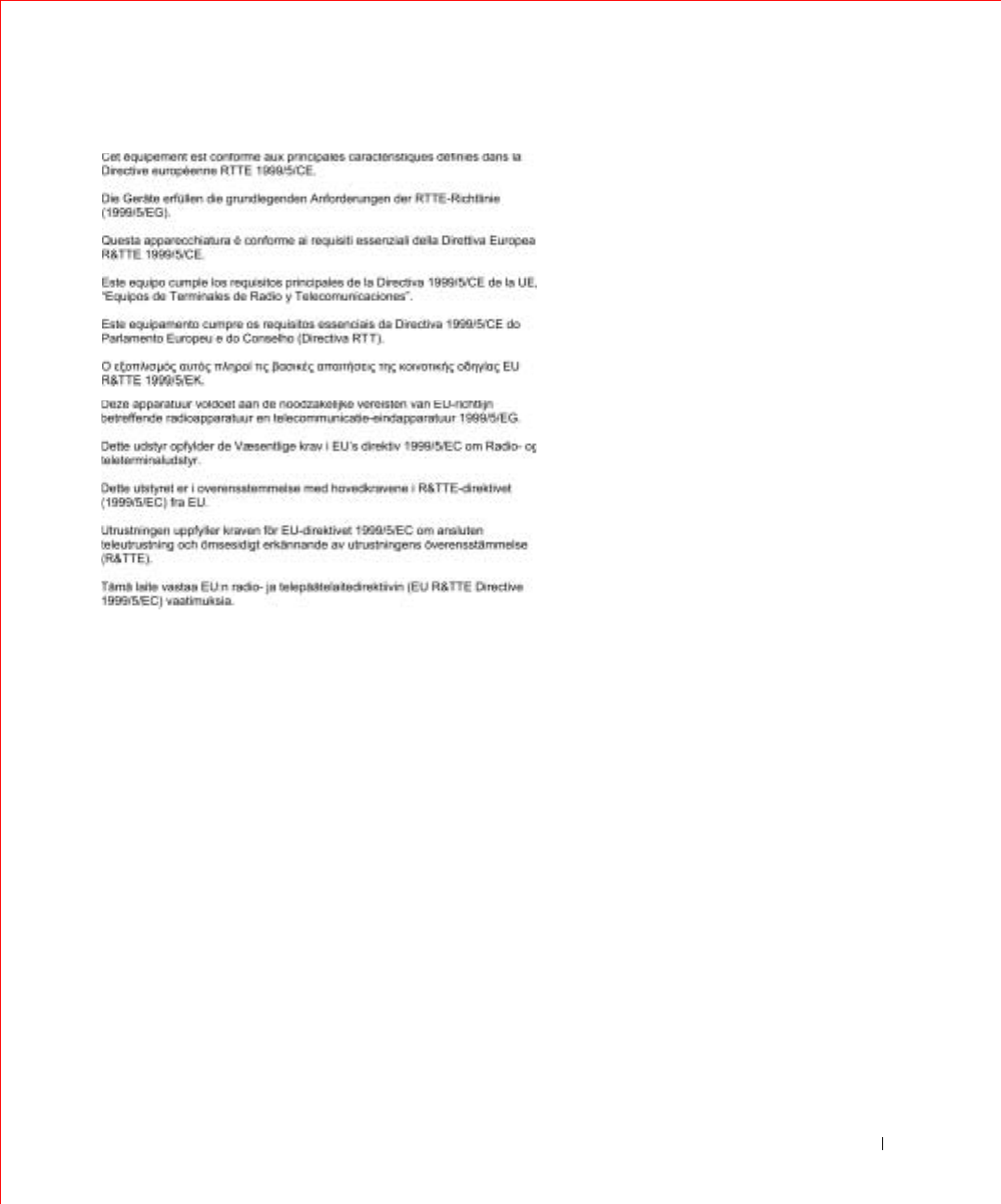
Appendix 223
FILE LOCATION: S:\SYSTEMS\Pebble\UG\A00\English\appendix.fm
DELL CONFIDENTIAL – PRELIMINARY 1/29/03 – FOR PROOF ONLY
New Zealand Telecom Warnings
General
"The grant of a Telepermit for any item of terminal equipment indicates
only that Telecom has accepted that the item complies with minimum
conditions for connection to its network. It indicates no endorsement of the
product by Telecom, nor does it provide any sort of warranty. Above all, it
provides no assurance that any item will work correctly in all respects with
another item of Telepermitted equipment of a different make or model, nor
does it imply that any product is compatible with all of Telecom’s network
services."
"This equipment does not fully meet Telecom impedance requirements.
Performance limitations may occur when used in conjunction with some
parts of the network. Telecom will accept no responsibility should
difficulties arise in such circumstances."

224 Appendix
www.dell.com | support.dell.com
FILE LOCATION: S:\SYSTEMS\Pebble\UG\A00\English\appendix.fm
DELL CONFIDENTIAL – PRELIMINARY 1/29/03 – FOR PROOF ONLY
"This equipment shall not be set up to make automatic calls to the Telecom
‘111’ Emergence Service."
"If a charge for local calls is unacceptable, the ‘Dial’ button should NOT be
used for local calls. Only the 7-digits of the local number should be dialed
from your telephone. DO NOT dial the area code digit or the ‘0’ prefix."
"This equipment may not provide for the effective hand-over of a call to
another device connected to the same line."
Important Notice
"Under power failure conditions, this telephone may not operate. Please
ensure that a separate telephone, not dependent on local power, is available
for emergency use."
"Some parameters required for compliance with Telecom’s Telepermit
requirements are dependent on the equipment (PC) associated with this
device. The associated equipment shall be set to operate within the
following limits for compliance with Telecom’s Specification:
1There shall be no more than 10 call attempts to the same number
within any 30-minute period for any single manual call initiation, and
the equipment shall go on-hook for a period of not less than 30
seconds between the end of one attempt and the beginning of the next
attempt.
2Where automatic calls are made to different numbers, the equipment
shall go on-line for a period of not less than 5 seconds between the end
of one attempt and the beginning of the next attempt.
3The equipment shall be set to ensure that calls are answered between 3
and 30 seconds of receipt of ringing."
"All persons using this device for recording telephone conversations shall
comply with New Zealand law. This requires that at least one party to the
conversation is to be aware that it is being recorded. In addition, the
Principles enumerated in the Privacy Act of 1993 shall be complied with in
respect to the nature of the personal information collected, the purpose for
its collection, how it is used and what is disclosed to any other party."

Appendix 225
FILE LOCATION: S:\SYSTEMS\Pebble\UG\A00\English\appendix.fm
DELL CONFIDENTIAL – PRELIMINARY 1/29/03 – FOR PROOF ONLY
ENERGY STAR® Compliance
Certain configurations of Dell computers comply with the requirements set
forth by the Environmental Protection Agency (EPA) for energy-efficient
computers. If the front panel of your computer bears the ENERGY STAR®
Emblem, your original configuration complies with these requirements and
all ENERGY STAR® power management features of the computer are
enabled.
NOTE: Any Dell computer bearing the ENERGY STAR® Emblem is certified to
comply with EPA ENERGY STAR® requirements as configured when shipped by
Dell. Any changes you make to this configuration (such as installing additional
expansion cards or drives) may increase the computer’s power consumption beyond
the limits set by the EPA's ENERGY STAR® Computers program.
ENERGY STAR® Emblem
The EPA's ENERGY STAR® Computers program is a joint effort between
the EPA and computer manufacturers to reduce air pollution by promoting
energy-efficient computer products. The EPA estimates that use of
ENERGY STAR® computer products can save computer users up to two
billion dollars annually in electricity costs. In turn, this reduction in
electricity usage can reduce emissions of carbon dioxide, the gas primarily
responsible for the greenhouse effect, and sulfur dioxide and nitrogen
oxides, the primary causes of acid rain.
You can also help reduce electricity usage and its side effects by turning off
your computer when it is not in use for extended periods of time,
particularly at night and on weekends.
Simplified Chinese Class A Warning Notice (China Only)
On Class A systems, the following warning will appear near the regulatory
label:
Warning: This is a Class A product. In a domestic environment this
product may cause radio interference, in which case the user may be
required to take adequate measures.
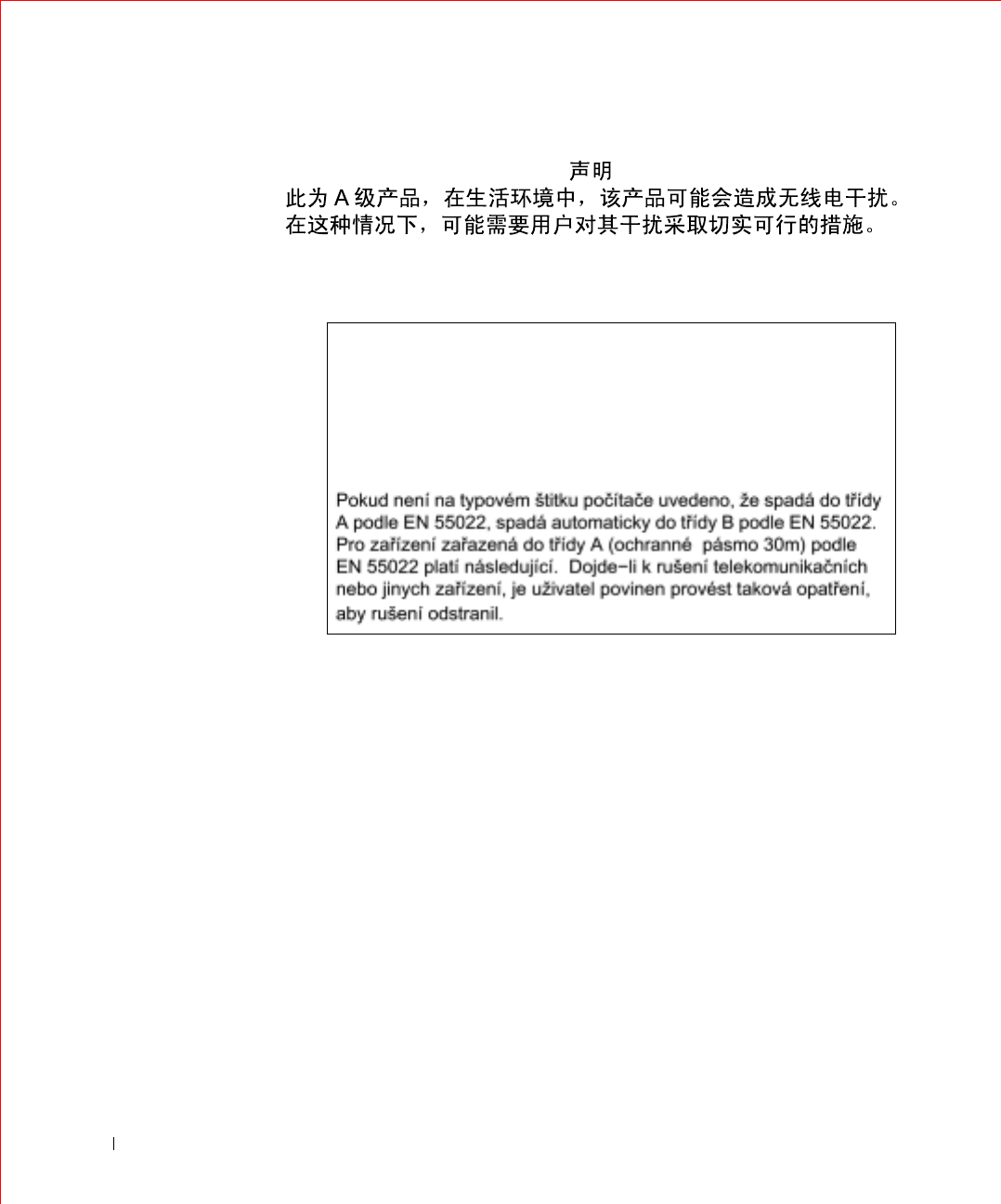
226 Appendix
www.dell.com | support.dell.com
FILE LOCATION: S:\SYSTEMS\Pebble\UG\A00\English\appendix.fm
DELL CONFIDENTIAL – PRELIMINARY 1/29/03 – FOR PROOF ONLY
EN 55022 Compliance (Czech Republic Only)
VCCI Notice (Japan Only)
Most Dell computers are classified by the Voluntary Control Council for
Interference (VCCI) as Class B information technology equipment (ITE).
However, the inclusion of certain options can change the rating of some
configurations to Class A. ITE, including devices, expansion cards, printers,
input/output (I/O) devices, monitors, and so on, integrated into or
connected to the computer should match the electromagnetic environment
classification (Class A or B) of the computer.
To determine which classification applies to your computer, examine the
regulatory labels/markings (see "VCCI Class A ITE Regulatory Mark" and
"VCCI Class B ITE Regulatory Mark") located on the bottom, side, or back
panel of your computer. Once you have determined your computer’s VCCI
classification, read the appropriate VCCI notice.
This device belongs to Class B devices as described in EN 55022, unless
it is specifically stated that it is a Class A device on the specification
label. The following applies to devices in Class A of EN 55022 (radius of
protection up to 30 meters). The user of the device is obliged to take all
steps necessary to remove sources of interference to telecommunication
or other devices.
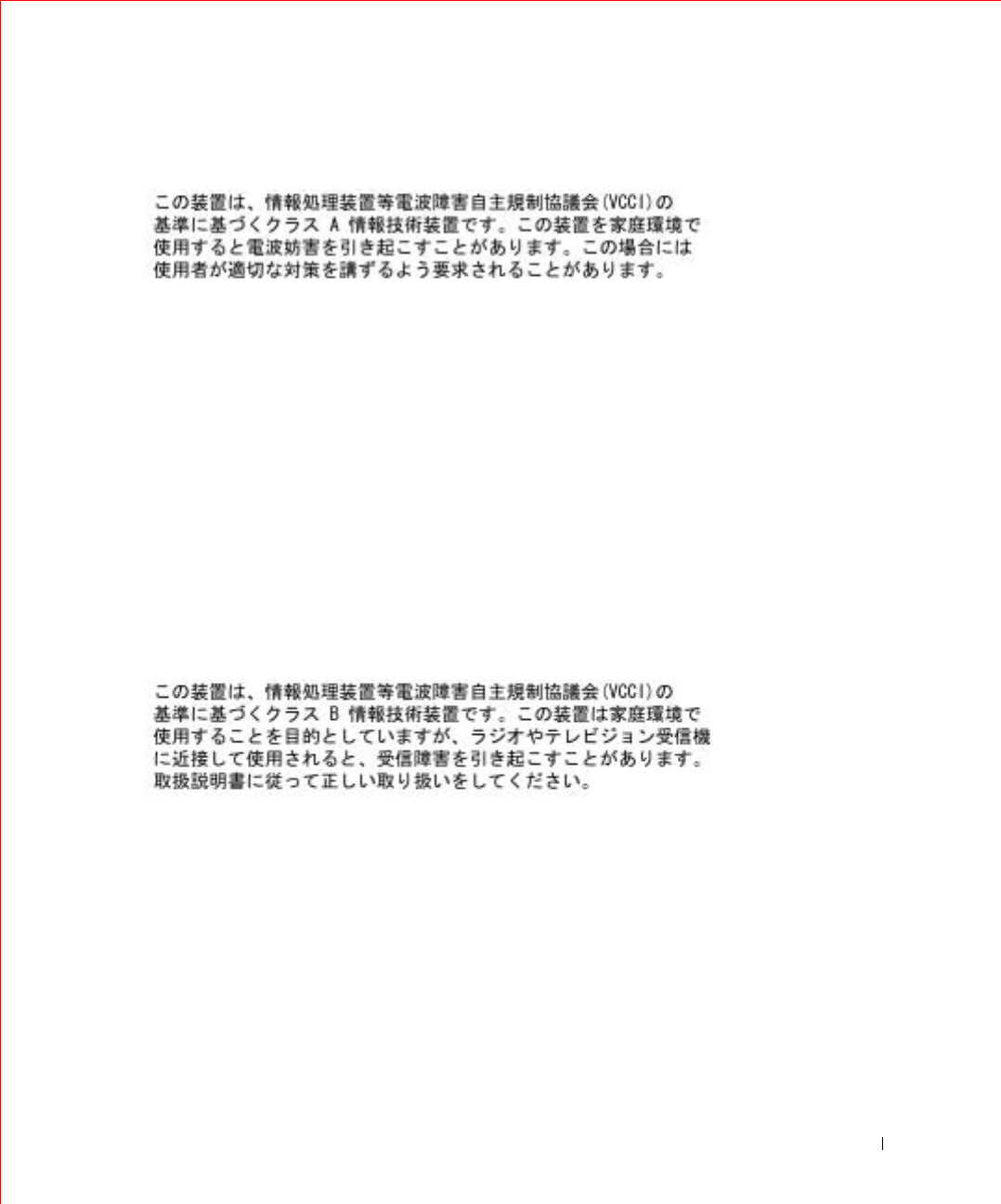
Appendix 227
FILE LOCATION: S:\SYSTEMS\Pebble\UG\A00\English\appendix.fm
DELL CONFIDENTIAL – PRELIMINARY 1/29/03 – FOR PROOF ONLY
Class A ITE
This is a Class A product based on the standard of the Voluntary Control
Council for Interference (VCCI) for information technology equipment. If
this equipment is used in a domestic environment, radio disturbance may
arise. When such trouble occurs, the user may be required to take corrective
actions.
VCCI Class A ITE Regulatory Mark
If the regulatory label includes the following marking, your computer is a
Class A product:
Class B ITE
This is a Class B product based on the standard of the Voluntary Control
Council for Interference (VCCI) for information technology equipment. If
this equipment is used near a radio or television receiver in a domestic
environment, it may cause radio interference. Install and use the equipment
according to the instruction manual.
VCCI Class B ITE Regulatory Mark
If the regulatory label includes the following marking, your computer is a
Class B product:
VCCI

228 Appendix
www.dell.com | support.dell.com
FILE LOCATION: S:\SYSTEMS\Pebble\UG\A00\English\appendix.fm
DELL CONFIDENTIAL – PRELIMINARY 1/29/03 – FOR PROOF ONLY
MIC Notice (Republic of Korea Only)
To determine which classification (Class A or B) applies to your computer
(or other Dell digital device), examine the Republic of Korean Ministry of
Information and Communications (MIC) registration labels located on
your computer (or other Dell digital device). The MIC label may be located
separately from the other regulatory marking applied to your product. Line
two of the label identifies the emissions class for the product—"(A)" for
Class A products or "(B)" for Class B products.
NOTE: MIC emissions requirements provide for two classifications:
• Class A devices are for business purposes.
• Class B devices are for nonbusiness purposes.
Class A Device
Please note that this device has been approved for business purposes with
regard to electromagnetic interference. If you find that this device is not
suitable for your use, you may exchange it for a nonbusiness-purpose device.
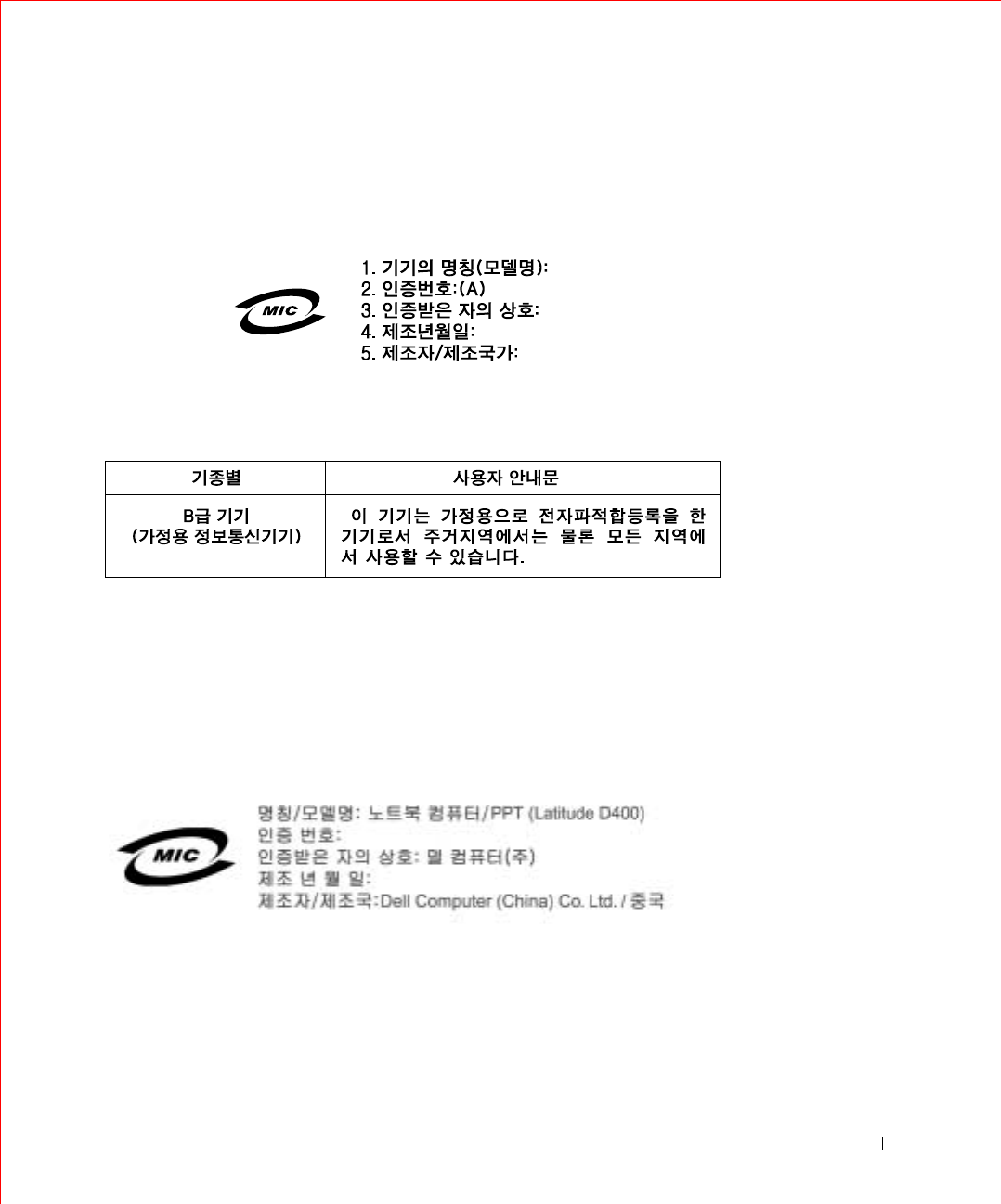
Appendix 229
FILE LOCATION: S:\SYSTEMS\Pebble\UG\A00\English\appendix.fm
DELL CONFIDENTIAL – PRELIMINARY 1/29/03 – FOR PROOF ONLY
MIC Class A Regulatory Label
If the regulatory label includes the following marking, your computer is a
Class A product:
Class B Device
Please note that this device has been approved for nonbusiness purposes
and may be used in any environment, including residential areas.
MIC Class B Regulatory Label
If the regulatory label includes the following marking, your computer is a
Class B product.
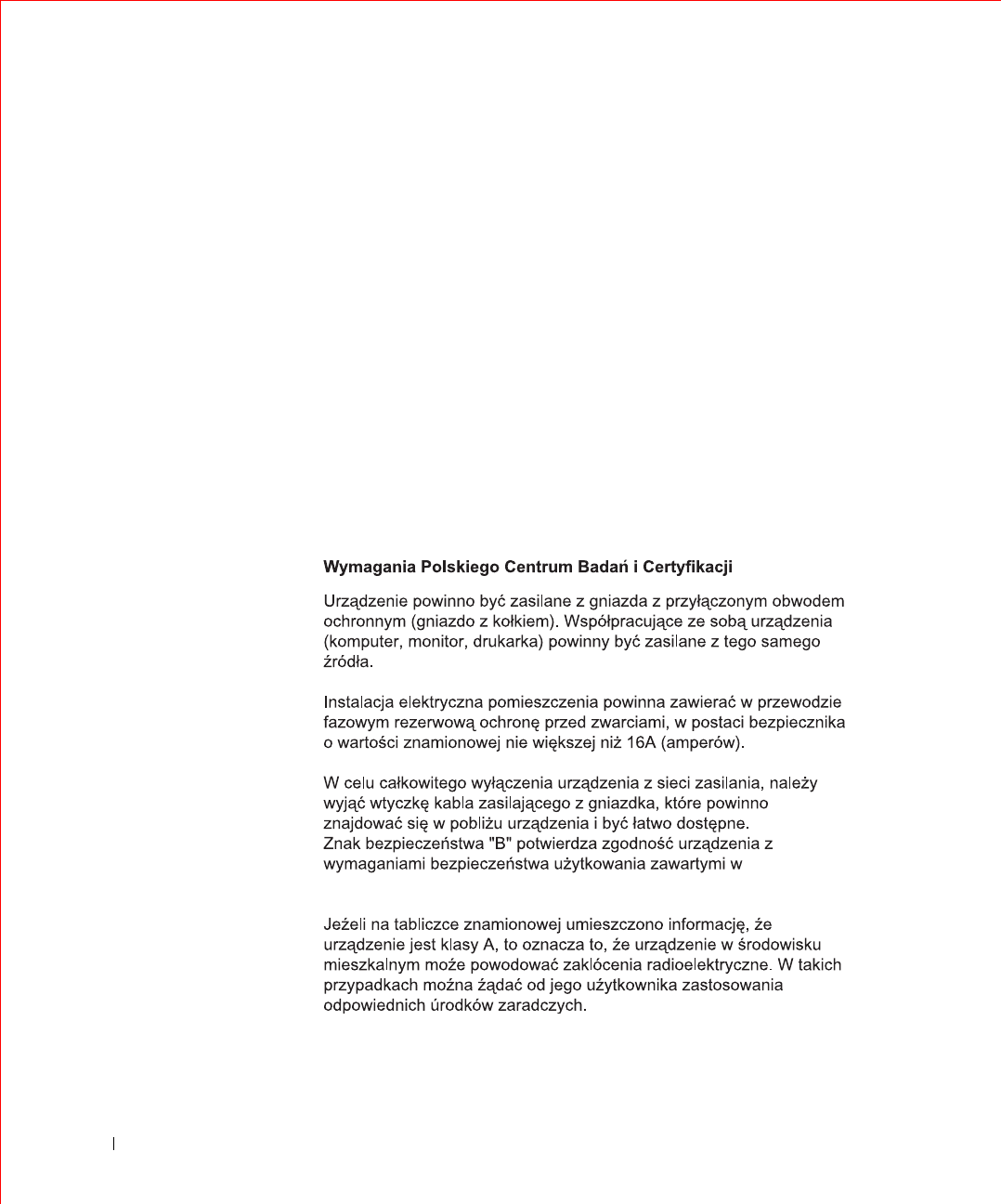
230 Appendix
www.dell.com | support.dell.com
FILE LOCATION: S:\SYSTEMS\Pebble\UG\A00\English\appendix.fm
DELL CONFIDENTIAL – PRELIMINARY 1/29/03 – FOR PROOF ONLY
Polish Center for Testing and Certification Notice
The equipment should draw power from a socket with an attached
protection circuit (a 3-prong socket). All equipment that works together
(computer, monitor, printer, and so on) should have the same power supply
source.
The phasing conductor of the room’s electrical installation should have a
reserve short-circuit protection device in the form of a fuse with a nominal
value no larger than 16 amperes (A).
To completely switch off the equipment, the power supply cable must be
removed from the power supply socket, which should be located near the
equipment and easily accessible.
A protection mark "B" confirms that the equipment is in compliance with
the protection usage requirements of standards PN-93/T-42107 and PN-EN
55022.
PN–EN 60950:2000 i PN–EN 55022:2000.
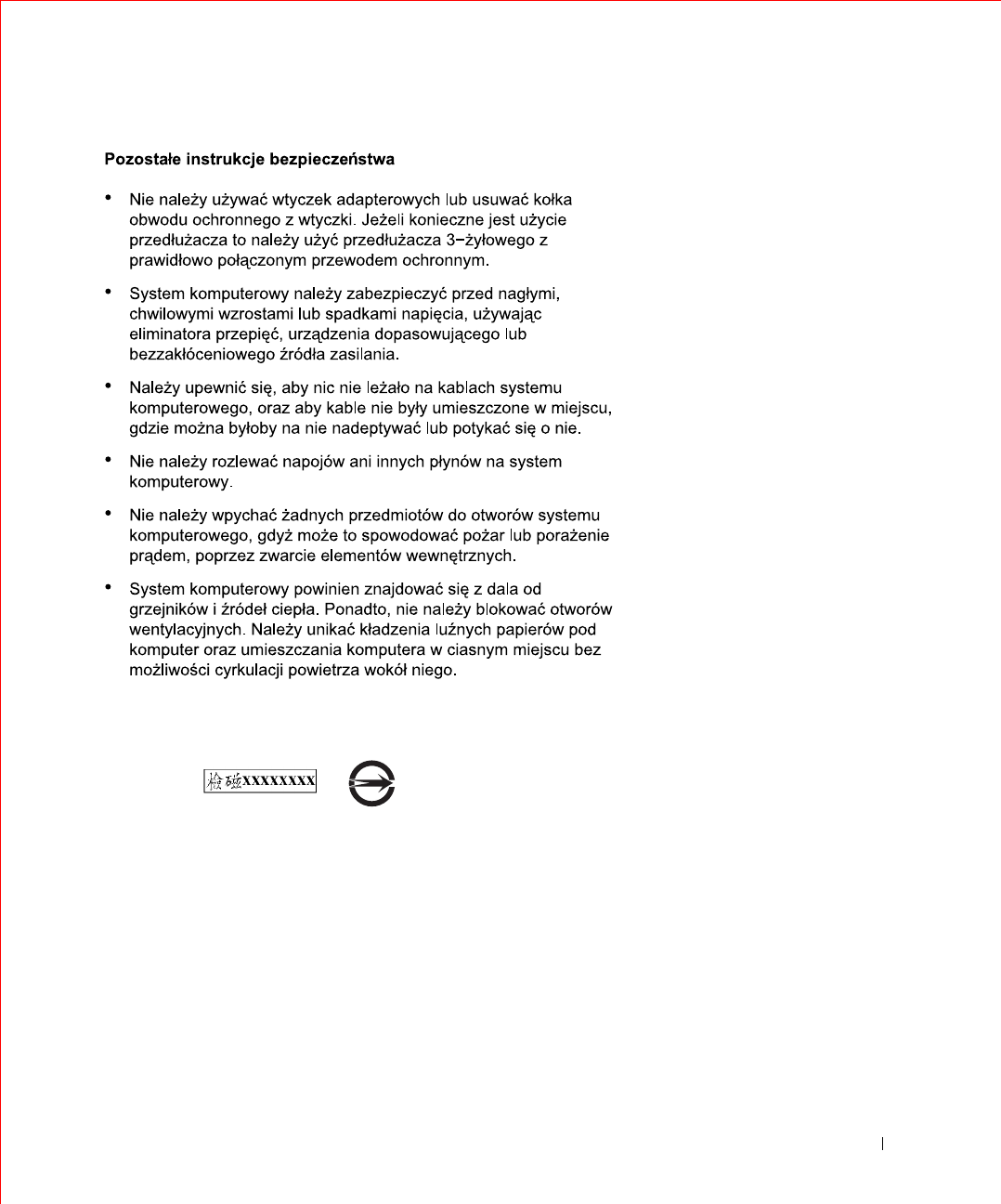
Appendix 231
FILE LOCATION: S:\SYSTEMS\Pebble\UG\A00\English\appendix.fm
DELL CONFIDENTIAL – PRELIMINARY 1/29/03 – FOR PROOF ONLY
BSMI Notice (Taiwan Only)
If you find a or mark on the regulatory
label on the bottom, side, or back panel of your computer, the following
section is applicable:
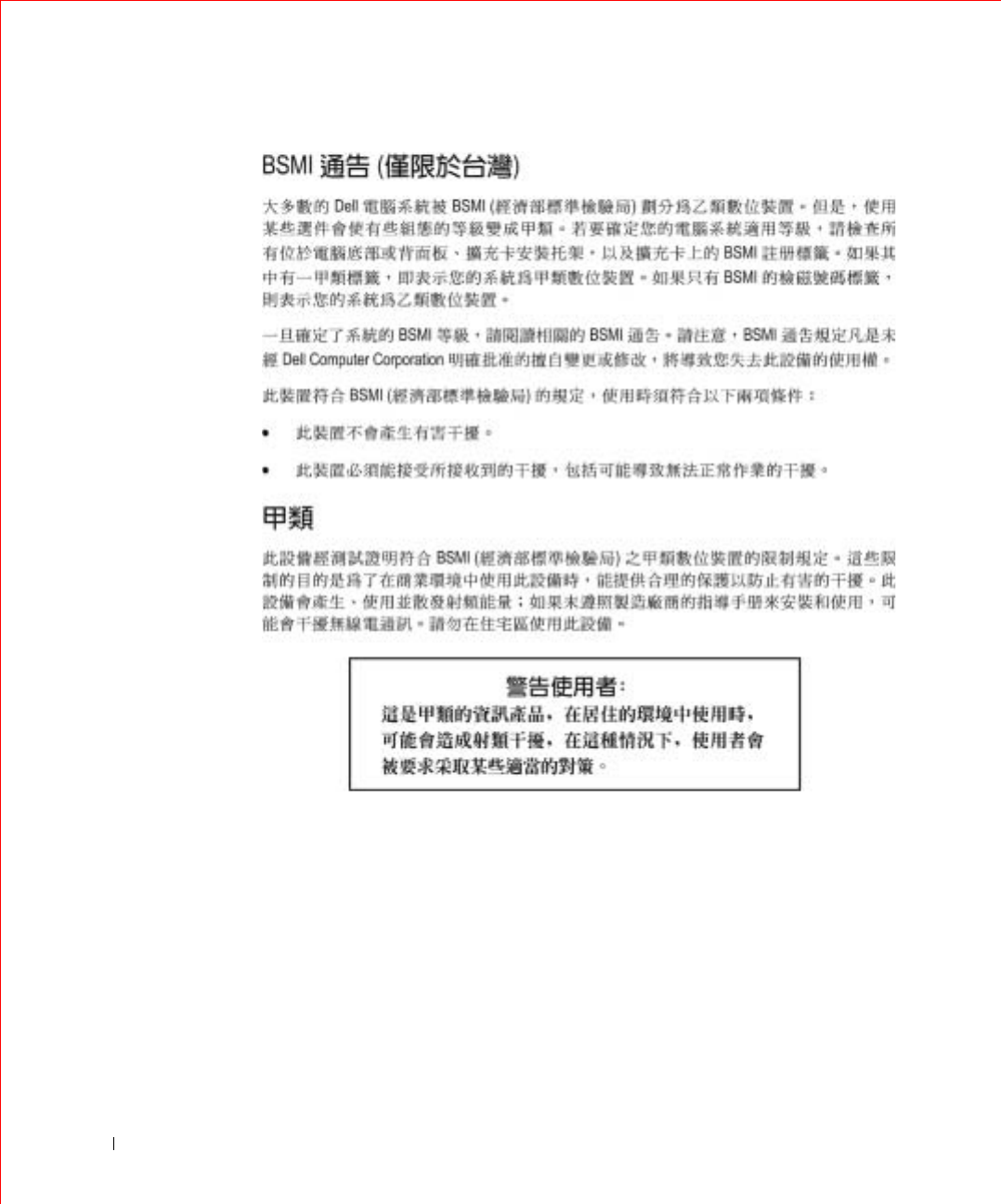
232 Appendix
www.dell.com | support.dell.com
FILE LOCATION: S:\SYSTEMS\Pebble\UG\A00\English\appendix.fm
DELL CONFIDENTIAL – PRELIMINARY 1/29/03 – FOR PROOF ONLY
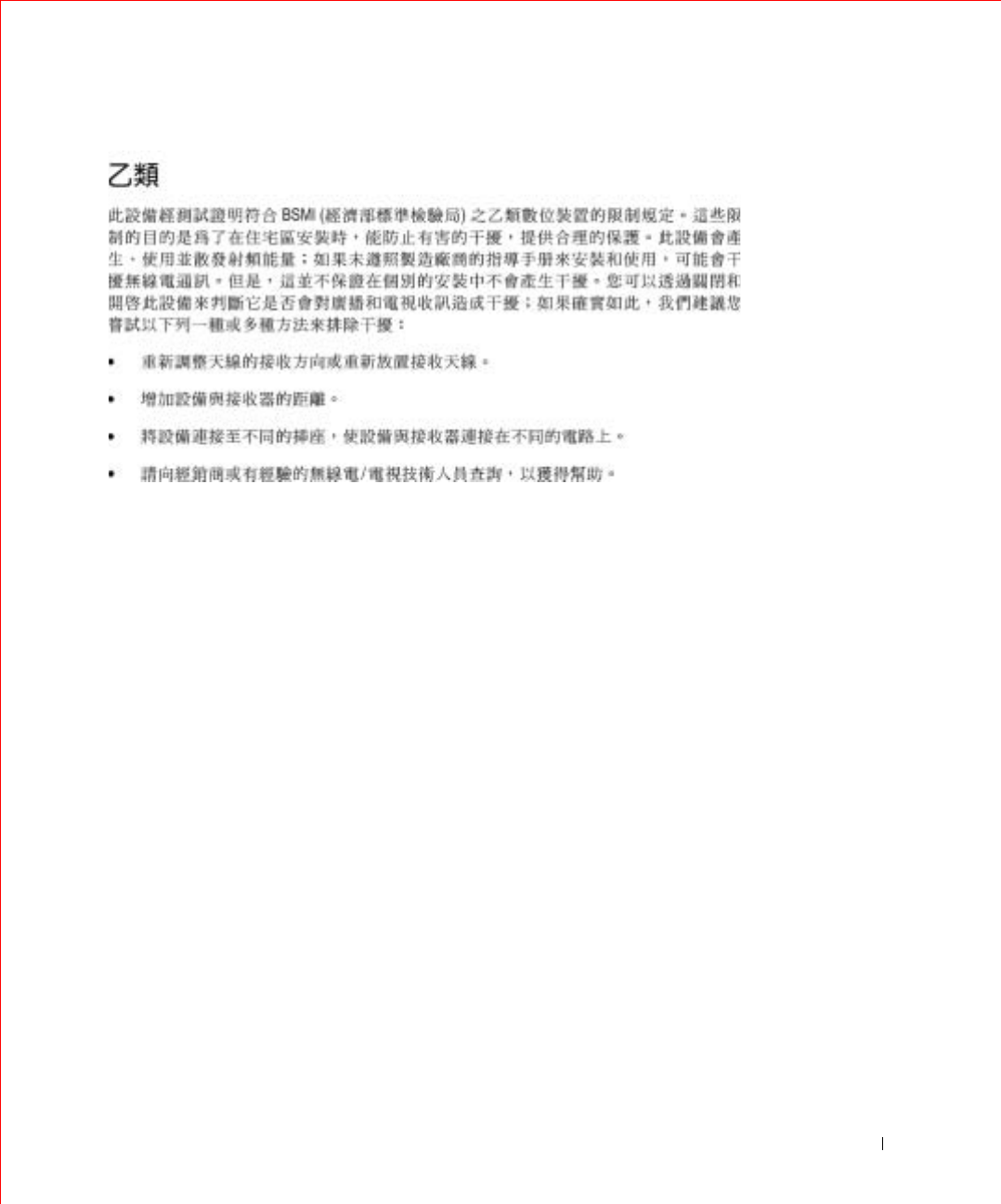
Appendix 233
FILE LOCATION: S:\SYSTEMS\Pebble\UG\A00\English\appendix.fm
DELL CONFIDENTIAL – PRELIMINARY 1/29/03 – FOR PROOF ONLY
NOM Information (Mexico Only)
The following information is provided on the device(s) described in this
document in compliance with the requirements of the official Mexican
standards (NOM):
Exporter: Dell Computer Corporation
One Dell Way
Round Rock, TX 78682
Importer: Dell Computer de México,
S.A. de C.V.
Paseo de la Reforma 2620 - 11° Piso
Col. Lomas Altas
11950 México, D.F.
Ship to: Dell Computer de México,
S.A. de C.V. al Cuidado de Kuehne &
Nagel de México S. de R.I.
Avenida Soles No. 55
Col. Peñon de los Baños
15520 México, D.F.
Model number: PPT
Supply voltage: 100–240 VAC

234 Appendix
www.dell.com | support.dell.com
FILE LOCATION: S:\SYSTEMS\Pebble\UG\A00\English\appendix.fm
DELL CONFIDENTIAL – PRELIMINARY 1/29/03 – FOR PROOF ONLY
Warranty and Return Policy
Dell Computer Corporation (“Dell”) manufactures its hardware products
from parts and components that are new or equivalent to new in accordance
with industry-standard practices. For information about the Dell warranty
for your computer, see the System Information Guide.
Frequency: 50–60 Hz
Current Consumption: 1.5 A
Output voltage: 20 VDC
Output current: 4.6 A

FILE LOCATION: S:\SYSTEMS\Pebble\UG\A00\English\glossary.fm
DELL CONFIDENTIAL – PRELIMINARY 1/29/03 – FOR PROOF ONLY
24
SECTION 24
Glossary

236 Glossary
www.dell.com | support.dell.com
FILE LOCATION: S:\SYSTEMS\Pebble\UG\A00\English\glossary.fm
DELL CONFIDENTIAL – PRELIMINARY 1/29/03 – FOR PROOF ONLY
Terms in this Glossary are provided for informational purposes only and
may or may not describe features included with your particular computer.
A
AC — alternating current — The form of electricity that powers your computer
when you plug the AC adapter power cable into an electrical outlet.
ACPI — advanced configuration and power interface — A power management
specification that enables Microsoft® Windows® operating systems to put a
computer in standby or hibernate mode to conserve the amount of electrical power
allocated to each device attached to the computer.
AGP — accelerated graphics port — A dedicated graphics port that allows system
memory to be used for video-related tasks. AGP delivers a smooth, true-color video
image because of the faster interface between the video circuitry and the computer
memory.
ANTIVIRUS SOFTWARE —A program designed to identify, quarantine, and/or
delete viruses from your computer.
APR — advanced port replicator — A docking device that allows you to
conveniently use a monitor, keyboard, mouse, and other devices with your portable
computer.
ASF — alert standards format — A standard to define a mechanism for reporting
hardware and software alerts to a management console. ASF is designed to be
platform- and operating system-independent.
B
BACKUP —A copy of a program or data file on a floppy disk, CD, or hard drive. As
a precaution, back up the data files from your hard drive regularly.
BATTERY —An internal power source used to operate portable computers when
not connected to an AC adapter and an electrical outlet.
BATTERY LIFE SPAN —The length of time (years) during which a portable
computer battery is able to be depleted and recharged.
BATTERY OPERATING TIME —The length of time (minutes or hours) that a
portable computer battery holds a charge while powering the computer.
BIOS — basic input/output system — A program (or utility) that serves as an
interface between the computer hardware and the operating system. Unless you
understand what effect the settings have on the computer, do not change the
settings for this program. Also referred to as the system setup program.
BIT —The smallest unit of data interpreted by your computer.

Glossary 237
FILE LOCATION: S:\SYSTEMS\Pebble\UG\A00\English\glossary.fm
DELL CONFIDENTIAL – PRELIMINARY 1/29/03 – FOR PROOF ONLY
BLUETOOTH™—A wireless technology standard for short-range (9 m [29 feet])
networking devices that allows for enabled devices to automatically recognize each
other.
BOOT SEQUENCE —Specifies the order of the devices from which the computer
attempts to boot.
BOOTABLE CD — A CD that you can use to start your computer. In case your
hard drive is damaged or your computer has a virus, ensure that you always have a
bootable CD or floppy disk available. Your Drivers and Utilities or Resource CD is a
bootable CD.
BOOTABLE DISK —A disk that you can use to start your computer. In case your
hard drive is damaged or your computer has a virus, ensure that you always have a
bootable CD or floppy disk available.
BPS —bits per second — The standard unit for measuring data transmission
speed.
BTU — British thermal unit — A measurement of heat output.
BUS —A communication pathway between the components in your computer.
BUS SPEED —The speed, given in MHz, that indicates how fast a bus can
transfer information.
BYTE —The basic data unit used by your computer. A byte is usually equal to 8
bits.
C
C—Celsius — A temperature measurement system where 0° is the freezing point
and 100° is the boiling point of water.
CACHE —A special high-speed storage mechanism which can be either a reserved
section of main memory or an independent high-speed storage device. The cache
enhances the efficiency of many microprocessor operations.
L1 cache — Primary cache stored inside the microprocessor.
L2 cache — Secondary cache which can either be external to the microprocessor
or incorporated into the microprocessor architecture.
CARNET —An international customs document that facilitates temporary imports
into foreign countries. Also known as a merchandise passport.
CD — compact disc — An optical form of storage media, typically used for audio
and software programs.
CD DRIVE —A drive that uses optical technology to read data from CDs.
CD PLAYER —The software used to play music CDs. The CD player displays a
window with buttons that you use to play a CD.
CD-R — CD recordable — A recordable version of a CD. Data can be recorded

238 Glossary
www.dell.com | support.dell.com
FILE LOCATION: S:\SYSTEMS\Pebble\UG\A00\English\glossary.fm
DELL CONFIDENTIAL – PRELIMINARY 1/29/03 – FOR PROOF ONLY
only once onto a CD-R. Once recorded, the data cannot be erased or written over.
CD-RW — CD rewritable — A rewritable version of a CD. Data can be written to
a CD-RW disc, and then erased and written over (rewritten).
CD-RW DRIVE —A drive that can read CDs and write to CD-RW (rewritable
CDs) and CD-R (recordable CDs) discs. You can write to CD-RW discs multiple
times, but you can write to CD-R discs only once.
CD-RW/DVD DRIVE —A drive, sometimes referred to as a combo drive, that
can read CDs and DVDs and write to CD-RW (rewritable CDs) and CD-R
(recordable CDs) discs. You can write to CD-RW discs multiple times, but you can
write to CD-R discs only once.
CLOCK SPEED —The speed, given in MHz, that indicates how fast computer
components that are connected to the system bus operate.
COA — Certificate of Authenticity — The Windows alpha-numeric code located
on a sticker on your computer. You may need the COA to complete the operating
system setup or reinstallation. Also referred to as the Product Key or Product ID.
CONTROL PANEL —A Windows utility that allows you to modify operating
system and hardware settings, such as display settings.
CONTROLLER —A chip that controls the transfer of data between the
microprocessor and memory or between the microprocessor and devices.
CRIMM — continuity rambus in-line memory module — A special module that
has no memory chips and is used to fill unused RIMM slots.
CURSOR —The marker on a display or screen that shows where the next keyboard,
touch pad, or mouse action will occur. It often is a blinking solid line, an underline
character, or a small arrow.
D
DDR SDRAM — double-data-rate SDRAM — A type of SDRAM that doubles
the data burst cycle, improving system performance.
DEVICE —Hardware such as a disk drive, printer, or keyboard that is installed in or
connected to your computer.
DEVICE DRIVER —See driver.
DIN CONNECTOR —A round, six-pin connector that conforms to DIN
(Deutsche Industrie-Norm) standards; it is typically used to connect PS/2 keyboard
or mouse cable connectors.
DISK STRIPING —A technique for spreading data over multiple disk drives. Disk
striping can speed up operations that retrieve data from disk storage. Computers
that use disk striping generally allow the user to select the data unit size or stripe
width.

Glossary 239
FILE LOCATION: S:\SYSTEMS\Pebble\UG\A00\English\glossary.fm
DELL CONFIDENTIAL – PRELIMINARY 1/29/03 – FOR PROOF ONLY
DMA — direct memory access — A channel that allows certain types of data
transfer between RAM and a device to bypass the microprocessor.
DOCKING DEVICE —See APR.
DMTF — Distributed Management Task Force — A consortium of hardware and
software companies who develop management standards for distributed desktop,
network, enterprise, and Internet environments.
DOMAIN —A group of computers, programs, and devices on a network that are
administered as a unit with common rules and procedures for use by a specific group
of users. A user logs on to the domain to gain access to the resources.
DRAM — dynamic random-access memory — Memory that stores information in
integrated circuits containing capacitors.
DRIVER —Software that allows the operating system to control a device such as a
printer. Many devices do not work properly if the correct driver is not installed in the
computer.
DSL — Digital Subscriber Line — A technology that provides a constant, high-
speed Internet connection through an analog telephone line.
DUAL DISPLAY MODE —A display setting that allows you to use a second
monitor as an extension of your display. Also referred to as extended display mode.
DVD — digital versatile disc — A disc usually used to store movies. DVDs are
double-sided, whereas CDs are single-sided. DVD drives read most CD media as
well.
DVD DRIVE —A drive that uses optical technology to read data from DVDs and
CDs.
DVD PLAYER —The software used to watch DVD movies. The DVD player
displays a window with buttons that you use to watch a movie.
DVD+RW — DVD rewritable — A rewritable version of a DVD. Data can be
written to a DVD+RW disc, and then erased and written over (rewritten).
(DVD+RW technology is different from DVD-RW technology.)
DVD+RW DRIVE —A drive that can read DVDs and most CD media and write
to DVD+RW (rewritable DVDs) discs.
DVI — digital video interface — A standard for digital transmission between a
computer and a digital video display; the DVI adapter works through the computer’s
integrated graphics.
E
ECC — error checking and correction — A type of memory that includes special
circuitry for testing the accuracy of data as it passes in and out of memory.
ECP — extended capabilities port — A parallel connector design that provides

240 Glossary
www.dell.com | support.dell.com
FILE LOCATION: S:\SYSTEMS\Pebble\UG\A00\English\glossary.fm
DELL CONFIDENTIAL – PRELIMINARY 1/29/03 – FOR PROOF ONLY
improved bidirectional data transmission. Similar to EPP, ECP uses direct memory
access to transfer data and often improves performance.
EIDE — enhanced integrated device electronics — An improved version of the
IDE interface for hard drives and CD drives.
EMI — electromagnetic interference — Electrical interference caused by
electromagnetic radiation.
ENERGY STAR®—Environmental Protection Agency requirements that
decrease the overall consumption of electricity.
EPP — enhanced parallel port — A parallel connector design that provides
bidirectional data transmission.
ESD — electrostatic discharge — A rapid discharge of static electricity. ESD can
damage integrated circuits found in computer and communications equipment.
EXPANSION CARD —A circuit board that installs in an expansion slot on the
system board in some computers, expanding the capabilities of the computer.
Examples include video, modem, and sound cards.
EXPANSION SLOT —A connector on the system board (in some computers)
where you insert an expansion card, connecting it to the system bus.
EXPRESS SERVICE CODE —A numeric code located on a sticker on your
Dell™ computer. Use the Express Service Code when contacting Dell for assistance.
Express Service Code service may not be available in some countries.
EXTENDED DISPLAY MODE —A display setting that allows you to use a second
monitor as an extension of your display. Also referred to as dual display mode.
EXTENDED PC CARD —A PC Card that extends beyond the edge of the PC
Card slot when installed.
NOTICE: Always remove an extended PC Card before packing the computer
or traveling. If something strikes the exposed end of the PC Card, the system
board may be damaged.
NOTE: If your computer
has two PC Card
connectors, always install
extended PC Cards in the
top connector.
F
FAHRENHEIT —A temperature measurement system where 32° is the freezing
point and 212° is the boiling point of water.
FCC — Federal Communications Commission — A U.S. agency responsible for
enforcing communications-related regulations that state how much radiation
computers and other electronic equipment can emit.
FLOPPY DRIVE —A disk drive that can read and write to floppy disks.
FOLDER —A term used to describe space on a disk or drive where files are
organized and grouped. Files in a folder can be viewed and ordered in various ways,
such as alphabetically, by date, and by size.
FORMAT —The process that prepares a drive or disk for file storage. When a drive

Glossary 241
FILE LOCATION: S:\SYSTEMS\Pebble\UG\A00\English\glossary.fm
DELL CONFIDENTIAL – PRELIMINARY 1/29/03 – FOR PROOF ONLY
or disk is formatted, the existing information on it is lost.
FSB — front side bus — The data path and physical interface between the
microprocessor and RAM.
FTP — file transfer protocol — A standard Internet protocol used to exchange
files between computers connected to the Internet.
G
G—gravity — A measurement of weight and force.
GB — gigabyte — A measurement of data storage that equals 1024 MB
(1,073,741,824 bytes). When used to refer to hard drive storage, the term is often
rounded to 1,000,000,000 bytes.
GHZ—gigahertz — A measurement of frequency that equals one thousand
million Hz, or one thousand MHz. The speeds for computer microprocessors, buses,
and interfaces are often measured in GHz.
GRAPHICS MODE —A video mode that can be defined as x horizontal pixels by y
vertical pixels by z colors. Graphics modes can display an unlimited variety of shapes
and fonts.
GUI — graphical user interface — Software that interacts with the user by means
of menus, windows, and icons. Most programs that operate on the Windows
operating systems are GUIs.
H
HARD DRIVE —A drive that reads and writes data on a hard disk. The terms hard
drive and hard disk are often used interchangeably.
HEAT SINK —A metal plate on some microprocessors that helps dissipate heat.
HELP FILE —A file that contains descriptive or instructional information about a
product. Some help files are associated with a particular program, such as Help in
Microsoft Word. Other help files function as stand-alone reference sources. Help
files typically have a filename extension of .hlp or .chm.
HIBERNATE MODE —A power management mode that saves everything in
memory to a reserved space on the hard drive and then turns off the computer.
When you restart the computer, the memory information that was saved to the hard
drive is automatically restored.
HTML — hypertext markup language — A set of codes inserted into an Internet
web page intended for display on an Internet browser.
HTTP — hypertext transfer protocol — A protocol for exchanging files between
computers connected to the Internet.

242 Glossary
www.dell.com | support.dell.com
FILE LOCATION: S:\SYSTEMS\Pebble\UG\A00\English\glossary.fm
DELL CONFIDENTIAL – PRELIMINARY 1/29/03 – FOR PROOF ONLY
HZ—hertz — A unit of frequency measurement that equals 1 cycle per second.
Computers and electronic devices are often measured in kilohertz (kHz), megahertz
(MHz), gigahertz (GHz), or terahertz (THz).
I
IC — Industry Canada — The Canadian regulatory body responsible for regulating
emissions from electronic equipment, much as the FCC does in the United States.
IC — integrated circuit — A semiconductor wafer, or chip, on which thousands or
millions of tiny electronic components are fabricated for use in computer, audio, and
video equipment.
IDE — integrated device electronics — An interface for mass storage devices in
which the controller is integrated into the hard drive or CD drive.
IEEE 1394 — Institute of Electrical and Electronics Engineers, Inc. — A high-
performance serial bus used to connect IEEE 1394-compatible devices, such as
digital cameras and DVD players, to the computer.
INFRARED SENSOR —A port that allows you to transfer data between the
computer and infrared-compatible devices without using a cable connection.
INTEGRATED —Usually refers to components that are physically located on the
computer’s system board. Also referred to as built-in.
I/O — input/output — An operation or device that enters and extracts data from
your computer. Keyboards and printers are I/O devices.
I/O ADDRESS —An address in RAM that is associated with a specific device
(such as a serial connector, parallel connector, or expansion slot) and allows the
microprocessor to communicate with that device.
IRDA — Infrared Data Association — The organization that creates international
standards for infrared communications.
IRQ — interrupt request — An electronic pathway assigned to a specific device so
that the device can communicate with the microprocessor. Each device connection
must be assigned an IRQ. Although two devices can share the same IRQ assignment,
you cannot operate both devices simultaneously.
ISP — Internet service provider — A company that allows you to access its host
server to connect directly to the Internet, send and receive e-mail, and access
websites. The ISP typically provides you with a software package, user name, and
access phone numbers for a fee.
K
KB—kilobit — A unit of data that equals 1024 bits. A measurement of the
capacity of memory integrated circuits.

Glossary 243
FILE LOCATION: S:\SYSTEMS\Pebble\UG\A00\English\glossary.fm
DELL CONFIDENTIAL – PRELIMINARY 1/29/03 – FOR PROOF ONLY
KB — kilobyte — A unit of data that equals 1024 bytes but is often referred to as
1000 bytes.
KEYBOARD SHORTCUT —A command requiring you to press multiple keys at the
same time. Also referred to as a key combination.
KHZ—kilohertz — A measurement of frequency that equals 1000 Hz.
L
LAN — local area network — A computer network covering a small area. A LAN
usually is confined to a building or a few nearby buildings. A LAN can be connected
to another LAN over any distance through telephone lines and radio waves to form a
wide area network (WAN).
LCD — liquid crystal display — The technology used by portable computer and
flat-panel displays.
LED — light-emitting diode — An electronic component that emits light to
indicate the status of the computer.
LOCAL BUS —A data bus that provides a fast throughput for devices to the
microprocessor.
LPT — line print terminal — The designation for a parallel connection to a printer
or other parallel device.
M
MB—megabit — A measurement of memory chip capacity that equals 1024 Kb.
MBPS —megabits per second — One million bits per second. This measurement
is typically used for transmission speeds for networks and modems.
MB — megabyte — A measurement of data storage that equals 1,048,576 bytes.
1 MB equals 1024 KB. When used to refer to hard drive storage, the term is often
rounded to 1,000,000 bytes.
MB/SEC —megabytes per second — One million bytes per second. This
measurement is typically used for data transfer ratings.
MEMORY —A temporary data storage area inside your computer. Because the data
in memory is not permanent, it is recommended that you frequently save your files
while you are working on them, and always save your files before you shut down the
computer. Your computer can contain several different forms of memory, such as
RAM, ROM, and video memory. Frequently, the word memory is used as a synonym
for RAM.
MEMORY ADDRESS —A specific location where data is temporarily stored in
RAM.

244 Glossary
www.dell.com | support.dell.com
FILE LOCATION: S:\SYSTEMS\Pebble\UG\A00\English\glossary.fm
DELL CONFIDENTIAL – PRELIMINARY 1/29/03 – FOR PROOF ONLY
MEMORY MAPPING —The process by which the computer assigns memory
addresses to physical locations at start-up. Devices and software can then identify
information that the microprocessor can access.
MEMORY MODULE —A small circuit board containing memory chips, which
connects to the system board.
MHZ—megahertz — A measure of frequency that equals 1 million cycles per
second. The speeds for computer microprocessors, buses, and interfaces are often
measured in MHz.
MICROPROCESSOR —A computer chip that interprets and executes program
instructions. Sometimes the microprocessor is referred to as the processor or the
CPU (central processing unit).
MODEM —A device that allows your computer to communicate with other
computers over analog telephone lines. Three types of modems include: external,
PC Card, and internal. You typically use your modem to connect to the Internet and
exchange e-mail.
MODULE BAY —A bay that supports devices such as optical drives, a second
battery, or a Dell TravelLite™ module.
MONITOR —The high-resolution TV-like device that displays computer output.
MOUSE —A pointing device that controls the movement of the cursor on your
screen. Typically you roll the mouse over a hard, flat surface to move the pointer or
cursor on your screen.
MS —millisecond — A measure of time that equals one thousandth of a second.
Access times of storage devices are often measured in ms.
N
NETWORK ADAPTER —A chip that provides network capabilities. A computer
may include a network adapter on its system board, or it may contain a PC Card with
an adapter on it. A network adapter is also referred to as a
NIC
(network interface
controller).
NIC — See network adapter.
NOTIFICATION AREA —The section of the Windows taskbar that contains icons
for providing quick access to programs and computer functions, such as the clock,
volume control, and print status. Also referred to as system tray.
NS —nanosecond — A measure of time that equals one billionth of a second.
NVRAM — nonvolatile random access memory — A type of memory that stores
data when the computer is turned off or loses its external power source. NVRAM is
used for maintaining computer configuration information such as date, time, and
other system setup options that you can set.

Glossary 245
FILE LOCATION: S:\SYSTEMS\Pebble\UG\A00\English\glossary.fm
DELL CONFIDENTIAL – PRELIMINARY 1/29/03 – FOR PROOF ONLY
O
OPTICAL DRIVE —A drive that uses optical technology to read or write data
from CDs, DVDs, or DVD+RWs. Example of optical drives include CD drives,
DVD drives, CD-RW drives, and CD-RW/DVD combo drives.
P
PARALLEL CONNECTOR —An I/O port often used to connect a parallel printer
to your computer. Also referred to as an LPT port.
PARTITION —A physical storage area on a hard drive that is assigned to one or
more logical storage areas known as logical drives. Each partition can contain
multiple logical drives.
PC CARD —A removable I/O card adhering to the PCMCIA standard. Modems
and network adapters are common types of PC Cards.
PCI — peripheral component interconnect — PCI is a local bus that supports 32-
and 64-bit data paths, providing a high-speed data path between the microprocessor
and devices such as video, drives, and networks.
PCMCIA — Personal Computer Memory Card International Association — The
organization that establishes standards for PC Cards.
PIN — personal identification number — A sequence of numerals and/or letters
used to restrict unauthorized access to computer networks and other secure systems.
PIO — programmed input/output — A method of transferring data between two
devices through the microprocessor as part of the data path.
PIXEL —A single point on a display screen. Pixels are arranged in rows and
columns to create an image. A video resolution, such as 800 x 600, is expressed as the
number of pixels across by the number of pixels up and down.
PLUG-AND-PLAY —The ability of the computer to automatically configure
devices. Plug and Play provides automatic installation, configuration, and
compatibility with existing hardware if the BIOS, operating system, and all devices
are Plug and Play compliant.
POST — power-on self-test — Diagnostics programs, loaded automatically by the
BIOS, that perform basic tests on the major computer components, such as memory,
hard drives, and video. If no problems are detected during POST, the computer
continues the start-up.
PROGRAM —Any software that processes data for you, including spreadsheet,
word processor, database, and game packages. Programs require an operating system
to run.
PS/2 — personal system/2 — A type of connector for attaching a PS/2-compatible
keyboard, mouse, or keypad.

246 Glossary
www.dell.com | support.dell.com
FILE LOCATION: S:\SYSTEMS\Pebble\UG\A00\English\glossary.fm
DELL CONFIDENTIAL – PRELIMINARY 1/29/03 – FOR PROOF ONLY
PXE — pre-boot execution environment — A WfM (Wired for Management)
standard that allows networked computers that do not have an operating system to
be configured and started remotely.
R
RAID — redundant array of independent disks — A system of two or more drives
working together for performance and fault tolerance. RAID drives are typically used
on servers and high-end PCs.
The three most common RAID levels are 0, 3, and 5:
•Level 0: Provides data striping but no redundancy. Level 0 improves
performance but does not provide fault tolerance.
•Level 3: Same as Level 0, but also reserves one dedicated drive for error
correction data, providing good performance and some level of fault tolerance.
•Level 5: Provides data striping at the byte level and also stripe error correction
information, resulting in excellent performance and good fault tolerance.
RAM — random-access memory — The primary temporary storage area for
program instructions and data. Any information stored in RAM is lost when you shut
down your computer.
README FILE —A text file included with a software package or hardware
product. Typically, readme files provide installation information and describe new
product enhancements or corrections that have not yet been documented.
READ-ONLY —Data and/or files you can view but cannot edit or delete. A file can
have read-only status if:
•It resides on a physically write-protected floppy disk, CD, or DVD.
•It is located on a network in a directory and the system administrator has
assigned rights only to specific individuals.
REFRESH RATE —The frequency, measured in Hz, at which your screen's
horizontal lines are recharged (sometimes also referred to as its vertical frequency).
The higher the refresh rate, the less video flicker can be seen by the human eye.
RESOLUTION —The sharpness and clarity of an image produced by a printer or
displayed on a monitor. The higher the resolution, the sharper the image.
RFI — radio frequency interference — Interference that is generated at typical
radio frequencies, in the range of 10 kHz to 100,000 MHz. Radio frequencies are at
the lower end of the electromagnetic frequency spectrum and are more likely to have
interference than the higher frequency radiations, such as infrared and light.
ROM — read-only memory — Memory that stores data and programs that cannot
be deleted or written to by the computer. ROM, unlike RAM, retains its contents
after you shut down your computer. Some programs essential to the operation of
your computer reside in ROM.

Glossary 247
FILE LOCATION: S:\SYSTEMS\Pebble\UG\A00\English\glossary.fm
DELL CONFIDENTIAL – PRELIMINARY 1/29/03 – FOR PROOF ONLY
RPM — revolutions per minute — The number of rotations that occur per
minute. Hard drive speed is often measured in rpm.
RTC — real time clock — Battery-powered clock on the system board that keeps
the date and time after you shut down the computer.
RTCRST — real-time clock reset — A jumper on the system board of some
computers that can often be used for troubleshooting problems.
S
SCANDISK —A Microsoft utility that checks files, folders, and the hard disk’s
surface for errors. ScanDisk often runs when you restart the computer after it has
stopped responding.
SDRAM — synchronous dynamic random-access memory — A type of DRAM
that is synchronized with the optimal clock speed of the microprocessor.
SERIAL CONNECTOR —An I/O port often used to connect devices such as a
handheld digital device or digital camera to your computer.
SERVICE TAG —A bar code label on your computer that identifies your
computer when you access Dell Support at support.dell.com or when you call Dell
for customer service or technical support.
SETUP PROGRAM —A program that is used to install and configure hardware and
software. The setup.exe or install.exe program comes with most Windows software
packages. Setup program differs from system setup program.
SHORTCUT —An icon that provides quick access to frequently used programs,
files, folders, and drives. When you place a shortcut on your Windows desktop and
double-click the icon, you can open its corresponding folder or file without having to
find it first. Shortcut icons do not change the location of files. If you delete a
shortcut, the original file is not affected. Also, you can rename a shortcut icon.
SHUTDOWN —The process of closing windows and exiting programs, exiting the
operating system, and turning off your computer. You can lose data if you turn off
your computer before completing a shutdown.
SMART CARD —A card that is embedded with a microprocessor and a memory
chip. Smart cards can be used to authenticate a user on computers equipped for
smart cards.
SOFTWARE —Anything that can be stored electronically, such as computer files or
programs.
S/PDIF — Sony/Philips Digital Interface — An audio transfer file format that
allows the transfer of audio from one file to another without converting it to and
from an analog format, which could degrade the quality of the file.
STANDBY MODE —A power management mode that shuts down all unnecessary
computer operations to save energy.

248 Glossary
www.dell.com | support.dell.com
FILE LOCATION: S:\SYSTEMS\Pebble\UG\A00\English\glossary.fm
DELL CONFIDENTIAL – PRELIMINARY 1/29/03 – FOR PROOF ONLY
SURGE PROTECTORS —Prevent voltage spikes, such as those that may occur
during an electrical storm, from entering the computer through the electrical outlet.
Surge protectors do not protect against lightning strikes or against brownouts, which
occur when the voltage drops more than 20 percent below the normal AC-line
voltage level.
Network connections cannot be protected by surge protectors. Always disconnect
the network cable from the network connector during electrical storms.
SVGA — super-video graphics array — A video standard for video cards and
controllers. Typical SVGA resolutions are 800 x 600 and 1024 x 768.
The number of colors and resolution that a program displays depends on the
capabilities of the monitor, the video controller and its drivers, and the amount of
video memory installed in the computer.
S-VIDEO TV-OUT —A connector used to attach a TV or digital audio device to
the computer.
SXGA — super-extended graphics array — A video standard for video cards and
controllers that supports resolutions up to 1280 x 1024.
SXGA+ — super-extended graphics array plus — A video standard for video cards
and controllers that supports resolutions up to 1400 x 1050.
SYSTEM BOARD —The main circuit board in your computer. Also known as the
motherboard.
SYSTEM SETUP PROGRAM —A utility that serves as an interface between the
computer hardware and the operating system. System setup allows you to configure
user-selectable options in the BIOS, such as date and time or system password.
Unless you understand what effect the settings have on the computer, do not change
the settings for this program.
SYSTEM TRAY —See notification area.
T
TAPI — telephony application programming interface — Enables Windows
programs to operate with a wide variety of telephony devices, including voice, data,
fax, and video.
TEXT EDITOR —A program used to create and edit files that contain only text; for
example, Windows Notepad uses a text editor. Text editors do not usually provide
word wrap or formatting functionality (the option to underline, change fonts, and so
on).
TRAVEL MODULE —A plastic device designed to fit inside the module bay of a
portable computer to reduce the weight of the computer.

Glossary 249
FILE LOCATION: S:\SYSTEMS\Pebble\UG\A00\English\glossary.fm
DELL CONFIDENTIAL – PRELIMINARY 1/29/03 – FOR PROOF ONLY
U
UPS — uninterruptible power supply — A backup power source used when the
electrical power fails or drops to an unacceptable voltage level. A UPS keeps a
computer running for a limited amount of time when there is no electrical power.
UPS systems typically provide surge suppression and may also provide voltage
regulation. Small UPS systems provide battery power for a few minutes to enable
you to shut down your computer.
USB — universal serial bus — A hardware interface for a low-speed device such as
a USB-compatible keyboard, mouse, joystick, scanner, set of speakers, printer,
broadband devices (DSL and cable modems), imaging devices, or storage devices.
Devices are plugged directly in to a 4-pin socket on your computer or into a multi-
port hub that plugs in to your computer. USB devices can be connected and
disconnected while the computer is turned on, and they can also be daisy-chained
together.
UTP — unshielded twisted pair — Describes a type of cable used in most
telephone networks and some computer networks. Pairs of unshielded wires are
twisted to protect against electromagnetic interference, rather than relying on a
metal sheath around each pair of wires to protect against interference.
UXGA — ultra extended graphics array — A video standard for video cards and
controllers that supports resolutions up to 1600 x 1200.
V
VIDEO CONTROLLER —The circuitry on a video card or on the system board (in
computers with an integrated video controller) that provides the video capabilities—
in combination with the monitor—for your computer.
VIDEO MEMORY —Memory that consists of memory chips dedicated to video
functions. Video memory is usually faster than system memory. The amount of video
memory installed primarily influences the number of colors that a program can
display.
VIDEO MODE —A mode that describes how text and graphics are displayed on a
monitor. Graphics-based software, such as Windows operating systems, displays in
video modes that can be defined as x horizontal pixels by y vertical pixels by z colors.
Character-based software, such as text editors, displays in video modes that can be
defined as x columns by y rows of characters.
VIDEO RESOLUTION —See resolution.
VIRUS —A program that is designed to inconvenience you or to destroy data
stored on your computer. A virus program moves from one computer to another
through an infected disk, software downloaded from the Internet, or e-mail
attachments. When an infected program starts, its embedded virus also starts.

250 Glossary
www.dell.com | support.dell.com
FILE LOCATION: S:\SYSTEMS\Pebble\UG\A00\English\glossary.fm
DELL CONFIDENTIAL – PRELIMINARY 1/29/03 – FOR PROOF ONLY
A common type of virus is a boot virus, which is stored in the boot sectors of a floppy
disk. If the floppy disk is left in the drive when the computer is shut down and then
turned on, the computer is infected when it reads the boot sectors of the floppy disk
expecting to find the operating system. If the computer is infected, the boot virus
may replicate itself onto all the floppy disks that are read or written in that computer
until the virus is eradicated.
V—volt — The measurement of electric potential or electromotive force. One V
appears across a resistance of 1 ohm when a current of 1 ampere flows through that
resistance.
W
W—watt — The measurement of electrical power. One W is 1 ampere of current
flowing at 1 volt.
WHR—watt-hour — A unit of measure commonly used to indicate the
approximate capacity of a battery. For example, a 66-WHr battery can supply 66 W
of power for 1 hour or 33 W for 2 hours.
WALLPAPER —The background pattern or picture on the Windows desktop.
Change your wallpaper through the Windows Control Panel. You can also scan in
your favorite picture and make it wallpaper.
WRITE-PROTECTED —Files or media that cannot be changed. Use write-
protection when you want to protect data from being changed or destroyed. To
write-protect a 3.5-inch floppy disk, slide its write-protect tab to the open position.
X
XGA — extended graphics array — A video standard for video cards and
controllers that supports resolutions up to 1024 x 768.
Z
ZIF — zero insertion force — A type of socket or connector that allows a computer
chip to be installed or removed with no stress applied to either the chip or its socket.
ZIP —A popular data compression format. Files that have been compressed with
the Zip format are called Zip files and usually have a filename extension of .zip. A
special kind of zipped file is a self-extracting file, which has a filename extension of
.exe. You can unzip a self-extracting file by double-clicking it.
ZIP DRIVE —A high-capacity floppy drive developed by Iomega Corporation that
uses 3.5-inch removable disks called Zip disks. Zip disks are slightly larger than
regular floppy disks, about twice as thick, and hold up to 100 MB of data.